

Compact Muon Solenoid
LHC, CERN
| CMS-EXO-23-006 ; CERN-EP-2024-095 | ||
| Review of searches for vector-like quarks, vector-like leptons, and heavy neutral leptons in proton-proton collisions at $ \sqrt{s}= $ 13 TeV at the CMS experiment | ||
| CMS Collaboration | ||
| 27 May 2024 | ||
| Physics Reports 1115 (2025) 570 | ||
| Abstract: The LHC has provided an unprecedented amount of proton-proton collision data, bringing forth exciting opportunities to address fundamental open questions in particle physics. These questions can potentially be answered by performing searches for very rare processes predicted by models that attempt to extend the standard model of particle physics. The data collected by the CMS experiment in 2015--2018 at a center-of-mass energy of 13 TeV can be used to test the standard model with high precision and potentially uncover evidence for new particles or interactions. An interesting possibility is the existence of new fermions with masses ranging from the MeVns to the TeVns scale. Such new particles appear in many possible extensions of the standard model and are well motivated theoretically. New fermions may explain the appearance of three generations of leptons and quarks, the mass hierarchy across these generations, and the nonzero neutrino masses. In this report, the results of searches targeting vector-like quarks, vector-like leptons, and heavy neutral leptons at the CMS experiment are summarized. The complementarity of current searches for each type of new fermion is discussed, and combinations of several searches for vector-like quarks are presented. The discovery potential for some of these searches at the High-Luminosity LHC is also discussed. | ||
| Links: e-print arXiv:2405.17605 [hep-ex] (PDF) ; CDS record ; inSPIRE record ; Physics Briefing ; CADI line (restricted) ; | ||
| Figures | |

png pdf |
Figure 1:
Representative Feynman diagrams showing the production of VLQs (Q, left), VLLs (L, middle), and HNLs ($ \mathrm{N} $, right) in proton-proton collisions. |
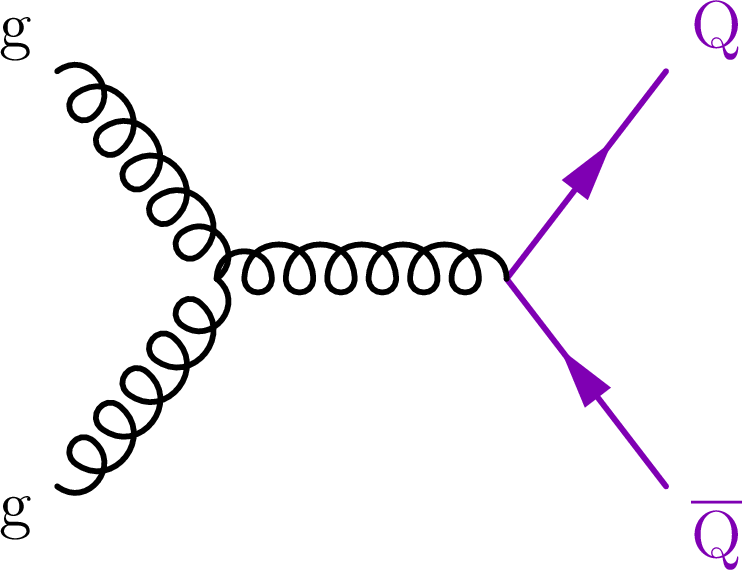
png pdf |
Figure 1-a:
Representative Feynman diagrams showing the production of VLQs (Q, left), VLLs (L, middle), and HNLs ($ \mathrm{N} $, right) in proton-proton collisions. |
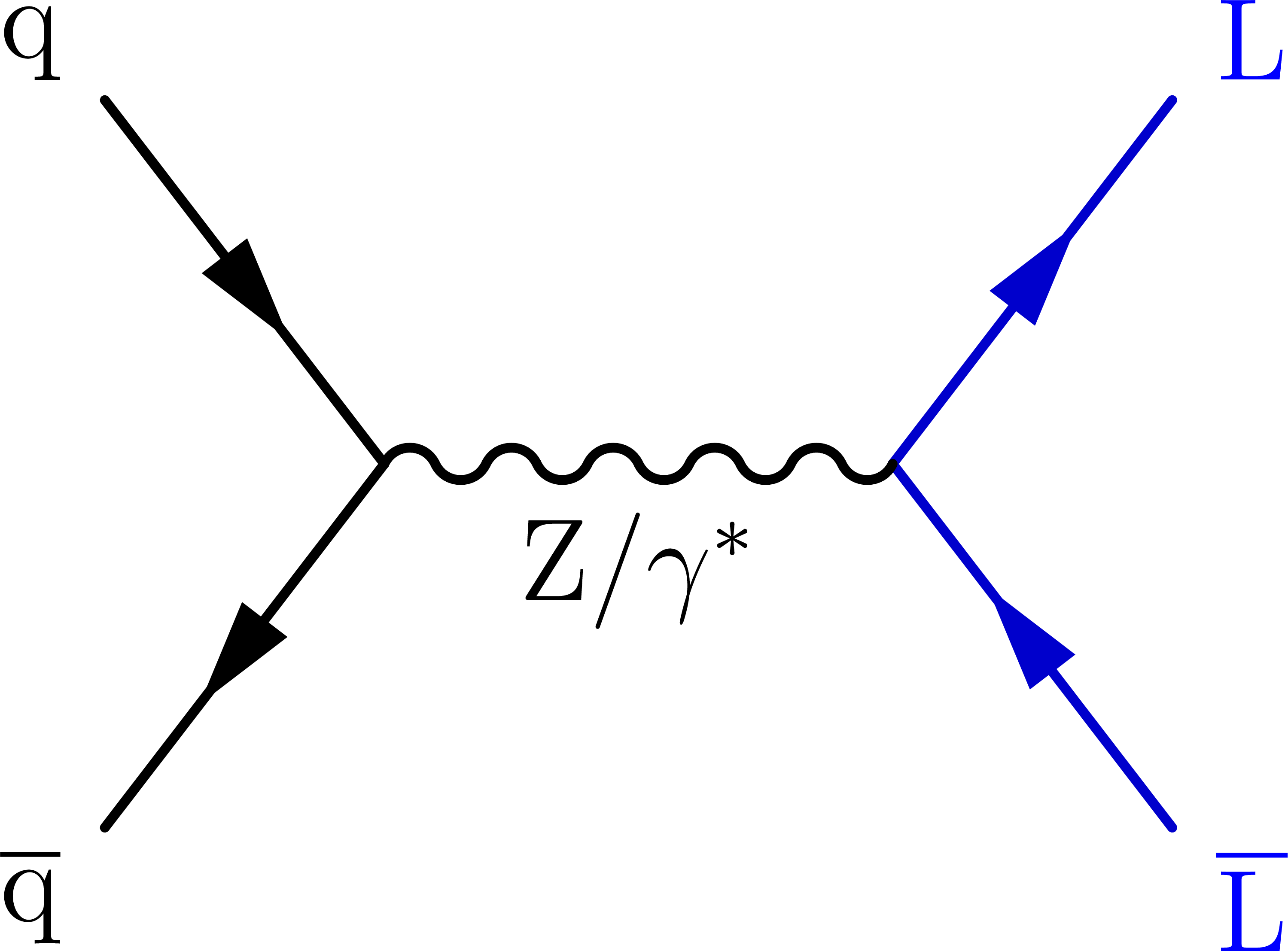
png pdf |
Figure 1-b:
Representative Feynman diagrams showing the production of VLQs (Q, left), VLLs (L, middle), and HNLs ($ \mathrm{N} $, right) in proton-proton collisions. |
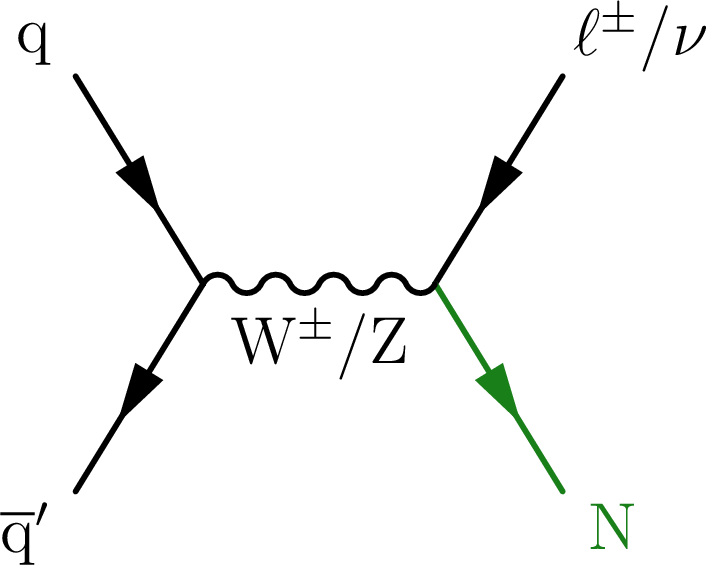
png pdf |
Figure 1-c:
Representative Feynman diagrams showing the production of VLQs (Q, left), VLLs (L, middle), and HNLs ($ \mathrm{N} $, right) in proton-proton collisions. |
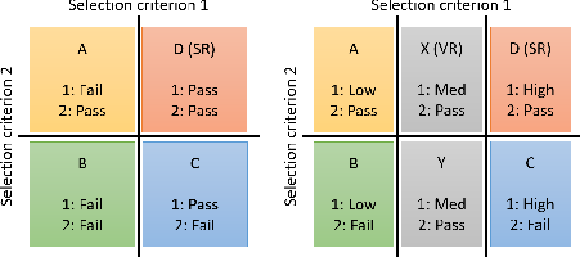
png pdf |
Figure 2:
Examples of either four (left) or six (right) selection regions used in the ABCD background estimation method. The region for which both criteria are satisfied is the SR. Expanding beyond four regions provides at least one ``validation region'' (VR). |
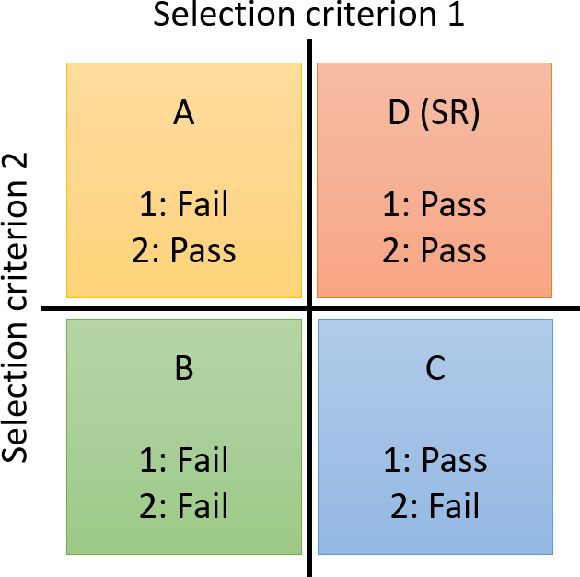
png |
Figure 2-a:
Examples of either four (left) or six (right) selection regions used in the ABCD background estimation method. The region for which both criteria are satisfied is the SR. Expanding beyond four regions provides at least one ``validation region'' (VR). |
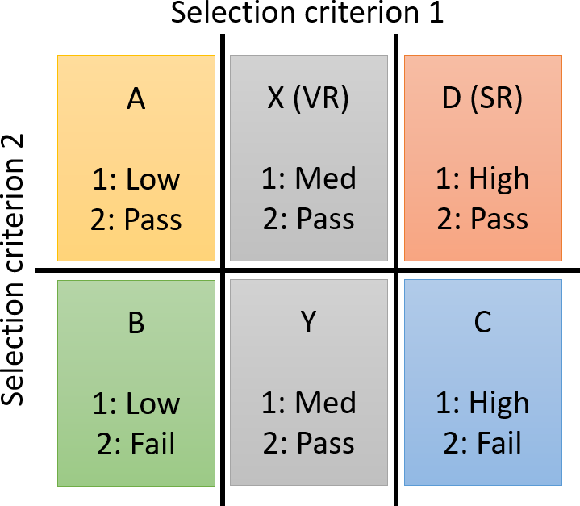
png |
Figure 2-b:
Examples of either four (left) or six (right) selection regions used in the ABCD background estimation method. The region for which both criteria are satisfied is the SR. Expanding beyond four regions provides at least one ``validation region'' (VR). |
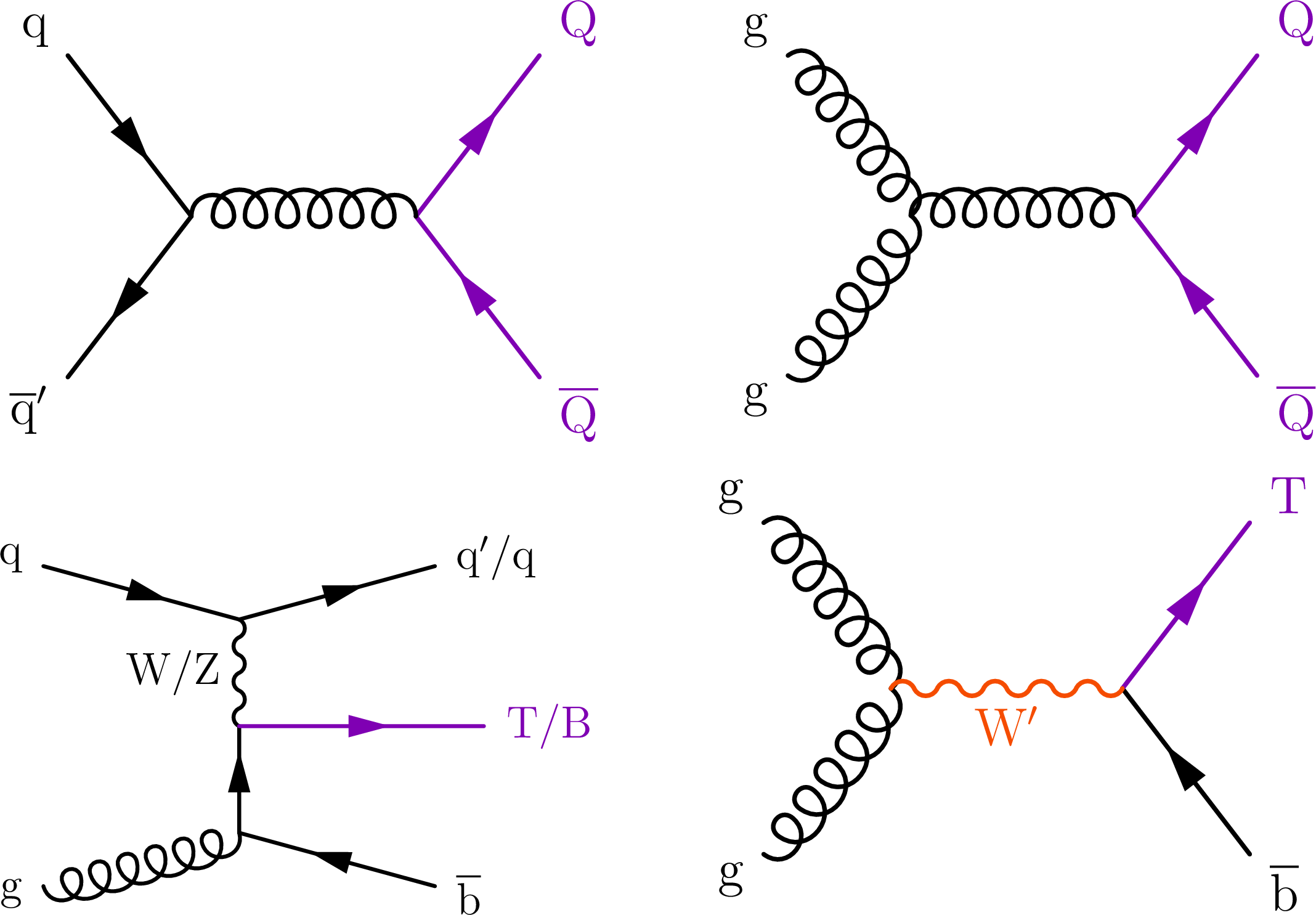
png pdf |
Figure 3:
Representative LO Feynman diagrams for pair production of VLQs via the strong interaction (upper row) and single production of VLQs via EW processes (lower left) or via new interactions (lower right). Here, Q stands for either VLQ flavor. |
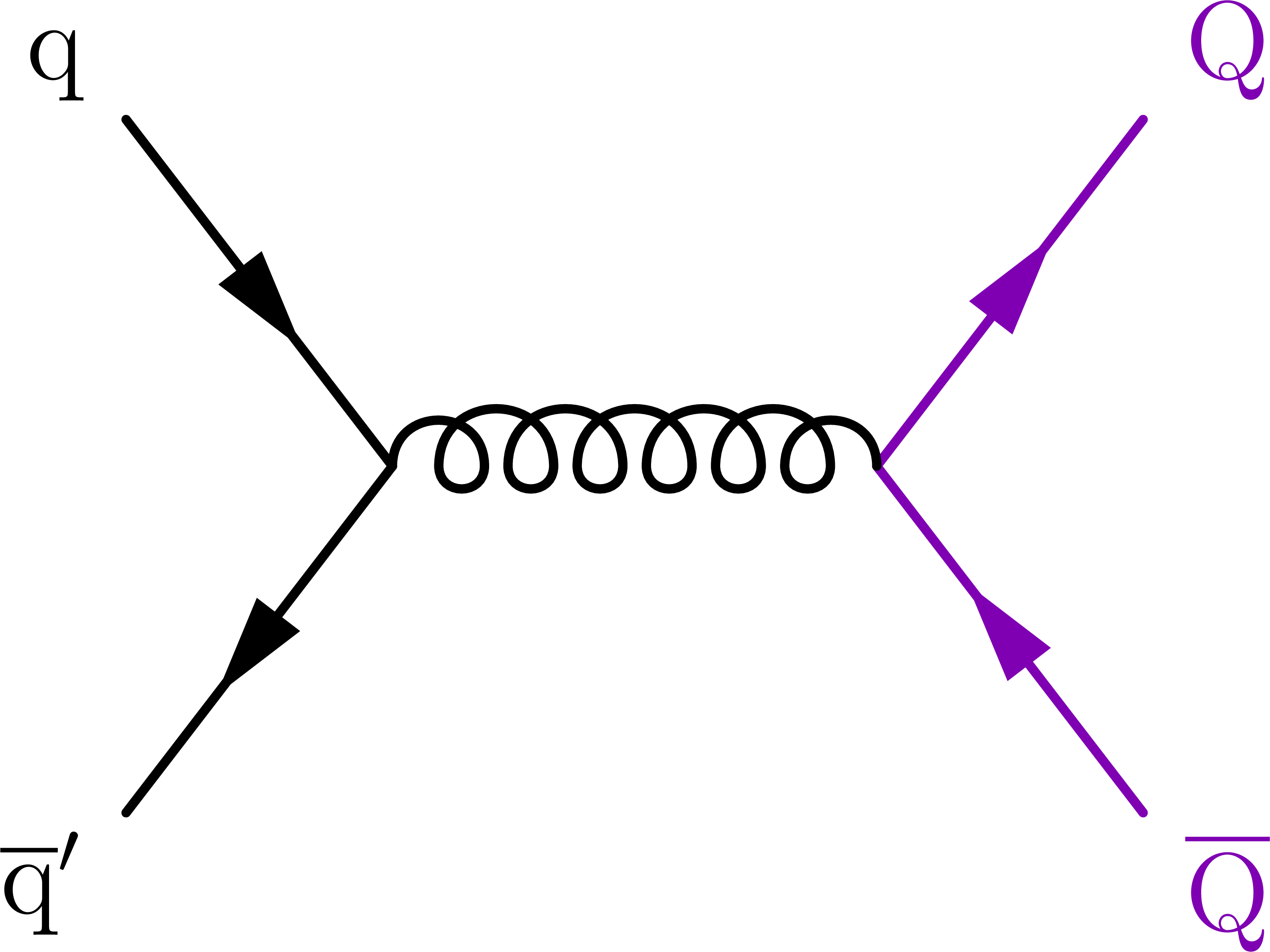
png pdf |
Figure 3-a:
Representative LO Feynman diagrams for pair production of VLQs via the strong interaction (upper row) and single production of VLQs via EW processes (lower left) or via new interactions (lower right). Here, Q stands for either VLQ flavor. |
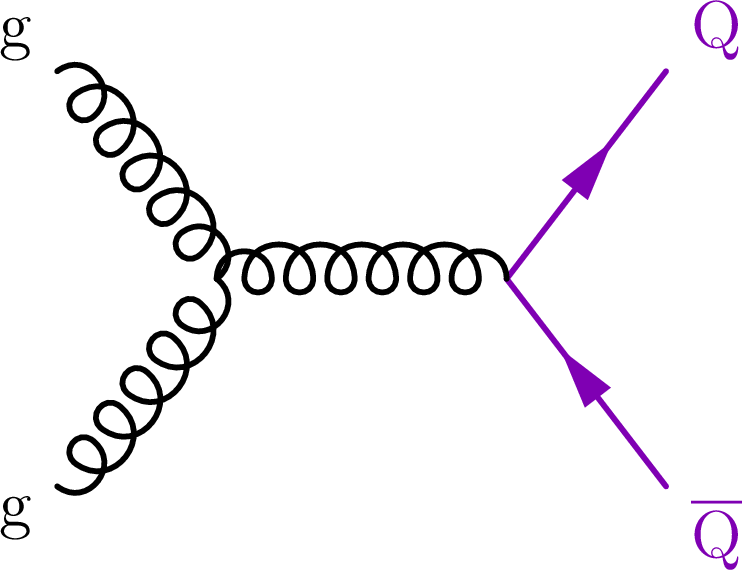
png pdf |
Figure 3-b:
Representative LO Feynman diagrams for pair production of VLQs via the strong interaction (upper row) and single production of VLQs via EW processes (lower left) or via new interactions (lower right). Here, Q stands for either VLQ flavor. |
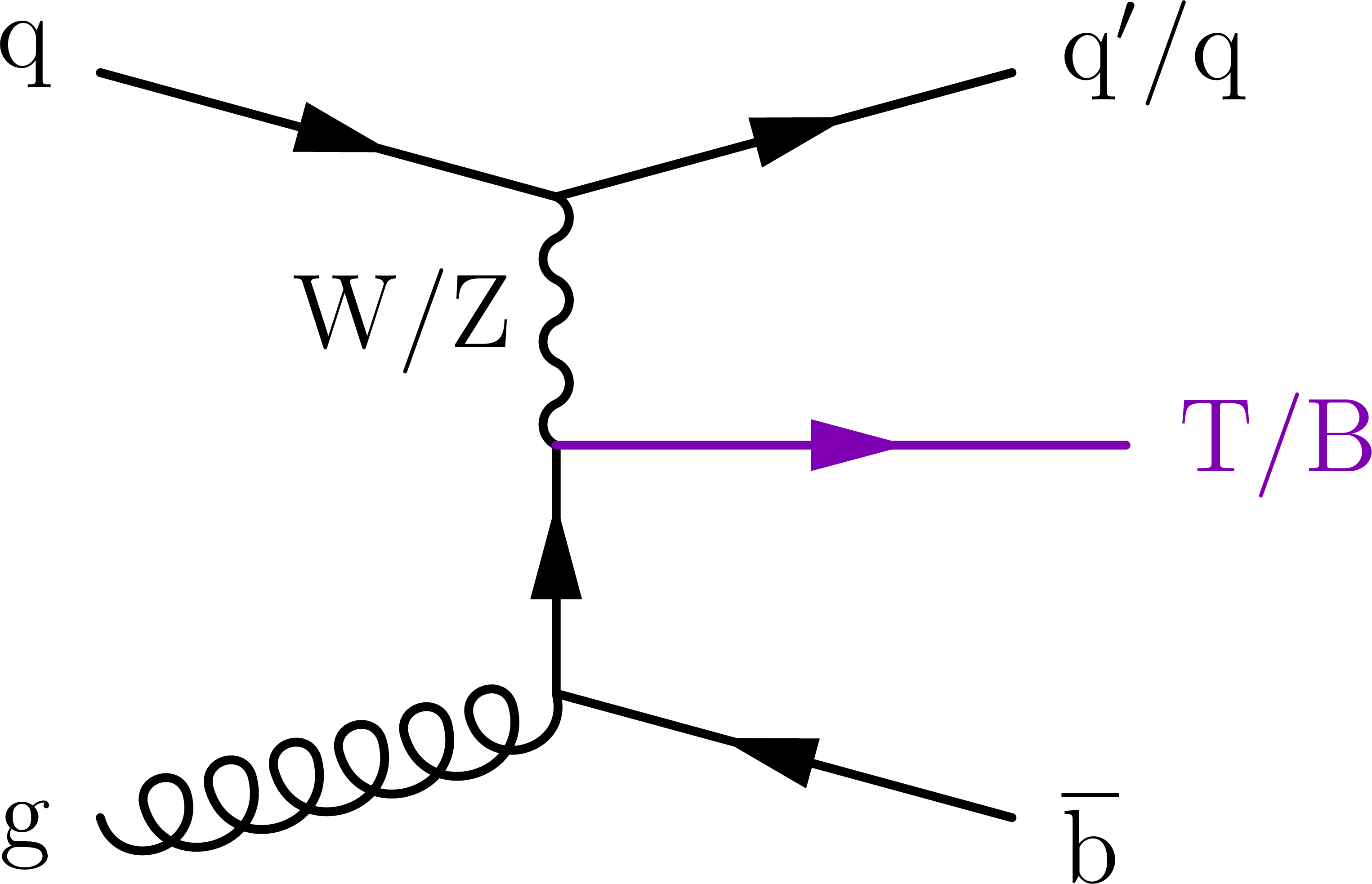
png pdf |
Figure 3-c:
Representative LO Feynman diagrams for pair production of VLQs via the strong interaction (upper row) and single production of VLQs via EW processes (lower left) or via new interactions (lower right). Here, Q stands for either VLQ flavor. |
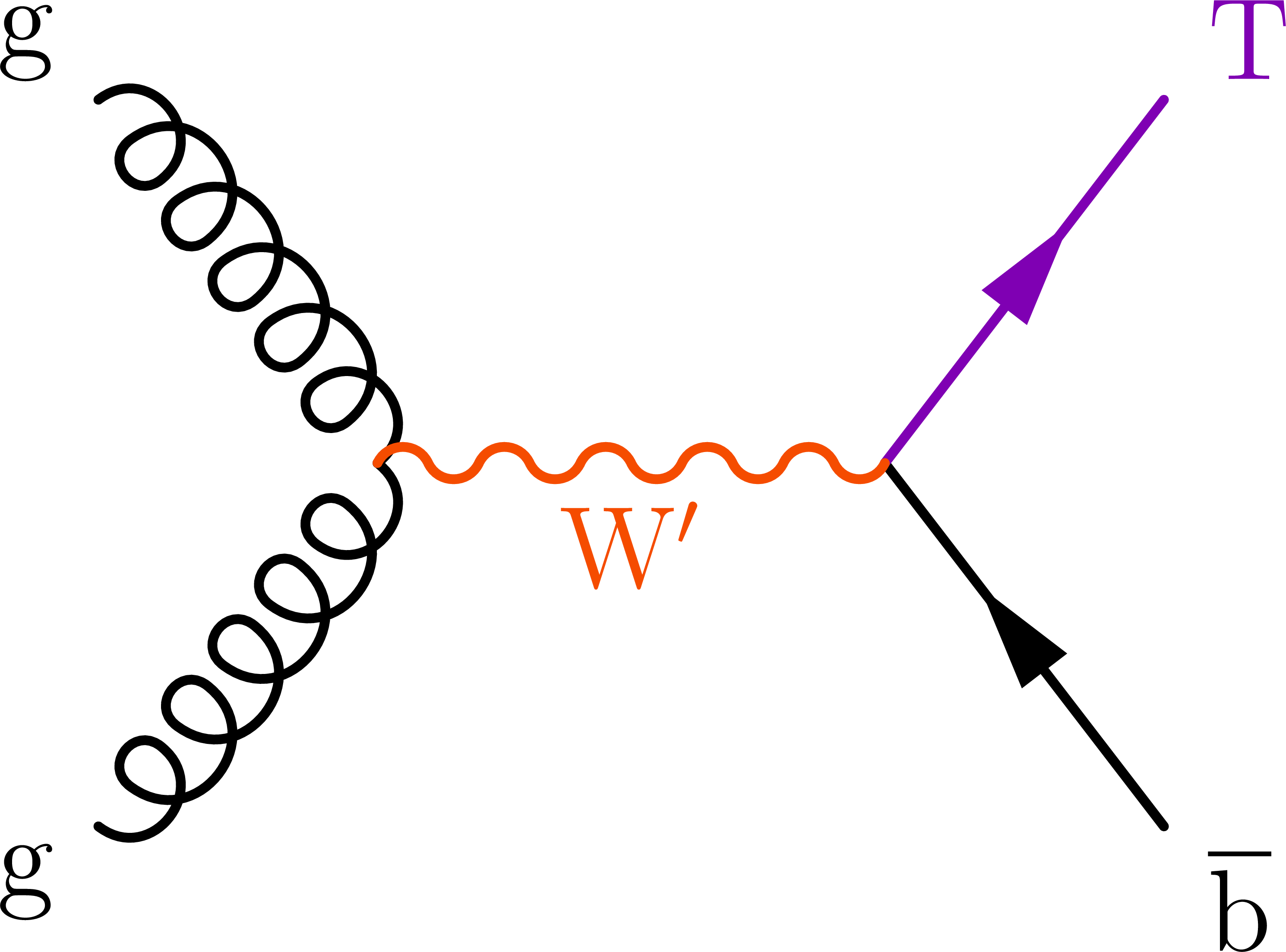
png pdf |
Figure 3-d:
Representative LO Feynman diagrams for pair production of VLQs via the strong interaction (upper row) and single production of VLQs via EW processes (lower left) or via new interactions (lower right). Here, Q stands for either VLQ flavor. |
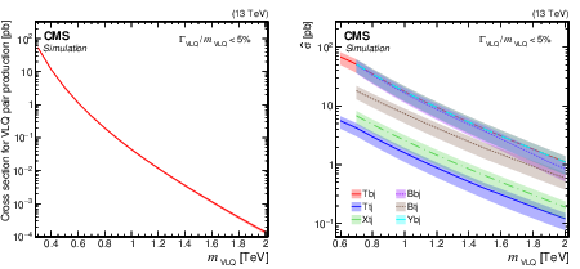
png pdf |
Figure 4:
Cross sections for the production of VLQs at $ \sqrt{s}= $ 13 TeV as a function of the VLQ mass. Pair production cross sections via the strong interaction are computed to NNLO, using the models and tools from Refs. [127,128,129] (left). Reduced cross section $ \hat{\sigma} $ for single production via the EW interaction is computed at LO in EW in the NWA using the models and tools from Refs. [130,128,118,131] (right). The shaded bands indicate PDF, renormalization scale, and factorization scale uncertainties associated with the predictions. |
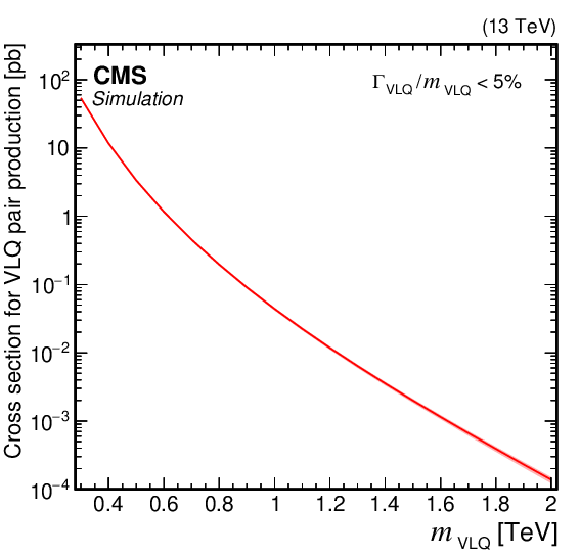
png pdf |
Figure 4-a:
Cross sections for the production of VLQs at $ \sqrt{s}= $ 13 TeV as a function of the VLQ mass. Pair production cross sections via the strong interaction are computed to NNLO, using the models and tools from Refs. [127,128,129] (left). Reduced cross section $ \hat{\sigma} $ for single production via the EW interaction is computed at LO in EW in the NWA using the models and tools from Refs. [130,128,118,131] (right). The shaded bands indicate PDF, renormalization scale, and factorization scale uncertainties associated with the predictions. |
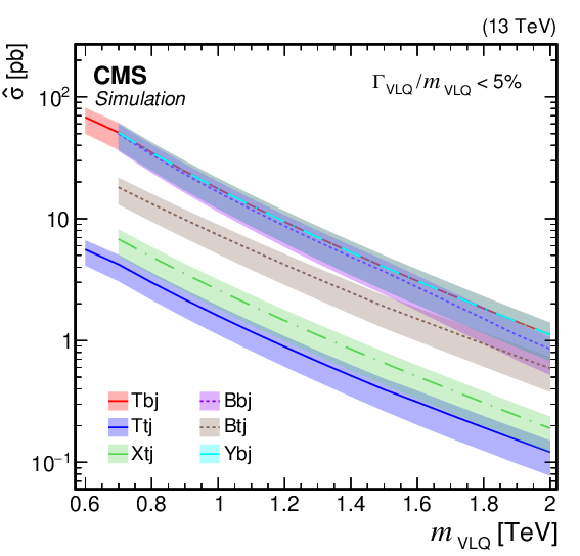
png pdf |
Figure 4-b:
Cross sections for the production of VLQs at $ \sqrt{s}= $ 13 TeV as a function of the VLQ mass. Pair production cross sections via the strong interaction are computed to NNLO, using the models and tools from Refs. [127,128,129] (left). Reduced cross section $ \hat{\sigma} $ for single production via the EW interaction is computed at LO in EW in the NWA using the models and tools from Refs. [130,128,118,131] (right). The shaded bands indicate PDF, renormalization scale, and factorization scale uncertainties associated with the predictions. |
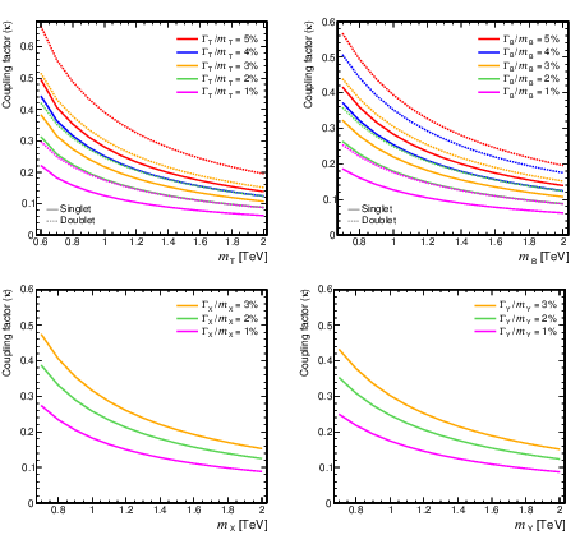
png pdf |
Figure 5:
Coupling factors for single VLQ production via the EW interaction in the narrow-width approximation as a function of the VLQ mass, using the models and tools from Refs. [130,128,118,131]. Coupling factors in single production of T (upper left), B (upper right) in the singlet (solid lines) and doublet (dashed lines) scenarios. Coupling factors in single production of $\mathrm{X}_{5/3}$ (lower left), $\mathrm{Y}_{4/3}$ (lower right) in doublet scenarios. |
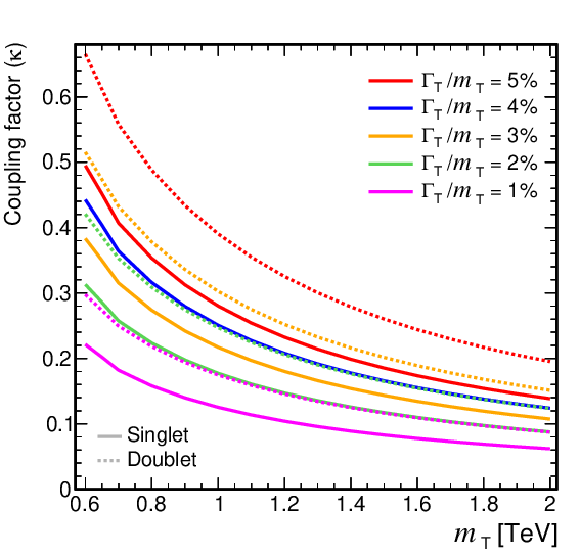
png pdf |
Figure 5-a:
Coupling factors for single VLQ production via the EW interaction in the narrow-width approximation as a function of the VLQ mass, using the models and tools from Refs. [130,128,118,131]. Coupling factors in single production of T (upper left), B (upper right) in the singlet (solid lines) and doublet (dashed lines) scenarios. Coupling factors in single production of $\mathrm{X}_{5/3}$ (lower left), $\mathrm{Y}_{4/3}$ (lower right) in doublet scenarios. |
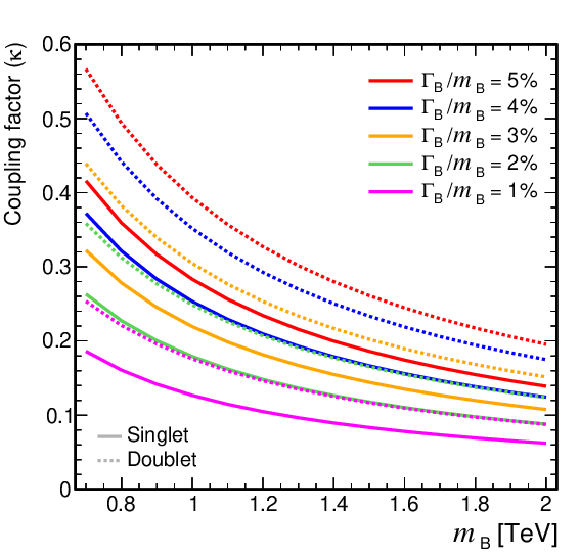
png pdf |
Figure 5-b:
Coupling factors for single VLQ production via the EW interaction in the narrow-width approximation as a function of the VLQ mass, using the models and tools from Refs. [130,128,118,131]. Coupling factors in single production of T (upper left), B (upper right) in the singlet (solid lines) and doublet (dashed lines) scenarios. Coupling factors in single production of $\mathrm{X}_{5/3}$ (lower left), $\mathrm{Y}_{4/3}$ (lower right) in doublet scenarios. |
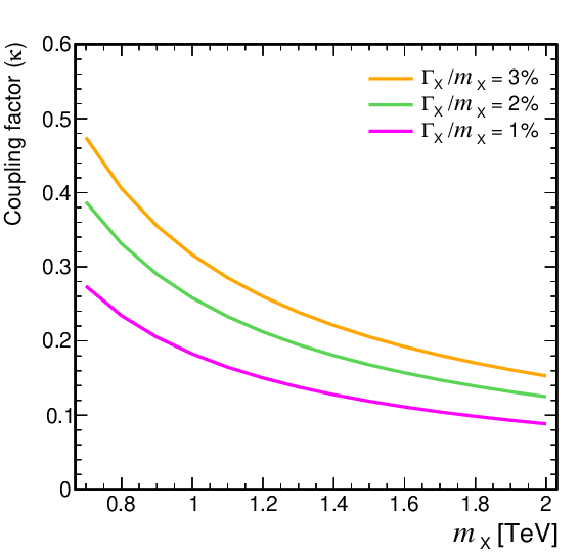
png pdf |
Figure 5-c:
Coupling factors for single VLQ production via the EW interaction in the narrow-width approximation as a function of the VLQ mass, using the models and tools from Refs. [130,128,118,131]. Coupling factors in single production of T (upper left), B (upper right) in the singlet (solid lines) and doublet (dashed lines) scenarios. Coupling factors in single production of $\mathrm{X}_{5/3}$ (lower left), $\mathrm{Y}_{4/3}$ (lower right) in doublet scenarios. |
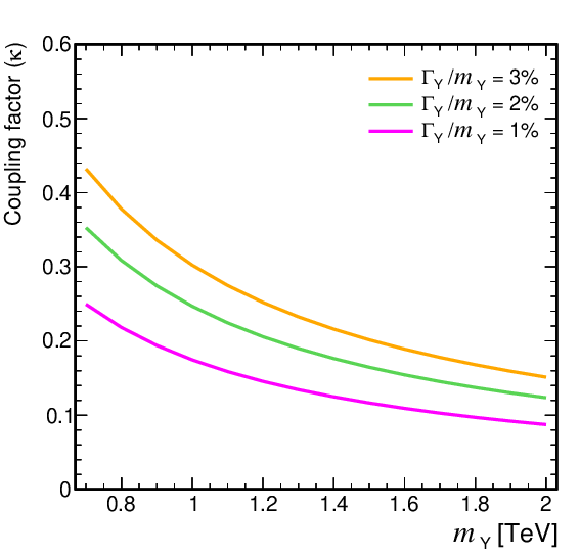
png pdf |
Figure 5-d:
Coupling factors for single VLQ production via the EW interaction in the narrow-width approximation as a function of the VLQ mass, using the models and tools from Refs. [130,128,118,131]. Coupling factors in single production of T (upper left), B (upper right) in the singlet (solid lines) and doublet (dashed lines) scenarios. Coupling factors in single production of $\mathrm{X}_{5/3}$ (lower left), $\mathrm{Y}_{4/3}$ (lower right) in doublet scenarios. |
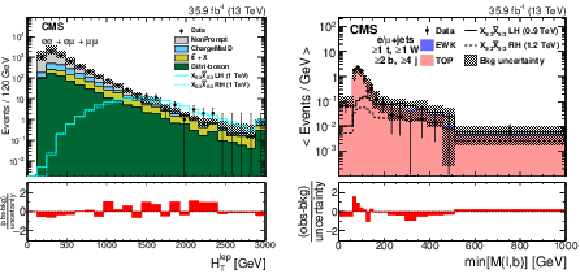
png pdf |
Figure 6:
Distributions of observables used to maximize the $ {\mathrm{X}_{5/3}} {\mathrm{X}_{5/3}} $ signal significance for the SSDL (left) and single-lepton (right) final states. The left figure shows the $ H_{\mathrm{T}}^{\text{lep}} $ distribution after the SS dilepton selection, Z boson and quarkonia lepton invariant mass vetoes, and the requirement of at least two small-radius jets in the event, for a combination of $ \mathrm{e}\mathrm{e} $, $ \mathrm{e}\mu $, and $ \mu\mu $ channels. The right figure shows the $ \min M(\ell,\mathrm{b}) $ distribution in events with $ \geq $1 t-tagged jet, $ \geq $1 W-tagged jets, and $ \geq $2 b-tagged jets for the combined electron and muon samples in the SR. The distribution has variable-size bins such that the statistical uncertainty in each bin is less than 30%. The lower panel in each plot shows the difference between the observed and the predicted numbers of events divided by the total uncertainty. Figures taken from Ref. [143]. |
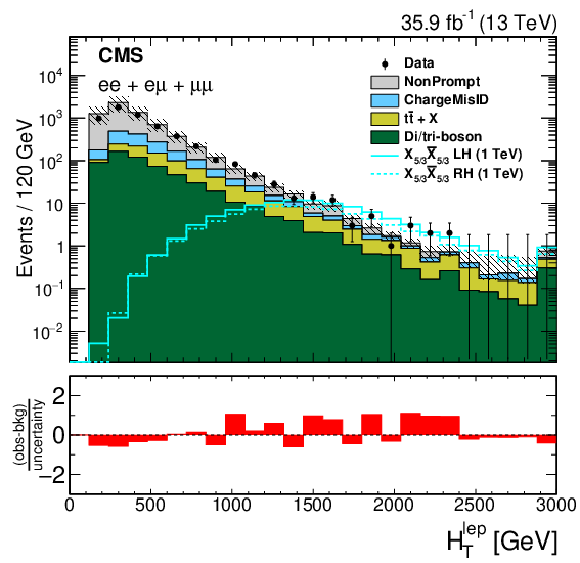
png pdf |
Figure 6-a:
Distributions of observables used to maximize the $ {\mathrm{X}_{5/3}} {\mathrm{X}_{5/3}} $ signal significance for the SSDL (left) and single-lepton (right) final states. The left figure shows the $ H_{\mathrm{T}}^{\text{lep}} $ distribution after the SS dilepton selection, Z boson and quarkonia lepton invariant mass vetoes, and the requirement of at least two small-radius jets in the event, for a combination of $ \mathrm{e}\mathrm{e} $, $ \mathrm{e}\mu $, and $ \mu\mu $ channels. The right figure shows the $ \min M(\ell,\mathrm{b}) $ distribution in events with $ \geq $1 t-tagged jet, $ \geq $1 W-tagged jets, and $ \geq $2 b-tagged jets for the combined electron and muon samples in the SR. The distribution has variable-size bins such that the statistical uncertainty in each bin is less than 30%. The lower panel in each plot shows the difference between the observed and the predicted numbers of events divided by the total uncertainty. Figures taken from Ref. [143]. |
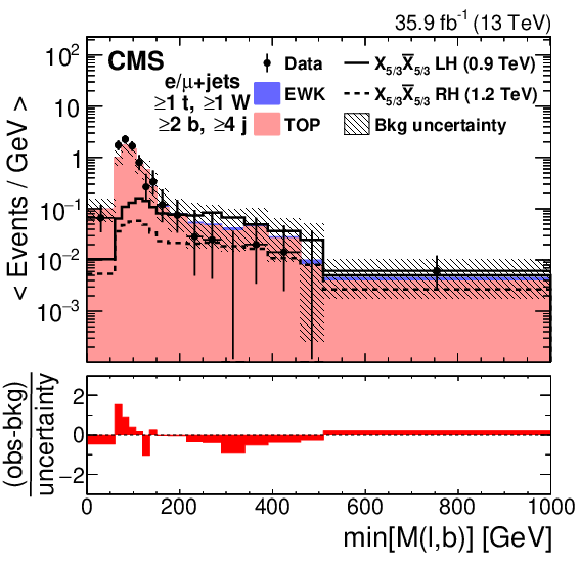
png pdf |
Figure 6-b:
Distributions of observables used to maximize the $ {\mathrm{X}_{5/3}} {\mathrm{X}_{5/3}} $ signal significance for the SSDL (left) and single-lepton (right) final states. The left figure shows the $ H_{\mathrm{T}}^{\text{lep}} $ distribution after the SS dilepton selection, Z boson and quarkonia lepton invariant mass vetoes, and the requirement of at least two small-radius jets in the event, for a combination of $ \mathrm{e}\mathrm{e} $, $ \mathrm{e}\mu $, and $ \mu\mu $ channels. The right figure shows the $ \min M(\ell,\mathrm{b}) $ distribution in events with $ \geq $1 t-tagged jet, $ \geq $1 W-tagged jets, and $ \geq $2 b-tagged jets for the combined electron and muon samples in the SR. The distribution has variable-size bins such that the statistical uncertainty in each bin is less than 30%. The lower panel in each plot shows the difference between the observed and the predicted numbers of events divided by the total uncertainty. Figures taken from Ref. [143]. |
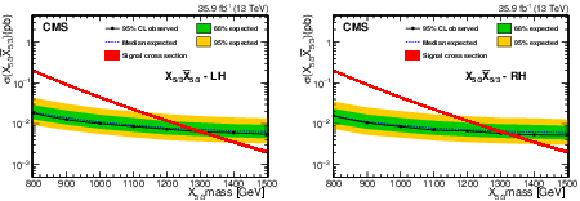
png pdf |
Figure 7:
Expected and observed cross section upper limits at 95% CL for an LH (left) and RH (right) $\mathrm{X}_{5/3}$ as a function of its mass, after combining the SS dilepton and single-lepton final states. The theoretical uncertainty in the signal cross section is shown with a band around the theoretical prediction. Figures adapted from Ref. [143]. |
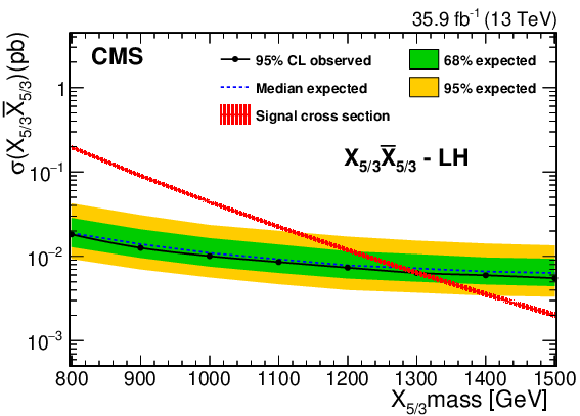
png pdf |
Figure 7-a:
Expected and observed cross section upper limits at 95% CL for an LH (left) and RH (right) $\mathrm{X}_{5/3}$ as a function of its mass, after combining the SS dilepton and single-lepton final states. The theoretical uncertainty in the signal cross section is shown with a band around the theoretical prediction. Figures adapted from Ref. [143]. |
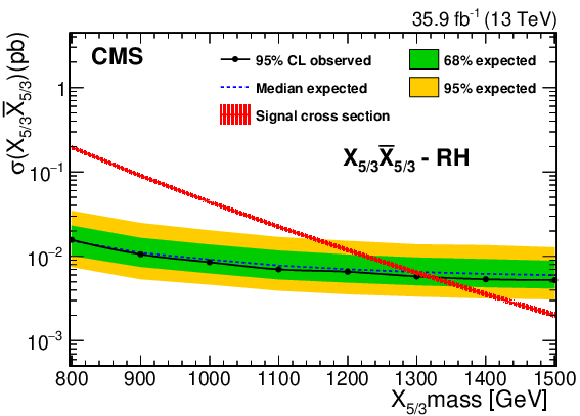
png pdf |
Figure 7-b:
Expected and observed cross section upper limits at 95% CL for an LH (left) and RH (right) $\mathrm{X}_{5/3}$ as a function of its mass, after combining the SS dilepton and single-lepton final states. The theoretical uncertainty in the signal cross section is shown with a band around the theoretical prediction. Figures adapted from Ref. [143]. |
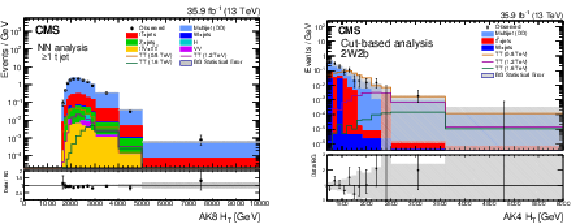
png pdf |
Figure 8:
Distributions of $ H_{\mathrm{T}} $ in a combination of SRs in the NN-based approach, inclusive in $ \geq $1 t tags (left), and in the SR with two W-tagged and two b-tagged jets in the selection-based approach (right). The lower panels show the ratio between observed data and the background estimate. Figures taken from Ref. [140]. |
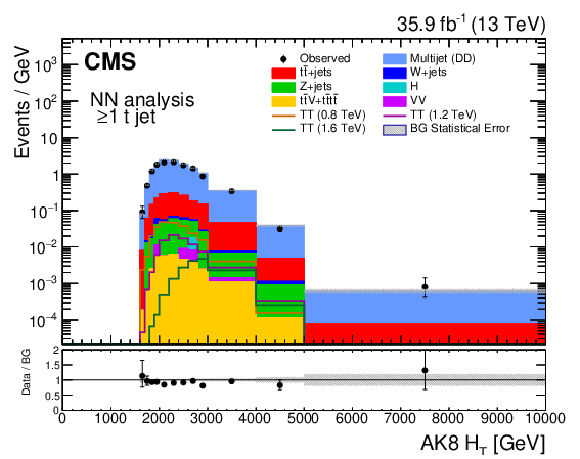
png pdf |
Figure 8-a:
Distributions of $ H_{\mathrm{T}} $ in a combination of SRs in the NN-based approach, inclusive in $ \geq $1 t tags (left), and in the SR with two W-tagged and two b-tagged jets in the selection-based approach (right). The lower panels show the ratio between observed data and the background estimate. Figures taken from Ref. [140]. |
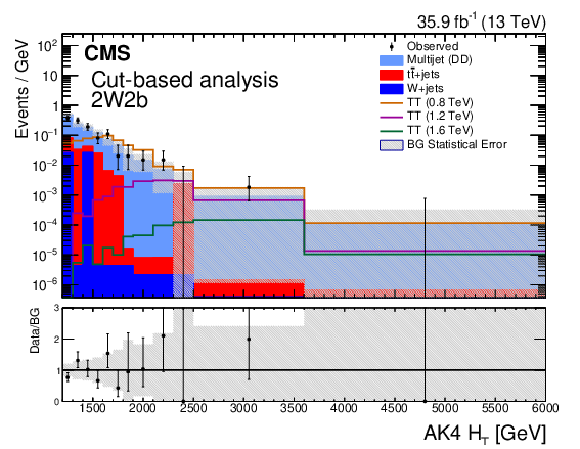
png pdf |
Figure 8-b:
Distributions of $ H_{\mathrm{T}} $ in a combination of SRs in the NN-based approach, inclusive in $ \geq $1 t tags (left), and in the SR with two W-tagged and two b-tagged jets in the selection-based approach (right). The lower panels show the ratio between observed data and the background estimate. Figures taken from Ref. [140]. |
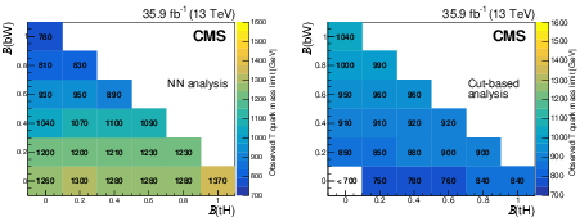
png pdf |
Figure 9:
Observed lower limits at 95% CL on the T quark mass as functions of the T quark branching fractions to $ \mathrm{t}\mathrm{H} $ and $ \mathrm{b}\mathrm{W} $, using the NN-based (left) and selection-based (right) approaches. Figures adapted from Ref. [140]. |
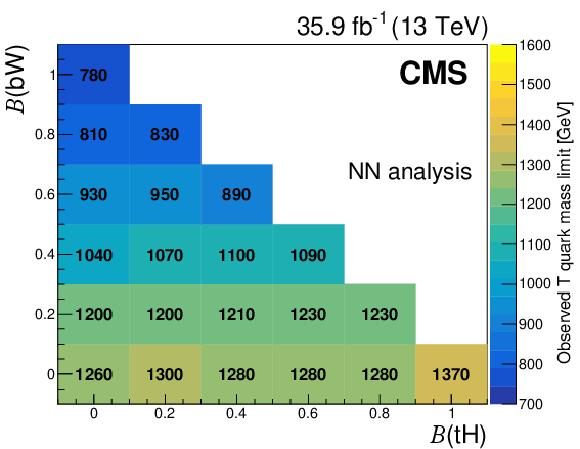
png pdf |
Figure 9-a:
Observed lower limits at 95% CL on the T quark mass as functions of the T quark branching fractions to $ \mathrm{t}\mathrm{H} $ and $ \mathrm{b}\mathrm{W} $, using the NN-based (left) and selection-based (right) approaches. Figures adapted from Ref. [140]. |
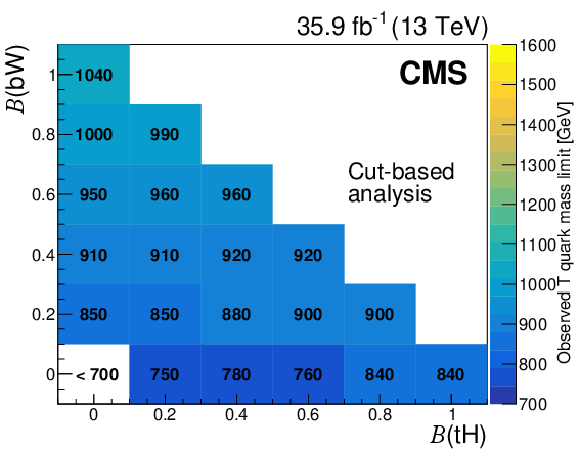
png pdf |
Figure 9-b:
Observed lower limits at 95% CL on the T quark mass as functions of the T quark branching fractions to $ \mathrm{t}\mathrm{H} $ and $ \mathrm{b}\mathrm{W} $, using the NN-based (left) and selection-based (right) approaches. Figures adapted from Ref. [140]. |
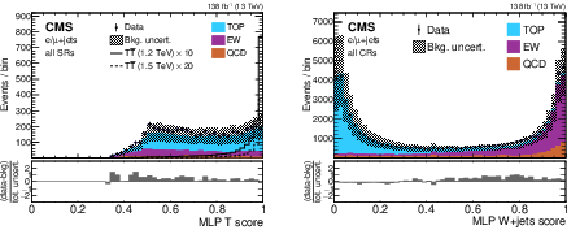
png pdf |
Figure 10:
Example single-lepton channel $ {\mathrm{T}} \overline{\mathrm{T}} $ NN output distributions of the T quark score in the inclusive SR (left) and the W+jets score in the CRs (right). The observed data are shown using black markers, predicted $ {\mathrm{T}} \overline{\mathrm{T}} $ signals with a T mass of 1.2 (1.5) TeV in the singlet scenario using solid (dashed) lines, and backgrounds using filled histograms. Statistical and systematic uncertainties in the background estimate before performing the fit to data are shown by the hatched region. The lower panels show the difference between the observed data and the background estimate as a multiple of the total uncertainty in both sources. The signal predictions in the left distribution have been scaled for visibility by the factor indicated in the figure. Figures taken from Ref. [141]. |
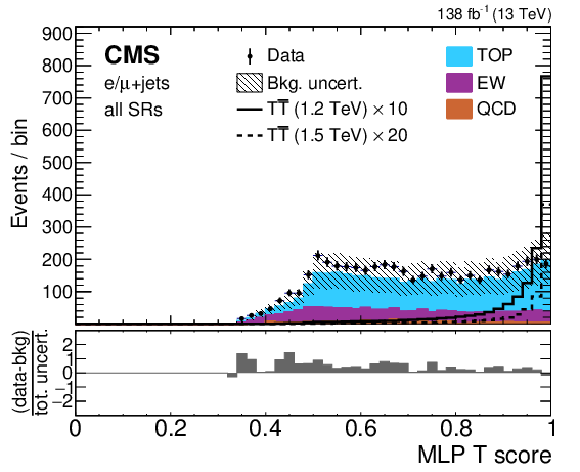
png pdf |
Figure 10-a:
Example single-lepton channel $ {\mathrm{T}} \overline{\mathrm{T}} $ NN output distributions of the T quark score in the inclusive SR (left) and the W+jets score in the CRs (right). The observed data are shown using black markers, predicted $ {\mathrm{T}} \overline{\mathrm{T}} $ signals with a T mass of 1.2 (1.5) TeV in the singlet scenario using solid (dashed) lines, and backgrounds using filled histograms. Statistical and systematic uncertainties in the background estimate before performing the fit to data are shown by the hatched region. The lower panels show the difference between the observed data and the background estimate as a multiple of the total uncertainty in both sources. The signal predictions in the left distribution have been scaled for visibility by the factor indicated in the figure. Figures taken from Ref. [141]. |
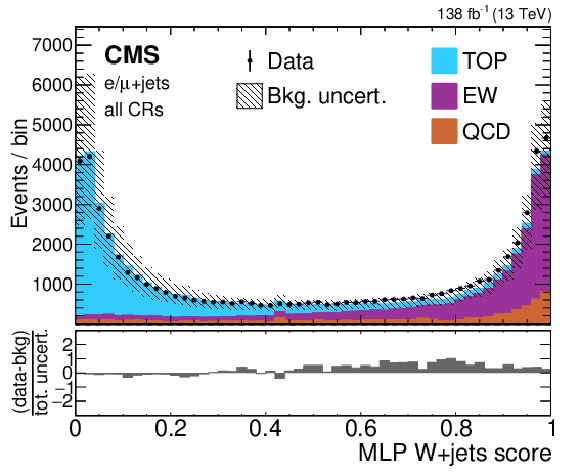
png pdf |
Figure 10-b:
Example single-lepton channel $ {\mathrm{T}} \overline{\mathrm{T}} $ NN output distributions of the T quark score in the inclusive SR (left) and the W+jets score in the CRs (right). The observed data are shown using black markers, predicted $ {\mathrm{T}} \overline{\mathrm{T}} $ signals with a T mass of 1.2 (1.5) TeV in the singlet scenario using solid (dashed) lines, and backgrounds using filled histograms. Statistical and systematic uncertainties in the background estimate before performing the fit to data are shown by the hatched region. The lower panels show the difference between the observed data and the background estimate as a multiple of the total uncertainty in both sources. The signal predictions in the left distribution have been scaled for visibility by the factor indicated in the figure. Figures taken from Ref. [141]. |
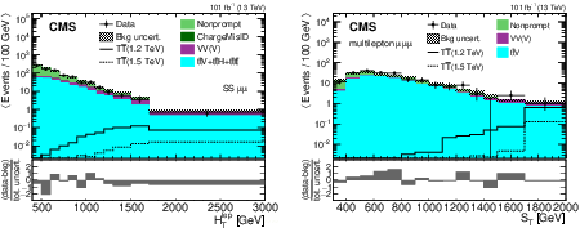
png pdf |
Figure 11:
Template histograms of $ H_{\mathrm{T}}^{\text{lep}} $ in the $ \mu\mu $ category of the SS dilepton channel (left) and $ S_{\mathrm{T}} $ in the $ \mu\mu\mu $ category of the multilepton channel (right). The observed data from 2017--2018 (combined for illustration) are shown using black markers, the predicted $ {\mathrm{T}} \overline{\mathrm{T}} $ signal for a mass of 1.2 (1.5) TeV in the singlet scenario using solid (dashed) lines, and the postfit background estimates using filled histograms. Statistical and systematic uncertainties in the background estimate after performing the fit to the observed data are shown by the hatched region. The lower panels show the difference between the observed data and the background estimate as a multiple of the total uncertainty from both sources. Figures adapted from Ref. [141]. |
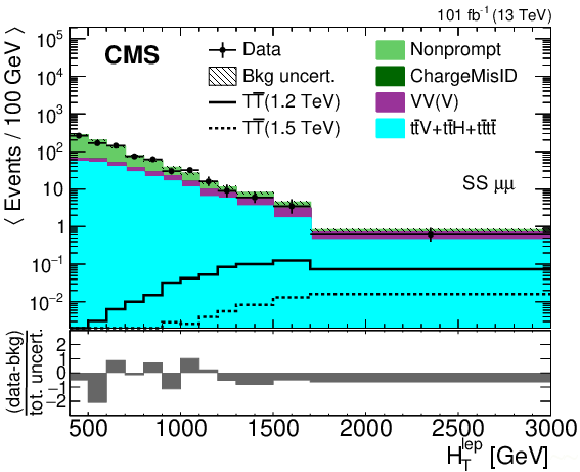
png pdf |
Figure 11-a:
Template histograms of $ H_{\mathrm{T}}^{\text{lep}} $ in the $ \mu\mu $ category of the SS dilepton channel (left) and $ S_{\mathrm{T}} $ in the $ \mu\mu\mu $ category of the multilepton channel (right). The observed data from 2017--2018 (combined for illustration) are shown using black markers, the predicted $ {\mathrm{T}} \overline{\mathrm{T}} $ signal for a mass of 1.2 (1.5) TeV in the singlet scenario using solid (dashed) lines, and the postfit background estimates using filled histograms. Statistical and systematic uncertainties in the background estimate after performing the fit to the observed data are shown by the hatched region. The lower panels show the difference between the observed data and the background estimate as a multiple of the total uncertainty from both sources. Figures adapted from Ref. [141]. |
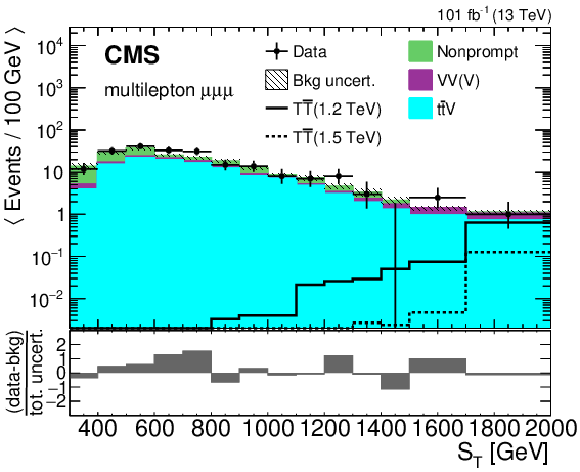
png pdf |
Figure 11-b:
Template histograms of $ H_{\mathrm{T}}^{\text{lep}} $ in the $ \mu\mu $ category of the SS dilepton channel (left) and $ S_{\mathrm{T}} $ in the $ \mu\mu\mu $ category of the multilepton channel (right). The observed data from 2017--2018 (combined for illustration) are shown using black markers, the predicted $ {\mathrm{T}} \overline{\mathrm{T}} $ signal for a mass of 1.2 (1.5) TeV in the singlet scenario using solid (dashed) lines, and the postfit background estimates using filled histograms. Statistical and systematic uncertainties in the background estimate after performing the fit to the observed data are shown by the hatched region. The lower panels show the difference between the observed data and the background estimate as a multiple of the total uncertainty from both sources. Figures adapted from Ref. [141]. |
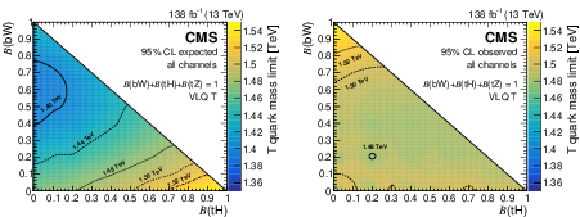
png pdf |
Figure 12:
The 95% CL expected (left) and observed (right) lower mass limits on pair-produced T quark masses, from the combined fit to the three leptonic channels, as functions of their branching fractions to Higgs and W bosons. Mass contours are shown with lines of various styles. Figures adapted from Ref. [141]. |
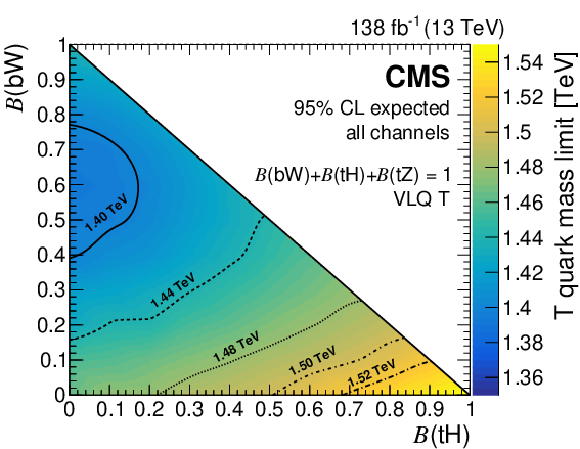
png pdf |
Figure 12-a:
The 95% CL expected (left) and observed (right) lower mass limits on pair-produced T quark masses, from the combined fit to the three leptonic channels, as functions of their branching fractions to Higgs and W bosons. Mass contours are shown with lines of various styles. Figures adapted from Ref. [141]. |
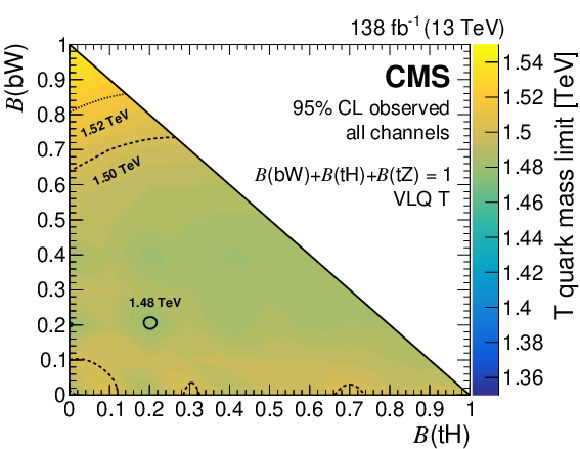
png pdf |
Figure 12-b:
The 95% CL expected (left) and observed (right) lower mass limits on pair-produced T quark masses, from the combined fit to the three leptonic channels, as functions of their branching fractions to Higgs and W bosons. Mass contours are shown with lines of various styles. Figures adapted from Ref. [141]. |
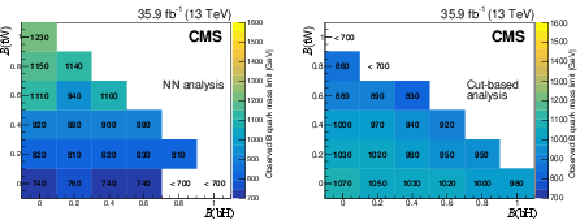
png pdf |
Figure 13:
The 95% CL expected (left) and observed (right) lower mass limits on pair-produced B quark masses, from the combined fit to the three leptonic channels, as functions of branching fractions to Higgs and W bosons. Mass contours are shown with lines of various styles. Figures adapted from Ref. [141]. |
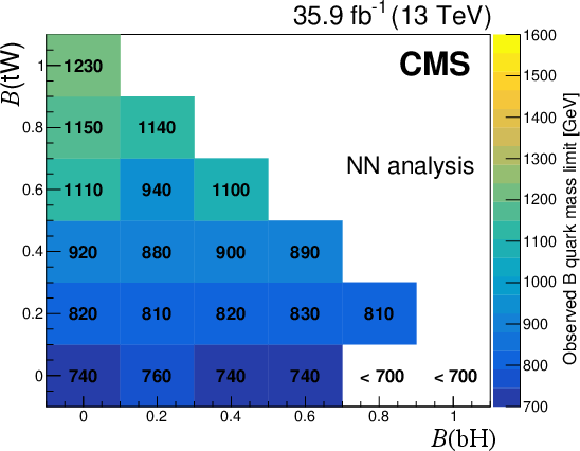
png pdf |
Figure 13-a:
The 95% CL expected (left) and observed (right) lower mass limits on pair-produced B quark masses, from the combined fit to the three leptonic channels, as functions of branching fractions to Higgs and W bosons. Mass contours are shown with lines of various styles. Figures adapted from Ref. [141]. |
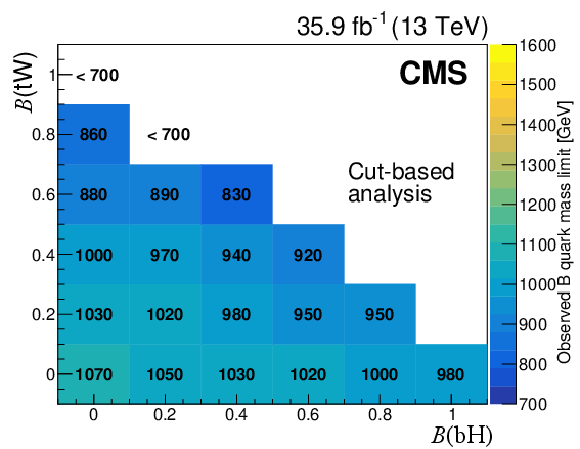
png pdf |
Figure 13-b:
The 95% CL expected (left) and observed (right) lower mass limits on pair-produced B quark masses, from the combined fit to the three leptonic channels, as functions of branching fractions to Higgs and W bosons. Mass contours are shown with lines of various styles. Figures adapted from Ref. [141]. |
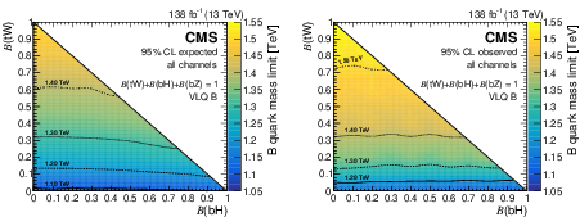
png pdf |
Figure 14:
Observed lower limit at 95% CL on B quark masses as a function of the branching fractions to $ \mathrm{b}\mathrm{H} $ and $ \mathrm{t}\mathrm{W} $, for the NN-based (left) and selection-based (right) approaches of the search for $ {\mathrm{B}} \overline{\mathrm{B}} $ production in the all-hadronic final state. Figures adapted from Ref. [140]. |
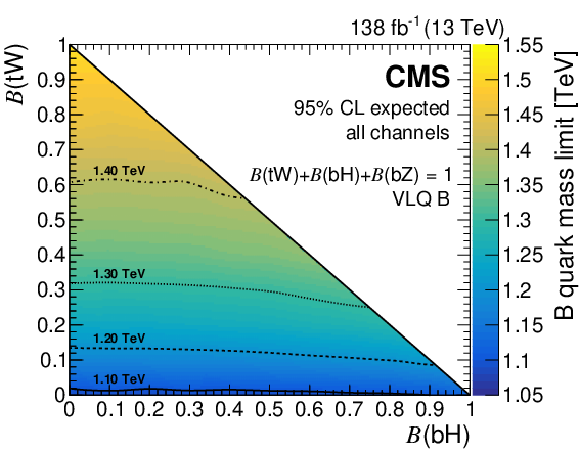
png pdf |
Figure 14-a:
Observed lower limit at 95% CL on B quark masses as a function of the branching fractions to $ \mathrm{b}\mathrm{H} $ and $ \mathrm{t}\mathrm{W} $, for the NN-based (left) and selection-based (right) approaches of the search for $ {\mathrm{B}} \overline{\mathrm{B}} $ production in the all-hadronic final state. Figures adapted from Ref. [140]. |
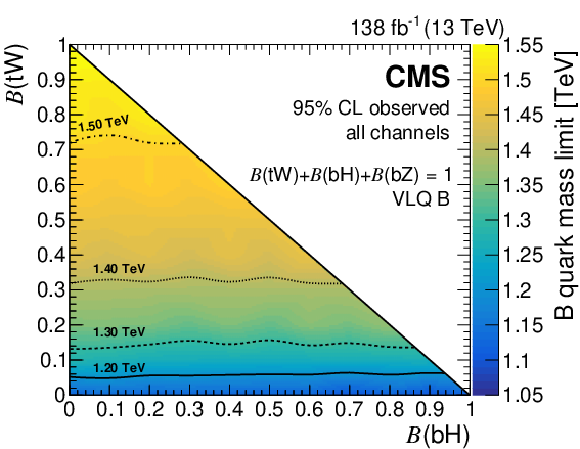
png pdf |
Figure 14-b:
Observed lower limit at 95% CL on B quark masses as a function of the branching fractions to $ \mathrm{b}\mathrm{H} $ and $ \mathrm{t}\mathrm{W} $, for the NN-based (left) and selection-based (right) approaches of the search for $ {\mathrm{B}} \overline{\mathrm{B}} $ production in the all-hadronic final state. Figures adapted from Ref. [140]. |
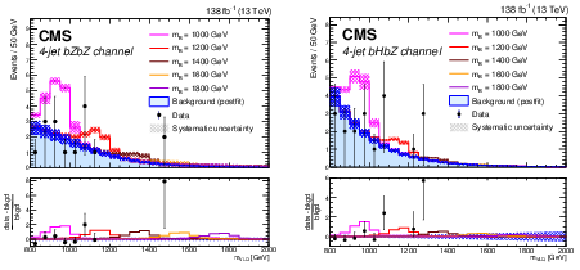
png pdf |
Figure 15:
Distributions of the reconstructed VLQ mass for expected background (blue histogram), signal plus background (colored lines), and observed data (black points) for events in the hadronic four-jet $ \mathrm{b}\mathrm{Z}\mathrm{b}\mathrm{Z} $ category (left) and the leptonic four-jet $ \mathrm{b}\mathrm{H}\mathrm{b}\mathrm{Z} $ category (right) in the search for $ {\mathrm{B}} \overline{\mathrm{B}} $ production. Five signal masses are shown: 1000 GeV (pink), 1200 GeV (red), 1400 GeV (orange), 1600 GeV (yellow), and 1800 GeV (green). The signal distributions are normalized to the number of events determined by the expected VLQ production cross section. The hatched regions indicate the total systematic uncertainty in the background estimate. The lower panels show the difference between the observed data and the background estimate as a multiple of the background estimate. Figures taken from Ref. [142]. |
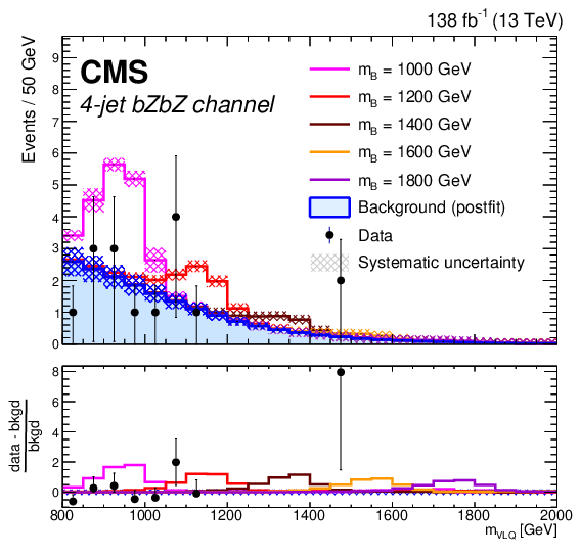
png pdf |
Figure 15-a:
Distributions of the reconstructed VLQ mass for expected background (blue histogram), signal plus background (colored lines), and observed data (black points) for events in the hadronic four-jet $ \mathrm{b}\mathrm{Z}\mathrm{b}\mathrm{Z} $ category (left) and the leptonic four-jet $ \mathrm{b}\mathrm{H}\mathrm{b}\mathrm{Z} $ category (right) in the search for $ {\mathrm{B}} \overline{\mathrm{B}} $ production. Five signal masses are shown: 1000 GeV (pink), 1200 GeV (red), 1400 GeV (orange), 1600 GeV (yellow), and 1800 GeV (green). The signal distributions are normalized to the number of events determined by the expected VLQ production cross section. The hatched regions indicate the total systematic uncertainty in the background estimate. The lower panels show the difference between the observed data and the background estimate as a multiple of the background estimate. Figures taken from Ref. [142]. |
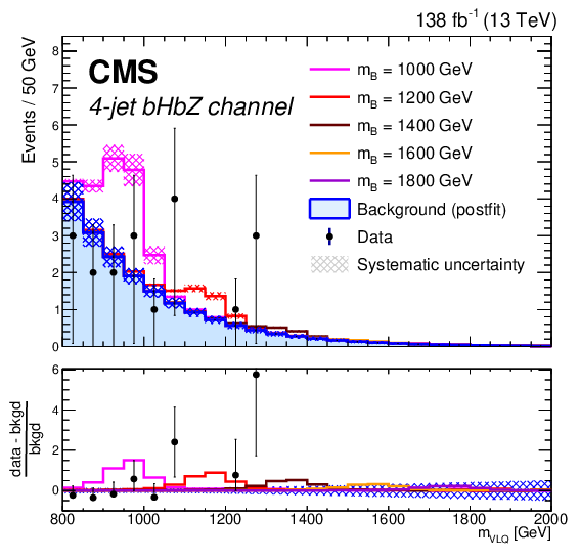
png pdf |
Figure 15-b:
Distributions of the reconstructed VLQ mass for expected background (blue histogram), signal plus background (colored lines), and observed data (black points) for events in the hadronic four-jet $ \mathrm{b}\mathrm{Z}\mathrm{b}\mathrm{Z} $ category (left) and the leptonic four-jet $ \mathrm{b}\mathrm{H}\mathrm{b}\mathrm{Z} $ category (right) in the search for $ {\mathrm{B}} \overline{\mathrm{B}} $ production. Five signal masses are shown: 1000 GeV (pink), 1200 GeV (red), 1400 GeV (orange), 1600 GeV (yellow), and 1800 GeV (green). The signal distributions are normalized to the number of events determined by the expected VLQ production cross section. The hatched regions indicate the total systematic uncertainty in the background estimate. The lower panels show the difference between the observed data and the background estimate as a multiple of the background estimate. Figures taken from Ref. [142]. |
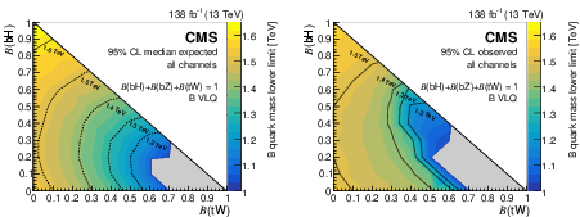
png pdf |
Figure 16:
Expected (left) and observed (right) lower limits on the B quark mass at 95% CL from the combination of the full Run 2 hadronic and OS dilepton channels, as a function of the branching fractions $ \mathcal{B}({\mathrm{B}} \to\mathrm{b}\mathrm{H}) $ and $ \mathcal{B}({\mathrm{B}} \to\mathrm{t}\mathrm{W}) $, with $ \mathcal{B}({\mathrm{B}} \to\mathrm{t}\mathrm{W})=1-\mathcal{B}({\mathrm{B}} \to\mathrm{b}\mathrm{H})-\mathcal{B}({\mathrm{B}} \to\mathrm{b}\mathrm{Z}) $. Results in the grey region, where the lower limit is less than 1.0 TeV, are omitted. Figures adapted from Ref. [142]. |
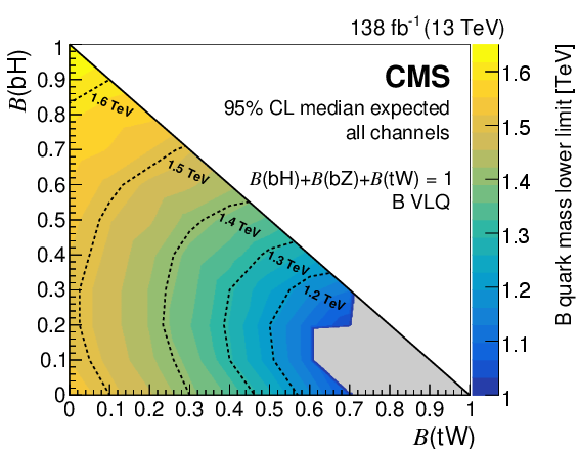
png pdf |
Figure 16-a:
Expected (left) and observed (right) lower limits on the B quark mass at 95% CL from the combination of the full Run 2 hadronic and OS dilepton channels, as a function of the branching fractions $ \mathcal{B}({\mathrm{B}} \to\mathrm{b}\mathrm{H}) $ and $ \mathcal{B}({\mathrm{B}} \to\mathrm{t}\mathrm{W}) $, with $ \mathcal{B}({\mathrm{B}} \to\mathrm{t}\mathrm{W})=1-\mathcal{B}({\mathrm{B}} \to\mathrm{b}\mathrm{H})-\mathcal{B}({\mathrm{B}} \to\mathrm{b}\mathrm{Z}) $. Results in the grey region, where the lower limit is less than 1.0 TeV, are omitted. Figures adapted from Ref. [142]. |
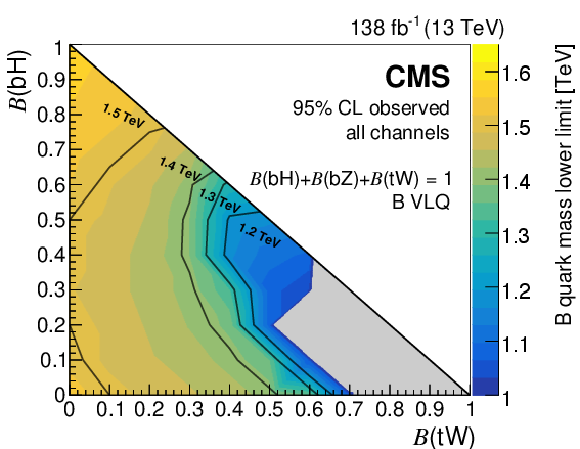
png pdf |
Figure 16-b:
Expected (left) and observed (right) lower limits on the B quark mass at 95% CL from the combination of the full Run 2 hadronic and OS dilepton channels, as a function of the branching fractions $ \mathcal{B}({\mathrm{B}} \to\mathrm{b}\mathrm{H}) $ and $ \mathcal{B}({\mathrm{B}} \to\mathrm{t}\mathrm{W}) $, with $ \mathcal{B}({\mathrm{B}} \to\mathrm{t}\mathrm{W})=1-\mathcal{B}({\mathrm{B}} \to\mathrm{b}\mathrm{H})-\mathcal{B}({\mathrm{B}} \to\mathrm{b}\mathrm{Z}) $. Results in the grey region, where the lower limit is less than 1.0 TeV, are omitted. Figures adapted from Ref. [142]. |
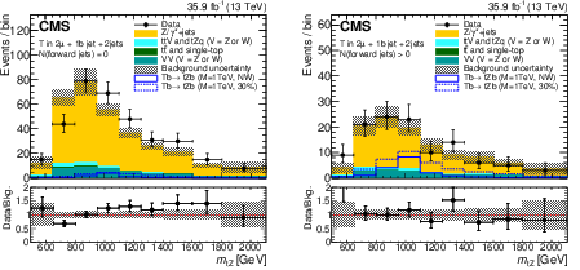
png pdf |
Figure 17:
Distributions of the reconstructed T quark mass, $ m_{\mathrm{t}\mathrm{Z}} $ for the observed data, the background estimates, and the expected signal for the two categories where the singly produced T quark is reconstructed in the resolved topology for events with the Z boson decaying into muons and no forward jets (left) and at least one forward jet (right). The background composition is taken from simulation. The expected signal is shown for two benchmark values of the width, for a T quark produced in association with a b quark: NWA and 30% of the T quark mass. The lower panel in each plot shows the ratio of the observed data to the background estimation, with the hatched band representing the uncertainties in the background estimate. Figures taken from Ref. [144]. |
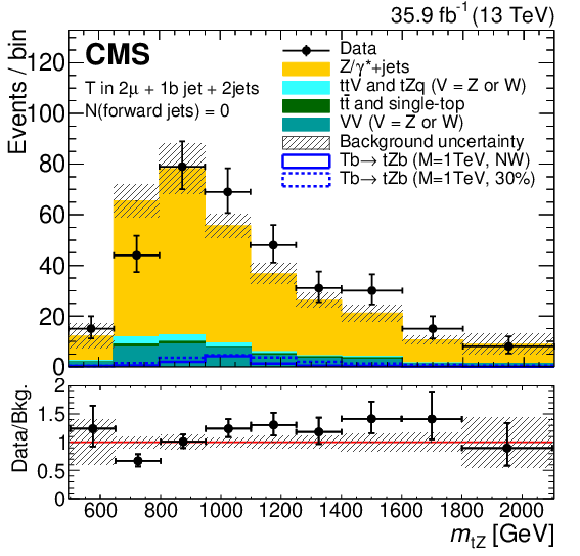
png pdf |
Figure 17-a:
Distributions of the reconstructed T quark mass, $ m_{\mathrm{t}\mathrm{Z}} $ for the observed data, the background estimates, and the expected signal for the two categories where the singly produced T quark is reconstructed in the resolved topology for events with the Z boson decaying into muons and no forward jets (left) and at least one forward jet (right). The background composition is taken from simulation. The expected signal is shown for two benchmark values of the width, for a T quark produced in association with a b quark: NWA and 30% of the T quark mass. The lower panel in each plot shows the ratio of the observed data to the background estimation, with the hatched band representing the uncertainties in the background estimate. Figures taken from Ref. [144]. |
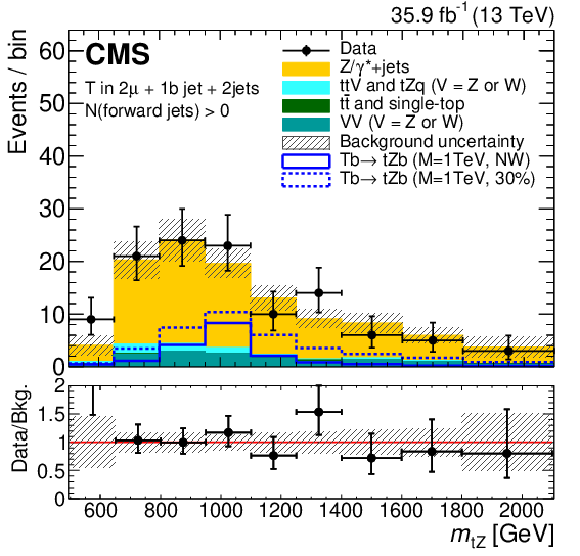
png pdf |
Figure 17-b:
Distributions of the reconstructed T quark mass, $ m_{\mathrm{t}\mathrm{Z}} $ for the observed data, the background estimates, and the expected signal for the two categories where the singly produced T quark is reconstructed in the resolved topology for events with the Z boson decaying into muons and no forward jets (left) and at least one forward jet (right). The background composition is taken from simulation. The expected signal is shown for two benchmark values of the width, for a T quark produced in association with a b quark: NWA and 30% of the T quark mass. The lower panel in each plot shows the ratio of the observed data to the background estimation, with the hatched band representing the uncertainties in the background estimate. Figures taken from Ref. [144]. |
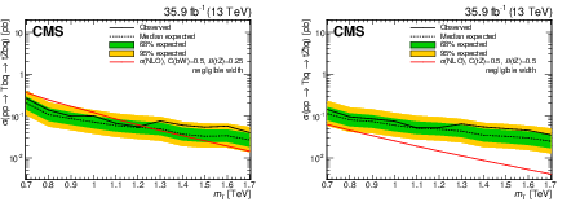
png pdf |
Figure 18:
Observed and expected upper limits on the product of the cross section and branching fraction for singlet LH T quark (left) and doublet RH T quark production (right) in association with a b quark and a t quark, respectively, in the NWA hypothesis. The T quark decays to $ \mathrm{t}\mathrm{Z} $ with a branching fraction $ \mathcal{B}({\mathrm{T}} \to\mathrm{t}\mathrm{Z}) $ of 0.25 (0.5) for the left (right) figure. The red lines represent theoretical cross sections calculated at NLO in perturbative QCD, whereas the inner (green) band and the outer (yellow) band indicate the regions containing 68 and 95%, respectively, of the distribution of limits expected under the background-only hypothesis. Figures taken from Ref. [144]. |
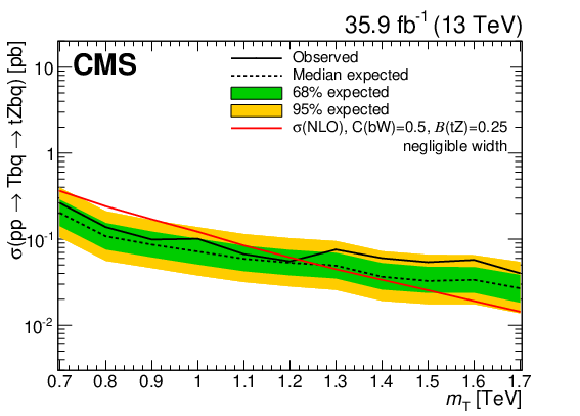
png pdf |
Figure 18-a:
Observed and expected upper limits on the product of the cross section and branching fraction for singlet LH T quark (left) and doublet RH T quark production (right) in association with a b quark and a t quark, respectively, in the NWA hypothesis. The T quark decays to $ \mathrm{t}\mathrm{Z} $ with a branching fraction $ \mathcal{B}({\mathrm{T}} \to\mathrm{t}\mathrm{Z}) $ of 0.25 (0.5) for the left (right) figure. The red lines represent theoretical cross sections calculated at NLO in perturbative QCD, whereas the inner (green) band and the outer (yellow) band indicate the regions containing 68 and 95%, respectively, of the distribution of limits expected under the background-only hypothesis. Figures taken from Ref. [144]. |
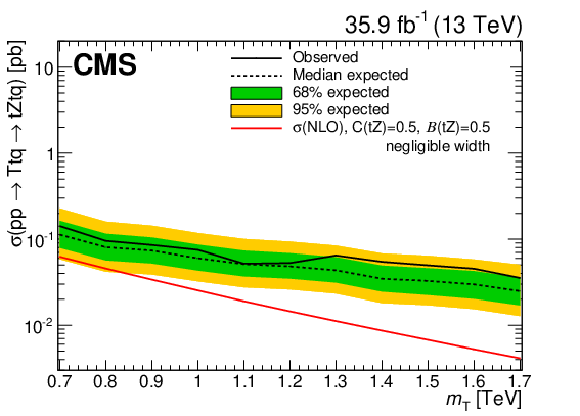
png pdf |
Figure 18-b:
Observed and expected upper limits on the product of the cross section and branching fraction for singlet LH T quark (left) and doublet RH T quark production (right) in association with a b quark and a t quark, respectively, in the NWA hypothesis. The T quark decays to $ \mathrm{t}\mathrm{Z} $ with a branching fraction $ \mathcal{B}({\mathrm{T}} \to\mathrm{t}\mathrm{Z}) $ of 0.25 (0.5) for the left (right) figure. The red lines represent theoretical cross sections calculated at NLO in perturbative QCD, whereas the inner (green) band and the outer (yellow) band indicate the regions containing 68 and 95%, respectively, of the distribution of limits expected under the background-only hypothesis. Figures taken from Ref. [144]. |
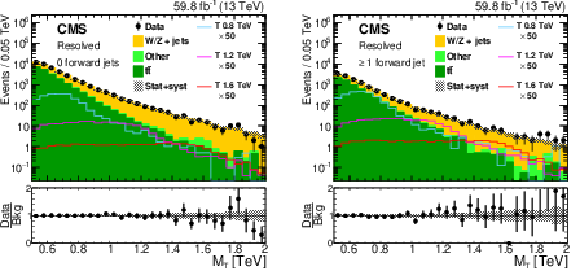
png pdf |
Figure 19:
Distributions from the 2018 data set of the transverse mass of the reconstructed top quark and $ {\vec p}_{\mathrm{T}}^{\kern1pt\text{miss}} $ system, for the selected events in the resolved categories, for events with no forward jet (left) and at least one forward jet (right). The distributions for the main background components have been determined in simulation with SFs extracted from CRs. All background processes and the respective uncertainties are derived from the fit to data, whereas the distributions of signal processes are represented according to the expectation before the fit. The lines show the signal predictions for three benchmark mass values (0.8, 1.2, and 1.6 TeV) for a T quark of a narrow width. Figures taken from Ref. [146]. |
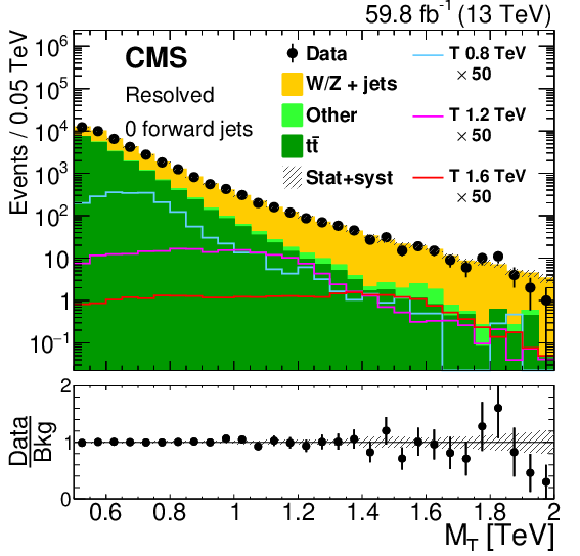
png pdf |
Figure 19-a:
Distributions from the 2018 data set of the transverse mass of the reconstructed top quark and $ {\vec p}_{\mathrm{T}}^{\kern1pt\text{miss}} $ system, for the selected events in the resolved categories, for events with no forward jet (left) and at least one forward jet (right). The distributions for the main background components have been determined in simulation with SFs extracted from CRs. All background processes and the respective uncertainties are derived from the fit to data, whereas the distributions of signal processes are represented according to the expectation before the fit. The lines show the signal predictions for three benchmark mass values (0.8, 1.2, and 1.6 TeV) for a T quark of a narrow width. Figures taken from Ref. [146]. |
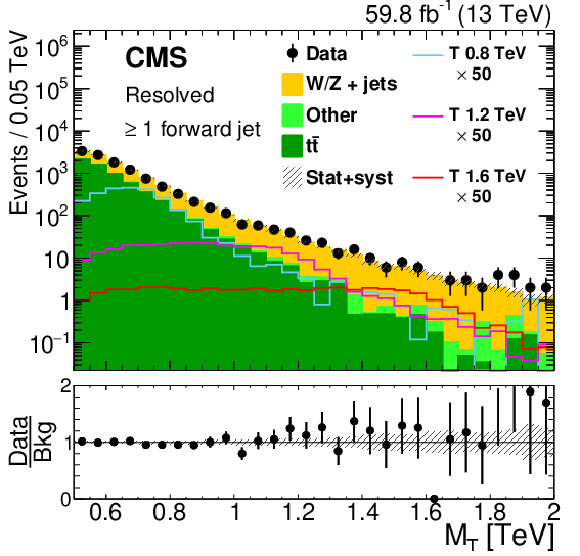
png pdf |
Figure 19-b:
Distributions from the 2018 data set of the transverse mass of the reconstructed top quark and $ {\vec p}_{\mathrm{T}}^{\kern1pt\text{miss}} $ system, for the selected events in the resolved categories, for events with no forward jet (left) and at least one forward jet (right). The distributions for the main background components have been determined in simulation with SFs extracted from CRs. All background processes and the respective uncertainties are derived from the fit to data, whereas the distributions of signal processes are represented according to the expectation before the fit. The lines show the signal predictions for three benchmark mass values (0.8, 1.2, and 1.6 TeV) for a T quark of a narrow width. Figures taken from Ref. [146]. |
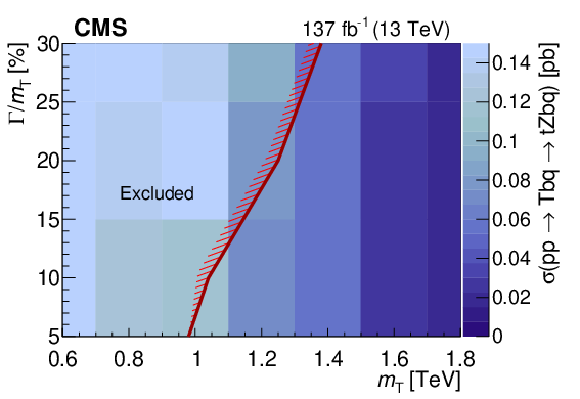
png pdf |
Figure 20:
Observed 95% CL upper limit on the product of the single production cross section for a singlet VLQ T quark and the $ {\mathrm{T}} \to\mathrm{t}\mathrm{Z} $ branching fraction, as a function of the T quark mass $ m_{{\mathrm{T}} } $ and width $ \Gamma $, for widths from 5 to 30% of the mass. A singlet T quark that is produced in association with a bottom quark is assumed. The solid red line indicates the boundary of the excluded region (on the hatched side) of theoretical cross sections multiplied by the T branching fraction. Figure taken from Ref. [146]. |
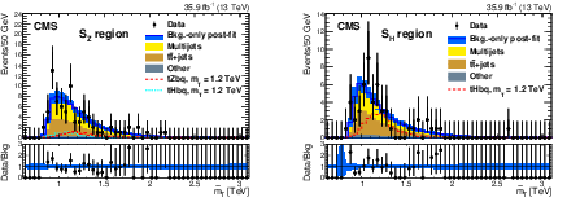
png pdf |
Figure 21:
Background-only postfit distributions of $ \widetilde{m}_{{\mathrm{T}} } $, the adjusted T mass sensitive observable defined in Ref. [145], of the observed data for the SR of the $ {\mathrm{T}} \to\mathrm{t}\mathrm{Z} $ (left) and $ {\mathrm{T}} \to\mathrm{t}\mathrm{H} $ (right) channels, respectively, for the high-mass search. The dashed red histogram in each case represents an example signal for the $ \mathrm{t}\mathrm{Z}\mathrm{b}\mathrm{q} $ or $ \mathrm{t}\mathrm{H}\mathrm{b}\mathrm{q} $ process with a T quark mass of 1.2 TeV and a relative width of 30%. The lower panels of the plots display the ratio of observed data to the fitted background for each bin. The error bars on the data points correspond to the 68% CL Poisson intervals, whereas the light blue band in each ratio panel represents the relative uncertainties in the fitted background. Figures taken from Ref. [145]. |
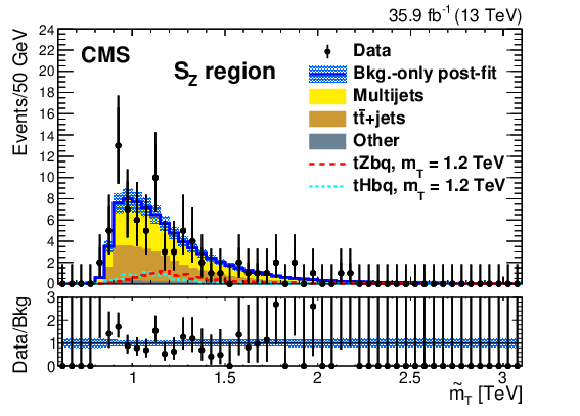
png pdf |
Figure 21-a:
Background-only postfit distributions of $ \widetilde{m}_{{\mathrm{T}} } $, the adjusted T mass sensitive observable defined in Ref. [145], of the observed data for the SR of the $ {\mathrm{T}} \to\mathrm{t}\mathrm{Z} $ (left) and $ {\mathrm{T}} \to\mathrm{t}\mathrm{H} $ (right) channels, respectively, for the high-mass search. The dashed red histogram in each case represents an example signal for the $ \mathrm{t}\mathrm{Z}\mathrm{b}\mathrm{q} $ or $ \mathrm{t}\mathrm{H}\mathrm{b}\mathrm{q} $ process with a T quark mass of 1.2 TeV and a relative width of 30%. The lower panels of the plots display the ratio of observed data to the fitted background for each bin. The error bars on the data points correspond to the 68% CL Poisson intervals, whereas the light blue band in each ratio panel represents the relative uncertainties in the fitted background. Figures taken from Ref. [145]. |
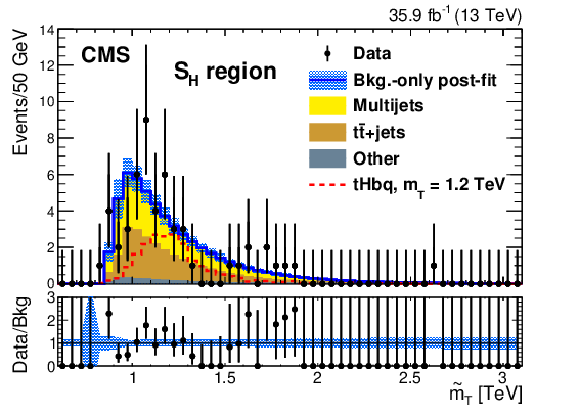
png pdf |
Figure 21-b:
Background-only postfit distributions of $ \widetilde{m}_{{\mathrm{T}} } $, the adjusted T mass sensitive observable defined in Ref. [145], of the observed data for the SR of the $ {\mathrm{T}} \to\mathrm{t}\mathrm{Z} $ (left) and $ {\mathrm{T}} \to\mathrm{t}\mathrm{H} $ (right) channels, respectively, for the high-mass search. The dashed red histogram in each case represents an example signal for the $ \mathrm{t}\mathrm{Z}\mathrm{b}\mathrm{q} $ or $ \mathrm{t}\mathrm{H}\mathrm{b}\mathrm{q} $ process with a T quark mass of 1.2 TeV and a relative width of 30%. The lower panels of the plots display the ratio of observed data to the fitted background for each bin. The error bars on the data points correspond to the 68% CL Poisson intervals, whereas the light blue band in each ratio panel represents the relative uncertainties in the fitted background. Figures taken from Ref. [145]. |
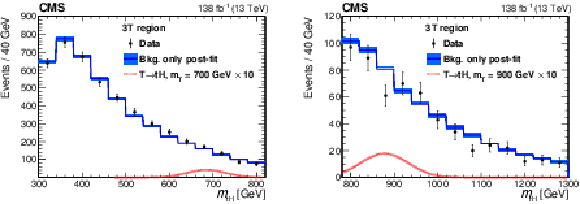
png pdf |
Figure 22:
Background-only postfit five-jet invariant mass distributions for the SR for the low-mass (left) and high-mass (right) selections. The shaded blue region represents the uncertainty in the fitted background estimate. The expected signal distributions (scaled for visibility) for a 700 GeV and a 900 GeV T quark are shown as red dashed lines for the low- and high-mass selections, respectively. Figures adapted from Ref. [148]. |
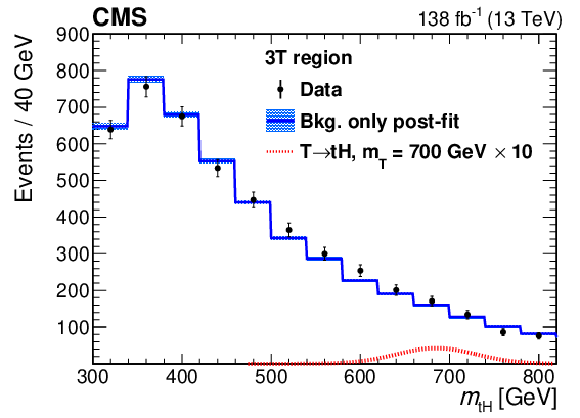
png pdf |
Figure 22-a:
Background-only postfit five-jet invariant mass distributions for the SR for the low-mass (left) and high-mass (right) selections. The shaded blue region represents the uncertainty in the fitted background estimate. The expected signal distributions (scaled for visibility) for a 700 GeV and a 900 GeV T quark are shown as red dashed lines for the low- and high-mass selections, respectively. Figures adapted from Ref. [148]. |
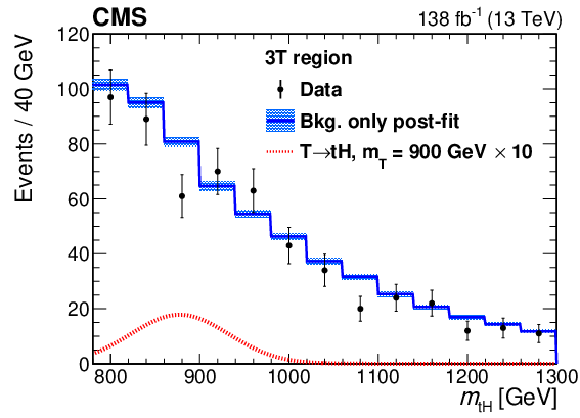
png pdf |
Figure 22-b:
Background-only postfit five-jet invariant mass distributions for the SR for the low-mass (left) and high-mass (right) selections. The shaded blue region represents the uncertainty in the fitted background estimate. The expected signal distributions (scaled for visibility) for a 700 GeV and a 900 GeV T quark are shown as red dashed lines for the low- and high-mass selections, respectively. Figures adapted from Ref. [148]. |
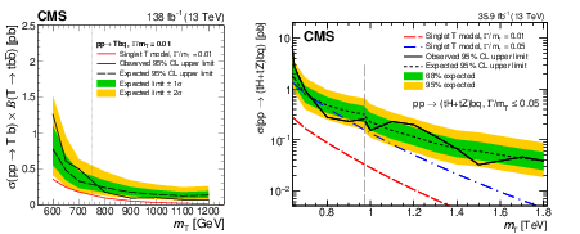
png pdf |
Figure 23:
Observed and median expected upper limits at 95% CL on the cross sections for single T quark production associated with a b quark, for the sum of $ \mathrm{t}\mathrm{H}\mathrm{b}\mathrm{q} $ and $ \mathrm{t}\mathrm{Z}\mathrm{b}\mathrm{q} $ channels, as a function of the assumed values of the T quark mass. The inner (green) band and the outer (yellow) band indicate the regions containing 68 and 95%, respectively, of the distribution of limits expected under the background-only hypothesis. The left figure corresponds to the analysis strategy described in Ref. [148], based on the five-jet invariant mass reconstruction of the T. The figure on the right corresponds to the analysis strategy in Ref. [145], which employs different reconstruction algorithms for the low- and high-mass searches. The vertical dashed lines represent the crossover point in sensitivity for the low-mass and high-mass selections. Figures adapted from Refs. [148,145]. |
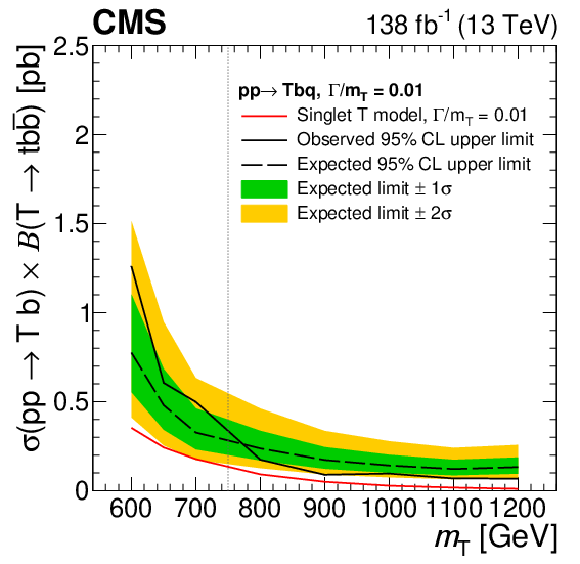
png pdf |
Figure 23-a:
Observed and median expected upper limits at 95% CL on the cross sections for single T quark production associated with a b quark, for the sum of $ \mathrm{t}\mathrm{H}\mathrm{b}\mathrm{q} $ and $ \mathrm{t}\mathrm{Z}\mathrm{b}\mathrm{q} $ channels, as a function of the assumed values of the T quark mass. The inner (green) band and the outer (yellow) band indicate the regions containing 68 and 95%, respectively, of the distribution of limits expected under the background-only hypothesis. The left figure corresponds to the analysis strategy described in Ref. [148], based on the five-jet invariant mass reconstruction of the T. The figure on the right corresponds to the analysis strategy in Ref. [145], which employs different reconstruction algorithms for the low- and high-mass searches. The vertical dashed lines represent the crossover point in sensitivity for the low-mass and high-mass selections. Figures adapted from Refs. [148,145]. |
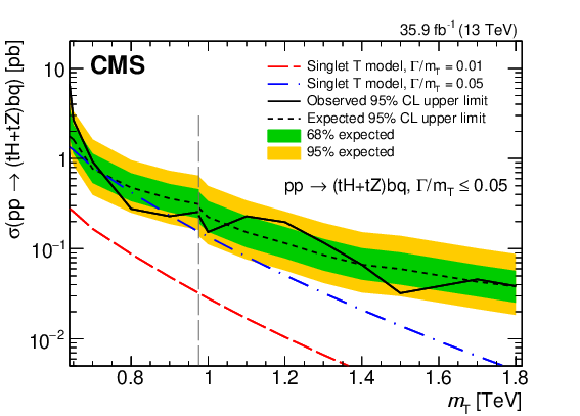
png pdf |
Figure 23-b:
Observed and median expected upper limits at 95% CL on the cross sections for single T quark production associated with a b quark, for the sum of $ \mathrm{t}\mathrm{H}\mathrm{b}\mathrm{q} $ and $ \mathrm{t}\mathrm{Z}\mathrm{b}\mathrm{q} $ channels, as a function of the assumed values of the T quark mass. The inner (green) band and the outer (yellow) band indicate the regions containing 68 and 95%, respectively, of the distribution of limits expected under the background-only hypothesis. The left figure corresponds to the analysis strategy described in Ref. [148], based on the five-jet invariant mass reconstruction of the T. The figure on the right corresponds to the analysis strategy in Ref. [145], which employs different reconstruction algorithms for the low- and high-mass searches. The vertical dashed lines represent the crossover point in sensitivity for the low-mass and high-mass selections. Figures adapted from Refs. [148,145]. |
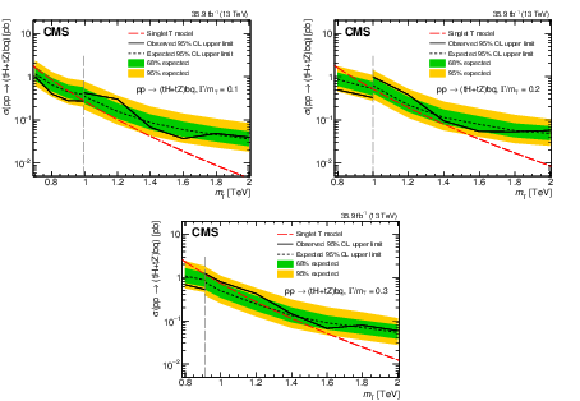
png pdf |
Figure 24:
Observed and median expected upper limits at 95% CL on the cross sections for single T quark production associated with a b quark, for the sum of $ \mathrm{t}\mathrm{H}\mathrm{b}\mathrm{q} $ and $ \mathrm{t}\mathrm{Z}\mathrm{b}\mathrm{q} $ channels, as a function of the assumed values of the T quark mass. The inner (green) band and the outer (yellow) band indicate the regions containing 68 and 95%, respectively, of the distribution of limits expected under the background-only hypothesis. The results are given for relative widths of $ \Gamma/m_{{\mathrm{T}} }= $ 10 (upper left), 20 (upper right), and 30% (lower). The vertical dashed lines represent the crossover point in sensitivity for the low-mass and high-mass selections. Figures adapted from Ref. [145]. |
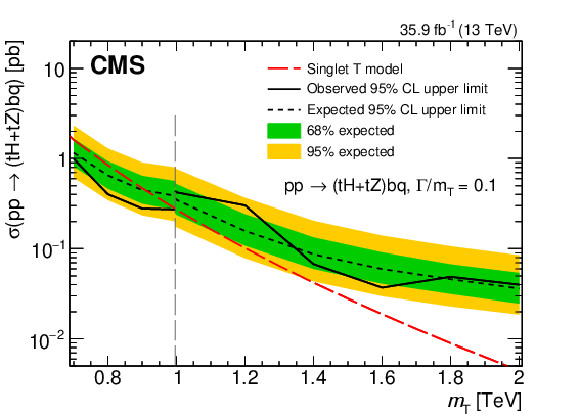
png pdf |
Figure 24-a:
Observed and median expected upper limits at 95% CL on the cross sections for single T quark production associated with a b quark, for the sum of $ \mathrm{t}\mathrm{H}\mathrm{b}\mathrm{q} $ and $ \mathrm{t}\mathrm{Z}\mathrm{b}\mathrm{q} $ channels, as a function of the assumed values of the T quark mass. The inner (green) band and the outer (yellow) band indicate the regions containing 68 and 95%, respectively, of the distribution of limits expected under the background-only hypothesis. The results are given for relative widths of $ \Gamma/m_{{\mathrm{T}} }= $ 10 (upper left), 20 (upper right), and 30% (lower). The vertical dashed lines represent the crossover point in sensitivity for the low-mass and high-mass selections. Figures adapted from Ref. [145]. |
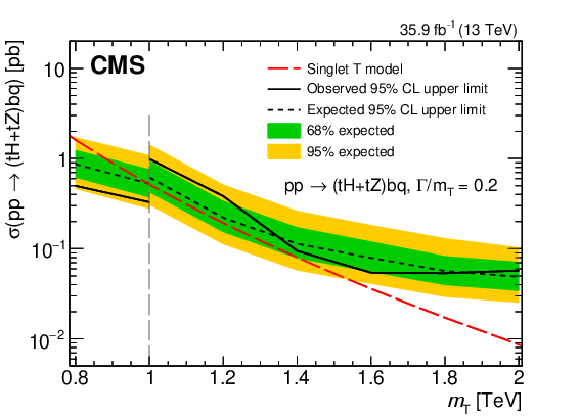
png pdf |
Figure 24-b:
Observed and median expected upper limits at 95% CL on the cross sections for single T quark production associated with a b quark, for the sum of $ \mathrm{t}\mathrm{H}\mathrm{b}\mathrm{q} $ and $ \mathrm{t}\mathrm{Z}\mathrm{b}\mathrm{q} $ channels, as a function of the assumed values of the T quark mass. The inner (green) band and the outer (yellow) band indicate the regions containing 68 and 95%, respectively, of the distribution of limits expected under the background-only hypothesis. The results are given for relative widths of $ \Gamma/m_{{\mathrm{T}} }= $ 10 (upper left), 20 (upper right), and 30% (lower). The vertical dashed lines represent the crossover point in sensitivity for the low-mass and high-mass selections. Figures adapted from Ref. [145]. |
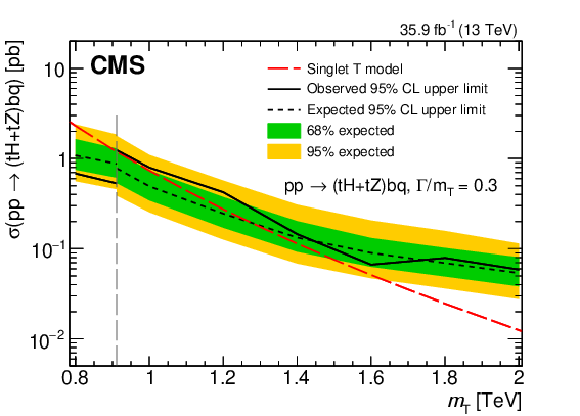
png pdf |
Figure 24-c:
Observed and median expected upper limits at 95% CL on the cross sections for single T quark production associated with a b quark, for the sum of $ \mathrm{t}\mathrm{H}\mathrm{b}\mathrm{q} $ and $ \mathrm{t}\mathrm{Z}\mathrm{b}\mathrm{q} $ channels, as a function of the assumed values of the T quark mass. The inner (green) band and the outer (yellow) band indicate the regions containing 68 and 95%, respectively, of the distribution of limits expected under the background-only hypothesis. The results are given for relative widths of $ \Gamma/m_{{\mathrm{T}} }= $ 10 (upper left), 20 (upper right), and 30% (lower). The vertical dashed lines represent the crossover point in sensitivity for the low-mass and high-mass selections. Figures adapted from Ref. [145]. |
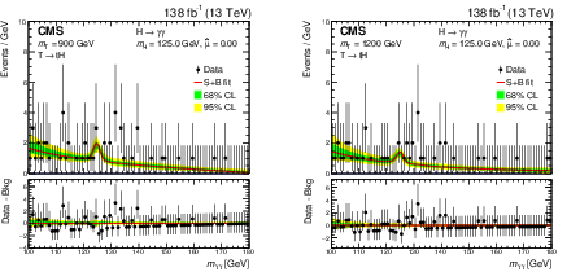
png pdf |
Figure 25:
Distributions of the observed data (black dots) and $ m_{\gamma\gamma} $ signal-plus-background model fits (red line) for a T quark signal with $ m_{{\mathrm{T}} } $ of 900 (left) and 1200 GeV (right), combining the leptonic and hadronic channels. The green (yellow) band represents the 68 (95)% CL interval in the background component of the fit. The peak in the background component shows the considered irreducible SM Higgs boson contribution ($ \mathrm{g}\mathrm{g}\mathrm{H} $, VBF, VH, $ {\mathrm{t}\overline{\mathrm{t}}} \mathrm{H} $, and $ \mathrm{t}\mathrm{H} $). Here, $ \hat{\mu} $ is the best fit value of the signal strength parameter $ \mu $, which is zero for the two $ m_{{\mathrm{T}} } $ values considered. The lower panel shows the residuals after the subtraction of the background component. Figures adapted from Ref. [147]. |
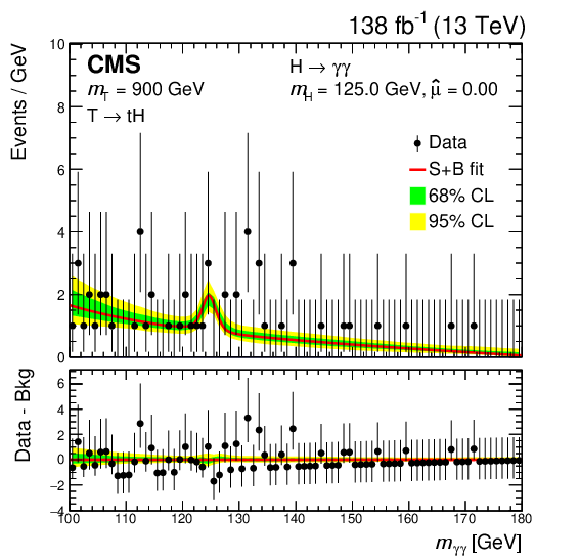
png pdf |
Figure 25-a:
Distributions of the observed data (black dots) and $ m_{\gamma\gamma} $ signal-plus-background model fits (red line) for a T quark signal with $ m_{{\mathrm{T}} } $ of 900 (left) and 1200 GeV (right), combining the leptonic and hadronic channels. The green (yellow) band represents the 68 (95)% CL interval in the background component of the fit. The peak in the background component shows the considered irreducible SM Higgs boson contribution ($ \mathrm{g}\mathrm{g}\mathrm{H} $, VBF, VH, $ {\mathrm{t}\overline{\mathrm{t}}} \mathrm{H} $, and $ \mathrm{t}\mathrm{H} $). Here, $ \hat{\mu} $ is the best fit value of the signal strength parameter $ \mu $, which is zero for the two $ m_{{\mathrm{T}} } $ values considered. The lower panel shows the residuals after the subtraction of the background component. Figures adapted from Ref. [147]. |
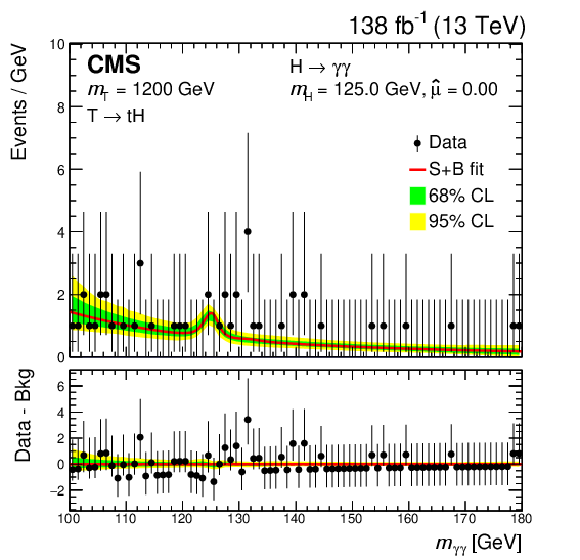
png pdf |
Figure 25-b:
Distributions of the observed data (black dots) and $ m_{\gamma\gamma} $ signal-plus-background model fits (red line) for a T quark signal with $ m_{{\mathrm{T}} } $ of 900 (left) and 1200 GeV (right), combining the leptonic and hadronic channels. The green (yellow) band represents the 68 (95)% CL interval in the background component of the fit. The peak in the background component shows the considered irreducible SM Higgs boson contribution ($ \mathrm{g}\mathrm{g}\mathrm{H} $, VBF, VH, $ {\mathrm{t}\overline{\mathrm{t}}} \mathrm{H} $, and $ \mathrm{t}\mathrm{H} $). Here, $ \hat{\mu} $ is the best fit value of the signal strength parameter $ \mu $, which is zero for the two $ m_{{\mathrm{T}} } $ values considered. The lower panel shows the residuals after the subtraction of the background component. Figures adapted from Ref. [147]. |
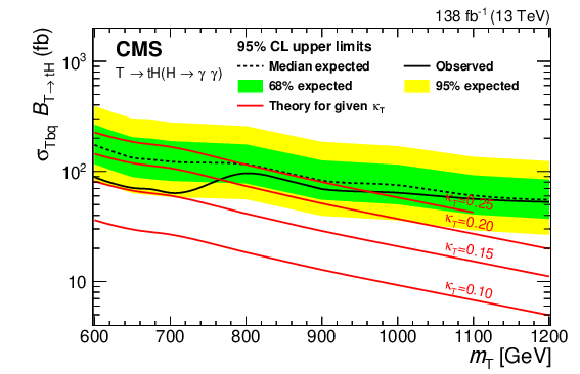
png pdf |
Figure 26:
Expected (dotted black) and observed (solid black) upper limits at 95% CL on $ \sigma_{{\mathrm{T}} \mathrm{b}\mathrm{q}}\mathcal{B}({\mathrm{T}} \to\mathrm{t}\mathrm{H}) $ are displayed as a function of $ m_{{\mathrm{T}} } $, combining the leptonic and hadronic channels. The inner (green) band and the outer (yellow) band indicate the regions containing 68 and 95%, respectively, of the distribution of limits expected under the background-only hypothesis. The theoretical cross sections for the singlet T production with representative $ \kappa_{{\mathrm{T}} } $ values fixed at 0.1, 0.15, 0.2, and 0.25 (for $ \Gamma/m_{{\mathrm{T}} } < 5% $) are shown as red lines. Figure adapted from Ref. [147]. |
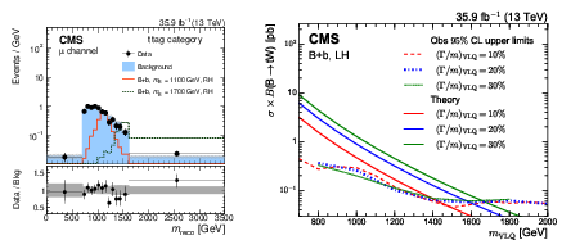
png pdf |
Figure 27:
The distribution in the reconstructed B quark mass in events with one t-tagged jet and a forward jet, where the SM background is obtained from a CR without a forward jet (left). The product of the observed upper limits on the cross section and $ \mathcal{B}({\mathrm{B}} \to\mathrm{t}\mathrm{W}) $ as a function of $ m_{\text{VLQ}} $ for different relative decay widths of the B quark (right), for single B quark production in association with a b quark. Figures taken from Ref. [151]. |
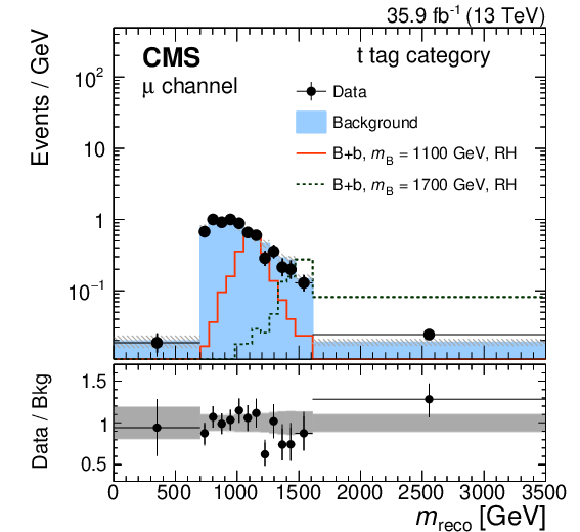
png pdf |
Figure 27-a:
The distribution in the reconstructed B quark mass in events with one t-tagged jet and a forward jet, where the SM background is obtained from a CR without a forward jet (left). The product of the observed upper limits on the cross section and $ \mathcal{B}({\mathrm{B}} \to\mathrm{t}\mathrm{W}) $ as a function of $ m_{\text{VLQ}} $ for different relative decay widths of the B quark (right), for single B quark production in association with a b quark. Figures taken from Ref. [151]. |
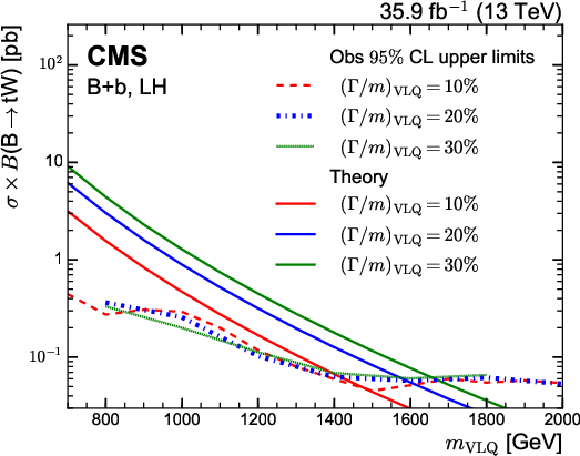
png pdf |
Figure 27-b:
The distribution in the reconstructed B quark mass in events with one t-tagged jet and a forward jet, where the SM background is obtained from a CR without a forward jet (left). The product of the observed upper limits on the cross section and $ \mathcal{B}({\mathrm{B}} \to\mathrm{t}\mathrm{W}) $ as a function of $ m_{\text{VLQ}} $ for different relative decay widths of the B quark (right), for single B quark production in association with a b quark. Figures taken from Ref. [151]. |
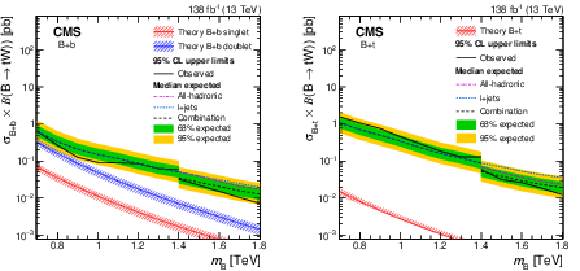
png pdf |
Figure 28:
Upper limits on the product of the production cross section and branching fraction to $ \mathrm{t}\mathrm{W} $ of the $ \mathrm{b}\mathrm{b} $ (left) and $ \mathrm{b}\mathrm{t} $ (right) production modes at 95% CL. Colored lines show the expected limits from the $ \ell $+jets (dotted) and all-hadronic (dash-dotted) channels, where the latter start at B masses of 1.4 TeV. The observed and expected limits from the combination are shown as solid and dashed black lines, respectively. The inner (green) band and the outer (yellow) band indicate the regions containing 68 and 95%, respectively, of the distribution of the limits expected under the background-only hypothesis. The theoretical cross sections are shown as the red and blue lines, where the uncertainties due to missing higher orders are depicted by shaded areas. Figures adapted from Ref. [153]. |
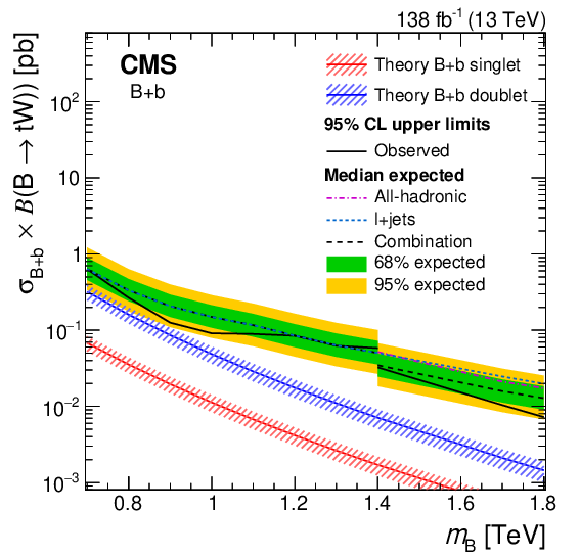
png pdf |
Figure 28-a:
Upper limits on the product of the production cross section and branching fraction to $ \mathrm{t}\mathrm{W} $ of the $ \mathrm{b}\mathrm{b} $ (left) and $ \mathrm{b}\mathrm{t} $ (right) production modes at 95% CL. Colored lines show the expected limits from the $ \ell $+jets (dotted) and all-hadronic (dash-dotted) channels, where the latter start at B masses of 1.4 TeV. The observed and expected limits from the combination are shown as solid and dashed black lines, respectively. The inner (green) band and the outer (yellow) band indicate the regions containing 68 and 95%, respectively, of the distribution of the limits expected under the background-only hypothesis. The theoretical cross sections are shown as the red and blue lines, where the uncertainties due to missing higher orders are depicted by shaded areas. Figures adapted from Ref. [153]. |
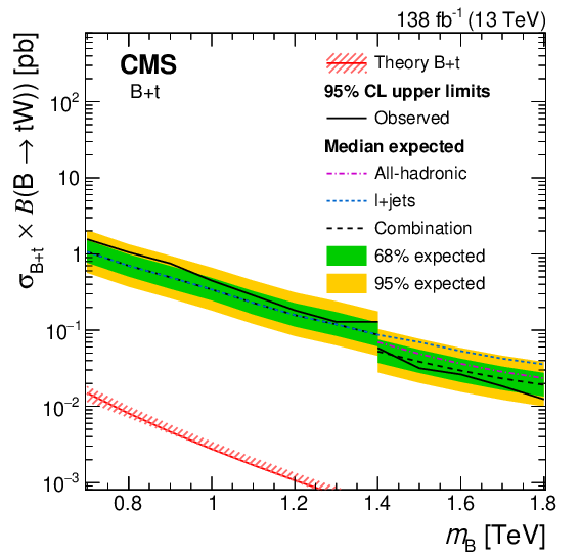
png pdf |
Figure 28-b:
Upper limits on the product of the production cross section and branching fraction to $ \mathrm{t}\mathrm{W} $ of the $ \mathrm{b}\mathrm{b} $ (left) and $ \mathrm{b}\mathrm{t} $ (right) production modes at 95% CL. Colored lines show the expected limits from the $ \ell $+jets (dotted) and all-hadronic (dash-dotted) channels, where the latter start at B masses of 1.4 TeV. The observed and expected limits from the combination are shown as solid and dashed black lines, respectively. The inner (green) band and the outer (yellow) band indicate the regions containing 68 and 95%, respectively, of the distribution of the limits expected under the background-only hypothesis. The theoretical cross sections are shown as the red and blue lines, where the uncertainties due to missing higher orders are depicted by shaded areas. Figures adapted from Ref. [153]. |
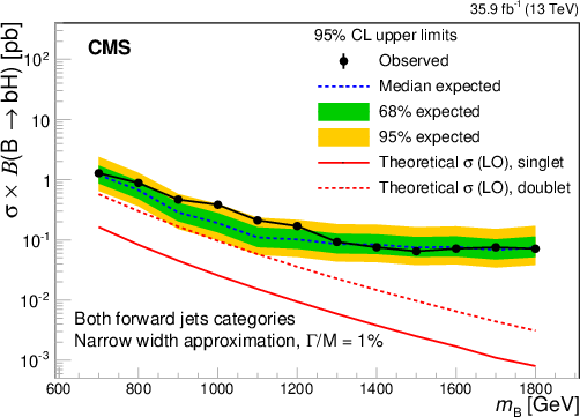
png pdf |
Figure 29:
Observed and expected 95% CL upper limits on the product of the B quark production cross section and branching fraction to $ \mathrm{b}\mathrm{H} $, as a function of the signal mass, under the NWA. The results are shown for the combination of 0 and $ > $0 forward-jet categories. The continuous red curves correspond to the theoretical expectations for singlet and doublet models. Figure taken from Ref. [150]. |
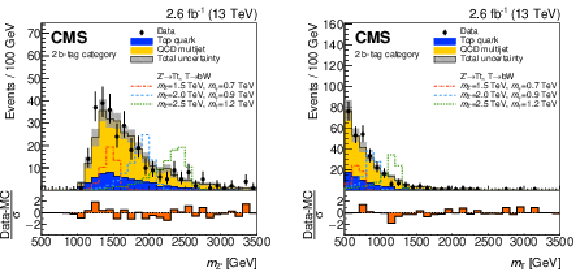
png pdf |
Figure 30:
Reconstructed $ m_{\mathrm{Z}^{'}} $ (left) and $ m_{{\mathrm{T}} } $ (right) distributions obtained in a search for $ \mathrm{p}\mathrm{p}\to\mathrm{Z}^{'}\to{\mathrm{T}} {\overline{T}} $ in the all-hadronic final state. The $ \mathrm{Z}^{'} $ boson is reconstructed using a t-, a W-, and a b-tagged jet, whereas the T quark is reconstructed using the latter two jets. The lower panels show the difference between the data and the estimated backgrounds divided by the sum in quadrature of the statistical uncertainties in data and backgrounds, and the systematic uncertainties in the estimated backgrounds. Figures adapted from Ref. [154]. |
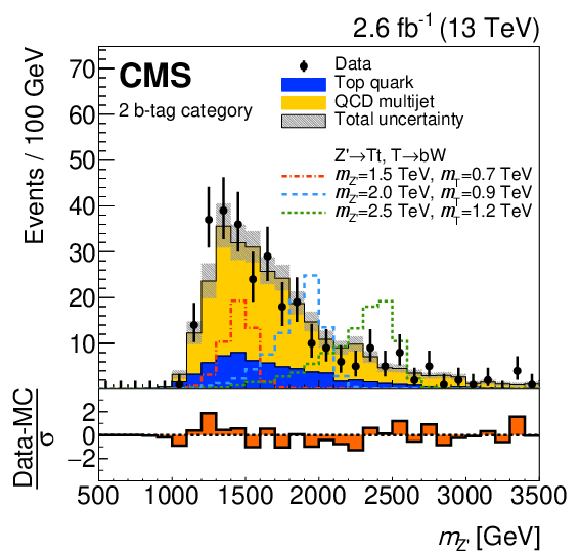
png pdf |
Figure 30-a:
Reconstructed $ m_{\mathrm{Z}^{'}} $ (left) and $ m_{{\mathrm{T}} } $ (right) distributions obtained in a search for $ \mathrm{p}\mathrm{p}\to\mathrm{Z}^{'}\to{\mathrm{T}} {\overline{T}} $ in the all-hadronic final state. The $ \mathrm{Z}^{'} $ boson is reconstructed using a t-, a W-, and a b-tagged jet, whereas the T quark is reconstructed using the latter two jets. The lower panels show the difference between the data and the estimated backgrounds divided by the sum in quadrature of the statistical uncertainties in data and backgrounds, and the systematic uncertainties in the estimated backgrounds. Figures adapted from Ref. [154]. |
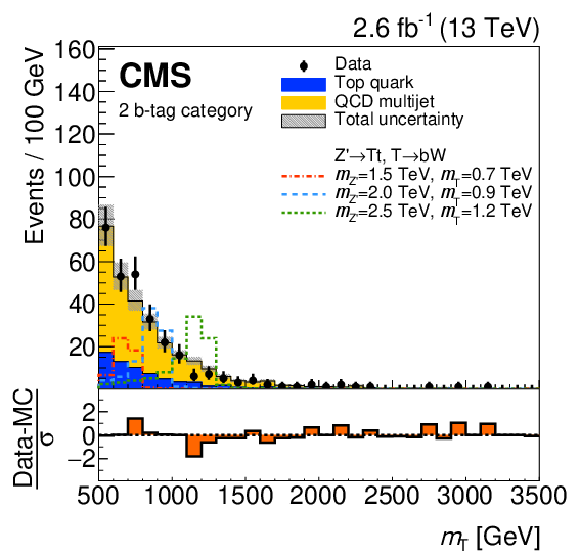
png pdf |
Figure 30-b:
Reconstructed $ m_{\mathrm{Z}^{'}} $ (left) and $ m_{{\mathrm{T}} } $ (right) distributions obtained in a search for $ \mathrm{p}\mathrm{p}\to\mathrm{Z}^{'}\to{\mathrm{T}} {\overline{T}} $ in the all-hadronic final state. The $ \mathrm{Z}^{'} $ boson is reconstructed using a t-, a W-, and a b-tagged jet, whereas the T quark is reconstructed using the latter two jets. The lower panels show the difference between the data and the estimated backgrounds divided by the sum in quadrature of the statistical uncertainties in data and backgrounds, and the systematic uncertainties in the estimated backgrounds. Figures adapted from Ref. [154]. |
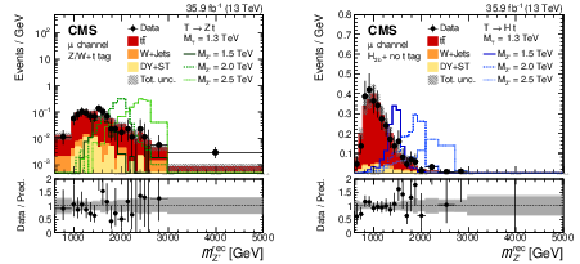
png pdf |
Figure 31:
Reconstructed $ m_{\mathrm{Z}^{'}} $ distributions obtained in a search for $ \mathrm{p}\mathrm{p}\to\mathrm{Z}^{'}\to{\mathrm{T}} {\overline{T}} $ in the $ \ell $+jets final state, in events with a V- and a t-tagged jet (left) and in events with an H-tagged jet (right). The lower panels show the ratio of the observed data to the background prediction. Figures adapted from Ref. [155]. |
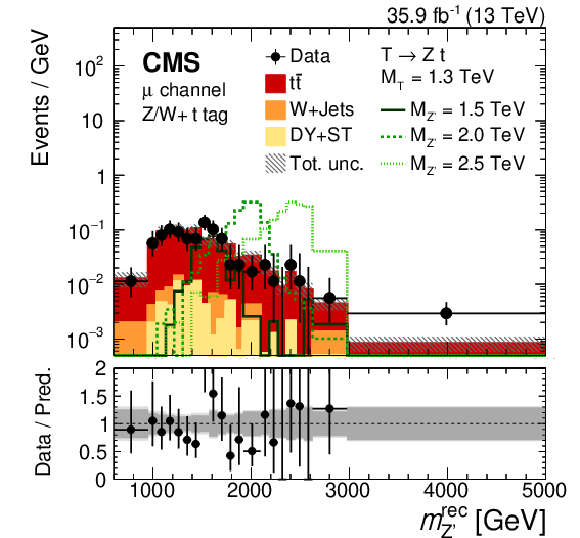
png pdf |
Figure 31-a:
Reconstructed $ m_{\mathrm{Z}^{'}} $ distributions obtained in a search for $ \mathrm{p}\mathrm{p}\to\mathrm{Z}^{'}\to{\mathrm{T}} {\overline{T}} $ in the $ \ell $+jets final state, in events with a V- and a t-tagged jet (left) and in events with an H-tagged jet (right). The lower panels show the ratio of the observed data to the background prediction. Figures adapted from Ref. [155]. |
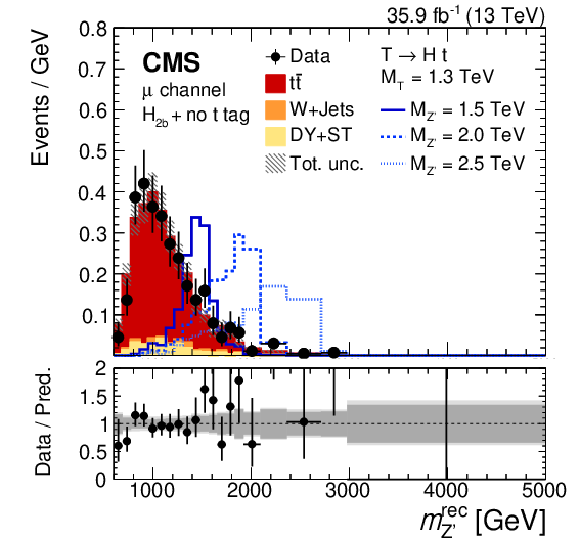
png pdf |
Figure 31-b:
Reconstructed $ m_{\mathrm{Z}^{'}} $ distributions obtained in a search for $ \mathrm{p}\mathrm{p}\to\mathrm{Z}^{'}\to{\mathrm{T}} {\overline{T}} $ in the $ \ell $+jets final state, in events with a V- and a t-tagged jet (left) and in events with an H-tagged jet (right). The lower panels show the ratio of the observed data to the background prediction. Figures adapted from Ref. [155]. |
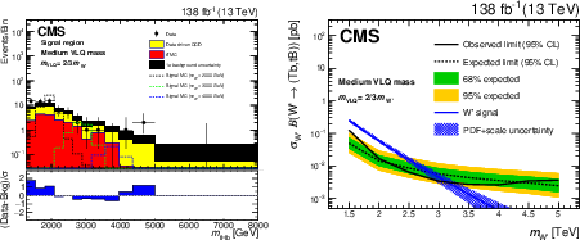
png pdf |
Figure 32:
Reconstructed $ \mathrm{W^{'}} $ boson mass distributions obtained in a search for $ \mathrm{p}\mathrm{p}\to\mathrm{W^{'}}\to{\mathrm{T}} \overline{\mathrm{b}}/{\mathrm{B}} \overline{\mathrm{t}} $ in the all-hadronic final state, in events with a t-, H- and b-tagged jet (left). Upper limits at 95% CL on the product of the cross section and branching fraction for the production of a $ \mathrm{W^{'}} $ boson with decays to $ {\mathrm{T}} \overline{\mathrm{b}} $ and $ {\mathrm{B}} \overline{\mathrm{t}} $ (right). Figures adapted from Ref. [157]. |
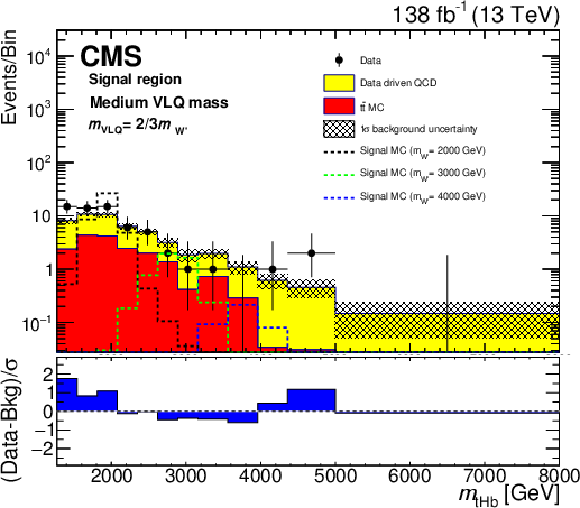
png pdf |
Figure 32-a:
Reconstructed $ \mathrm{W^{'}} $ boson mass distributions obtained in a search for $ \mathrm{p}\mathrm{p}\to\mathrm{W^{'}}\to{\mathrm{T}} \overline{\mathrm{b}}/{\mathrm{B}} \overline{\mathrm{t}} $ in the all-hadronic final state, in events with a t-, H- and b-tagged jet (left). Upper limits at 95% CL on the product of the cross section and branching fraction for the production of a $ \mathrm{W^{'}} $ boson with decays to $ {\mathrm{T}} \overline{\mathrm{b}} $ and $ {\mathrm{B}} \overline{\mathrm{t}} $ (right). Figures adapted from Ref. [157]. |
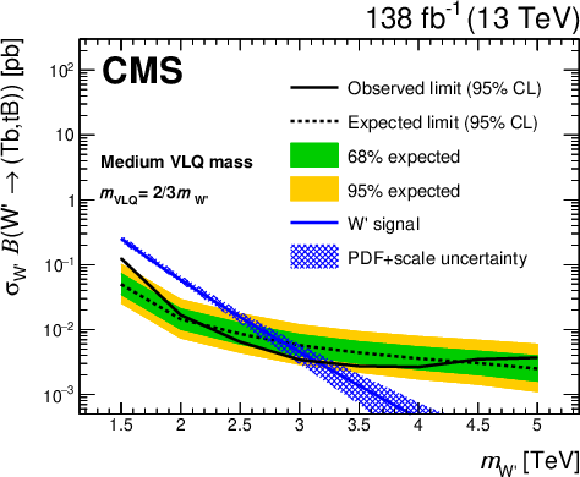
png pdf |
Figure 32-b:
Reconstructed $ \mathrm{W^{'}} $ boson mass distributions obtained in a search for $ \mathrm{p}\mathrm{p}\to\mathrm{W^{'}}\to{\mathrm{T}} \overline{\mathrm{b}}/{\mathrm{B}} \overline{\mathrm{t}} $ in the all-hadronic final state, in events with a t-, H- and b-tagged jet (left). Upper limits at 95% CL on the product of the cross section and branching fraction for the production of a $ \mathrm{W^{'}} $ boson with decays to $ {\mathrm{T}} \overline{\mathrm{b}} $ and $ {\mathrm{B}} \overline{\mathrm{t}} $ (right). Figures adapted from Ref. [157]. |
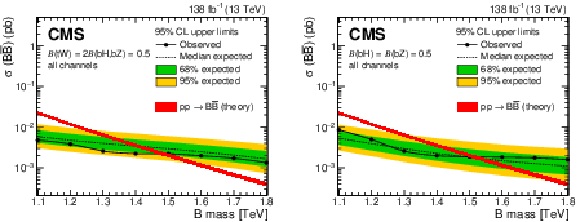
png pdf |
Figure 33:
Observed (solid lines) and expected (dashed lines) 95% CL upper limits on $ {\mathrm{B}} \overline{\mathrm{B}} $ production as a function of the B quark mass for the singlet (left) and doublet (right) branching fraction scenarios, from the combination of two searches for $ {\mathrm{B}} \overline{\mathrm{B}} $ production. Predicted cross sections are shown by the red line surrounded by a band representing energy scale and PDF uncertainties in the calculation. |
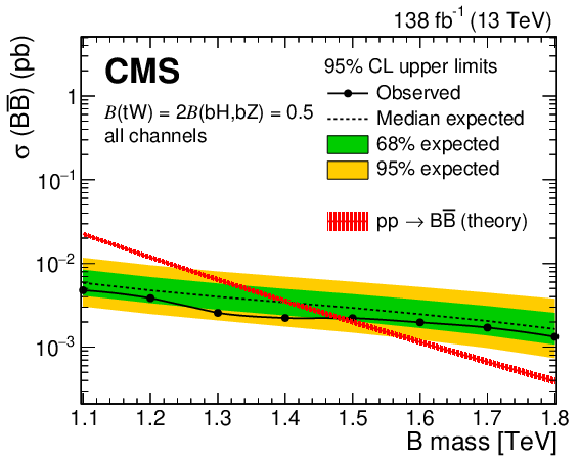
png pdf |
Figure 33-a:
Observed (solid lines) and expected (dashed lines) 95% CL upper limits on $ {\mathrm{B}} \overline{\mathrm{B}} $ production as a function of the B quark mass for the singlet (left) and doublet (right) branching fraction scenarios, from the combination of two searches for $ {\mathrm{B}} \overline{\mathrm{B}} $ production. Predicted cross sections are shown by the red line surrounded by a band representing energy scale and PDF uncertainties in the calculation. |
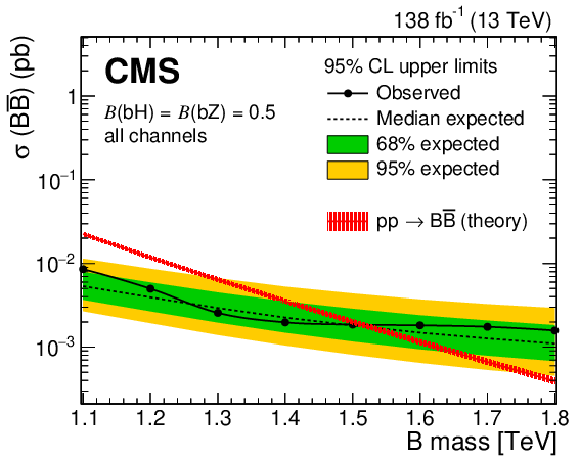
png pdf |
Figure 33-b:
Observed (solid lines) and expected (dashed lines) 95% CL upper limits on $ {\mathrm{B}} \overline{\mathrm{B}} $ production as a function of the B quark mass for the singlet (left) and doublet (right) branching fraction scenarios, from the combination of two searches for $ {\mathrm{B}} \overline{\mathrm{B}} $ production. Predicted cross sections are shown by the red line surrounded by a band representing energy scale and PDF uncertainties in the calculation. |
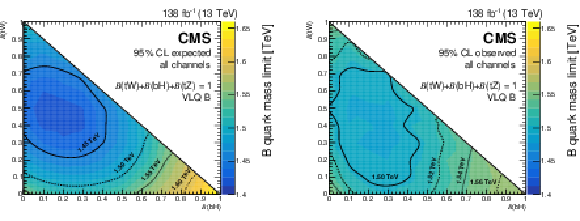
png pdf |
Figure 34:
Expected (left) and observed (right) lower limits on the B quark mass at 95% CL from the combination of two searches for $ {\mathrm{B}} \overline{\mathrm{B}} $ production. The limits are shown as a function of the branching fractions $ \mathcal{B}({\mathrm{B}} \to\mathrm{b}\mathrm{H}) $ and $ \mathcal{B}({\mathrm{B}} \to\mathrm{t}\mathrm{W}) $, with $ \mathcal{B}({\mathrm{B}} \to\mathrm{t}\mathrm{W})=1-\mathcal{B}({\mathrm{B}} \to\mathrm{b}\mathrm{H})-\mathcal{B}({\mathrm{B}} \to\mathrm{b}\mathrm{Z}) $. |
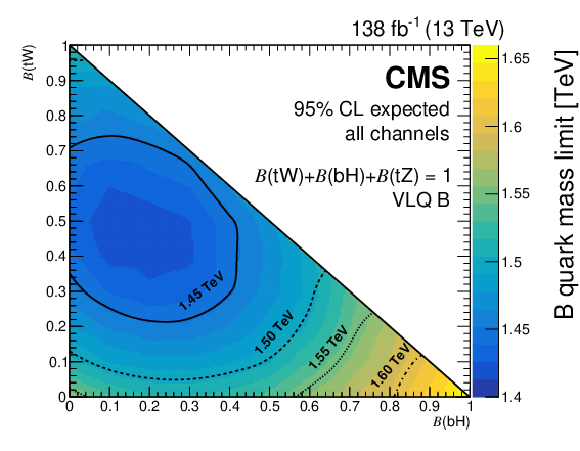
png pdf |
Figure 34-a:
Expected (left) and observed (right) lower limits on the B quark mass at 95% CL from the combination of two searches for $ {\mathrm{B}} \overline{\mathrm{B}} $ production. The limits are shown as a function of the branching fractions $ \mathcal{B}({\mathrm{B}} \to\mathrm{b}\mathrm{H}) $ and $ \mathcal{B}({\mathrm{B}} \to\mathrm{t}\mathrm{W}) $, with $ \mathcal{B}({\mathrm{B}} \to\mathrm{t}\mathrm{W})=1-\mathcal{B}({\mathrm{B}} \to\mathrm{b}\mathrm{H})-\mathcal{B}({\mathrm{B}} \to\mathrm{b}\mathrm{Z}) $. |
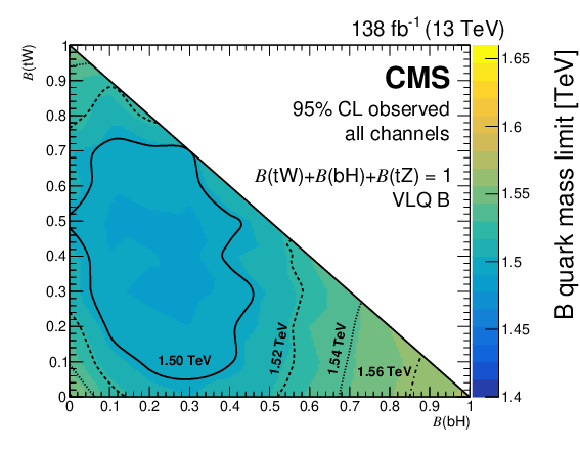
png pdf |
Figure 34-b:
Expected (left) and observed (right) lower limits on the B quark mass at 95% CL from the combination of two searches for $ {\mathrm{B}} \overline{\mathrm{B}} $ production. The limits are shown as a function of the branching fractions $ \mathcal{B}({\mathrm{B}} \to\mathrm{b}\mathrm{H}) $ and $ \mathcal{B}({\mathrm{B}} \to\mathrm{t}\mathrm{W}) $, with $ \mathcal{B}({\mathrm{B}} \to\mathrm{t}\mathrm{W})=1-\mathcal{B}({\mathrm{B}} \to\mathrm{b}\mathrm{H})-\mathcal{B}({\mathrm{B}} \to\mathrm{b}\mathrm{Z}) $. |
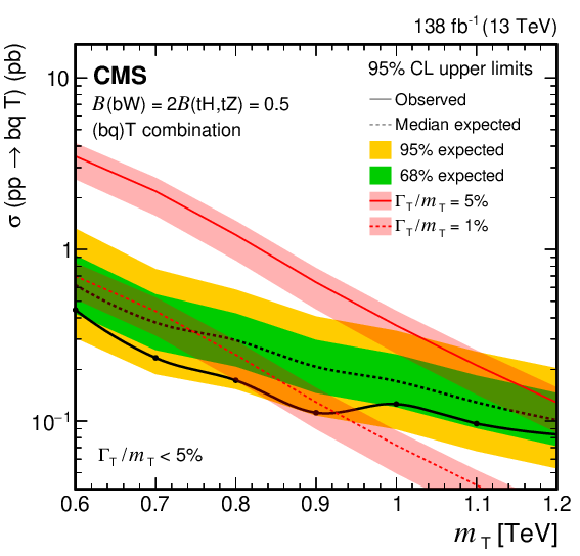
png pdf |
Figure 35:
Observed and expected 95% CL upper limits on the production cross section of a single T quark in association with a b quark in a singlet scenario, versus the T quark mass. Theoretical predictions for relative widths of 1 and 5% of the mass are shown as red solid line and red dashed line, respectively. |

png pdf |
Figure 36:
Expected (left) and observed (right) 95% CL upper limits on the product of the single-production cross section and the $ {\mathrm{T}} \to\mathrm{t}\mathrm{Z}/\mathrm{H} $ branching fraction for a singlet T quark, as a function of the T quark mass $ m_{{\mathrm{T}} } $ and width $ \Gamma $, for relative widths from 1 to 30% of the mass. A singlet T quark that is produced in association with a b quark is assumed. The solid red line indicates the boundary of the excluded region (hatched area) of theoretical cross sections. |
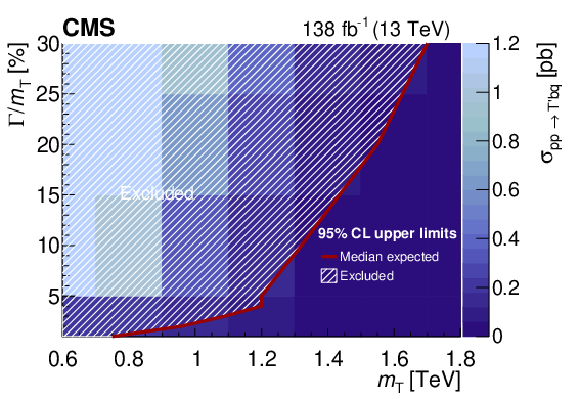
png pdf |
Figure 36-a:
Expected (left) and observed (right) 95% CL upper limits on the product of the single-production cross section and the $ {\mathrm{T}} \to\mathrm{t}\mathrm{Z}/\mathrm{H} $ branching fraction for a singlet T quark, as a function of the T quark mass $ m_{{\mathrm{T}} } $ and width $ \Gamma $, for relative widths from 1 to 30% of the mass. A singlet T quark that is produced in association with a b quark is assumed. The solid red line indicates the boundary of the excluded region (hatched area) of theoretical cross sections. |
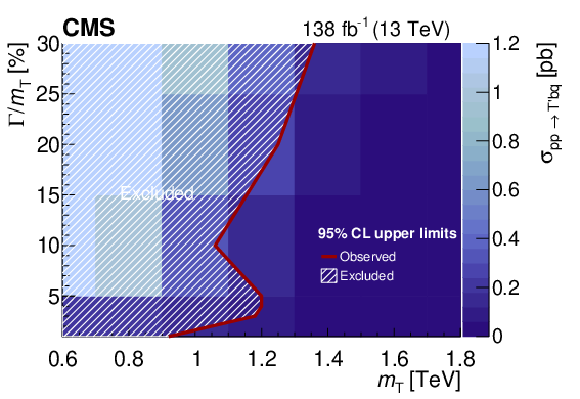
png pdf |
Figure 36-b:
Expected (left) and observed (right) 95% CL upper limits on the product of the single-production cross section and the $ {\mathrm{T}} \to\mathrm{t}\mathrm{Z}/\mathrm{H} $ branching fraction for a singlet T quark, as a function of the T quark mass $ m_{{\mathrm{T}} } $ and width $ \Gamma $, for relative widths from 1 to 30% of the mass. A singlet T quark that is produced in association with a b quark is assumed. The solid red line indicates the boundary of the excluded region (hatched area) of theoretical cross sections. |
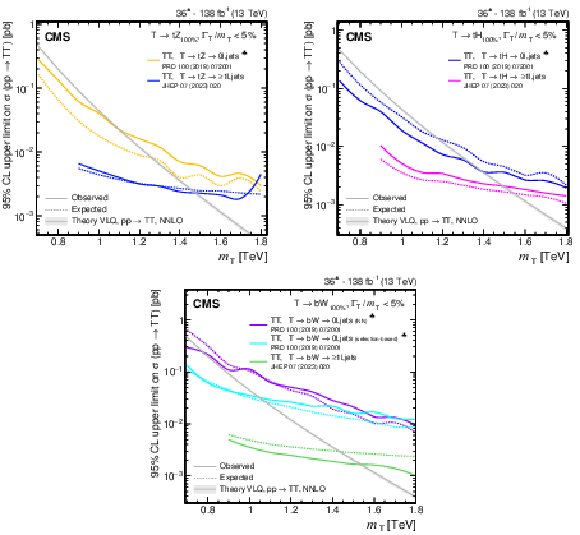
png pdf |
Figure 37:
Observed and expected 95% CL upper limits on the production cross section of a pair of vector-like T quarks decaying to $ \mathrm{t}\mathrm{Z} $ (upper left), $ \mathrm{t}\mathrm{H} $ (upper right), and $ \mathrm{b}\mathrm{W} $ (lower), as a function of the T quark mass, obtained by different analyses: 0$ \ell $+jets (NN, selection-based) [140], and $ \geq $1$ \ell $+jets [141]. A theory prediction at NNLO in perturbative QCD of the pair production cross section in the NWA is superimposed. Searches using data corresponding to an integrated luminosity of 36 fb$ ^{-1} $, rather than the full Run 2 integrated luminosity of 138 fb$ ^{-1} $, are indicated with a spade symbol in the legend. |
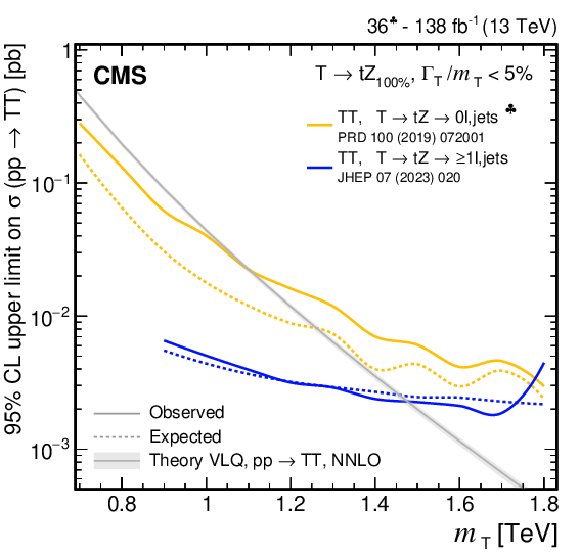
png pdf |
Figure 37-a:
Observed and expected 95% CL upper limits on the production cross section of a pair of vector-like T quarks decaying to $ \mathrm{t}\mathrm{Z} $ (upper left), $ \mathrm{t}\mathrm{H} $ (upper right), and $ \mathrm{b}\mathrm{W} $ (lower), as a function of the T quark mass, obtained by different analyses: 0$ \ell $+jets (NN, selection-based) [140], and $ \geq $1$ \ell $+jets [141]. A theory prediction at NNLO in perturbative QCD of the pair production cross section in the NWA is superimposed. Searches using data corresponding to an integrated luminosity of 36 fb$ ^{-1} $, rather than the full Run 2 integrated luminosity of 138 fb$ ^{-1} $, are indicated with a spade symbol in the legend. |
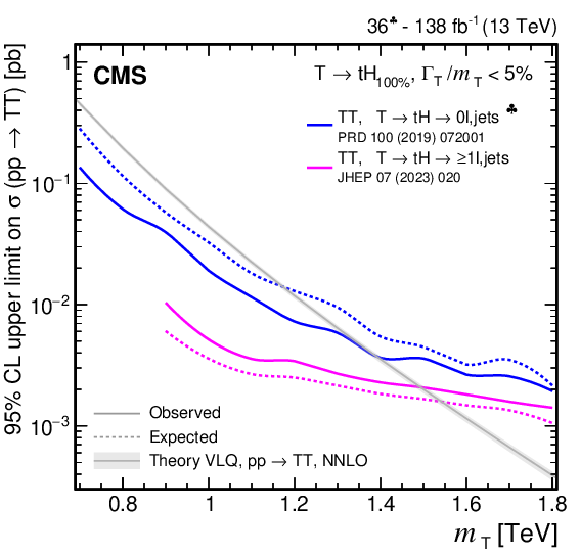
png pdf |
Figure 37-b:
Observed and expected 95% CL upper limits on the production cross section of a pair of vector-like T quarks decaying to $ \mathrm{t}\mathrm{Z} $ (upper left), $ \mathrm{t}\mathrm{H} $ (upper right), and $ \mathrm{b}\mathrm{W} $ (lower), as a function of the T quark mass, obtained by different analyses: 0$ \ell $+jets (NN, selection-based) [140], and $ \geq $1$ \ell $+jets [141]. A theory prediction at NNLO in perturbative QCD of the pair production cross section in the NWA is superimposed. Searches using data corresponding to an integrated luminosity of 36 fb$ ^{-1} $, rather than the full Run 2 integrated luminosity of 138 fb$ ^{-1} $, are indicated with a spade symbol in the legend. |
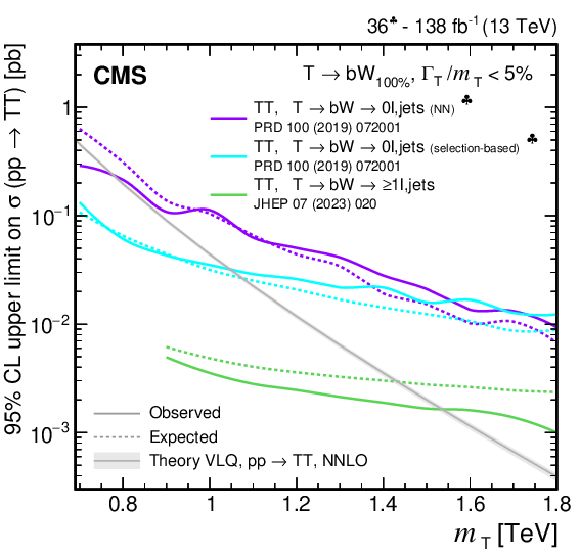
png pdf |
Figure 37-c:
Observed and expected 95% CL upper limits on the production cross section of a pair of vector-like T quarks decaying to $ \mathrm{t}\mathrm{Z} $ (upper left), $ \mathrm{t}\mathrm{H} $ (upper right), and $ \mathrm{b}\mathrm{W} $ (lower), as a function of the T quark mass, obtained by different analyses: 0$ \ell $+jets (NN, selection-based) [140], and $ \geq $1$ \ell $+jets [141]. A theory prediction at NNLO in perturbative QCD of the pair production cross section in the NWA is superimposed. Searches using data corresponding to an integrated luminosity of 36 fb$ ^{-1} $, rather than the full Run 2 integrated luminosity of 138 fb$ ^{-1} $, are indicated with a spade symbol in the legend. |
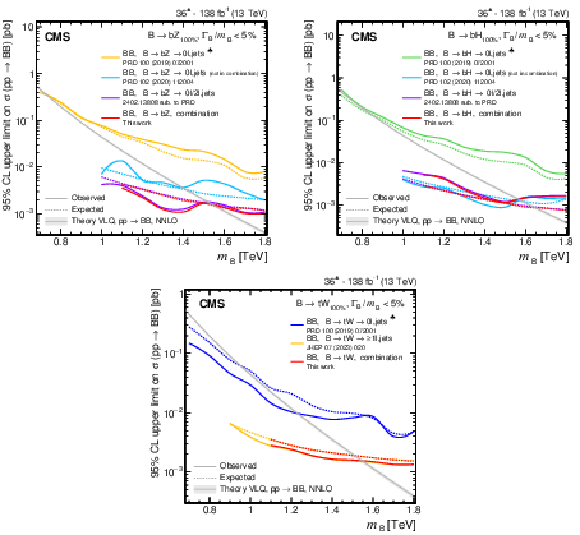
png pdf |
Figure 38:
Observed and expected 95% CL upper limits on the production cross section of a pair of vector-like B quarks decaying to $ \mathrm{b}\mathrm{Z} $ (upper left), $ \mathrm{b}\mathrm{H} $ (upper right), and $ \mathrm{t}\mathrm{W} $ (lower), as a function of the B quark mass, obtained by different analyses: 0$ \ell $+jets (NN) [140], 0$ \ell $+jets [159], $ \geq $1$ \ell $+jets [141], 0\ell/2$ \ell $+jets [142], and the $ {\mathrm{B}} \overline{\mathrm{B}} $ combination of Section 6.5.1. A theory prediction at NNLO in perturbative QCD of the pair production cross section in the NWA is superimposed. Searches using data corresponding to an integrated luminosity of 36 fb$ ^{-1} $, rather than the full Run 2 integrated luminosity of 138 fb$ ^{-1} $, are indicated with a spade symbol in the legend. |
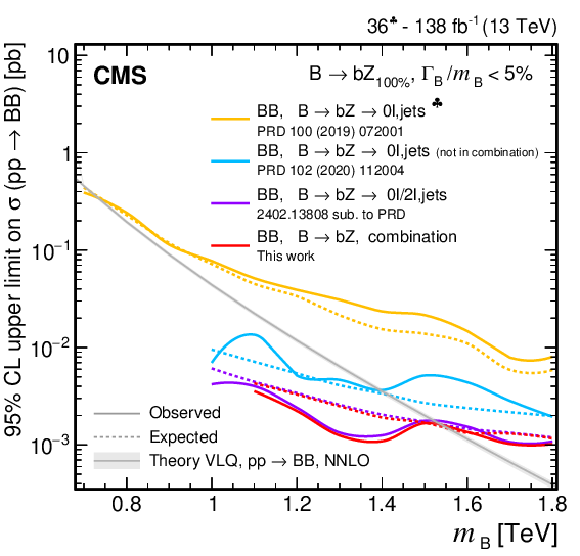
png pdf |
Figure 38-a:
Observed and expected 95% CL upper limits on the production cross section of a pair of vector-like B quarks decaying to $ \mathrm{b}\mathrm{Z} $ (upper left), $ \mathrm{b}\mathrm{H} $ (upper right), and $ \mathrm{t}\mathrm{W} $ (lower), as a function of the B quark mass, obtained by different analyses: 0$ \ell $+jets (NN) [140], 0$ \ell $+jets [159], $ \geq $1$ \ell $+jets [141], 0\ell/2$ \ell $+jets [142], and the $ {\mathrm{B}} \overline{\mathrm{B}} $ combination of Section 6.5.1. A theory prediction at NNLO in perturbative QCD of the pair production cross section in the NWA is superimposed. Searches using data corresponding to an integrated luminosity of 36 fb$ ^{-1} $, rather than the full Run 2 integrated luminosity of 138 fb$ ^{-1} $, are indicated with a spade symbol in the legend. |
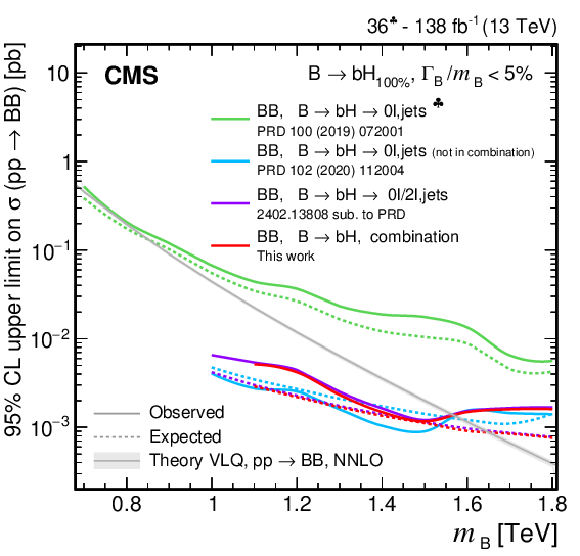
png pdf |
Figure 38-b:
Observed and expected 95% CL upper limits on the production cross section of a pair of vector-like B quarks decaying to $ \mathrm{b}\mathrm{Z} $ (upper left), $ \mathrm{b}\mathrm{H} $ (upper right), and $ \mathrm{t}\mathrm{W} $ (lower), as a function of the B quark mass, obtained by different analyses: 0$ \ell $+jets (NN) [140], 0$ \ell $+jets [159], $ \geq $1$ \ell $+jets [141], 0\ell/2$ \ell $+jets [142], and the $ {\mathrm{B}} \overline{\mathrm{B}} $ combination of Section 6.5.1. A theory prediction at NNLO in perturbative QCD of the pair production cross section in the NWA is superimposed. Searches using data corresponding to an integrated luminosity of 36 fb$ ^{-1} $, rather than the full Run 2 integrated luminosity of 138 fb$ ^{-1} $, are indicated with a spade symbol in the legend. |
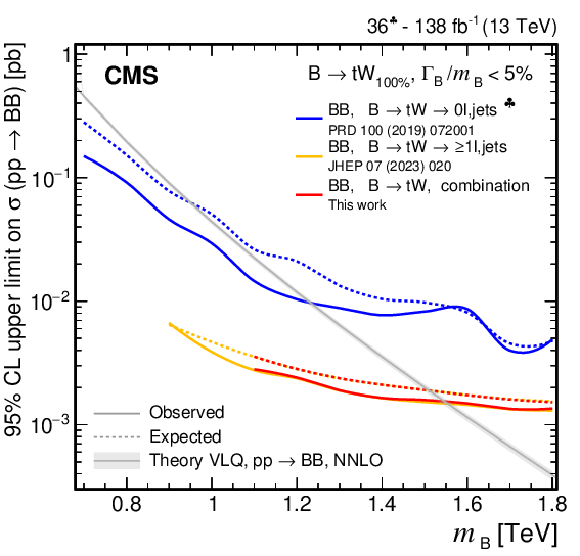
png pdf |
Figure 38-c:
Observed and expected 95% CL upper limits on the production cross section of a pair of vector-like B quarks decaying to $ \mathrm{b}\mathrm{Z} $ (upper left), $ \mathrm{b}\mathrm{H} $ (upper right), and $ \mathrm{t}\mathrm{W} $ (lower), as a function of the B quark mass, obtained by different analyses: 0$ \ell $+jets (NN) [140], 0$ \ell $+jets [159], $ \geq $1$ \ell $+jets [141], 0\ell/2$ \ell $+jets [142], and the $ {\mathrm{B}} \overline{\mathrm{B}} $ combination of Section 6.5.1. A theory prediction at NNLO in perturbative QCD of the pair production cross section in the NWA is superimposed. Searches using data corresponding to an integrated luminosity of 36 fb$ ^{-1} $, rather than the full Run 2 integrated luminosity of 138 fb$ ^{-1} $, are indicated with a spade symbol in the legend. |
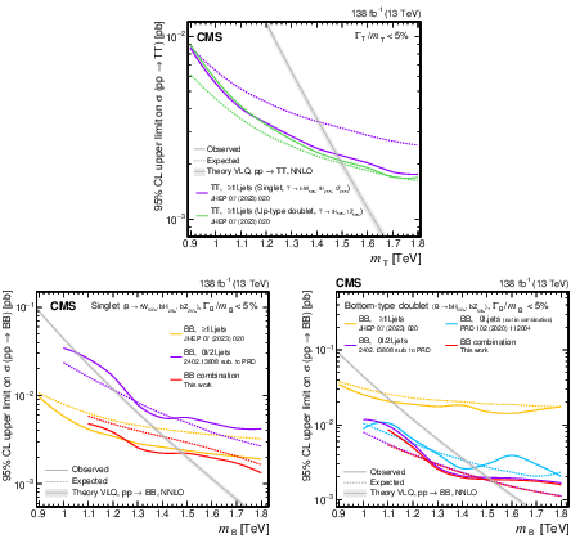
png pdf |
Figure 39:
Observed and expected 95% CL upper limits on the production cross section of a pair of vector-like T or B quarks, as functions of their mass, obtained by different analyses: 0$ \ell $+jets [159], $ \geq $1$ \ell $+jets [141], 0\ell/2$ \ell $+jets [142], and the $ {\mathrm{B}} \overline{\mathrm{B}} $ combination. A theory prediction at NNLO in perturbative QCD of the pair production cross section in the NWA is superimposed. Branching fractions of a singlet (upper and lower left panel) and doublet (upper and lower right panel) are assumed. |
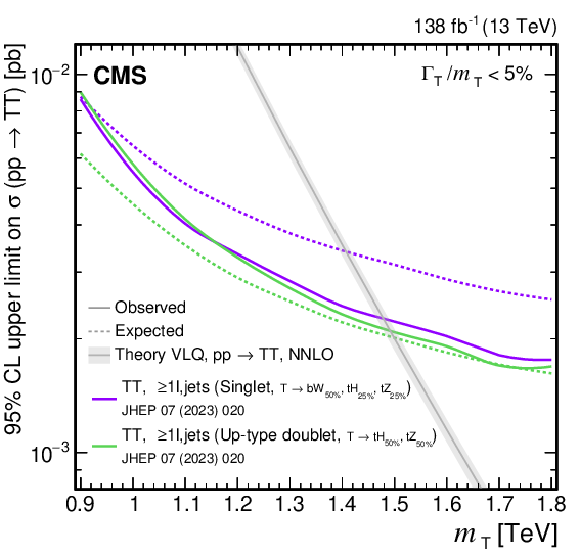
png pdf |
Figure 39-a:
Observed and expected 95% CL upper limits on the production cross section of a pair of vector-like T or B quarks, as functions of their mass, obtained by different analyses: 0$ \ell $+jets [159], $ \geq $1$ \ell $+jets [141], 0\ell/2$ \ell $+jets [142], and the $ {\mathrm{B}} \overline{\mathrm{B}} $ combination. A theory prediction at NNLO in perturbative QCD of the pair production cross section in the NWA is superimposed. Branching fractions of a singlet (upper and lower left panel) and doublet (upper and lower right panel) are assumed. |
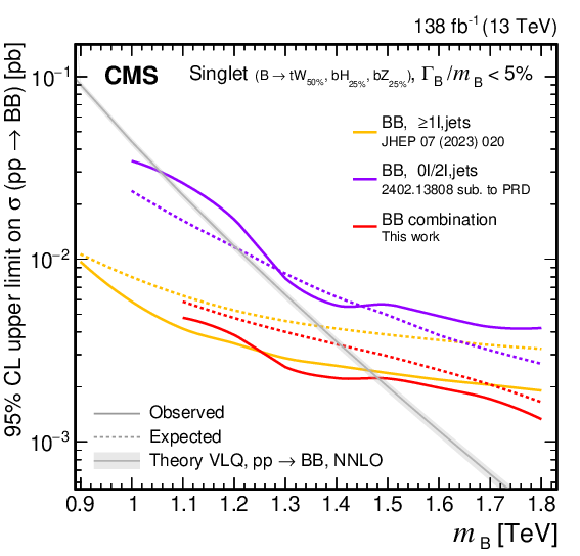
png pdf |
Figure 39-b:
Observed and expected 95% CL upper limits on the production cross section of a pair of vector-like T or B quarks, as functions of their mass, obtained by different analyses: 0$ \ell $+jets [159], $ \geq $1$ \ell $+jets [141], 0\ell/2$ \ell $+jets [142], and the $ {\mathrm{B}} \overline{\mathrm{B}} $ combination. A theory prediction at NNLO in perturbative QCD of the pair production cross section in the NWA is superimposed. Branching fractions of a singlet (upper and lower left panel) and doublet (upper and lower right panel) are assumed. |
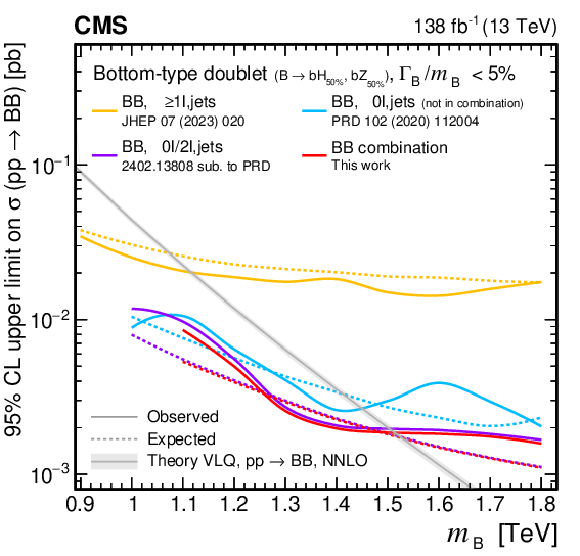
png pdf |
Figure 39-c:
Observed and expected 95% CL upper limits on the production cross section of a pair of vector-like T or B quarks, as functions of their mass, obtained by different analyses: 0$ \ell $+jets [159], $ \geq $1$ \ell $+jets [141], 0\ell/2$ \ell $+jets [142], and the $ {\mathrm{B}} \overline{\mathrm{B}} $ combination. A theory prediction at NNLO in perturbative QCD of the pair production cross section in the NWA is superimposed. Branching fractions of a singlet (upper and lower left panel) and doublet (upper and lower right panel) are assumed. |
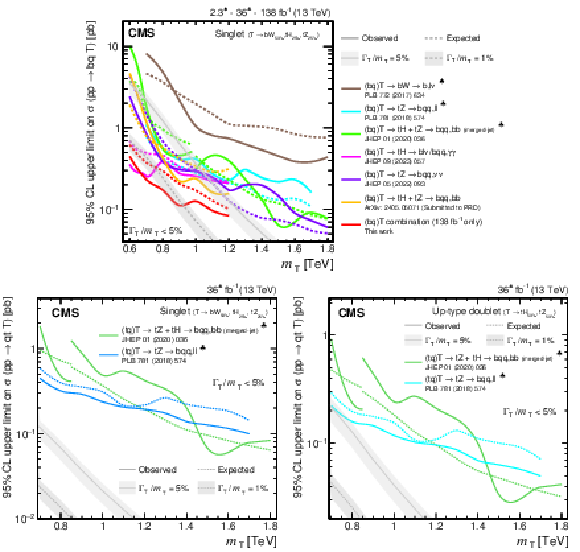
png pdf |
Figure 40:
Observed and expected 95% CL upper limits on the production cross section of a single T quark in association with a b quark (upper) or a t quark (lower row) in a singlet (upper and lower left) and doublet (lower right) scenario, versus the T quark mass, obtained by different analyses: $ {\mathrm{T}} \to\mathrm{b}\mathrm{W}\to\mathrm{b}\mathrm{q}\mathrm{q}\,\ell\nu/\mathrm{b}\ell\nu\,\mathrm{q}\mathrm{q} $ [149], $ {\mathrm{T}} \to\mathrm{t}\mathrm{Z}\to\mathrm{b}\mathrm{q}\mathrm{q}\,\ell\ell $ [144], $ {\mathrm{T}} \to\mathrm{t}\mathrm{H}+\mathrm{t}\mathrm{Z}\to\mathrm{b}\mathrm{q}\mathrm{q}\,\mathrm{b}\mathrm{b} $ (merged-jet) [145], $ {\mathrm{T}} \to\mathrm{t}\mathrm{H}\to\mathrm{b}\ell\nu/\mathrm{b}\mathrm{q}\mathrm{q}\,\gamma\gamma $ [147], $ {\mathrm{T}} \to\mathrm{t}\mathrm{Z}\to\mathrm{b}\mathrm{q}\mathrm{q}\,\nu\nu $ [146], $ {\mathrm{T}} \to\mathrm{t}\mathrm{H}+\mathrm{t}\mathrm{Z}\to\mathrm{b}\mathrm{q}\mathrm{q}\,\mathrm{b}\mathrm{b} $ [148], and the single T quark combination of Section 6.5.2. Only the three analyses using the full Run 2 data set are included in the single T quark combination. Two theory predictions at LO in perturbative QCD are superimposed, corresponding to different VLQ widths. Searches using data corresponding to an integrated luminosity of 2.3 fb$ ^{-1} $ and 36 fb$ ^{-1} $, rather than the full Run 2 integrated luminosity of 138 fb$ ^{-1} $, are indicated with a heart and spade symbol, respectively, in the legend. |
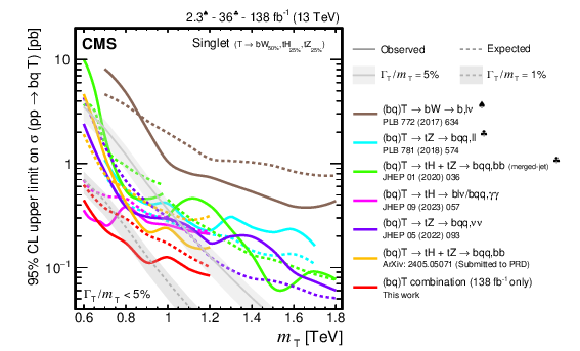
png pdf |
Figure 40-a:
Observed and expected 95% CL upper limits on the production cross section of a single T quark in association with a b quark (upper) or a t quark (lower row) in a singlet (upper and lower left) and doublet (lower right) scenario, versus the T quark mass, obtained by different analyses: $ {\mathrm{T}} \to\mathrm{b}\mathrm{W}\to\mathrm{b}\mathrm{q}\mathrm{q}\,\ell\nu/\mathrm{b}\ell\nu\,\mathrm{q}\mathrm{q} $ [149], $ {\mathrm{T}} \to\mathrm{t}\mathrm{Z}\to\mathrm{b}\mathrm{q}\mathrm{q}\,\ell\ell $ [144], $ {\mathrm{T}} \to\mathrm{t}\mathrm{H}+\mathrm{t}\mathrm{Z}\to\mathrm{b}\mathrm{q}\mathrm{q}\,\mathrm{b}\mathrm{b} $ (merged-jet) [145], $ {\mathrm{T}} \to\mathrm{t}\mathrm{H}\to\mathrm{b}\ell\nu/\mathrm{b}\mathrm{q}\mathrm{q}\,\gamma\gamma $ [147], $ {\mathrm{T}} \to\mathrm{t}\mathrm{Z}\to\mathrm{b}\mathrm{q}\mathrm{q}\,\nu\nu $ [146], $ {\mathrm{T}} \to\mathrm{t}\mathrm{H}+\mathrm{t}\mathrm{Z}\to\mathrm{b}\mathrm{q}\mathrm{q}\,\mathrm{b}\mathrm{b} $ [148], and the single T quark combination of Section 6.5.2. Only the three analyses using the full Run 2 data set are included in the single T quark combination. Two theory predictions at LO in perturbative QCD are superimposed, corresponding to different VLQ widths. Searches using data corresponding to an integrated luminosity of 2.3 fb$ ^{-1} $ and 36 fb$ ^{-1} $, rather than the full Run 2 integrated luminosity of 138 fb$ ^{-1} $, are indicated with a heart and spade symbol, respectively, in the legend. |
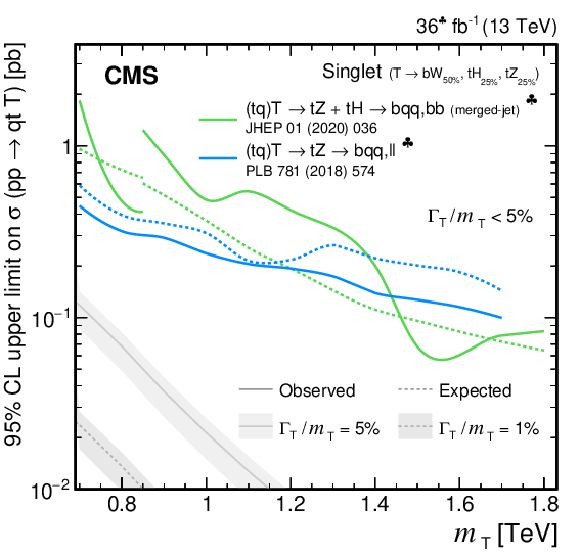
png pdf |
Figure 40-b:
Observed and expected 95% CL upper limits on the production cross section of a single T quark in association with a b quark (upper) or a t quark (lower row) in a singlet (upper and lower left) and doublet (lower right) scenario, versus the T quark mass, obtained by different analyses: $ {\mathrm{T}} \to\mathrm{b}\mathrm{W}\to\mathrm{b}\mathrm{q}\mathrm{q}\,\ell\nu/\mathrm{b}\ell\nu\,\mathrm{q}\mathrm{q} $ [149], $ {\mathrm{T}} \to\mathrm{t}\mathrm{Z}\to\mathrm{b}\mathrm{q}\mathrm{q}\,\ell\ell $ [144], $ {\mathrm{T}} \to\mathrm{t}\mathrm{H}+\mathrm{t}\mathrm{Z}\to\mathrm{b}\mathrm{q}\mathrm{q}\,\mathrm{b}\mathrm{b} $ (merged-jet) [145], $ {\mathrm{T}} \to\mathrm{t}\mathrm{H}\to\mathrm{b}\ell\nu/\mathrm{b}\mathrm{q}\mathrm{q}\,\gamma\gamma $ [147], $ {\mathrm{T}} \to\mathrm{t}\mathrm{Z}\to\mathrm{b}\mathrm{q}\mathrm{q}\,\nu\nu $ [146], $ {\mathrm{T}} \to\mathrm{t}\mathrm{H}+\mathrm{t}\mathrm{Z}\to\mathrm{b}\mathrm{q}\mathrm{q}\,\mathrm{b}\mathrm{b} $ [148], and the single T quark combination of Section 6.5.2. Only the three analyses using the full Run 2 data set are included in the single T quark combination. Two theory predictions at LO in perturbative QCD are superimposed, corresponding to different VLQ widths. Searches using data corresponding to an integrated luminosity of 2.3 fb$ ^{-1} $ and 36 fb$ ^{-1} $, rather than the full Run 2 integrated luminosity of 138 fb$ ^{-1} $, are indicated with a heart and spade symbol, respectively, in the legend. |
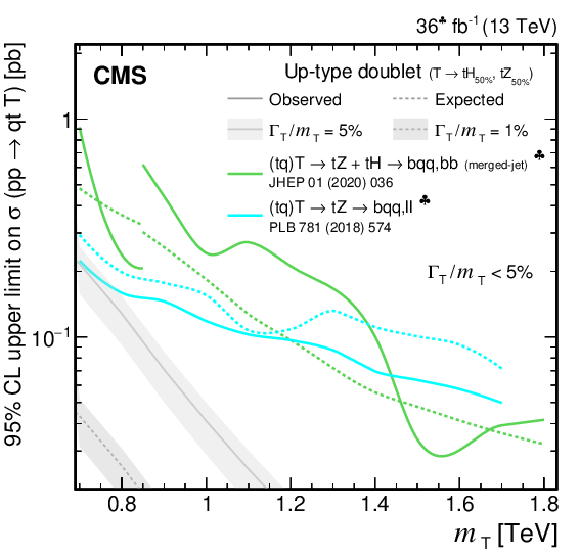
png pdf |
Figure 40-c:
Observed and expected 95% CL upper limits on the production cross section of a single T quark in association with a b quark (upper) or a t quark (lower row) in a singlet (upper and lower left) and doublet (lower right) scenario, versus the T quark mass, obtained by different analyses: $ {\mathrm{T}} \to\mathrm{b}\mathrm{W}\to\mathrm{b}\mathrm{q}\mathrm{q}\,\ell\nu/\mathrm{b}\ell\nu\,\mathrm{q}\mathrm{q} $ [149], $ {\mathrm{T}} \to\mathrm{t}\mathrm{Z}\to\mathrm{b}\mathrm{q}\mathrm{q}\,\ell\ell $ [144], $ {\mathrm{T}} \to\mathrm{t}\mathrm{H}+\mathrm{t}\mathrm{Z}\to\mathrm{b}\mathrm{q}\mathrm{q}\,\mathrm{b}\mathrm{b} $ (merged-jet) [145], $ {\mathrm{T}} \to\mathrm{t}\mathrm{H}\to\mathrm{b}\ell\nu/\mathrm{b}\mathrm{q}\mathrm{q}\,\gamma\gamma $ [147], $ {\mathrm{T}} \to\mathrm{t}\mathrm{Z}\to\mathrm{b}\mathrm{q}\mathrm{q}\,\nu\nu $ [146], $ {\mathrm{T}} \to\mathrm{t}\mathrm{H}+\mathrm{t}\mathrm{Z}\to\mathrm{b}\mathrm{q}\mathrm{q}\,\mathrm{b}\mathrm{b} $ [148], and the single T quark combination of Section 6.5.2. Only the three analyses using the full Run 2 data set are included in the single T quark combination. Two theory predictions at LO in perturbative QCD are superimposed, corresponding to different VLQ widths. Searches using data corresponding to an integrated luminosity of 2.3 fb$ ^{-1} $ and 36 fb$ ^{-1} $, rather than the full Run 2 integrated luminosity of 138 fb$ ^{-1} $, are indicated with a heart and spade symbol, respectively, in the legend. |
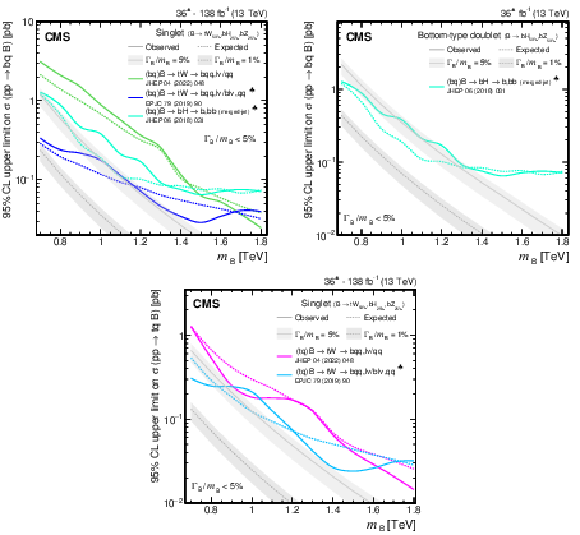
png pdf |
Figure 41:
Observed and expected 95% CL upper limits on the production cross section of a single B quark in association with a b quark (upper row) or a t quark (lower) in a singlet (upper left and lower) and doublet (upper right) scenario, versus the B quark mass, obtained by different analyses: $ {\mathrm{B}} \to\mathrm{t}\mathrm{W}\to\mathrm{b}\mathrm{q}\mathrm{q}\,\ell\nu/\mathrm{q}\mathrm{q} $ [153], $ {\mathrm{B}} \to\mathrm{t}\mathrm{W}\to\mathrm{b}\mathrm{q}\mathrm{q}\,\ell\nu/\mathrm{b}\ell\nu\,\mathrm{q}\mathrm{q} $ [151], and $ {\mathrm{B}} \to\mathrm{b}\mathrm{H}\to\mathrm{b}\,\mathrm{b}\mathrm{b} $ [150]. Two theory predictions at LO in perturbative QCD are superimposed, corresponding to different VLQ widths. Searches using data corresponding to an integrated luminosity of 36 fb$ ^{-1} $, rather than the full Run 2 integrated luminosity of 138 fb$ ^{-1} $, are indicated with a spade symbol in the legend. |
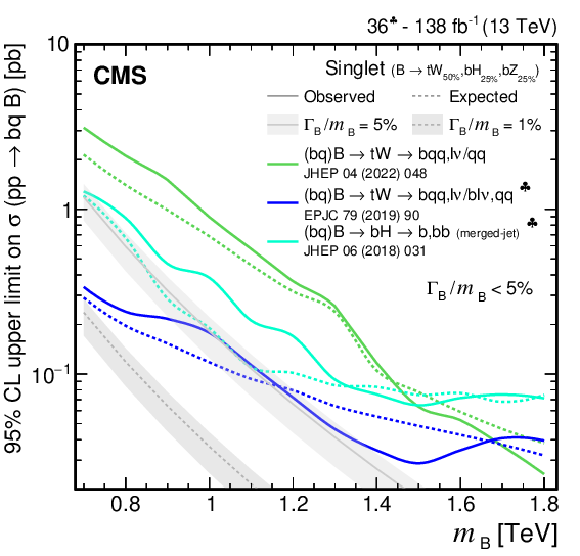
png pdf |
Figure 41-a:
Observed and expected 95% CL upper limits on the production cross section of a single B quark in association with a b quark (upper row) or a t quark (lower) in a singlet (upper left and lower) and doublet (upper right) scenario, versus the B quark mass, obtained by different analyses: $ {\mathrm{B}} \to\mathrm{t}\mathrm{W}\to\mathrm{b}\mathrm{q}\mathrm{q}\,\ell\nu/\mathrm{q}\mathrm{q} $ [153], $ {\mathrm{B}} \to\mathrm{t}\mathrm{W}\to\mathrm{b}\mathrm{q}\mathrm{q}\,\ell\nu/\mathrm{b}\ell\nu\,\mathrm{q}\mathrm{q} $ [151], and $ {\mathrm{B}} \to\mathrm{b}\mathrm{H}\to\mathrm{b}\,\mathrm{b}\mathrm{b} $ [150]. Two theory predictions at LO in perturbative QCD are superimposed, corresponding to different VLQ widths. Searches using data corresponding to an integrated luminosity of 36 fb$ ^{-1} $, rather than the full Run 2 integrated luminosity of 138 fb$ ^{-1} $, are indicated with a spade symbol in the legend. |
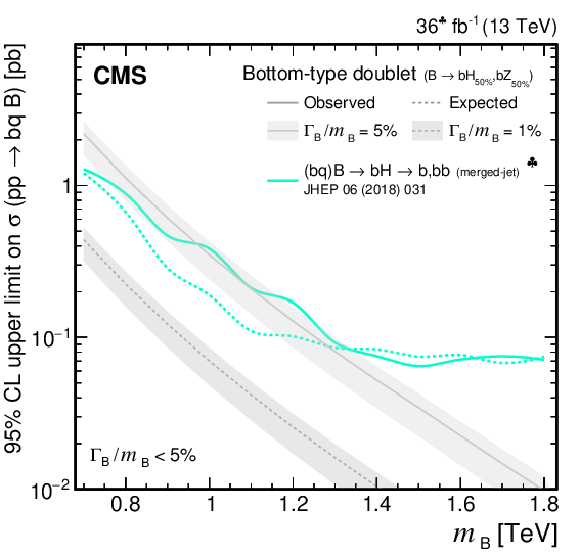
png pdf |
Figure 41-b:
Observed and expected 95% CL upper limits on the production cross section of a single B quark in association with a b quark (upper row) or a t quark (lower) in a singlet (upper left and lower) and doublet (upper right) scenario, versus the B quark mass, obtained by different analyses: $ {\mathrm{B}} \to\mathrm{t}\mathrm{W}\to\mathrm{b}\mathrm{q}\mathrm{q}\,\ell\nu/\mathrm{q}\mathrm{q} $ [153], $ {\mathrm{B}} \to\mathrm{t}\mathrm{W}\to\mathrm{b}\mathrm{q}\mathrm{q}\,\ell\nu/\mathrm{b}\ell\nu\,\mathrm{q}\mathrm{q} $ [151], and $ {\mathrm{B}} \to\mathrm{b}\mathrm{H}\to\mathrm{b}\,\mathrm{b}\mathrm{b} $ [150]. Two theory predictions at LO in perturbative QCD are superimposed, corresponding to different VLQ widths. Searches using data corresponding to an integrated luminosity of 36 fb$ ^{-1} $, rather than the full Run 2 integrated luminosity of 138 fb$ ^{-1} $, are indicated with a spade symbol in the legend. |
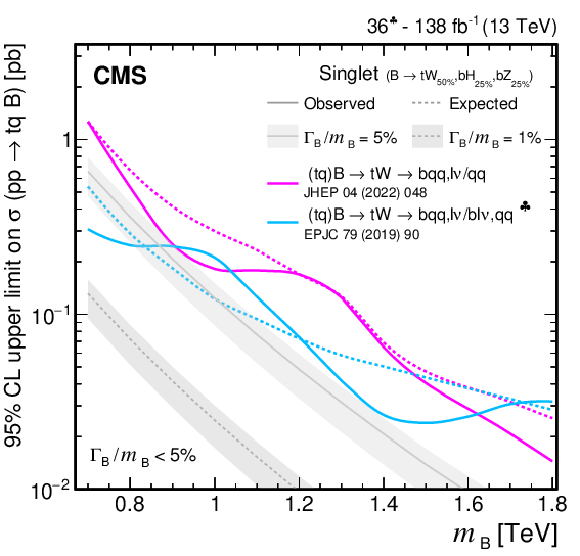
png pdf |
Figure 41-c:
Observed and expected 95% CL upper limits on the production cross section of a single B quark in association with a b quark (upper row) or a t quark (lower) in a singlet (upper left and lower) and doublet (upper right) scenario, versus the B quark mass, obtained by different analyses: $ {\mathrm{B}} \to\mathrm{t}\mathrm{W}\to\mathrm{b}\mathrm{q}\mathrm{q}\,\ell\nu/\mathrm{q}\mathrm{q} $ [153], $ {\mathrm{B}} \to\mathrm{t}\mathrm{W}\to\mathrm{b}\mathrm{q}\mathrm{q}\,\ell\nu/\mathrm{b}\ell\nu\,\mathrm{q}\mathrm{q} $ [151], and $ {\mathrm{B}} \to\mathrm{b}\mathrm{H}\to\mathrm{b}\,\mathrm{b}\mathrm{b} $ [150]. Two theory predictions at LO in perturbative QCD are superimposed, corresponding to different VLQ widths. Searches using data corresponding to an integrated luminosity of 36 fb$ ^{-1} $, rather than the full Run 2 integrated luminosity of 138 fb$ ^{-1} $, are indicated with a spade symbol in the legend. |
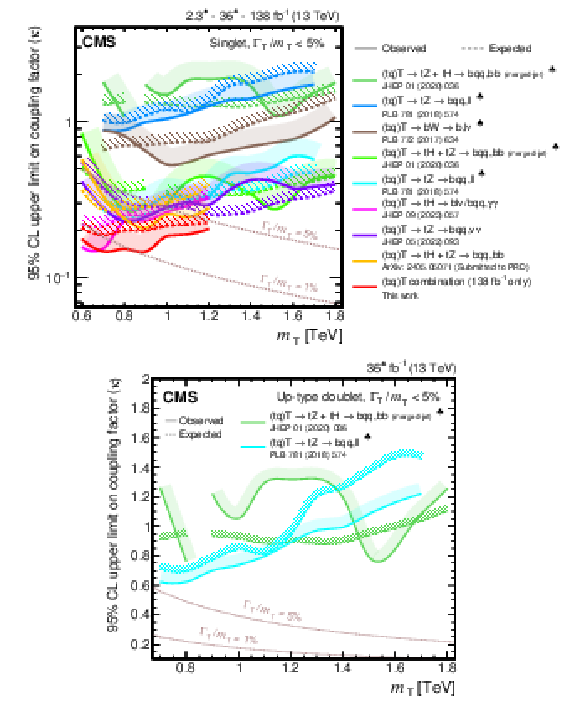
png pdf |
Figure 42:
Observed and expected 95% CL upper limits on the coupling strength $ \kappa $ for single T quark production in a singlet (upper) and doublet (lower) scenarios as functions of the T quark mass, obtained by different analyses: $ {\mathrm{T}} \to\mathrm{t}\mathrm{H}+\mathrm{t}\mathrm{Z}\to\mathrm{b}\mathrm{q}\mathrm{q}\,\mathrm{b}\mathrm{b} $ (merged-jet) [145], $ {\mathrm{T}} \to\mathrm{t}\mathrm{Z}\to\mathrm{b}\mathrm{q}\mathrm{q}\,\ell\ell $ [144], $ {\mathrm{T}} \to\mathrm{b}\mathrm{W}\to\mathrm{b}\mathrm{q}\mathrm{q}\,\ell\nu/\mathrm{b}\ell\nu\,\mathrm{q}\mathrm{q} $ [149], $ {\mathrm{T}} \to\mathrm{t}\mathrm{Z}\to\mathrm{b}\mathrm{q}\mathrm{q}\,\ell\ell $ [144], $ {\mathrm{T}} \to\mathrm{t}\mathrm{H}\to\mathrm{b}\ell\nu/\mathrm{b}\mathrm{q}\mathrm{q}\,\gamma\gamma $ [147], $ {\mathrm{T}} \to\mathrm{t}\mathrm{Z}\to\mathrm{b}\mathrm{q}\mathrm{q}\,\nu\nu $ [146], $ {\mathrm{T}} \to\mathrm{t}\mathrm{H}+\mathrm{t}\mathrm{Z}\to\mathrm{b}\mathrm{q}\mathrm{q}\,\mathrm{b}\mathrm{b} $ [148], and the single T quark combination of Section 6.5.2. Only the three analyses using the full Run 2 data set are included in the single T quark combination. Two theory predictions at LO in perturbative QCD are superimposed, corresponding to different VLQ widths. Searches using data corresponding to an integrated luminosity of 2.3 fb$ ^{-1} $ and 36 fb$ ^{-1} $, rather than the full Run 2 integrated luminosity of 138 fb$ ^{-1} $, are indicated with a heart and spade symbol, respectively, in the legend. |
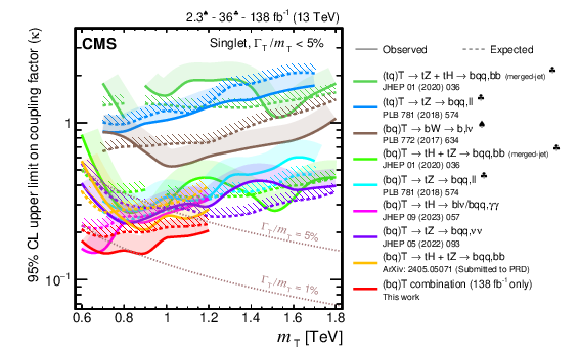
png pdf |
Figure 42-a:
Observed and expected 95% CL upper limits on the coupling strength $ \kappa $ for single T quark production in a singlet (upper) and doublet (lower) scenarios as functions of the T quark mass, obtained by different analyses: $ {\mathrm{T}} \to\mathrm{t}\mathrm{H}+\mathrm{t}\mathrm{Z}\to\mathrm{b}\mathrm{q}\mathrm{q}\,\mathrm{b}\mathrm{b} $ (merged-jet) [145], $ {\mathrm{T}} \to\mathrm{t}\mathrm{Z}\to\mathrm{b}\mathrm{q}\mathrm{q}\,\ell\ell $ [144], $ {\mathrm{T}} \to\mathrm{b}\mathrm{W}\to\mathrm{b}\mathrm{q}\mathrm{q}\,\ell\nu/\mathrm{b}\ell\nu\,\mathrm{q}\mathrm{q} $ [149], $ {\mathrm{T}} \to\mathrm{t}\mathrm{Z}\to\mathrm{b}\mathrm{q}\mathrm{q}\,\ell\ell $ [144], $ {\mathrm{T}} \to\mathrm{t}\mathrm{H}\to\mathrm{b}\ell\nu/\mathrm{b}\mathrm{q}\mathrm{q}\,\gamma\gamma $ [147], $ {\mathrm{T}} \to\mathrm{t}\mathrm{Z}\to\mathrm{b}\mathrm{q}\mathrm{q}\,\nu\nu $ [146], $ {\mathrm{T}} \to\mathrm{t}\mathrm{H}+\mathrm{t}\mathrm{Z}\to\mathrm{b}\mathrm{q}\mathrm{q}\,\mathrm{b}\mathrm{b} $ [148], and the single T quark combination of Section 6.5.2. Only the three analyses using the full Run 2 data set are included in the single T quark combination. Two theory predictions at LO in perturbative QCD are superimposed, corresponding to different VLQ widths. Searches using data corresponding to an integrated luminosity of 2.3 fb$ ^{-1} $ and 36 fb$ ^{-1} $, rather than the full Run 2 integrated luminosity of 138 fb$ ^{-1} $, are indicated with a heart and spade symbol, respectively, in the legend. |
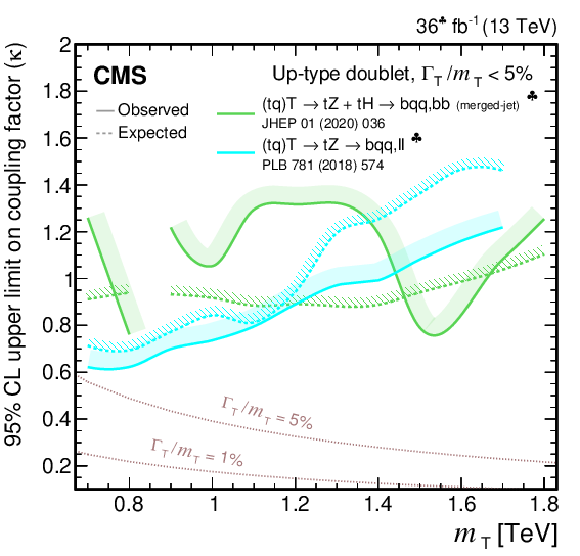
png pdf |
Figure 42-b:
Observed and expected 95% CL upper limits on the coupling strength $ \kappa $ for single T quark production in a singlet (upper) and doublet (lower) scenarios as functions of the T quark mass, obtained by different analyses: $ {\mathrm{T}} \to\mathrm{t}\mathrm{H}+\mathrm{t}\mathrm{Z}\to\mathrm{b}\mathrm{q}\mathrm{q}\,\mathrm{b}\mathrm{b} $ (merged-jet) [145], $ {\mathrm{T}} \to\mathrm{t}\mathrm{Z}\to\mathrm{b}\mathrm{q}\mathrm{q}\,\ell\ell $ [144], $ {\mathrm{T}} \to\mathrm{b}\mathrm{W}\to\mathrm{b}\mathrm{q}\mathrm{q}\,\ell\nu/\mathrm{b}\ell\nu\,\mathrm{q}\mathrm{q} $ [149], $ {\mathrm{T}} \to\mathrm{t}\mathrm{Z}\to\mathrm{b}\mathrm{q}\mathrm{q}\,\ell\ell $ [144], $ {\mathrm{T}} \to\mathrm{t}\mathrm{H}\to\mathrm{b}\ell\nu/\mathrm{b}\mathrm{q}\mathrm{q}\,\gamma\gamma $ [147], $ {\mathrm{T}} \to\mathrm{t}\mathrm{Z}\to\mathrm{b}\mathrm{q}\mathrm{q}\,\nu\nu $ [146], $ {\mathrm{T}} \to\mathrm{t}\mathrm{H}+\mathrm{t}\mathrm{Z}\to\mathrm{b}\mathrm{q}\mathrm{q}\,\mathrm{b}\mathrm{b} $ [148], and the single T quark combination of Section 6.5.2. Only the three analyses using the full Run 2 data set are included in the single T quark combination. Two theory predictions at LO in perturbative QCD are superimposed, corresponding to different VLQ widths. Searches using data corresponding to an integrated luminosity of 2.3 fb$ ^{-1} $ and 36 fb$ ^{-1} $, rather than the full Run 2 integrated luminosity of 138 fb$ ^{-1} $, are indicated with a heart and spade symbol, respectively, in the legend. |
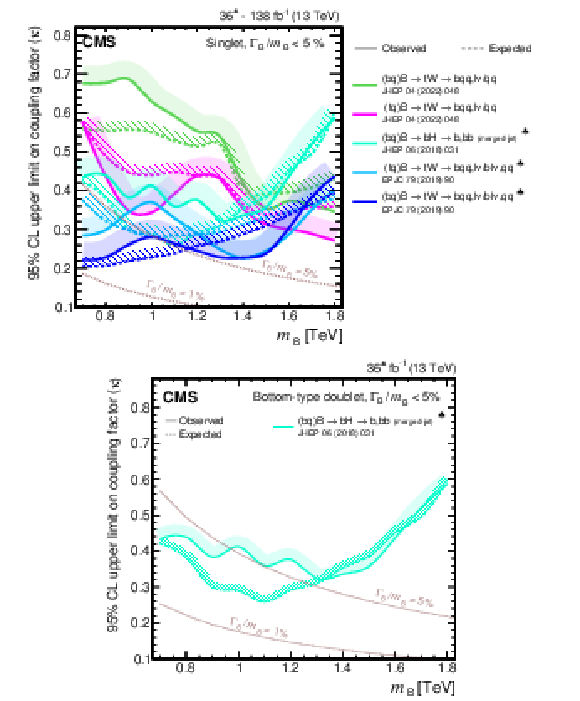
png pdf |
Figure 43:
Observed and expected 95% CL upper limits on the coupling strength $ \kappa $ for single B quark production in a singlet (upper) and doublet (lower) scenarios as functions of the B quark mass, obtained by different analyses: $ {\mathrm{B}} \to\mathrm{t}\mathrm{W}\to\mathrm{b}\mathrm{q}\mathrm{q}\,\ell\nu/\mathrm{q}\mathrm{q} $ [153], $ {\mathrm{B}} \to\mathrm{b}\mathrm{H}\to\mathrm{b}\,\mathrm{b}\mathrm{b} $ [150], and $ {\mathrm{B}} \to\mathrm{t}\mathrm{W}\to\mathrm{b}\mathrm{q}\mathrm{q}\,\ell\nu/\mathrm{b}\ell\nu\,\mathrm{q}\mathrm{q} $ [151]. Two theory predictions at LO in perturbative QCD are superimposed, corresponding to different VLQ widths. Searches using data corresponding to an integrated luminosity of 36 fb$ ^{-1} $, rather than the full Run 2 integrated luminosity of 138 fb$ ^{-1} $, are indicated with a spade symbol in the legend. |
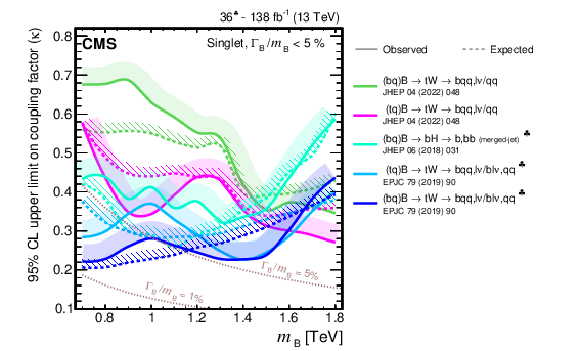
png pdf |
Figure 43-a:
Observed and expected 95% CL upper limits on the coupling strength $ \kappa $ for single B quark production in a singlet (upper) and doublet (lower) scenarios as functions of the B quark mass, obtained by different analyses: $ {\mathrm{B}} \to\mathrm{t}\mathrm{W}\to\mathrm{b}\mathrm{q}\mathrm{q}\,\ell\nu/\mathrm{q}\mathrm{q} $ [153], $ {\mathrm{B}} \to\mathrm{b}\mathrm{H}\to\mathrm{b}\,\mathrm{b}\mathrm{b} $ [150], and $ {\mathrm{B}} \to\mathrm{t}\mathrm{W}\to\mathrm{b}\mathrm{q}\mathrm{q}\,\ell\nu/\mathrm{b}\ell\nu\,\mathrm{q}\mathrm{q} $ [151]. Two theory predictions at LO in perturbative QCD are superimposed, corresponding to different VLQ widths. Searches using data corresponding to an integrated luminosity of 36 fb$ ^{-1} $, rather than the full Run 2 integrated luminosity of 138 fb$ ^{-1} $, are indicated with a spade symbol in the legend. |
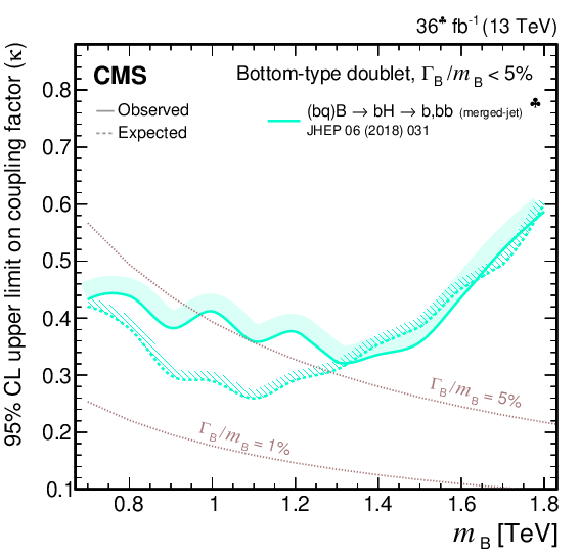
png pdf |
Figure 43-b:
Observed and expected 95% CL upper limits on the coupling strength $ \kappa $ for single B quark production in a singlet (upper) and doublet (lower) scenarios as functions of the B quark mass, obtained by different analyses: $ {\mathrm{B}} \to\mathrm{t}\mathrm{W}\to\mathrm{b}\mathrm{q}\mathrm{q}\,\ell\nu/\mathrm{q}\mathrm{q} $ [153], $ {\mathrm{B}} \to\mathrm{b}\mathrm{H}\to\mathrm{b}\,\mathrm{b}\mathrm{b} $ [150], and $ {\mathrm{B}} \to\mathrm{t}\mathrm{W}\to\mathrm{b}\mathrm{q}\mathrm{q}\,\ell\nu/\mathrm{b}\ell\nu\,\mathrm{q}\mathrm{q} $ [151]. Two theory predictions at LO in perturbative QCD are superimposed, corresponding to different VLQ widths. Searches using data corresponding to an integrated luminosity of 36 fb$ ^{-1} $, rather than the full Run 2 integrated luminosity of 138 fb$ ^{-1} $, are indicated with a spade symbol in the legend. |
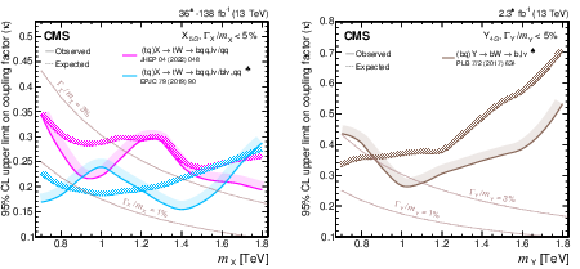
png pdf |
Figure 44:
Observed and expected 95% CL upper limits on the coupling strength $ \kappa $ for single $\mathrm{X}_{5/3}$ (left) and $\mathrm{Y}_{4/3}$ (right) production as functions of the VLQ mass, obtained by different analyses: $ {\mathrm{X}_{5/3}} \to\mathrm{t}\mathrm{W}\to\mathrm{b}\mathrm{q}\mathrm{q}\,\ell\nu/\mathrm{q}\mathrm{q} $ [153], $ {\mathrm{X}_{5/3}} \to\mathrm{t}\mathrm{W}\to\mathrm{b}\mathrm{q}\mathrm{q}\,\ell\nu/\mathrm{b}\ell\nu\,\mathrm{q}\mathrm{q} $ [151], and $ {\mathrm{Y}_{4/3}} \to\mathrm{b}\mathrm{W}\to\mathrm{b}\,\ell\nu $ [149]. Searches using data corresponding to an integrated luminosity of 2.3 fb$ ^{-1} $ and 36 fb$ ^{-1} $, rather than the full Run-s2 integrated luminosity of 138 fb$ ^{-1} $, are indicated with a heart and spade symbol, respectively, in the legend. |
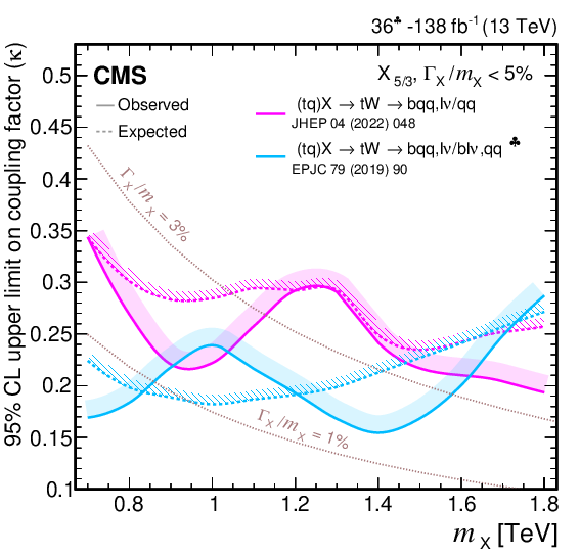
png pdf |
Figure 44-a:
Observed and expected 95% CL upper limits on the coupling strength $ \kappa $ for single $\mathrm{X}_{5/3}$ (left) and $\mathrm{Y}_{4/3}$ (right) production as functions of the VLQ mass, obtained by different analyses: $ {\mathrm{X}_{5/3}} \to\mathrm{t}\mathrm{W}\to\mathrm{b}\mathrm{q}\mathrm{q}\,\ell\nu/\mathrm{q}\mathrm{q} $ [153], $ {\mathrm{X}_{5/3}} \to\mathrm{t}\mathrm{W}\to\mathrm{b}\mathrm{q}\mathrm{q}\,\ell\nu/\mathrm{b}\ell\nu\,\mathrm{q}\mathrm{q} $ [151], and $ {\mathrm{Y}_{4/3}} \to\mathrm{b}\mathrm{W}\to\mathrm{b}\,\ell\nu $ [149]. Searches using data corresponding to an integrated luminosity of 2.3 fb$ ^{-1} $ and 36 fb$ ^{-1} $, rather than the full Run-s2 integrated luminosity of 138 fb$ ^{-1} $, are indicated with a heart and spade symbol, respectively, in the legend. |
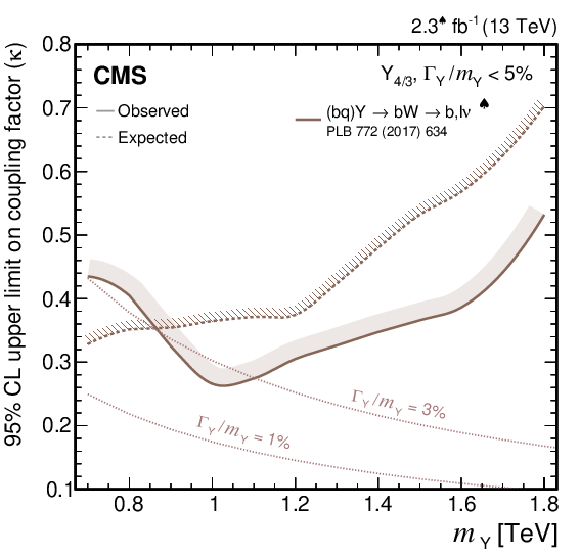
png pdf |
Figure 44-b:
Observed and expected 95% CL upper limits on the coupling strength $ \kappa $ for single $\mathrm{X}_{5/3}$ (left) and $\mathrm{Y}_{4/3}$ (right) production as functions of the VLQ mass, obtained by different analyses: $ {\mathrm{X}_{5/3}} \to\mathrm{t}\mathrm{W}\to\mathrm{b}\mathrm{q}\mathrm{q}\,\ell\nu/\mathrm{q}\mathrm{q} $ [153], $ {\mathrm{X}_{5/3}} \to\mathrm{t}\mathrm{W}\to\mathrm{b}\mathrm{q}\mathrm{q}\,\ell\nu/\mathrm{b}\ell\nu\,\mathrm{q}\mathrm{q} $ [151], and $ {\mathrm{Y}_{4/3}} \to\mathrm{b}\mathrm{W}\to\mathrm{b}\,\ell\nu $ [149]. Searches using data corresponding to an integrated luminosity of 2.3 fb$ ^{-1} $ and 36 fb$ ^{-1} $, rather than the full Run-s2 integrated luminosity of 138 fb$ ^{-1} $, are indicated with a heart and spade symbol, respectively, in the legend. |
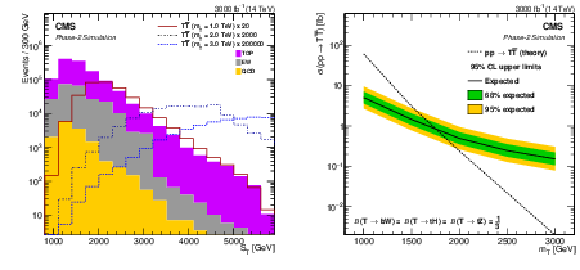
png pdf |
Figure 45:
Distributions of the $ S_{\mathrm{T}} $ observable for signal and background processes (left), with signal distributions scaled by factors of 20, 2000, and 200\,000, depending on the T quark mass, and expected upper limits at 95% CL on the $ {\mathrm{T}} \overline{\mathrm{T}} $ production cross section (right). The inner (green) and the outer (yellow) bands indicate the regions containing 68 and 95%, respectively, of the distribution of limits expected under the background-only hypothesis. Figures adapted from Ref. [170]. |
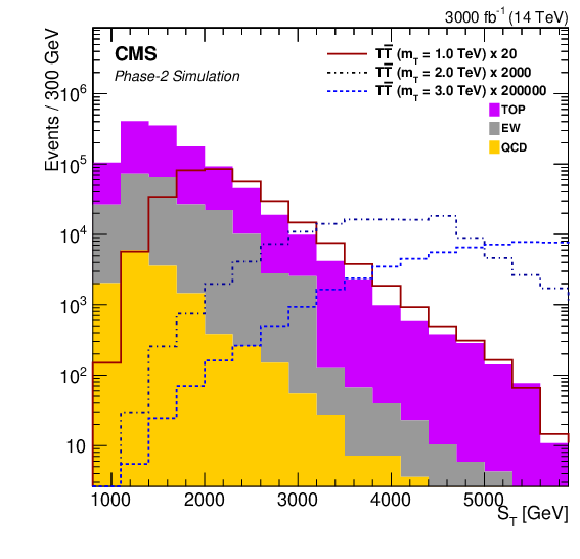
png pdf |
Figure 45-a:
Distributions of the $ S_{\mathrm{T}} $ observable for signal and background processes (left), with signal distributions scaled by factors of 20, 2000, and 200\,000, depending on the T quark mass, and expected upper limits at 95% CL on the $ {\mathrm{T}} \overline{\mathrm{T}} $ production cross section (right). The inner (green) and the outer (yellow) bands indicate the regions containing 68 and 95%, respectively, of the distribution of limits expected under the background-only hypothesis. Figures adapted from Ref. [170]. |
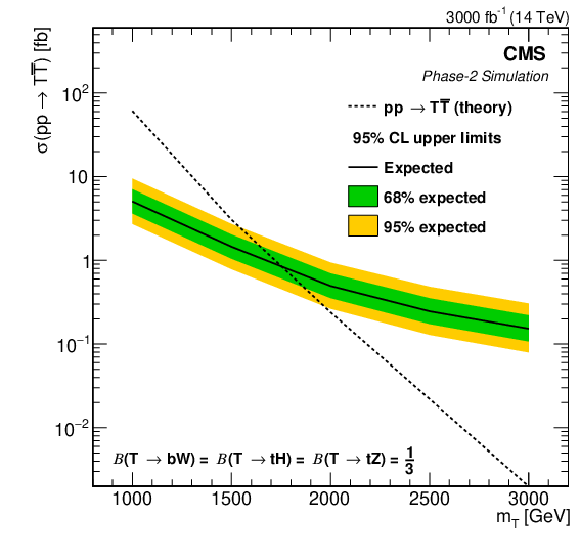
png pdf |
Figure 45-b:
Distributions of the $ S_{\mathrm{T}} $ observable for signal and background processes (left), with signal distributions scaled by factors of 20, 2000, and 200\,000, depending on the T quark mass, and expected upper limits at 95% CL on the $ {\mathrm{T}} \overline{\mathrm{T}} $ production cross section (right). The inner (green) and the outer (yellow) bands indicate the regions containing 68 and 95%, respectively, of the distribution of limits expected under the background-only hypothesis. Figures adapted from Ref. [170]. |
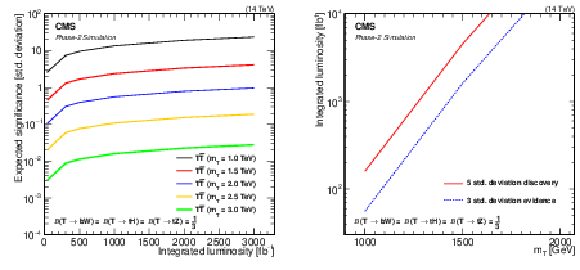
png pdf |
Figure 46:
Expected significances for T quark pair production as a function of the integrated luminosity at the HL-LHC, assuming equal branching fractions for $ {\mathrm{T}} \to\mathrm{b}\mathrm{W} $, $ \mathrm{t}\mathrm{Z} $, $ \mathrm{t}\mathrm{H} $ decays (left). Discovery potential at three and five standard deviations for T quark pairs, as a function of the T quark mass and the integrated luminosity (right). Figures adapted from Ref. [170]. |
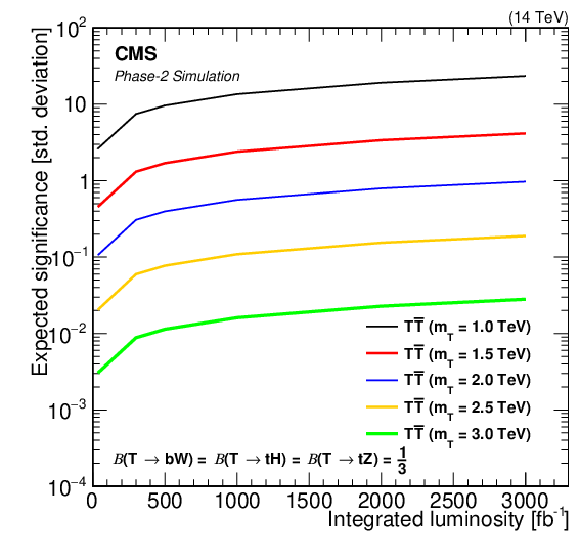
png pdf |
Figure 46-a:
Expected significances for T quark pair production as a function of the integrated luminosity at the HL-LHC, assuming equal branching fractions for $ {\mathrm{T}} \to\mathrm{b}\mathrm{W} $, $ \mathrm{t}\mathrm{Z} $, $ \mathrm{t}\mathrm{H} $ decays (left). Discovery potential at three and five standard deviations for T quark pairs, as a function of the T quark mass and the integrated luminosity (right). Figures adapted from Ref. [170]. |
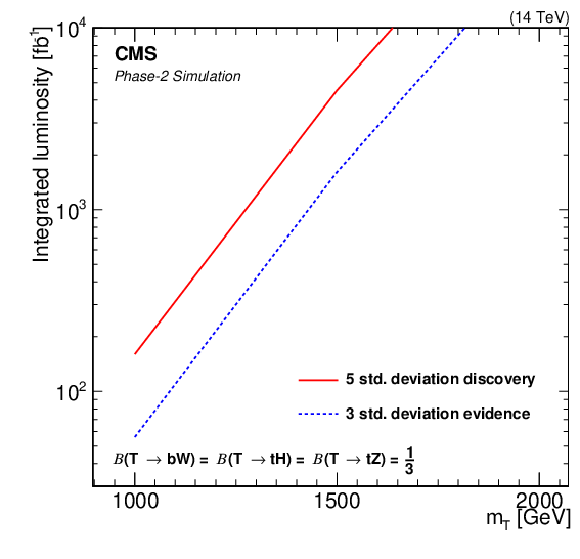
png pdf |
Figure 46-b:
Expected significances for T quark pair production as a function of the integrated luminosity at the HL-LHC, assuming equal branching fractions for $ {\mathrm{T}} \to\mathrm{b}\mathrm{W} $, $ \mathrm{t}\mathrm{Z} $, $ \mathrm{t}\mathrm{H} $ decays (left). Discovery potential at three and five standard deviations for T quark pairs, as a function of the T quark mass and the integrated luminosity (right). Figures adapted from Ref. [170]. |
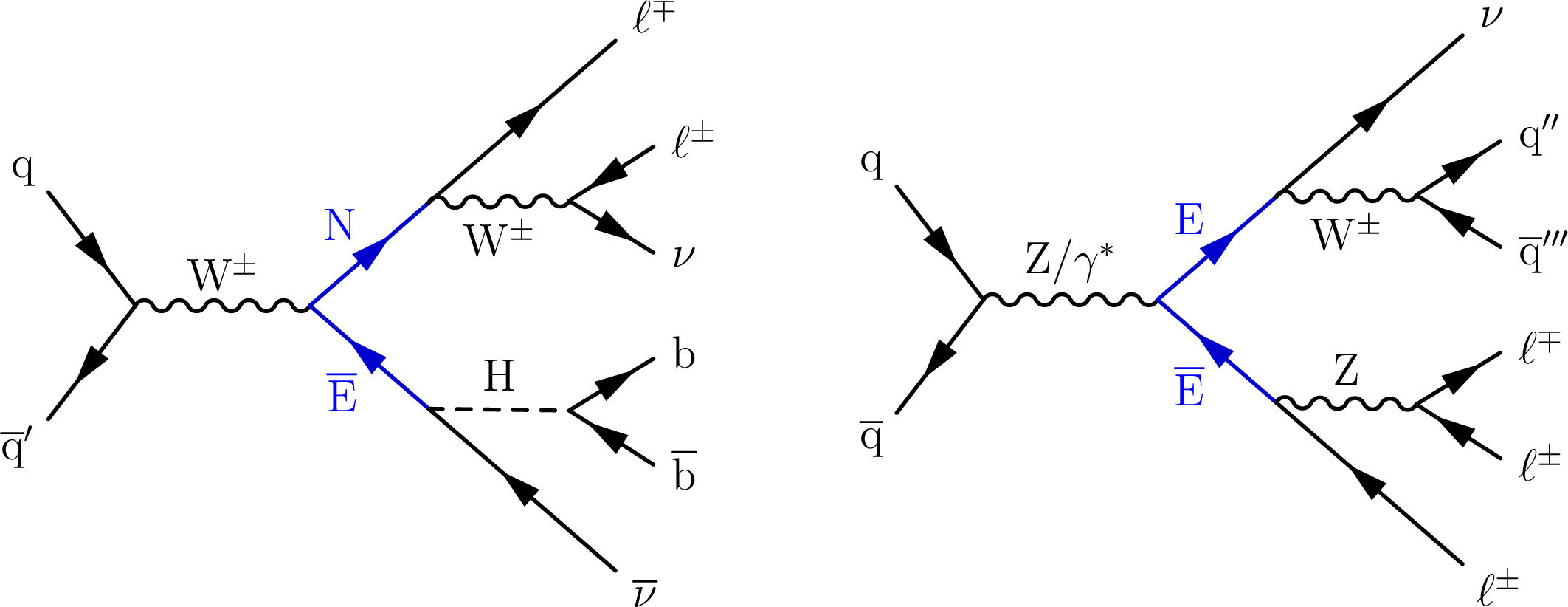
png pdf |
Figure 47:
Example processes illustrating production and decay of doublet (left) and singlet (right) VLL pairs at the LHC that result in multilepton final states. |
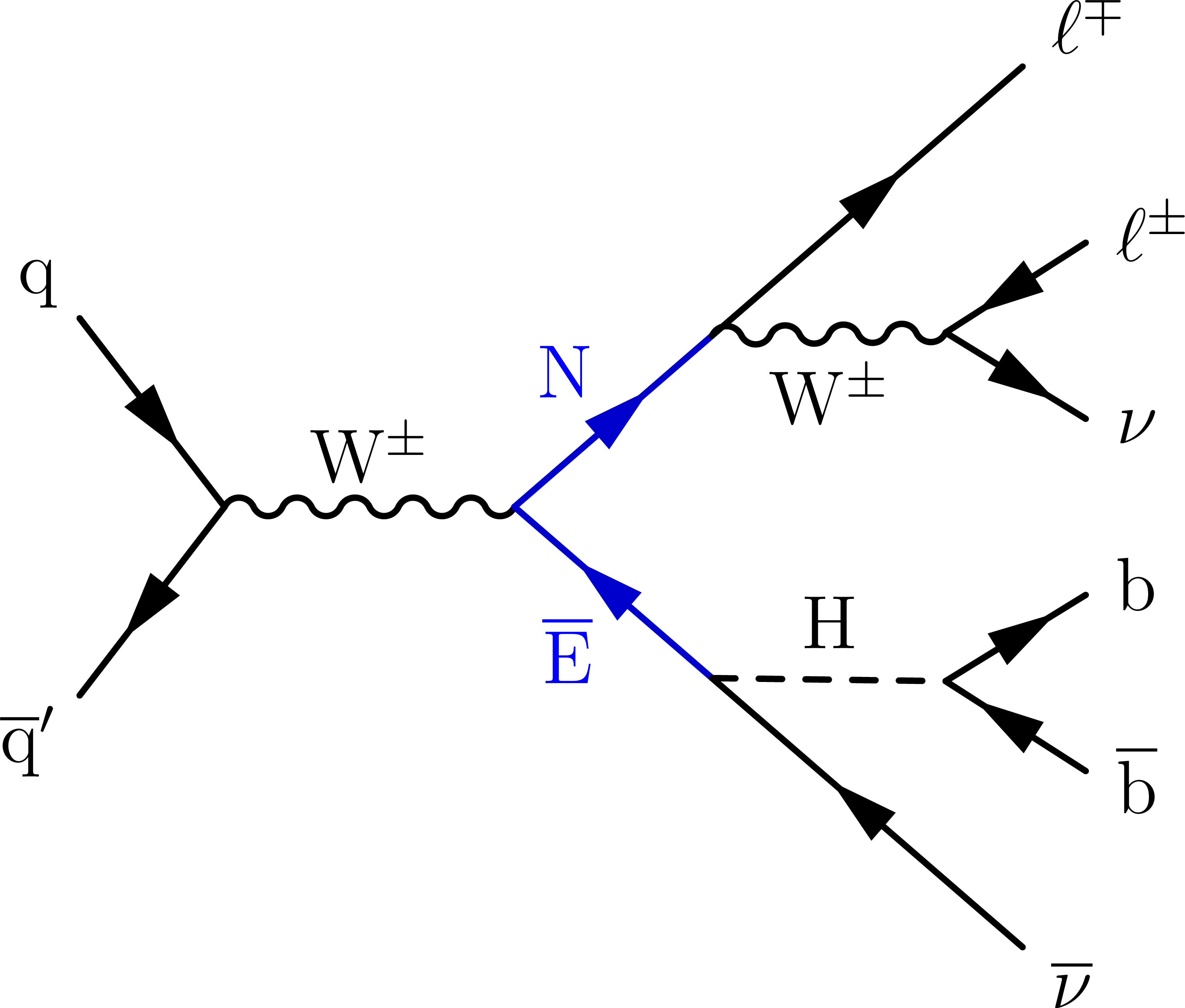
png pdf |
Figure 47-a:
Example processes illustrating production and decay of doublet (left) and singlet (right) VLL pairs at the LHC that result in multilepton final states. |
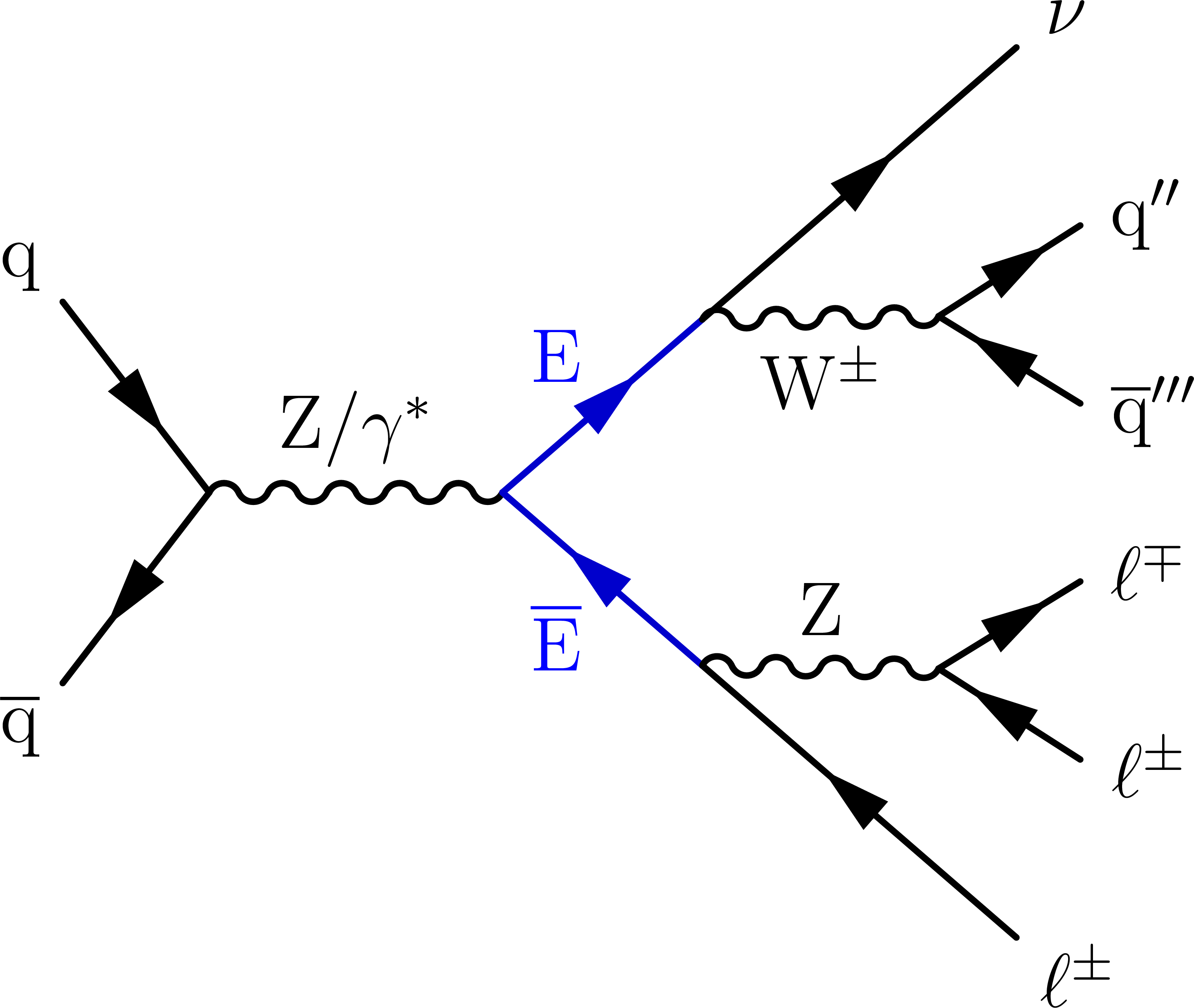
png pdf |
Figure 47-b:
Example processes illustrating production and decay of doublet (left) and singlet (right) VLL pairs at the LHC that result in multilepton final states. |

png pdf |
Figure 48:
Example diagrams showing $ s $-channel EW production of VLL pairs through SM bosons, as expected at the LHC (left two diagrams). In these diagrams, L represents either the neutral VLL, N, or the charged VLL, E. The VLL decays are mediated by a vector leptoquark U (right two diagrams). In the 4321 model, these decays are primarily to third-generation leptons and quarks. |
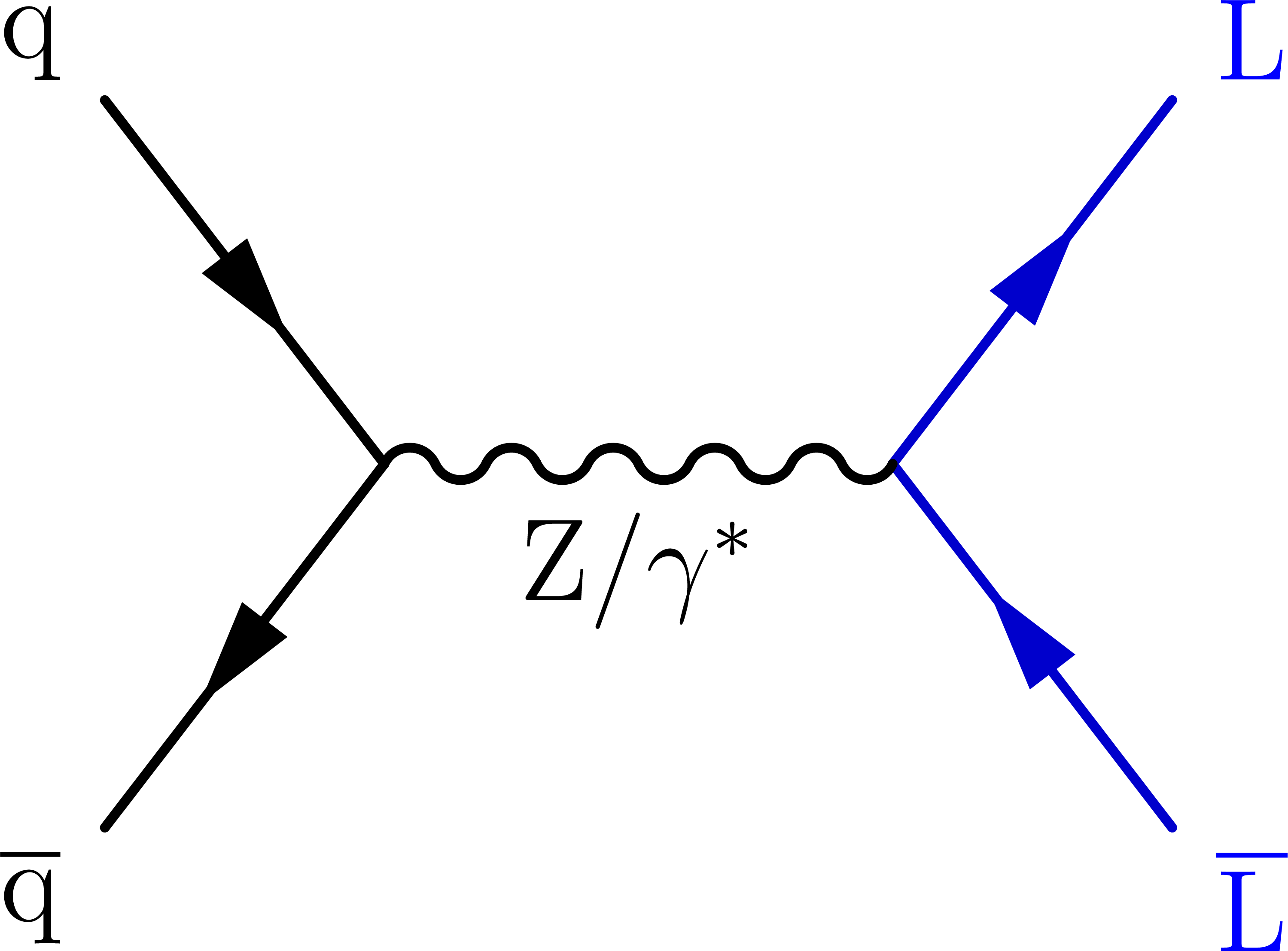
png pdf |
Figure 48-a:
Example diagrams showing $ s $-channel EW production of VLL pairs through SM bosons, as expected at the LHC (left two diagrams). In these diagrams, L represents either the neutral VLL, N, or the charged VLL, E. The VLL decays are mediated by a vector leptoquark U (right two diagrams). In the 4321 model, these decays are primarily to third-generation leptons and quarks. |
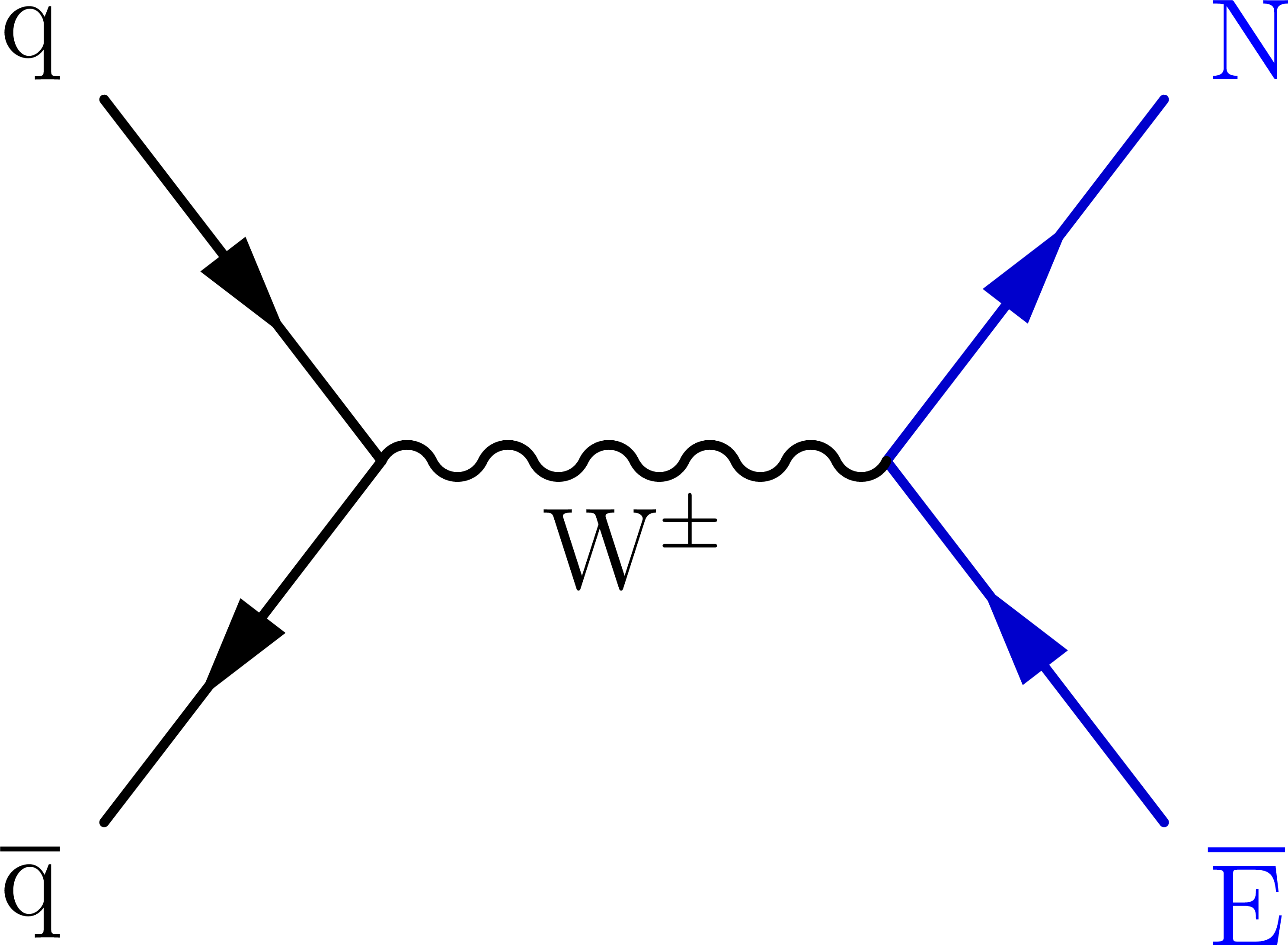
png pdf |
Figure 48-b:
Example diagrams showing $ s $-channel EW production of VLL pairs through SM bosons, as expected at the LHC (left two diagrams). In these diagrams, L represents either the neutral VLL, N, or the charged VLL, E. The VLL decays are mediated by a vector leptoquark U (right two diagrams). In the 4321 model, these decays are primarily to third-generation leptons and quarks. |
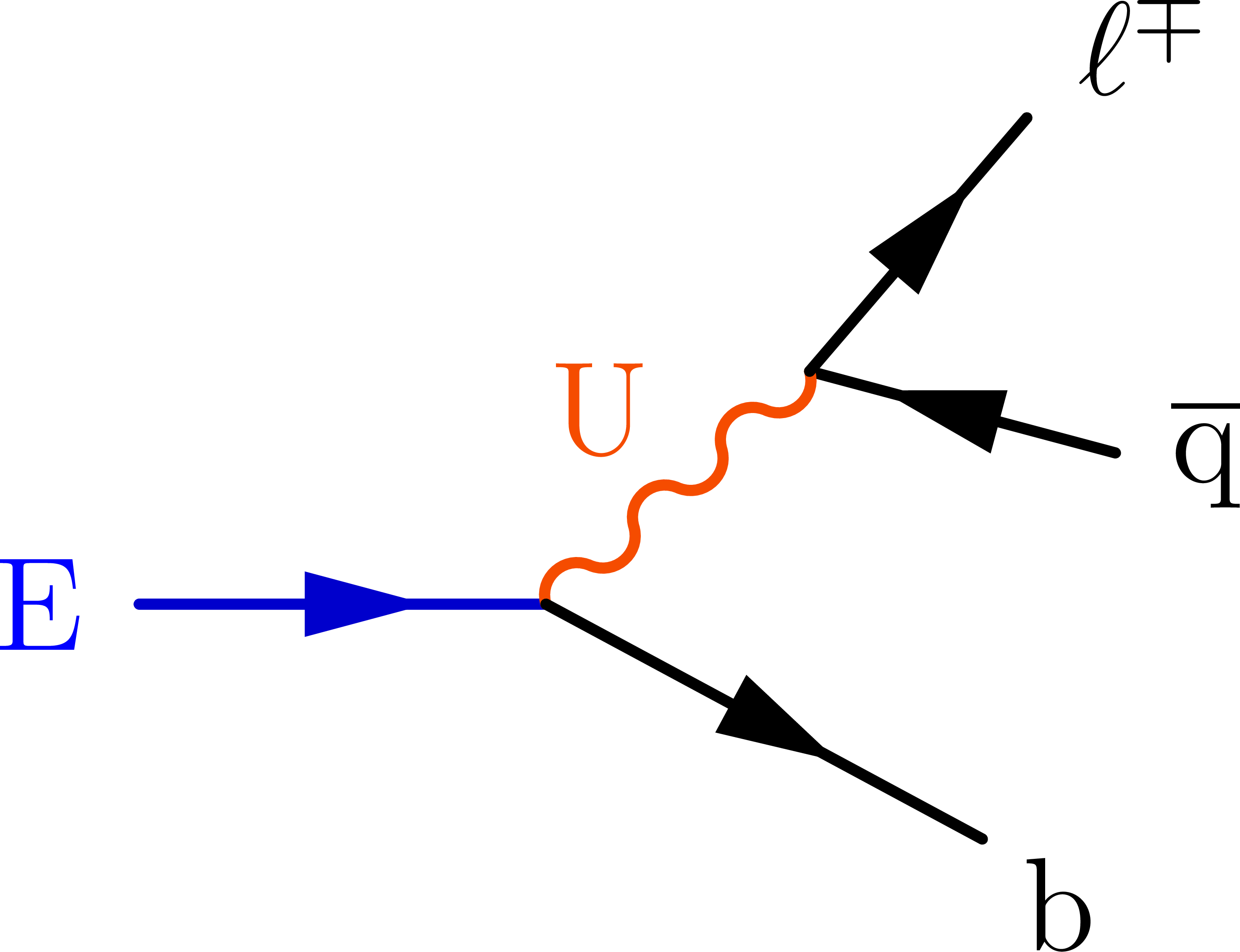
png pdf |
Figure 48-c:
Example diagrams showing $ s $-channel EW production of VLL pairs through SM bosons, as expected at the LHC (left two diagrams). In these diagrams, L represents either the neutral VLL, N, or the charged VLL, E. The VLL decays are mediated by a vector leptoquark U (right two diagrams). In the 4321 model, these decays are primarily to third-generation leptons and quarks. |
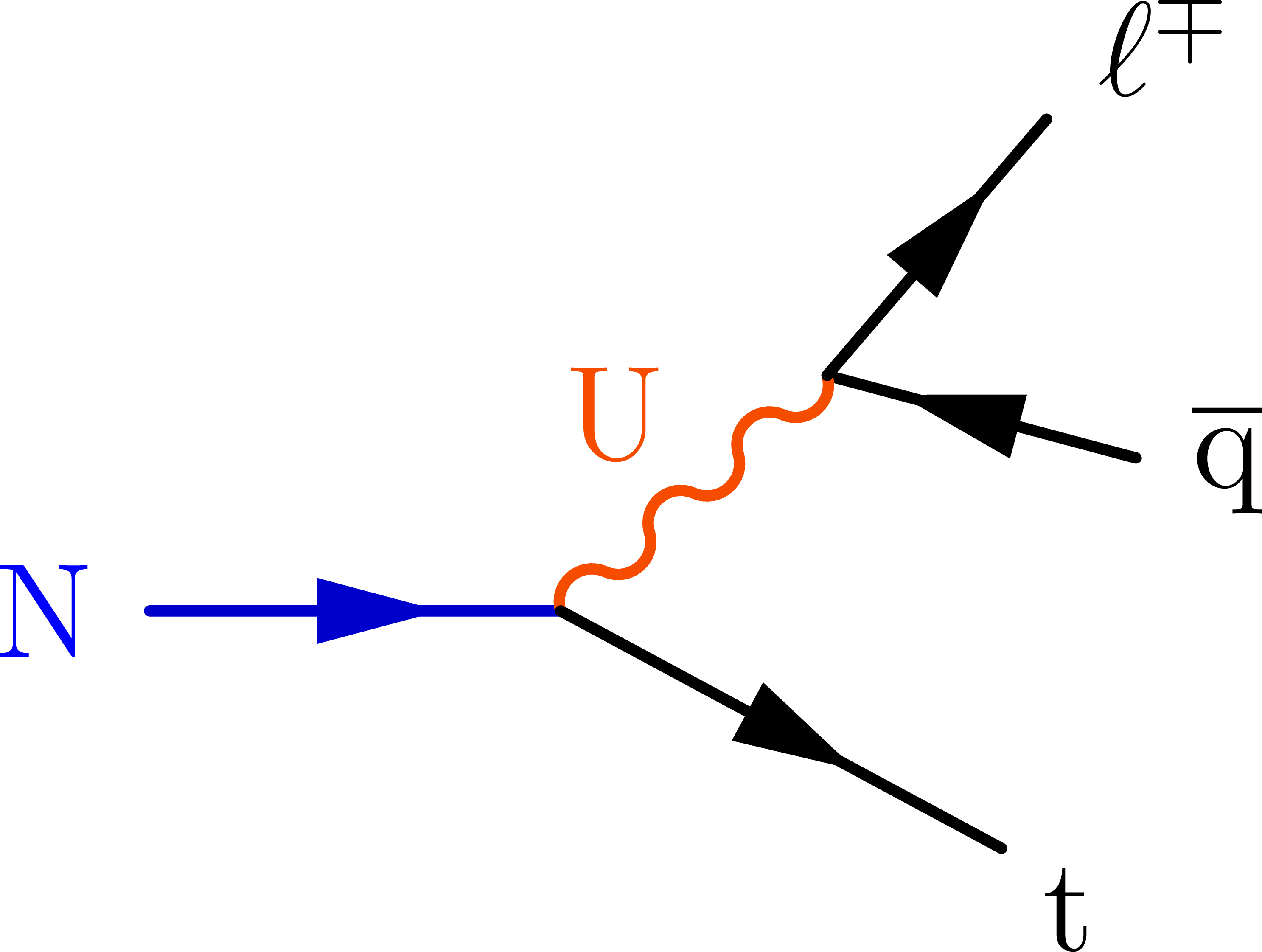
png pdf |
Figure 48-d:
Example diagrams showing $ s $-channel EW production of VLL pairs through SM bosons, as expected at the LHC (left two diagrams). In these diagrams, L represents either the neutral VLL, N, or the charged VLL, E. The VLL decays are mediated by a vector leptoquark U (right two diagrams). In the 4321 model, these decays are primarily to third-generation leptons and quarks. |
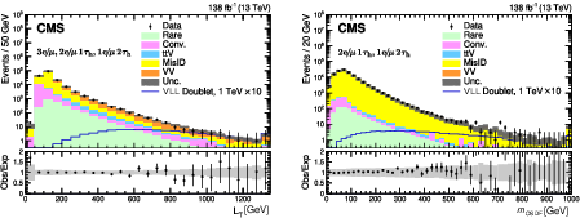
png pdf |
Figure 49:
The $ L_{\mathrm{T}} $ distribution in 3$ \mkern1mu\mathrm{e}\mkern-2mu/\mkern-3mu\mu $, 2 $ \mkern1mu\mathrm{e}\mkern-2mu/\mkern-3mu\mu1\tau_\mathrm{h} $, and 1 $ \mkern1mu\mathrm{e}\mkern-2mu/\mkern-3mu\mu2\tau_\mathrm{h} $ events (left), and the invariant mass distribution of the OS different-flavor ($ m_{\text{OSDF}} $) light lepton and tau lepton pair in 2 $ \mkern1mu\mathrm{e}\mkern-2mu/\mkern-3mu\mu1\tau_\mathrm{h} $ and 1 $ \mkern1mu\mathrm{e}\mkern-2mu/\mkern-3mu\mu2\tau_\mathrm{h} $ events (right). The rightmost bin contains the overflow events. The lower panel shows the ratio of observed events to the total expected background prediction. The gray band on the ratio represents the quadratic sum of statistical and systematic uncertainties in the SM background prediction. The expected SM background distributions and the uncertainties are shown after fitting the data under the background-only hypothesis. For illustration, an example signal hypothesis for the production of vector-like leptons coupled to third-generation SM leptons in the doublet scenario for a VLL mass of 1 TeV, before the fit, is overlaid. The signal yield is scaled by a factor of 10 for visualization purposes. Figures adapted from Ref. [204]. |
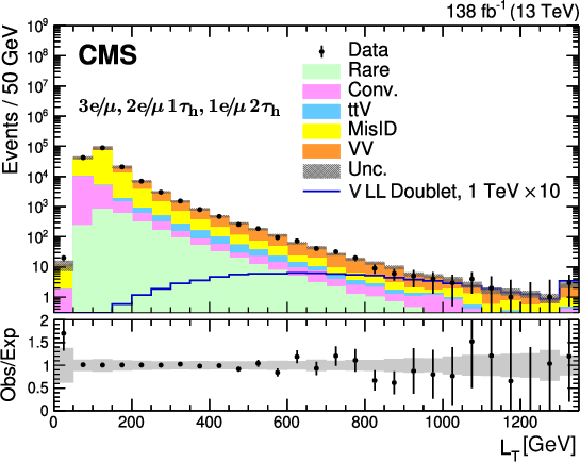
png pdf |
Figure 49-a:
The $ L_{\mathrm{T}} $ distribution in 3$ \mkern1mu\mathrm{e}\mkern-2mu/\mkern-3mu\mu $, 2 $ \mkern1mu\mathrm{e}\mkern-2mu/\mkern-3mu\mu1\tau_\mathrm{h} $, and 1 $ \mkern1mu\mathrm{e}\mkern-2mu/\mkern-3mu\mu2\tau_\mathrm{h} $ events (left), and the invariant mass distribution of the OS different-flavor ($ m_{\text{OSDF}} $) light lepton and tau lepton pair in 2 $ \mkern1mu\mathrm{e}\mkern-2mu/\mkern-3mu\mu1\tau_\mathrm{h} $ and 1 $ \mkern1mu\mathrm{e}\mkern-2mu/\mkern-3mu\mu2\tau_\mathrm{h} $ events (right). The rightmost bin contains the overflow events. The lower panel shows the ratio of observed events to the total expected background prediction. The gray band on the ratio represents the quadratic sum of statistical and systematic uncertainties in the SM background prediction. The expected SM background distributions and the uncertainties are shown after fitting the data under the background-only hypothesis. For illustration, an example signal hypothesis for the production of vector-like leptons coupled to third-generation SM leptons in the doublet scenario for a VLL mass of 1 TeV, before the fit, is overlaid. The signal yield is scaled by a factor of 10 for visualization purposes. Figures adapted from Ref. [204]. |
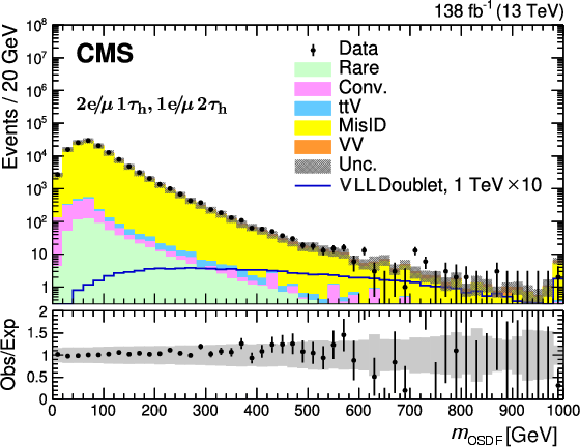
png pdf |
Figure 49-b:
The $ L_{\mathrm{T}} $ distribution in 3$ \mkern1mu\mathrm{e}\mkern-2mu/\mkern-3mu\mu $, 2 $ \mkern1mu\mathrm{e}\mkern-2mu/\mkern-3mu\mu1\tau_\mathrm{h} $, and 1 $ \mkern1mu\mathrm{e}\mkern-2mu/\mkern-3mu\mu2\tau_\mathrm{h} $ events (left), and the invariant mass distribution of the OS different-flavor ($ m_{\text{OSDF}} $) light lepton and tau lepton pair in 2 $ \mkern1mu\mathrm{e}\mkern-2mu/\mkern-3mu\mu1\tau_\mathrm{h} $ and 1 $ \mkern1mu\mathrm{e}\mkern-2mu/\mkern-3mu\mu2\tau_\mathrm{h} $ events (right). The rightmost bin contains the overflow events. The lower panel shows the ratio of observed events to the total expected background prediction. The gray band on the ratio represents the quadratic sum of statistical and systematic uncertainties in the SM background prediction. The expected SM background distributions and the uncertainties are shown after fitting the data under the background-only hypothesis. For illustration, an example signal hypothesis for the production of vector-like leptons coupled to third-generation SM leptons in the doublet scenario for a VLL mass of 1 TeV, before the fit, is overlaid. The signal yield is scaled by a factor of 10 for visualization purposes. Figures adapted from Ref. [204]. |
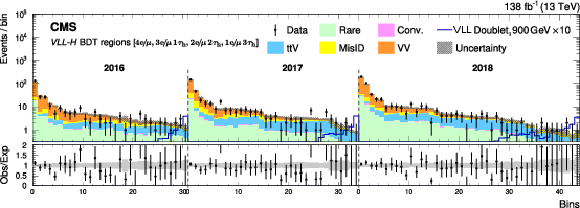
png pdf |
Figure 50:
The \textitVLL-H BDT regions for the four-lepton channels for the full Run 2 data set. The lower panel shows the ratio of observed events to the total expected background prediction. The gray band on the ratio represents the quadratic sum of statistical and systematic uncertainties in the SM background prediction. The expected SM background distributions and the uncertainties are shown after fitting the data under the background-only hypothesis. For illustration, an example signal hypothesis for the production of the vector-like leptons coupled to the third generation SM leptons in the doublet scenario for a VLL mass of 900 GeV, before the fit, is overlaid. The signal yield is scaled by a factor of 10 for visualization purposes. Figure adapted from Ref. [204]. |
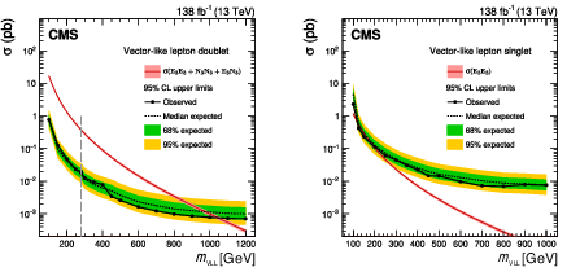
png pdf |
Figure 51:
Observed and expected upper limits at 95% CL on the production cross section for the vector-like leptons coupled to third-generation SM leptons in the doublet model (left) and singlet model (right). For the doublet vector-like lepton model, to the left of the vertical dashed gray line, the limits are shown from the model-independent scheme, while to the right the limits are shown from the model dependent BDT regions. For the singlet vector-like lepton model, the limit is shown from the model-independent scheme for all masses. Figures adapted from Ref. [204]. |
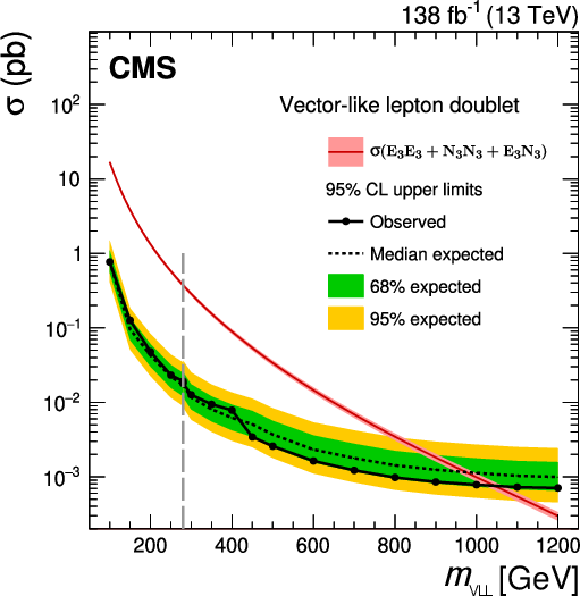
png pdf |
Figure 51-a:
Observed and expected upper limits at 95% CL on the production cross section for the vector-like leptons coupled to third-generation SM leptons in the doublet model (left) and singlet model (right). For the doublet vector-like lepton model, to the left of the vertical dashed gray line, the limits are shown from the model-independent scheme, while to the right the limits are shown from the model dependent BDT regions. For the singlet vector-like lepton model, the limit is shown from the model-independent scheme for all masses. Figures adapted from Ref. [204]. |
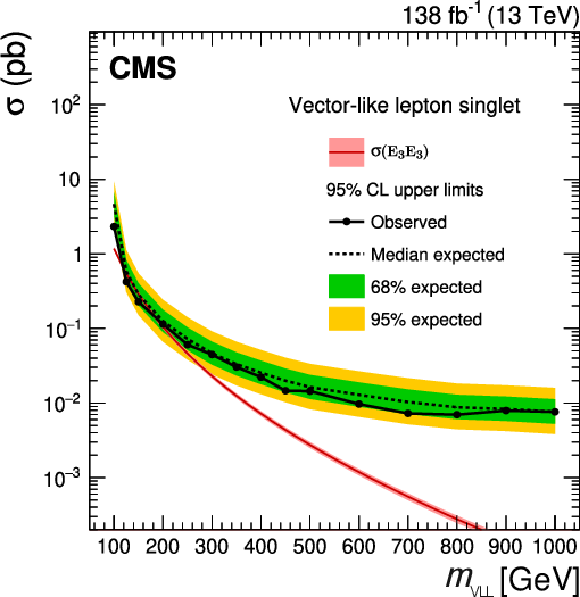
png pdf |
Figure 51-b:
Observed and expected upper limits at 95% CL on the production cross section for the vector-like leptons coupled to third-generation SM leptons in the doublet model (left) and singlet model (right). For the doublet vector-like lepton model, to the left of the vertical dashed gray line, the limits are shown from the model-independent scheme, while to the right the limits are shown from the model dependent BDT regions. For the singlet vector-like lepton model, the limit is shown from the model-independent scheme for all masses. Figures adapted from Ref. [204]. |
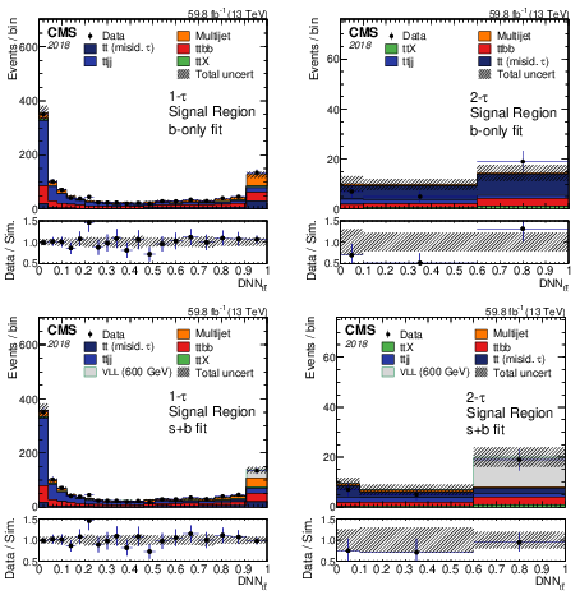
png pdf |
Figure 52:
Postfit distributions for the 2018 data set in the 1$ \tau_\mathrm{h} $ (left) and 2$ \tau_\mathrm{h} $ (right) channels. The upper row shows the background-only fit and the lower row shows the fit including the signal. Not shown here, but included in the fit, are the 2017 data and the 0$ \tau_\mathrm{h} $ channel. Figures taken from Ref. [205]. |
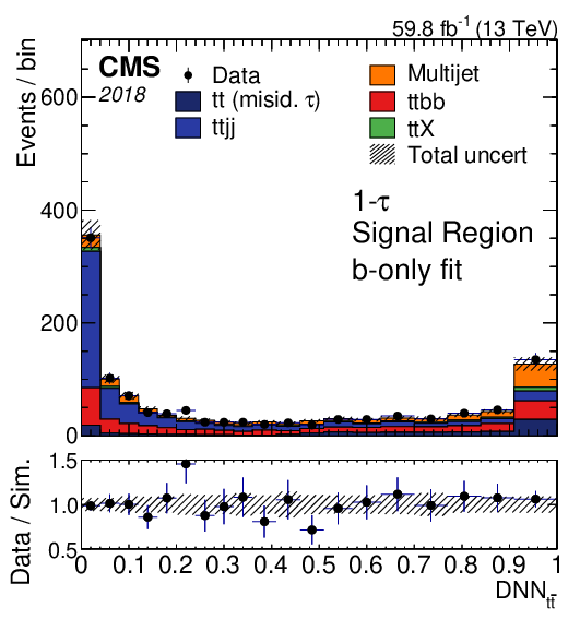
png pdf |
Figure 52-a:
Postfit distributions for the 2018 data set in the 1$ \tau_\mathrm{h} $ (left) and 2$ \tau_\mathrm{h} $ (right) channels. The upper row shows the background-only fit and the lower row shows the fit including the signal. Not shown here, but included in the fit, are the 2017 data and the 0$ \tau_\mathrm{h} $ channel. Figures taken from Ref. [205]. |
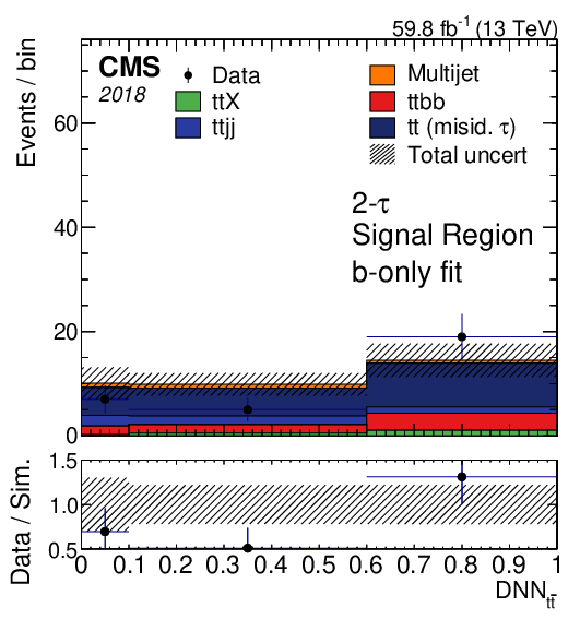
png pdf |
Figure 52-b:
Postfit distributions for the 2018 data set in the 1$ \tau_\mathrm{h} $ (left) and 2$ \tau_\mathrm{h} $ (right) channels. The upper row shows the background-only fit and the lower row shows the fit including the signal. Not shown here, but included in the fit, are the 2017 data and the 0$ \tau_\mathrm{h} $ channel. Figures taken from Ref. [205]. |
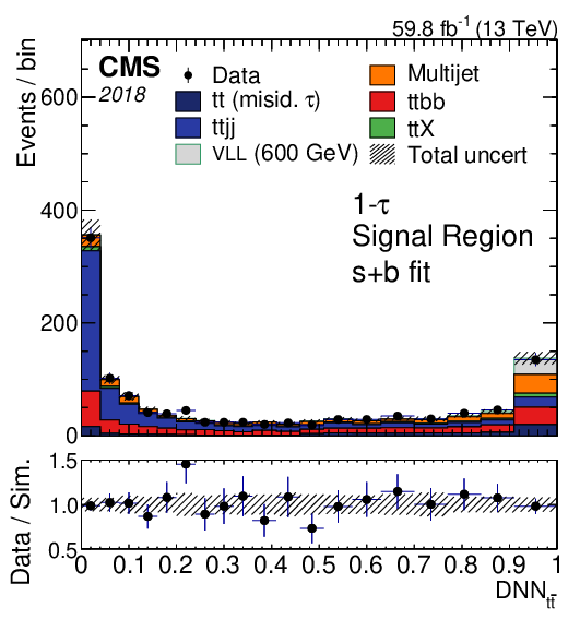
png pdf |
Figure 52-c:
Postfit distributions for the 2018 data set in the 1$ \tau_\mathrm{h} $ (left) and 2$ \tau_\mathrm{h} $ (right) channels. The upper row shows the background-only fit and the lower row shows the fit including the signal. Not shown here, but included in the fit, are the 2017 data and the 0$ \tau_\mathrm{h} $ channel. Figures taken from Ref. [205]. |
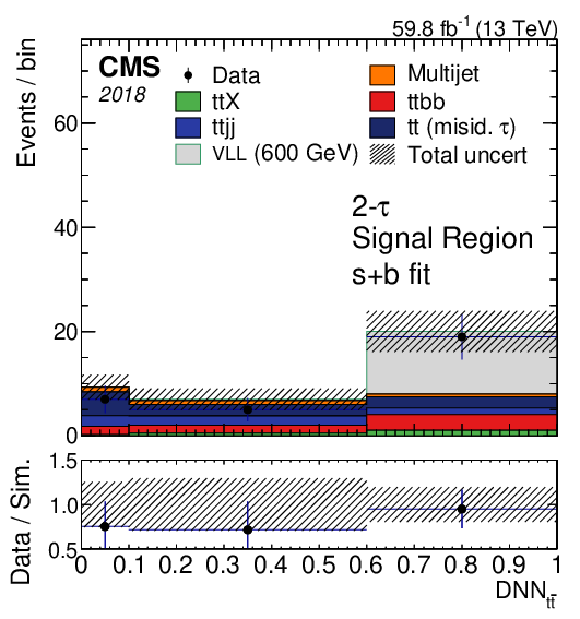
png pdf |
Figure 52-d:
Postfit distributions for the 2018 data set in the 1$ \tau_\mathrm{h} $ (left) and 2$ \tau_\mathrm{h} $ (right) channels. The upper row shows the background-only fit and the lower row shows the fit including the signal. Not shown here, but included in the fit, are the 2017 data and the 0$ \tau_\mathrm{h} $ channel. Figures taken from Ref. [205]. |
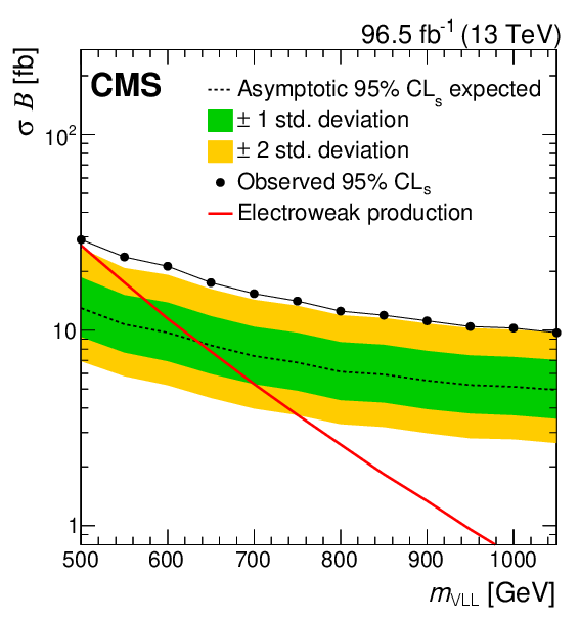
png pdf |
Figure 53:
Expected and observed 95% CL upper limits on the product of the VLL pair production cross section and the branching fraction to third-generation quarks and leptons, combining the 2017 and 2018 data and all $ \tau_\mathrm{h} $ multiplicity channels. The theoretical prediction in the 4321 model for EW production of VLLs is also shown. Figure adapted from Ref. [205]. |
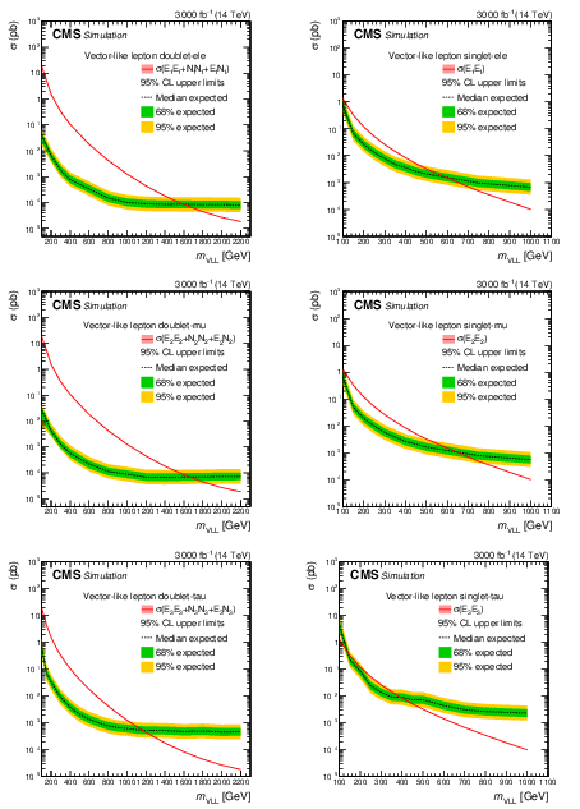
png pdf |
Figure 54:
Expected HL-LHC exclusion limits for vector-like leptons coupled to first-generation (upper row), second-generation (middle row), and third-generation SM leptons (lower row) in the doublet model (left) and the singlet model (right). For both models, limits are calculated using $ L_{\mathrm{T}}+p_{\mathrm{T}}^\text{miss} $ from the model independent SRs for all masses. |
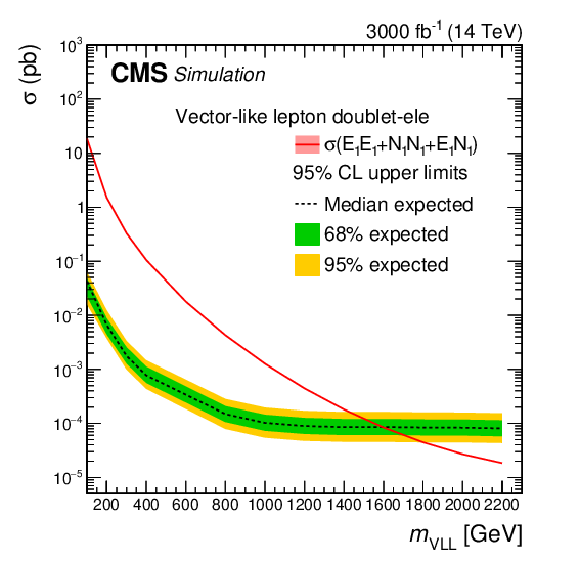
png pdf |
Figure 54-a:
Expected HL-LHC exclusion limits for vector-like leptons coupled to first-generation (upper row), second-generation (middle row), and third-generation SM leptons (lower row) in the doublet model (left) and the singlet model (right). For both models, limits are calculated using $ L_{\mathrm{T}}+p_{\mathrm{T}}^\text{miss} $ from the model independent SRs for all masses. |
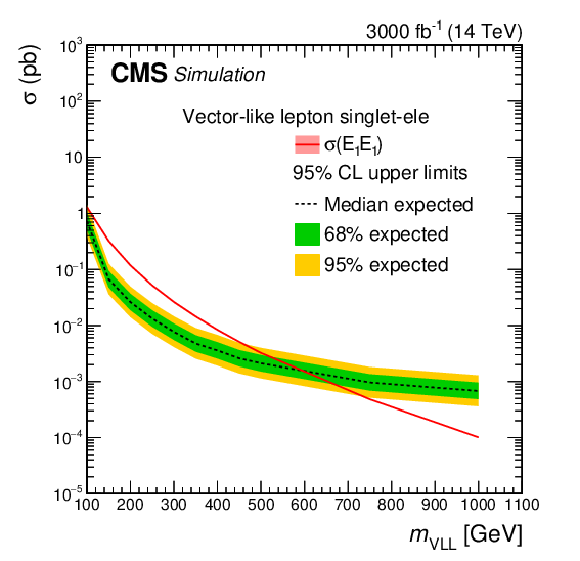
png pdf |
Figure 54-b:
Expected HL-LHC exclusion limits for vector-like leptons coupled to first-generation (upper row), second-generation (middle row), and third-generation SM leptons (lower row) in the doublet model (left) and the singlet model (right). For both models, limits are calculated using $ L_{\mathrm{T}}+p_{\mathrm{T}}^\text{miss} $ from the model independent SRs for all masses. |
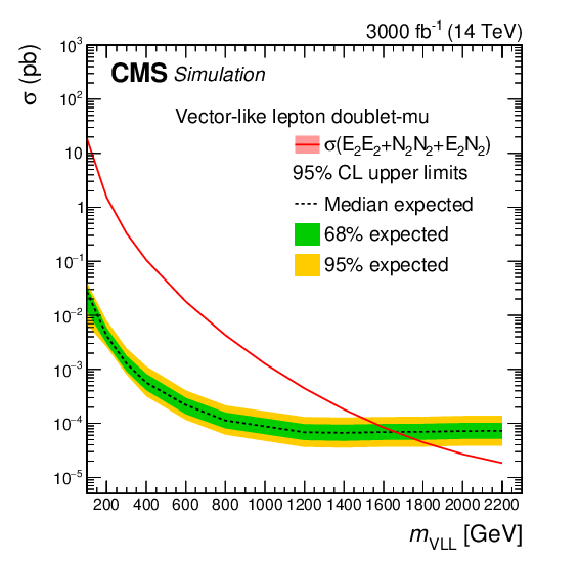
png pdf |
Figure 54-c:
Expected HL-LHC exclusion limits for vector-like leptons coupled to first-generation (upper row), second-generation (middle row), and third-generation SM leptons (lower row) in the doublet model (left) and the singlet model (right). For both models, limits are calculated using $ L_{\mathrm{T}}+p_{\mathrm{T}}^\text{miss} $ from the model independent SRs for all masses. |
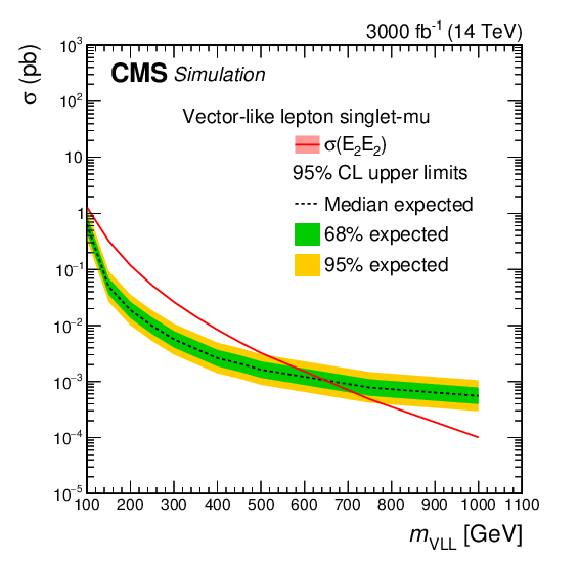
png pdf |
Figure 54-d:
Expected HL-LHC exclusion limits for vector-like leptons coupled to first-generation (upper row), second-generation (middle row), and third-generation SM leptons (lower row) in the doublet model (left) and the singlet model (right). For both models, limits are calculated using $ L_{\mathrm{T}}+p_{\mathrm{T}}^\text{miss} $ from the model independent SRs for all masses. |
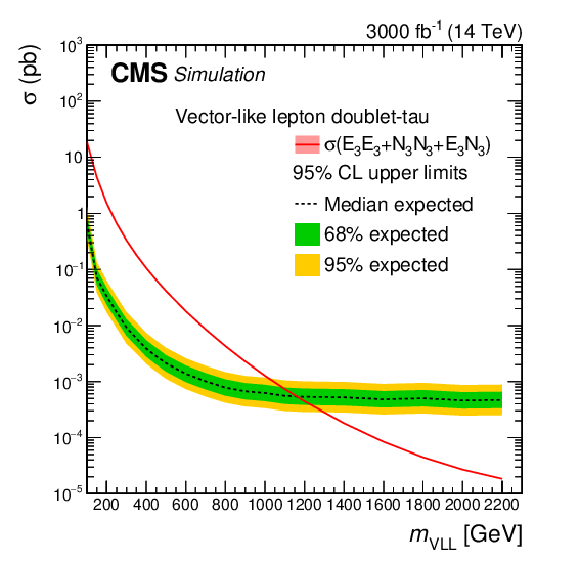
png pdf |
Figure 54-e:
Expected HL-LHC exclusion limits for vector-like leptons coupled to first-generation (upper row), second-generation (middle row), and third-generation SM leptons (lower row) in the doublet model (left) and the singlet model (right). For both models, limits are calculated using $ L_{\mathrm{T}}+p_{\mathrm{T}}^\text{miss} $ from the model independent SRs for all masses. |

png pdf |
Figure 54-f:
Expected HL-LHC exclusion limits for vector-like leptons coupled to first-generation (upper row), second-generation (middle row), and third-generation SM leptons (lower row) in the doublet model (left) and the singlet model (right). For both models, limits are calculated using $ L_{\mathrm{T}}+p_{\mathrm{T}}^\text{miss} $ from the model independent SRs for all masses. |
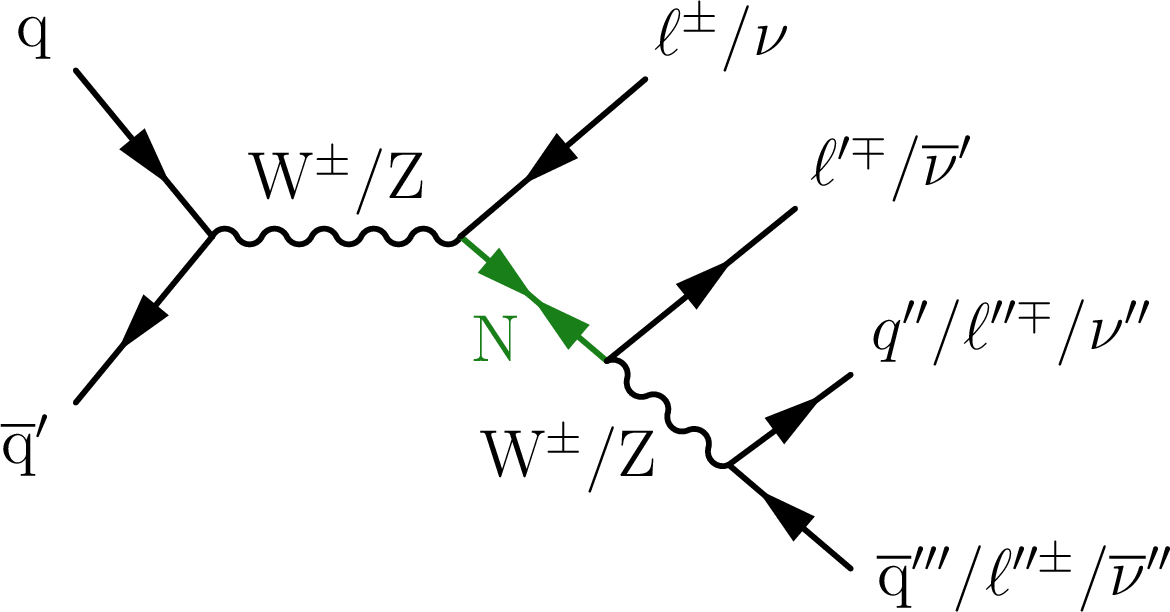
png pdf |
Figure 55:
Representative Feynman diagram of a Majorana HNL, labeled as $ \mathrm{N} $, produced through the decay of a W or Z boson. |
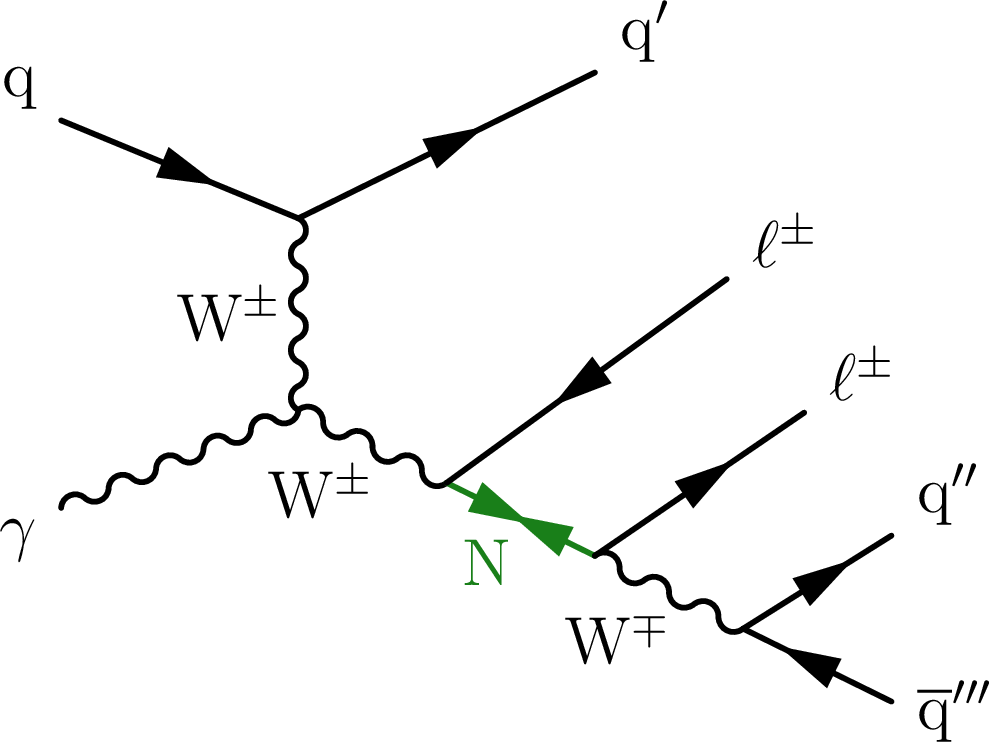
png pdf |
Figure 56:
Representative Feynman diagram of a Majorana HNL, labeled as $ \mathrm{N} $, produced through the $ \mathrm{W}\gamma $ fusion process and with two charged leptons and jets in the final state. |
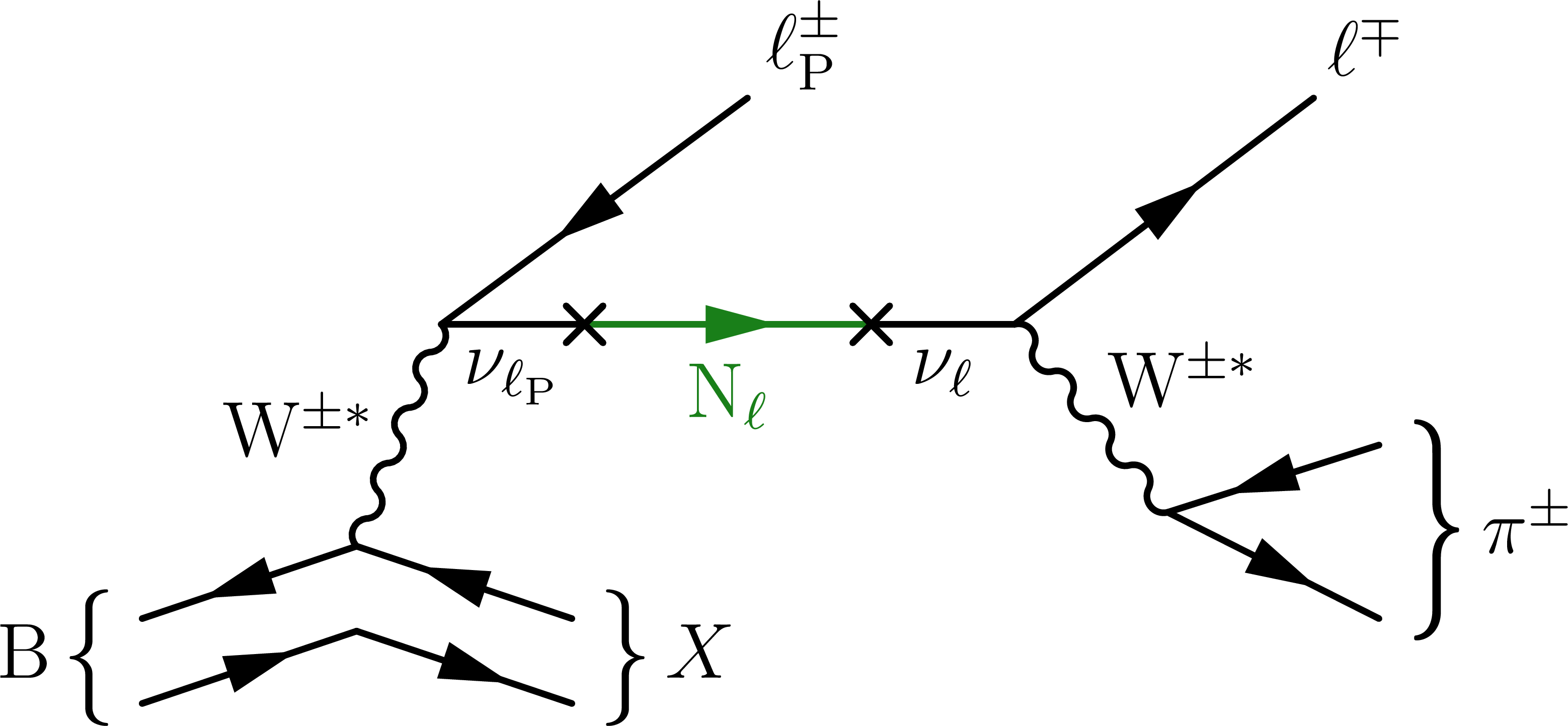
png pdf |
Figure 57:
Representative Feynman diagram showing the semileptonic decay of a $ {\mathrm{B}} $ meson into the primary lepton ($\ell_{\mathrm{P}}$), a hadronic system ($ \mathrm{X} $), and a neutrino, which contains the admixture of an HNL. The HNL propagates and decays weakly into a charged lepton $\ell^{\pm}$ and a charged pion $ \pi^{\mp} $. |
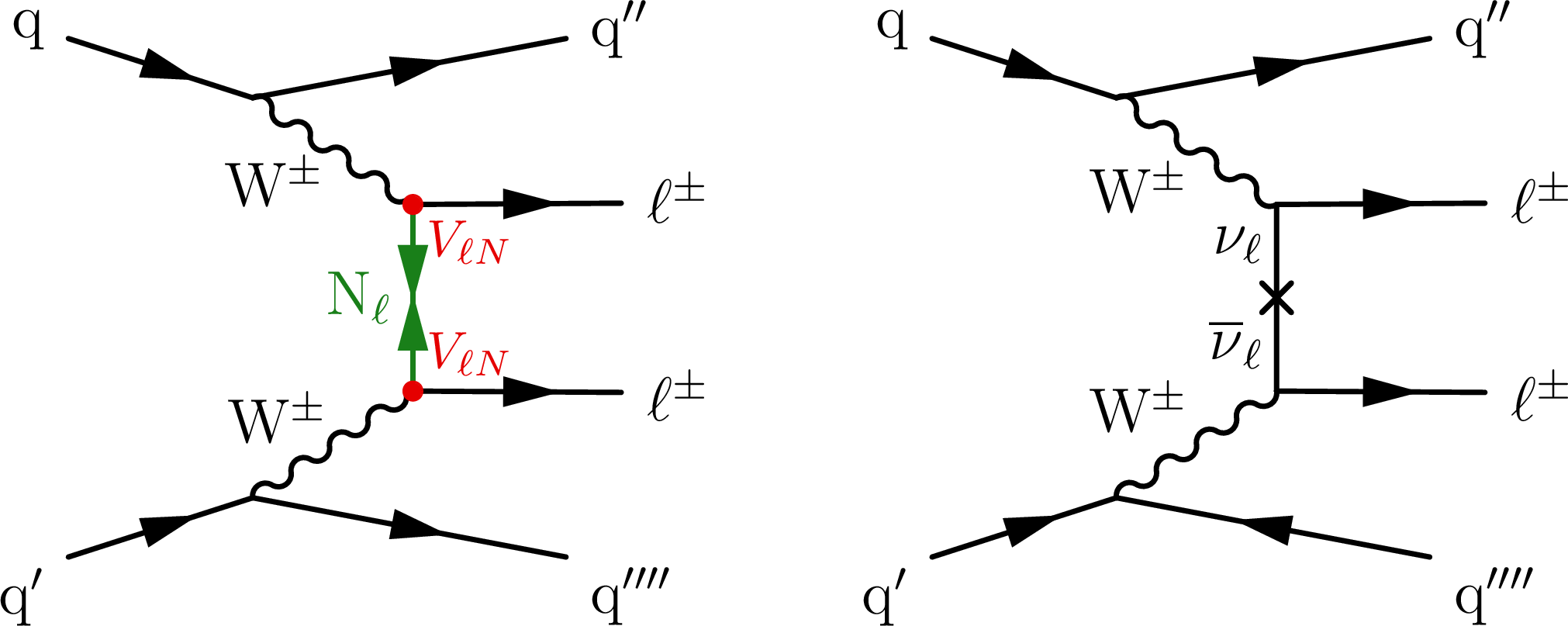
png pdf |
Figure 58:
Example Feynman diagrams of VBF processes with heavy Majorana neutrino production (left) and processes mediated by the Weinberg operator (right). |
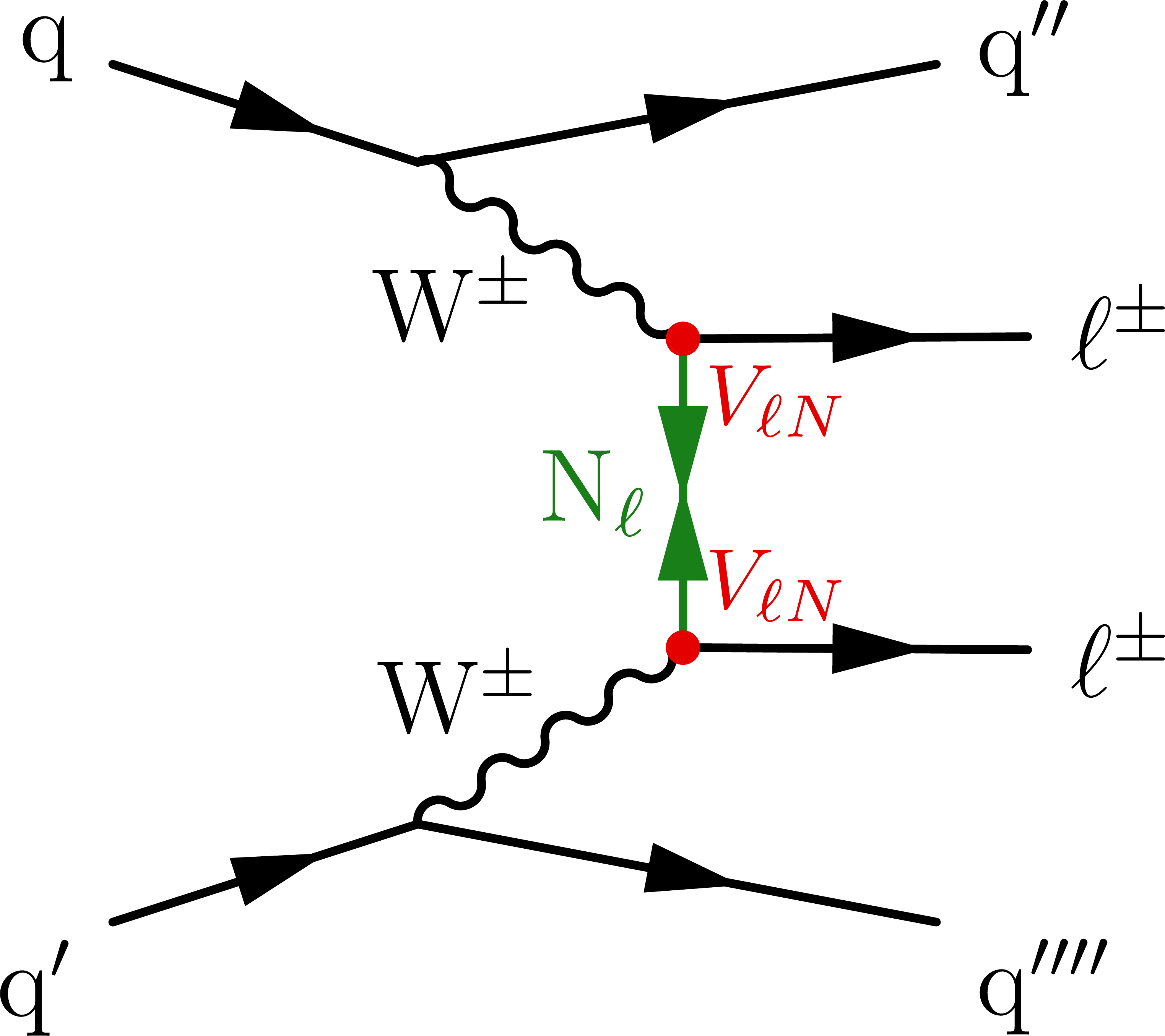
png pdf |
Figure 58-a:
Example Feynman diagrams of VBF processes with heavy Majorana neutrino production (left) and processes mediated by the Weinberg operator (right). |
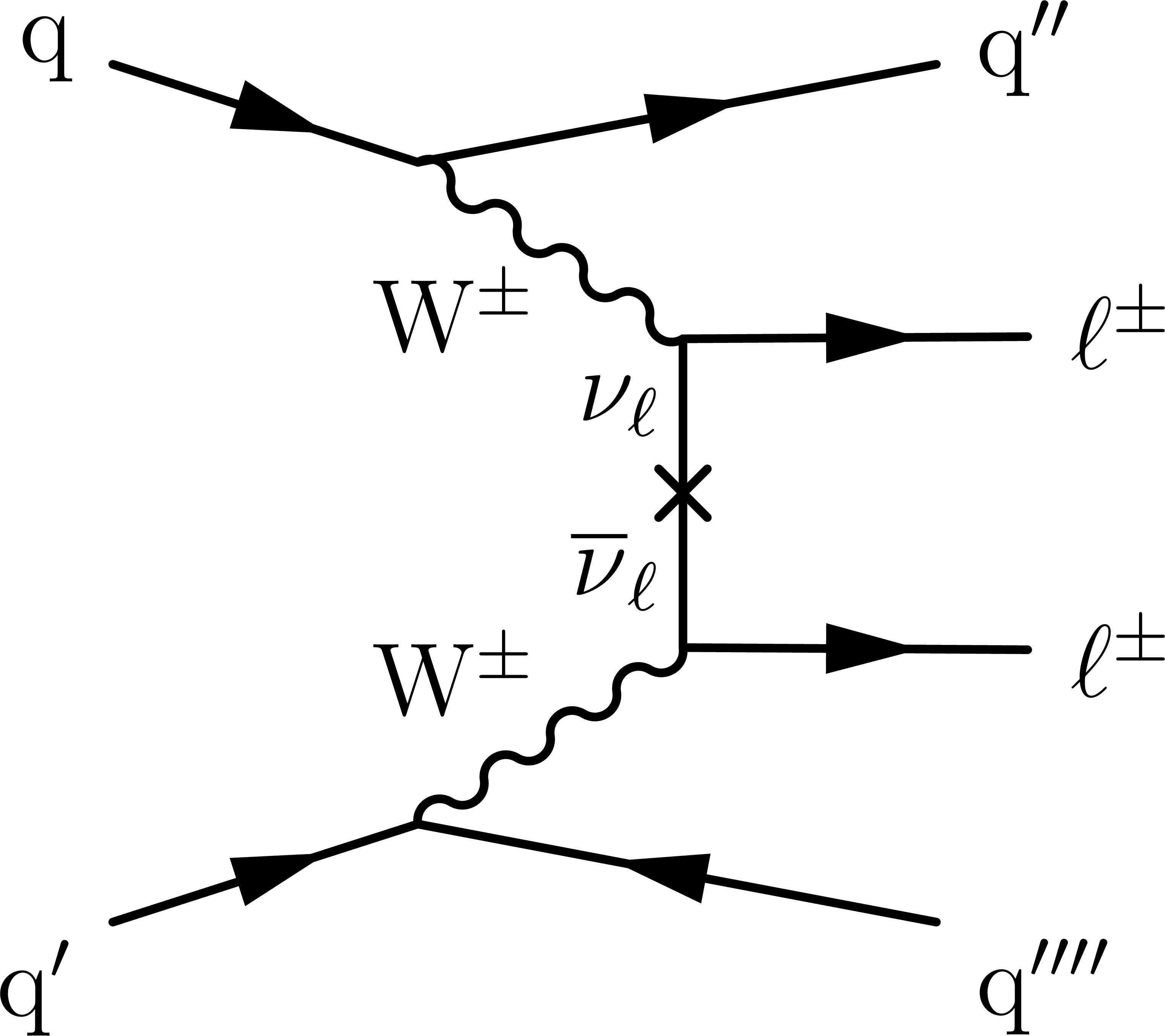
png pdf |
Figure 58-b:
Example Feynman diagrams of VBF processes with heavy Majorana neutrino production (left) and processes mediated by the Weinberg operator (right). |
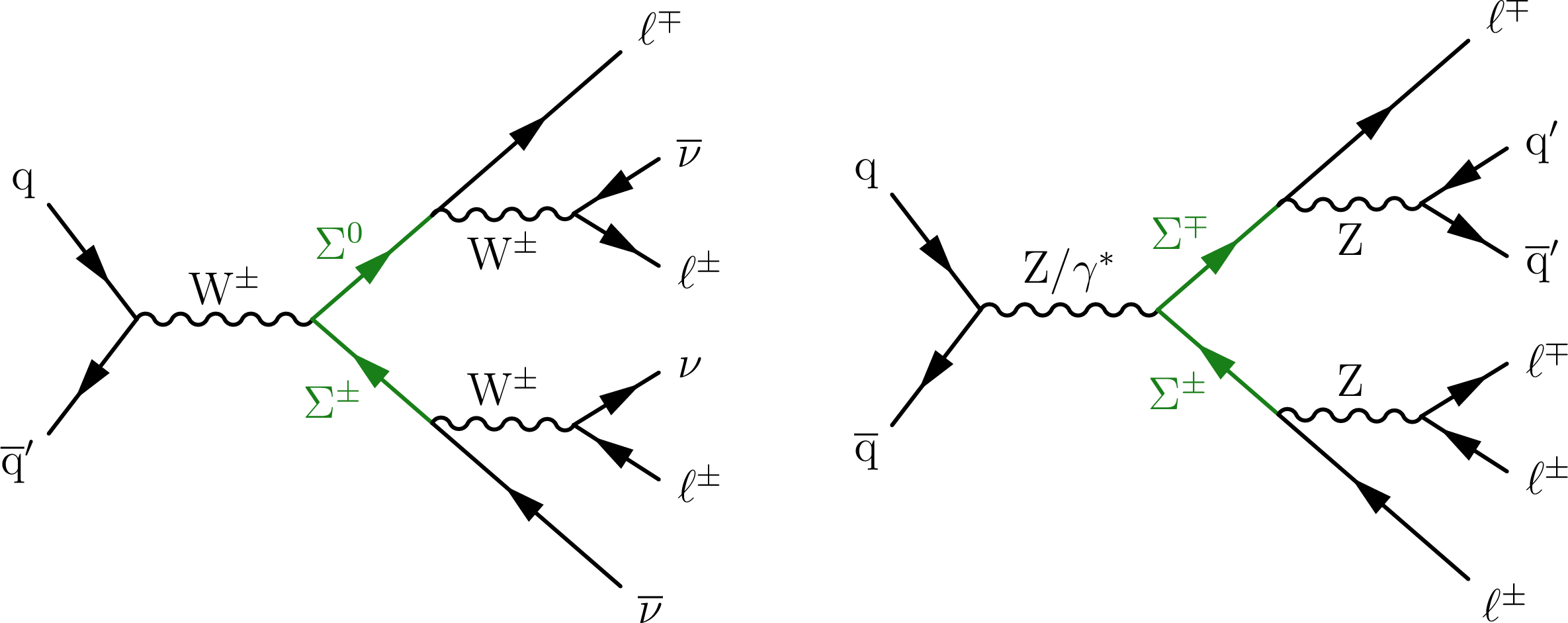
png pdf |
Figure 59:
Example Feynman diagrams illustrating production and decay of $Type III$ seesaw heavy lepton $ \Sigma $ pairs at the LHC that may result in multilepton final states. |
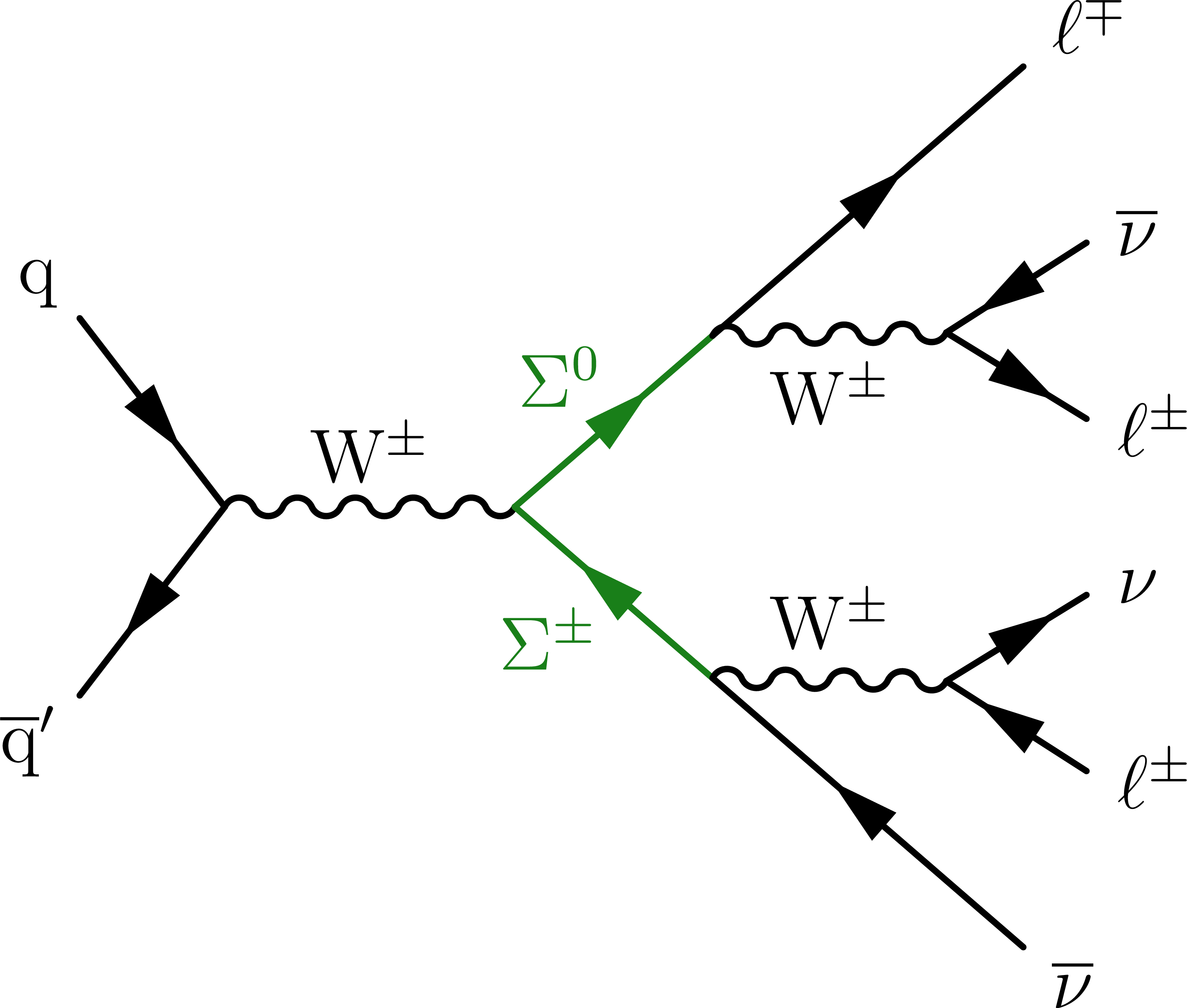
png pdf |
Figure 59-a:
Example Feynman diagrams illustrating production and decay of $Type III$ seesaw heavy lepton $ \Sigma $ pairs at the LHC that may result in multilepton final states. |
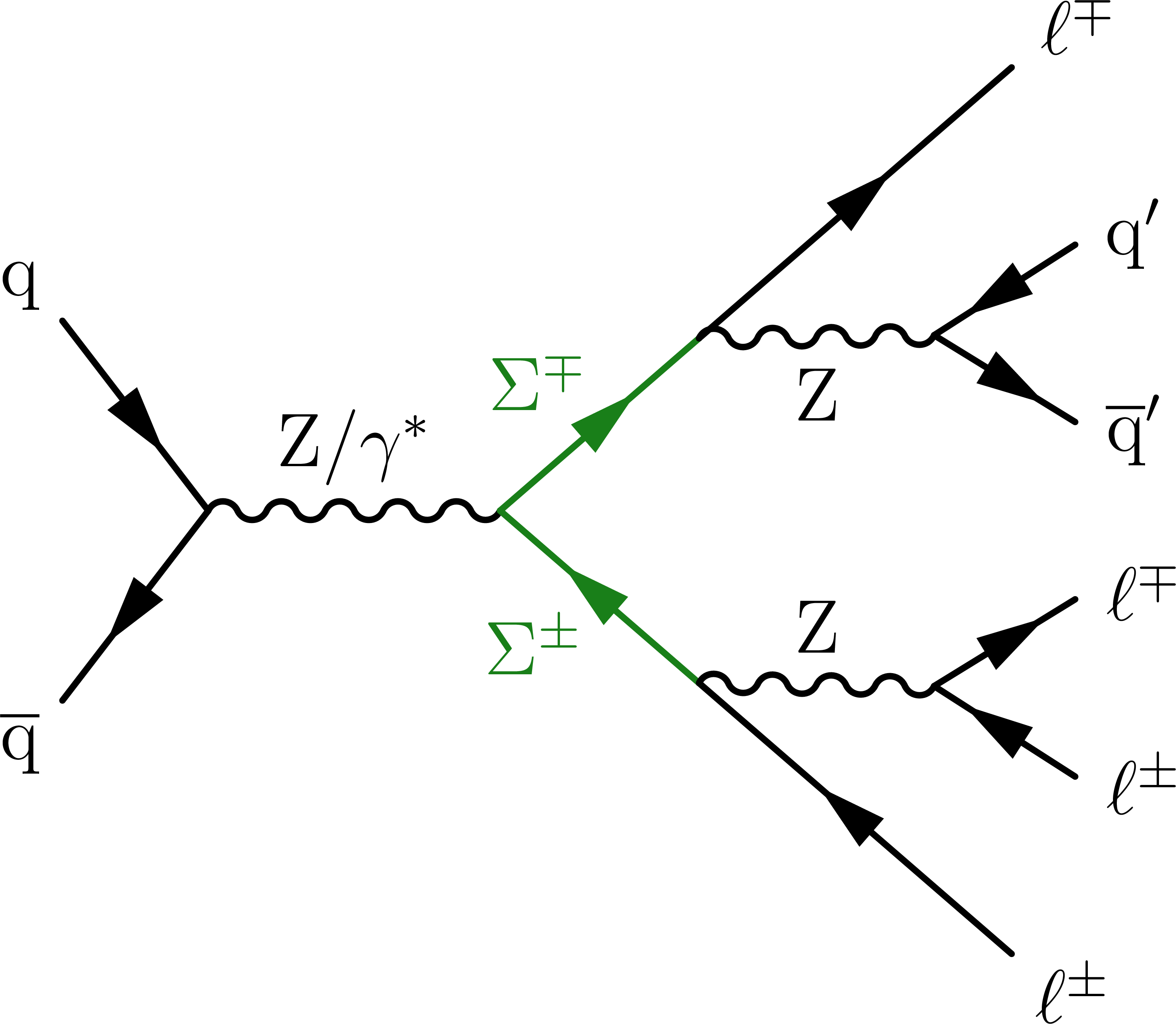
png pdf |
Figure 59-b:
Example Feynman diagrams illustrating production and decay of $Type III$ seesaw heavy lepton $ \Sigma $ pairs at the LHC that may result in multilepton final states. |
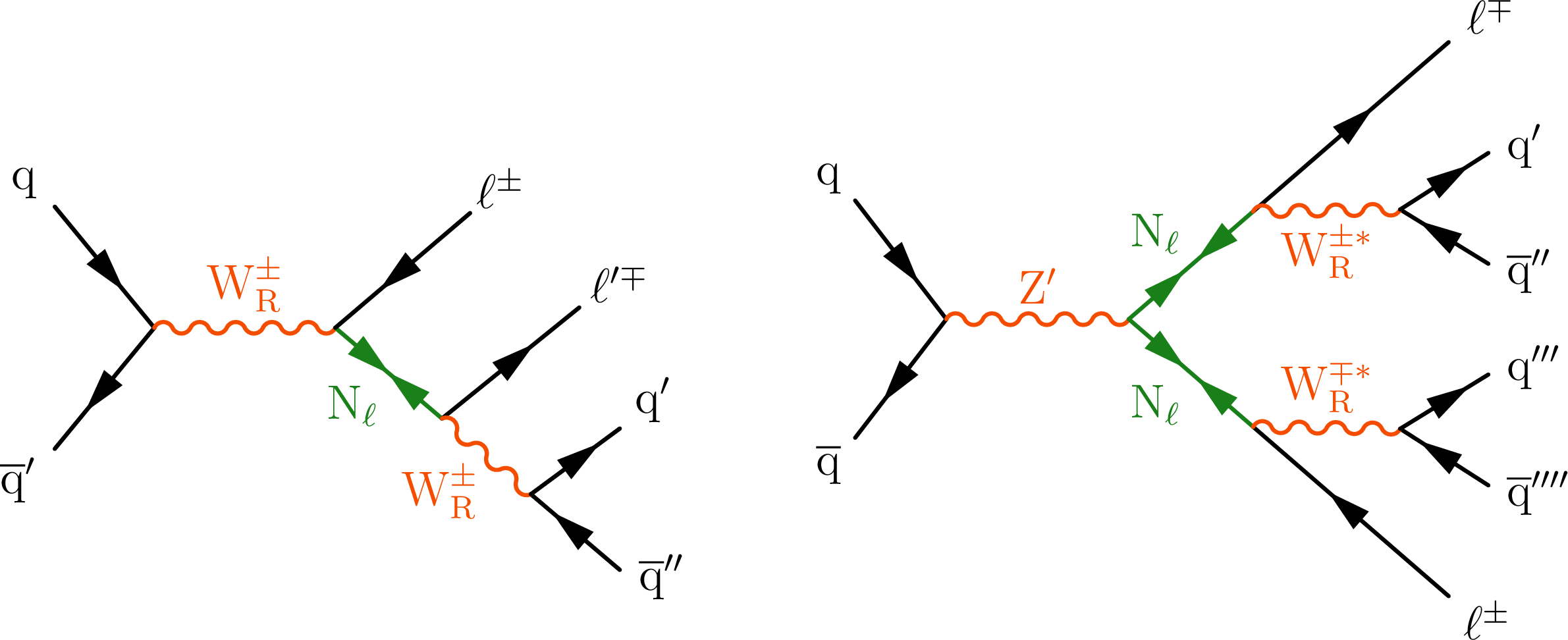
png pdf |
Figure 60:
Representative Feynman diagrams for the production of a heavy Majorana neutrino, labeled as $ \mathrm{N} \ell$, via the decay of a $ \mathrm{W_R} $ (left) and $ \mathrm{Z}^{'} $ boson (right). |
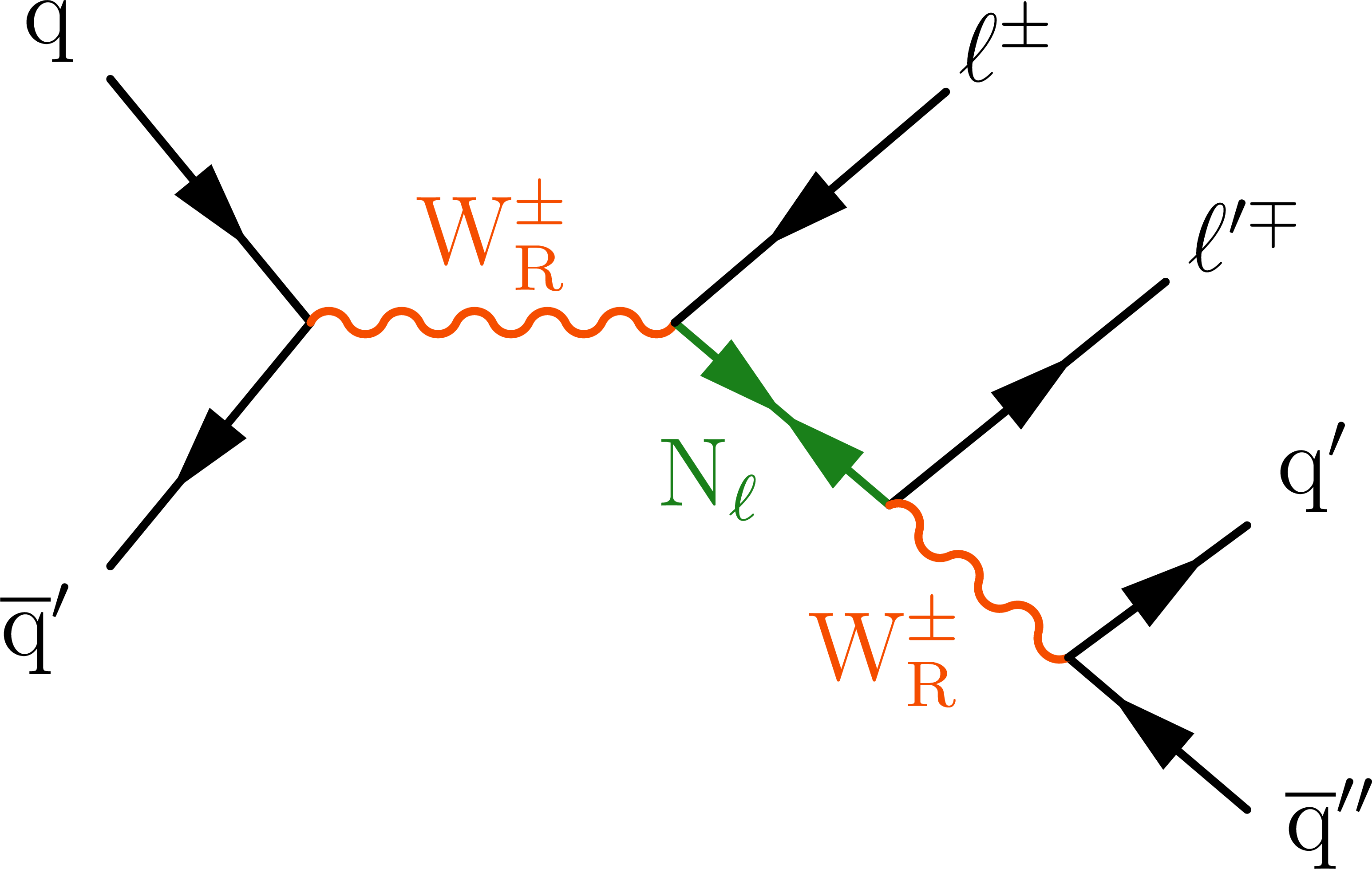
png pdf |
Figure 60-a:
Representative Feynman diagrams for the production of a heavy Majorana neutrino, labeled as $ \mathrm{N} \ell$, via the decay of a $ \mathrm{W_R} $ (left) and $ \mathrm{Z}^{'} $ boson (right). |
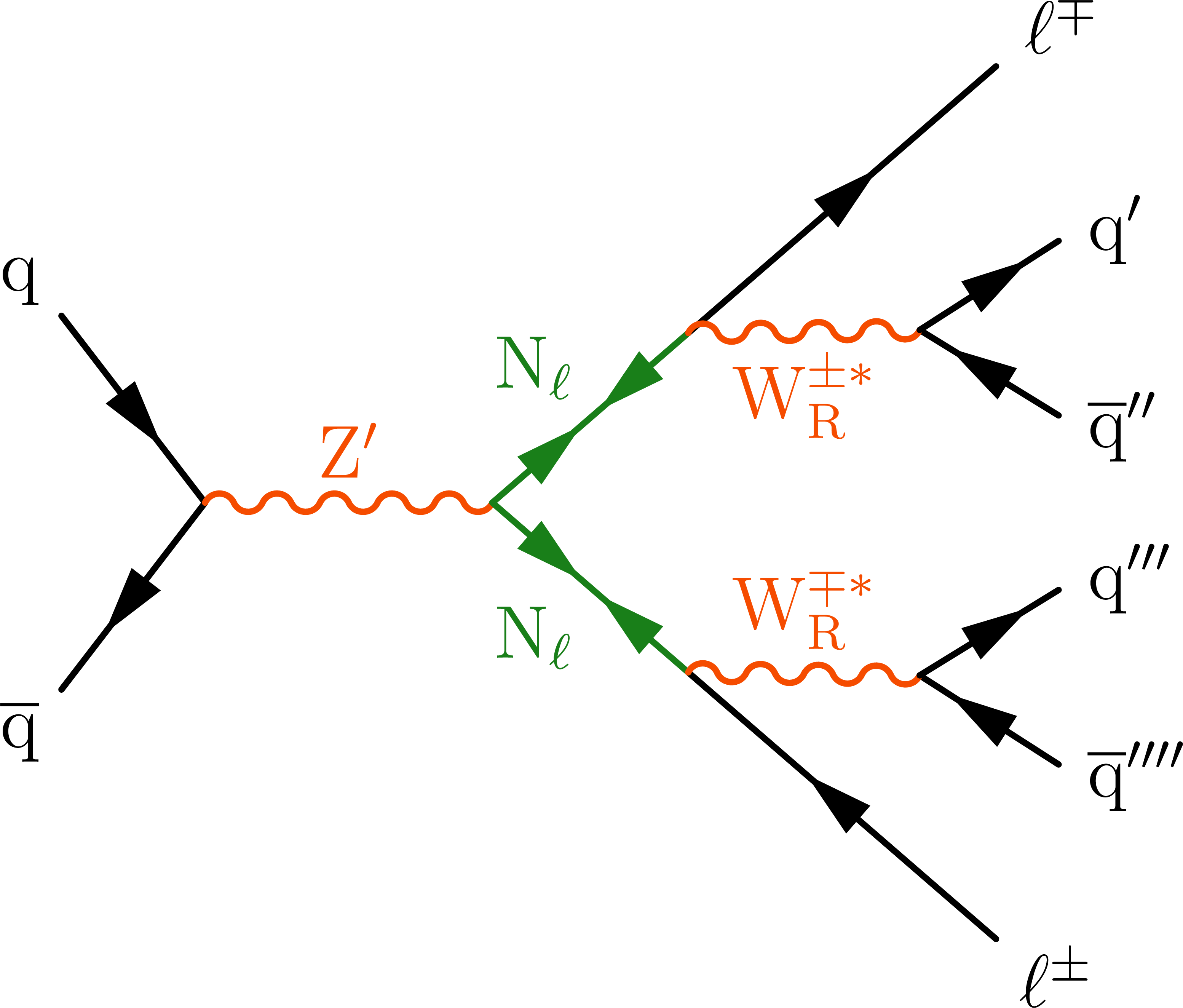
png pdf |
Figure 60-b:
Representative Feynman diagrams for the production of a heavy Majorana neutrino, labeled as $ \mathrm{N} \ell$, via the decay of a $ \mathrm{W_R} $ (left) and $ \mathrm{Z}^{'} $ boson (right). |

png pdf |
Figure 61:
The fermion interaction as a sum of gauge (center) and contact (right) interaction contributions. |

png pdf |
Figure 62:
Example diagrams for the decay of a heavy composite Majorana neutrino to $ \ell\mathrm{q}{\overline{\mathrm{q}}{\prime}} $. |
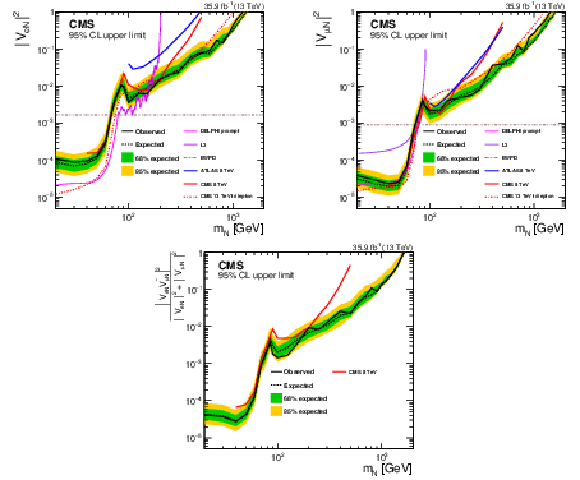
png pdf |
Figure 63:
Expected (observed) upper limits at 95% CL shown with a dashed (solid) black line, derived on heavy neutrino mixing parameters $ |V_{\mathrm{eN}}|^{2} $, $ |V_{\mathrm{\mu N}}|^{2} $, and $ | V_{\mathrm{eN}}V_{\mathrm{\mu N}}^\ast|^2/(|V_{\mathrm{eN}}|^2+|V_{\mathrm{\mu N}}|^2) $ as functions of the HNL mass. The dashed brown line in the upper two figures shows constraints from Electroweak Precision Data (EWPD) [254] on the $ |V_{\mathrm{eN}}|^{2} $ and $ |V_{\mathrm{\mu N}}|^{2} $ parameters. The lower figure, reproduced from Ref. [252], does not show the corresponding EWPD limits. The upper limits from other direct searches at the DELPHI experiment [255], the L3 experiment [256,257], and the ATLAS experiment [258] are superimposed. Also shown are the upper limits from the CMS experiment at $ \sqrt{s}= $ 8 TeV using the 2012 data set [253] with a solid red line, and the search in the trilepton final state [259] based on the same 2016 data set as used in this analysis with a dashed red line. Figures adapted from Ref. [252]. |
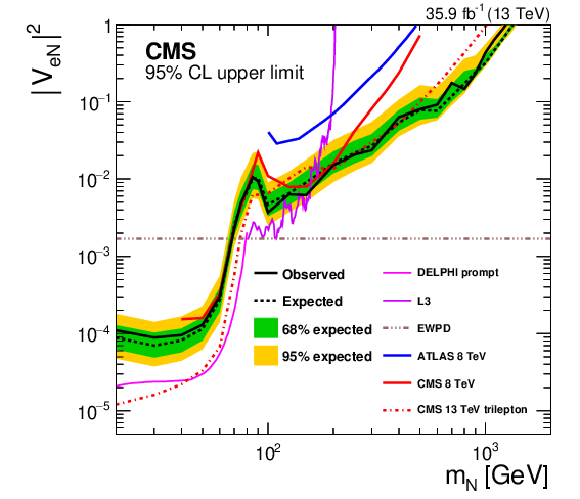
png pdf |
Figure 63-a:
Expected (observed) upper limits at 95% CL shown with a dashed (solid) black line, derived on heavy neutrino mixing parameters $ |V_{\mathrm{eN}}|^{2} $, $ |V_{\mathrm{\mu N}}|^{2} $, and $ | V_{\mathrm{eN}}V_{\mathrm{\mu N}}^\ast|^2/(|V_{\mathrm{eN}}|^2+|V_{\mathrm{\mu N}}|^2) $ as functions of the HNL mass. The dashed brown line in the upper two figures shows constraints from Electroweak Precision Data (EWPD) [254] on the $ |V_{\mathrm{eN}}|^{2} $ and $ |V_{\mathrm{\mu N}}|^{2} $ parameters. The lower figure, reproduced from Ref. [252], does not show the corresponding EWPD limits. The upper limits from other direct searches at the DELPHI experiment [255], the L3 experiment [256,257], and the ATLAS experiment [258] are superimposed. Also shown are the upper limits from the CMS experiment at $ \sqrt{s}= $ 8 TeV using the 2012 data set [253] with a solid red line, and the search in the trilepton final state [259] based on the same 2016 data set as used in this analysis with a dashed red line. Figures adapted from Ref. [252]. |
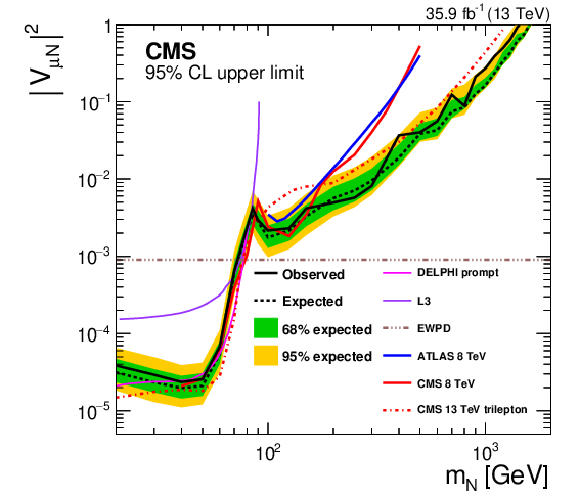
png pdf |
Figure 63-b:
Expected (observed) upper limits at 95% CL shown with a dashed (solid) black line, derived on heavy neutrino mixing parameters $ |V_{\mathrm{eN}}|^{2} $, $ |V_{\mathrm{\mu N}}|^{2} $, and $ | V_{\mathrm{eN}}V_{\mathrm{\mu N}}^\ast|^2/(|V_{\mathrm{eN}}|^2+|V_{\mathrm{\mu N}}|^2) $ as functions of the HNL mass. The dashed brown line in the upper two figures shows constraints from Electroweak Precision Data (EWPD) [254] on the $ |V_{\mathrm{eN}}|^{2} $ and $ |V_{\mathrm{\mu N}}|^{2} $ parameters. The lower figure, reproduced from Ref. [252], does not show the corresponding EWPD limits. The upper limits from other direct searches at the DELPHI experiment [255], the L3 experiment [256,257], and the ATLAS experiment [258] are superimposed. Also shown are the upper limits from the CMS experiment at $ \sqrt{s}= $ 8 TeV using the 2012 data set [253] with a solid red line, and the search in the trilepton final state [259] based on the same 2016 data set as used in this analysis with a dashed red line. Figures adapted from Ref. [252]. |
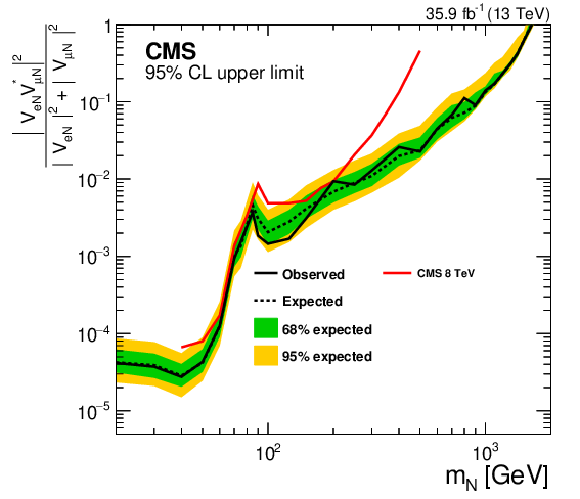
png pdf |
Figure 63-c:
Expected (observed) upper limits at 95% CL shown with a dashed (solid) black line, derived on heavy neutrino mixing parameters $ |V_{\mathrm{eN}}|^{2} $, $ |V_{\mathrm{\mu N}}|^{2} $, and $ | V_{\mathrm{eN}}V_{\mathrm{\mu N}}^\ast|^2/(|V_{\mathrm{eN}}|^2+|V_{\mathrm{\mu N}}|^2) $ as functions of the HNL mass. The dashed brown line in the upper two figures shows constraints from Electroweak Precision Data (EWPD) [254] on the $ |V_{\mathrm{eN}}|^{2} $ and $ |V_{\mathrm{\mu N}}|^{2} $ parameters. The lower figure, reproduced from Ref. [252], does not show the corresponding EWPD limits. The upper limits from other direct searches at the DELPHI experiment [255], the L3 experiment [256,257], and the ATLAS experiment [258] are superimposed. Also shown are the upper limits from the CMS experiment at $ \sqrt{s}= $ 8 TeV using the 2012 data set [253] with a solid red line, and the search in the trilepton final state [259] based on the same 2016 data set as used in this analysis with a dashed red line. Figures adapted from Ref. [252]. |
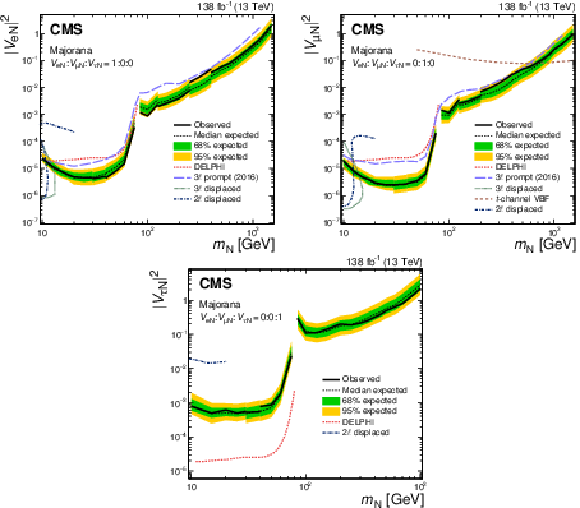
png pdf |
Figure 64:
Expected (observed) upper limits at 95% CL derived on heavy neutrino mixing parameters $ |V_{\mathrm{eN}}|^{2} $, $ |V_{\mathrm{\mu N}}|^{2} $, and \mixparsq$ \tau \mathrm{N} $ as functions of the HNL mass $ m_{\mathrm{N}} $. No exclusion limit is evaluated for the range 75 $ < m_{\mathrm{N}} < $ 85 GeV, where HNL production through W boson decays has a resonance and the analysis strategy changes from using the low- or high-mass region. The area above the solid (dashed) black curve indicates the observed (expected) exclusion region. The upper limits from other direct searches at the DELPHI experiment [255] and the CMS experiment [259,261,262,263] are superimposed. Figures taken from Ref. [260]. |
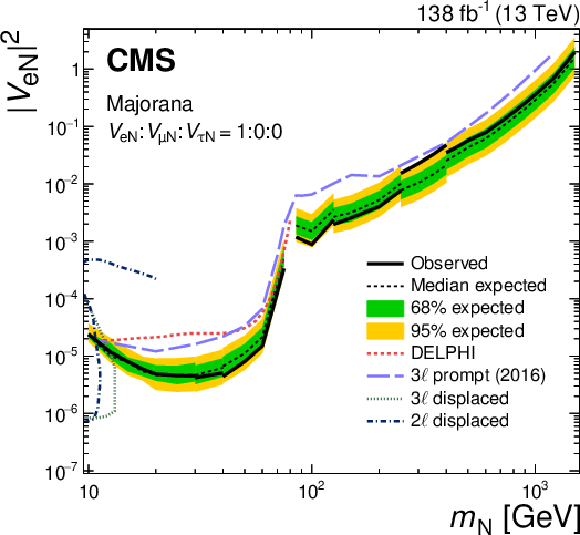
png pdf |
Figure 64-a:
Expected (observed) upper limits at 95% CL derived on heavy neutrino mixing parameters $ |V_{\mathrm{eN}}|^{2} $, $ |V_{\mathrm{\mu N}}|^{2} $, and \mixparsq$ \tau \mathrm{N} $ as functions of the HNL mass $ m_{\mathrm{N}} $. No exclusion limit is evaluated for the range 75 $ < m_{\mathrm{N}} < $ 85 GeV, where HNL production through W boson decays has a resonance and the analysis strategy changes from using the low- or high-mass region. The area above the solid (dashed) black curve indicates the observed (expected) exclusion region. The upper limits from other direct searches at the DELPHI experiment [255] and the CMS experiment [259,261,262,263] are superimposed. Figures taken from Ref. [260]. |
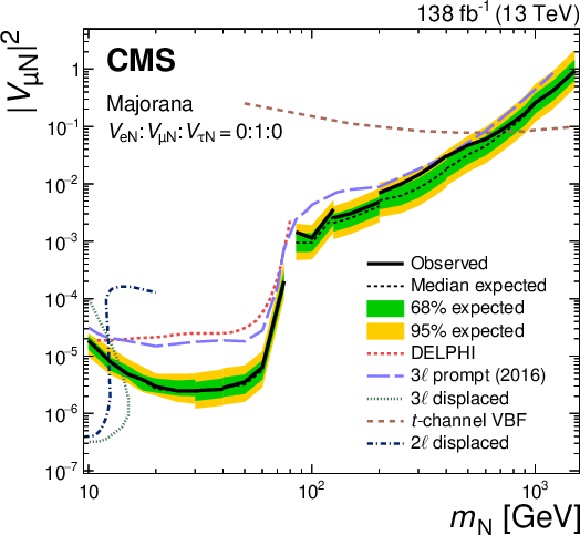
png pdf |
Figure 64-b:
Expected (observed) upper limits at 95% CL derived on heavy neutrino mixing parameters $ |V_{\mathrm{eN}}|^{2} $, $ |V_{\mathrm{\mu N}}|^{2} $, and \mixparsq$ \tau \mathrm{N} $ as functions of the HNL mass $ m_{\mathrm{N}} $. No exclusion limit is evaluated for the range 75 $ < m_{\mathrm{N}} < $ 85 GeV, where HNL production through W boson decays has a resonance and the analysis strategy changes from using the low- or high-mass region. The area above the solid (dashed) black curve indicates the observed (expected) exclusion region. The upper limits from other direct searches at the DELPHI experiment [255] and the CMS experiment [259,261,262,263] are superimposed. Figures taken from Ref. [260]. |
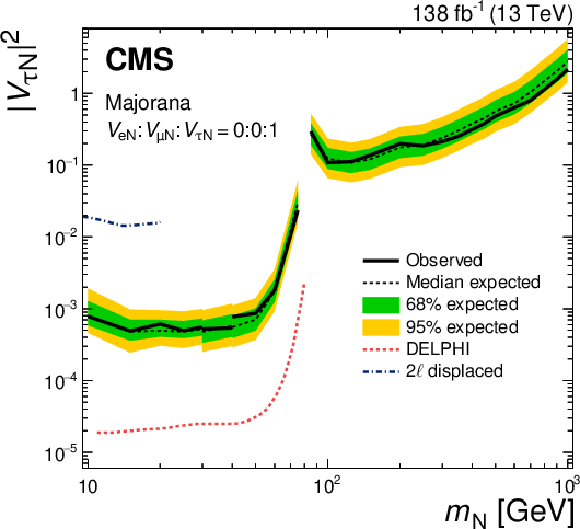
png pdf |
Figure 64-c:
Expected (observed) upper limits at 95% CL derived on heavy neutrino mixing parameters $ |V_{\mathrm{eN}}|^{2} $, $ |V_{\mathrm{\mu N}}|^{2} $, and \mixparsq$ \tau \mathrm{N} $ as functions of the HNL mass $ m_{\mathrm{N}} $. No exclusion limit is evaluated for the range 75 $ < m_{\mathrm{N}} < $ 85 GeV, where HNL production through W boson decays has a resonance and the analysis strategy changes from using the low- or high-mass region. The area above the solid (dashed) black curve indicates the observed (expected) exclusion region. The upper limits from other direct searches at the DELPHI experiment [255] and the CMS experiment [259,261,262,263] are superimposed. Figures taken from Ref. [260]. |
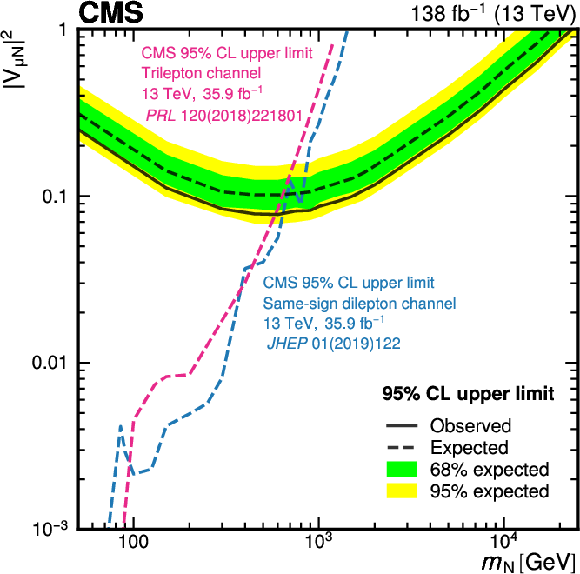
png pdf |
Figure 65:
Upper limits on $ |V_{\mathrm{\mu N}}|^{2} $ at 95% CL as a function of $ m_{\mathrm{N}} $. The black dashed curve shows the median expected upper limit, while the inner (green) band and the outer (yellow) band indicate the regions containing 68 and 95%, respectively, of the distribution of limits expected under the background-only hypothesis. The solid black curve is the observed upper limit [262]. The red dashed curve displays the observed upper limits from Ref. [259], while the blue dashed curve shows the observed upper limits from Ref. [252]. Figure adapted from Ref. [262]. |
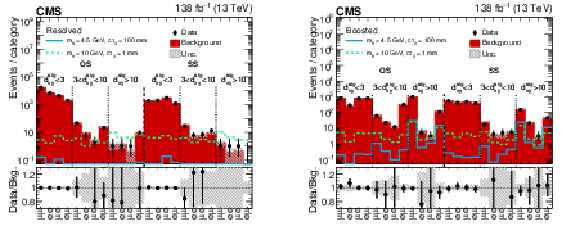
png pdf |
Figure 66:
Expected and observed background yields in 48 categories for resolved (left) and boosted (right) events. Two benchmark HNL scenarios are overlaid with masses of 4.5 and 10 GeV, and proper decay lengths of $ c\tau_{\mathrm{N}}= $ 100 and 1$ \,\text{mm} $, respectively. The $ d_{xy}^{\text{sig}} $ quantity is the significance of the impact parameter of the second lepton track. Figures taken from Ref. [263]. |
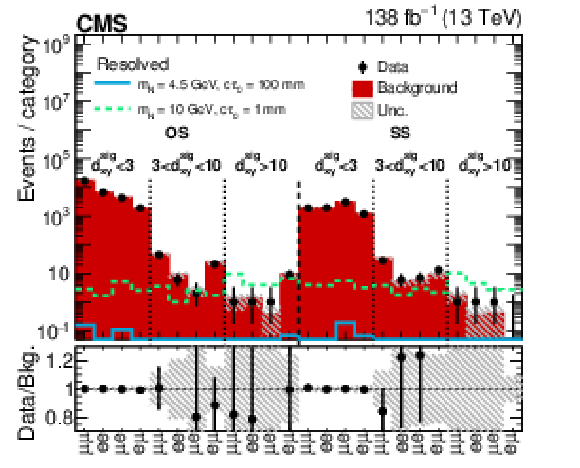
png pdf |
Figure 66-a:
Expected and observed background yields in 48 categories for resolved (left) and boosted (right) events. Two benchmark HNL scenarios are overlaid with masses of 4.5 and 10 GeV, and proper decay lengths of $ c\tau_{\mathrm{N}}= $ 100 and 1$ \,\text{mm} $, respectively. The $ d_{xy}^{\text{sig}} $ quantity is the significance of the impact parameter of the second lepton track. Figures taken from Ref. [263]. |
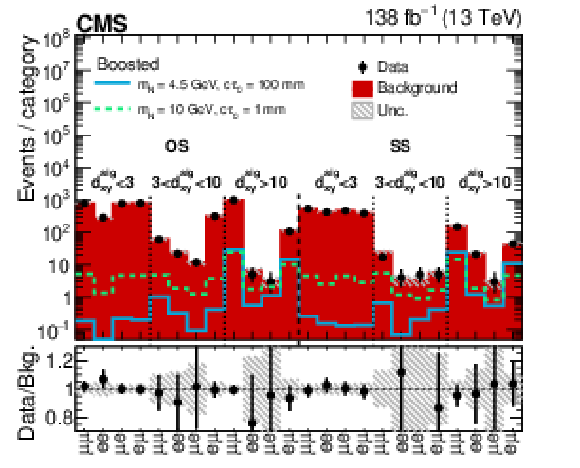
png pdf |
Figure 66-b:
Expected and observed background yields in 48 categories for resolved (left) and boosted (right) events. Two benchmark HNL scenarios are overlaid with masses of 4.5 and 10 GeV, and proper decay lengths of $ c\tau_{\mathrm{N}}= $ 100 and 1$ \,\text{mm} $, respectively. The $ d_{xy}^{\text{sig}} $ quantity is the significance of the impact parameter of the second lepton track. Figures taken from Ref. [263]. |
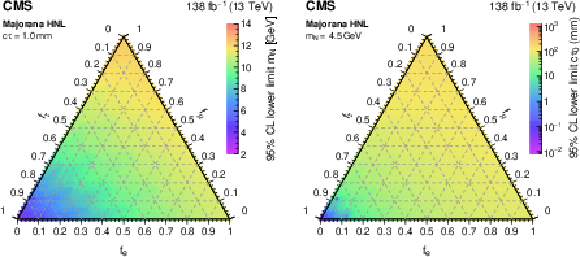
png pdf |
Figure 67:
Observed 95% CL lower limits on the mass (left) and the proper lifetime (right) for Majorana HNL production with $ c\tau_{\mathrm{N}}=1\,\text{mm} $ and $ m_{\mathrm{N}}= $ 4.5 GeV, respectively, as functions of the relative coupling strengths to electrons ($ f_{\mathrm{e}} $), muons ($ f_{\mu} $), and tau leptons ($ f_{\tau} $). Figures adapted from Ref. [263]. |
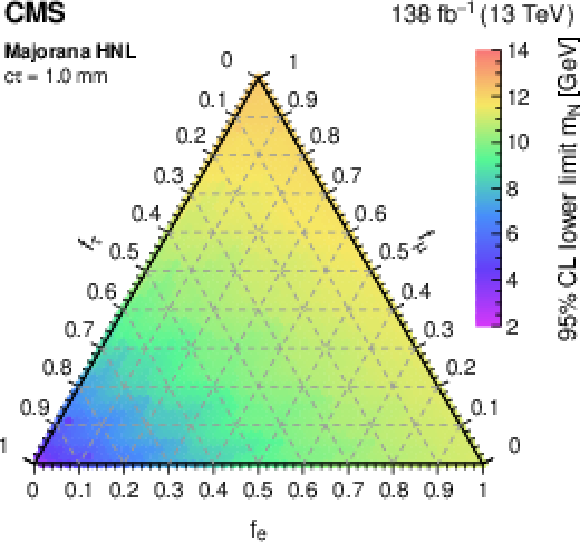
png pdf |
Figure 67-a:
Observed 95% CL lower limits on the mass (left) and the proper lifetime (right) for Majorana HNL production with $ c\tau_{\mathrm{N}}=1\,\text{mm} $ and $ m_{\mathrm{N}}= $ 4.5 GeV, respectively, as functions of the relative coupling strengths to electrons ($ f_{\mathrm{e}} $), muons ($ f_{\mu} $), and tau leptons ($ f_{\tau} $). Figures adapted from Ref. [263]. |
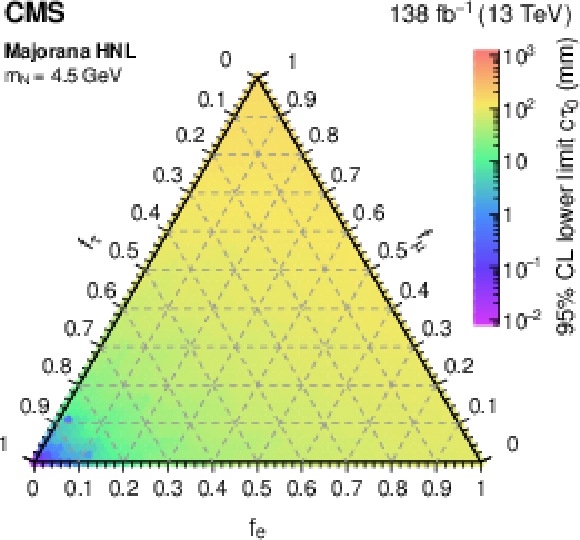
png pdf |
Figure 67-b:
Observed 95% CL lower limits on the mass (left) and the proper lifetime (right) for Majorana HNL production with $ c\tau_{\mathrm{N}}=1\,\text{mm} $ and $ m_{\mathrm{N}}= $ 4.5 GeV, respectively, as functions of the relative coupling strengths to electrons ($ f_{\mathrm{e}} $), muons ($ f_{\mu} $), and tau leptons ($ f_{\tau} $). Figures adapted from Ref. [263]. |
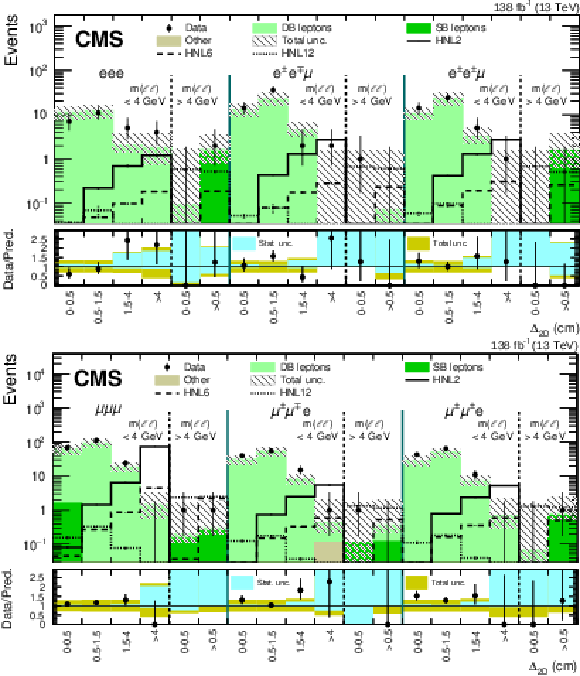
png pdf |
Figure 68:
Comparison between the number of observed events in data and the background predictions (filled histograms) in the SR for $ \mathrm{e}\mathrm{e}\mathrm{X} $ (upper) and $ \mu\mu\mathrm{X} $ (lower) final states. The hatched band indicates the total systematic and statistical uncertainty in the background prediction. The lower panels indicate the ratio between the observed data and the prediction, where missing points indicate that the ratio lies outside the axis range. Predictions for signal events are shown for several benchmark hypotheses for Majorana HNL production: $ m_{\mathrm{N}}= $ 2 GeV and $ $|V_{\mathrm{\ell N}}|^{2} =$ 0.8$\times$10$^{-4} $ (HNL2), $ m_{\mathrm{N}}= $ 6 GeV and $ $|V_{\mathrm{\ell N}}|^{2} =$ 1.3$\times$10$^{-6} $ (HNL6), $ m_{\mathrm{N}}= $ 12 GeV and $ $|V_{\mathrm{\ell N}}|^{2} = $ 1.0$\times$10$^{-6} $ (HNL12). Small contributions from background processes that are estimated from simulation are collectively referred to as ``Other''. Figures taken from Ref. [261]. |
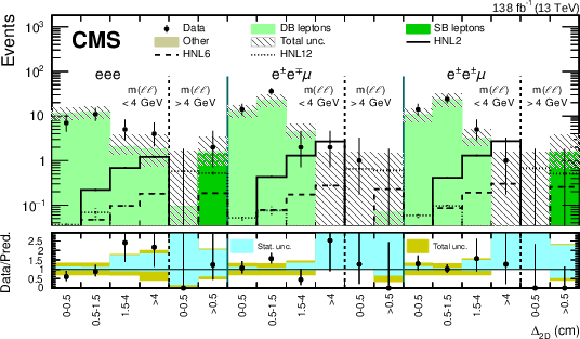
png pdf |
Figure 68-a:
Comparison between the number of observed events in data and the background predictions (filled histograms) in the SR for $ \mathrm{e}\mathrm{e}\mathrm{X} $ (upper) and $ \mu\mu\mathrm{X} $ (lower) final states. The hatched band indicates the total systematic and statistical uncertainty in the background prediction. The lower panels indicate the ratio between the observed data and the prediction, where missing points indicate that the ratio lies outside the axis range. Predictions for signal events are shown for several benchmark hypotheses for Majorana HNL production: $ m_{\mathrm{N}}= $ 2 GeV and $ $|V_{\mathrm{\ell N}}|^{2} =$ 0.8$\times$10$^{-4} $ (HNL2), $ m_{\mathrm{N}}= $ 6 GeV and $ $|V_{\mathrm{\ell N}}|^{2} =$ 1.3$\times$10$^{-6} $ (HNL6), $ m_{\mathrm{N}}= $ 12 GeV and $ $|V_{\mathrm{\ell N}}|^{2} = $ 1.0$\times$10$^{-6} $ (HNL12). Small contributions from background processes that are estimated from simulation are collectively referred to as ``Other''. Figures taken from Ref. [261]. |
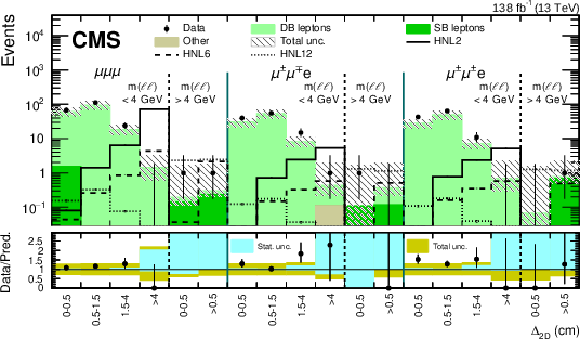
png pdf |
Figure 68-b:
Comparison between the number of observed events in data and the background predictions (filled histograms) in the SR for $ \mathrm{e}\mathrm{e}\mathrm{X} $ (upper) and $ \mu\mu\mathrm{X} $ (lower) final states. The hatched band indicates the total systematic and statistical uncertainty in the background prediction. The lower panels indicate the ratio between the observed data and the prediction, where missing points indicate that the ratio lies outside the axis range. Predictions for signal events are shown for several benchmark hypotheses for Majorana HNL production: $ m_{\mathrm{N}}= $ 2 GeV and $ $|V_{\mathrm{\ell N}}|^{2} =$ 0.8$\times$10$^{-4} $ (HNL2), $ m_{\mathrm{N}}= $ 6 GeV and $ $|V_{\mathrm{\ell N}}|^{2} =$ 1.3$\times$10$^{-6} $ (HNL6), $ m_{\mathrm{N}}= $ 12 GeV and $ $|V_{\mathrm{\ell N}}|^{2} = $ 1.0$\times$10$^{-6} $ (HNL12). Small contributions from background processes that are estimated from simulation are collectively referred to as ``Other''. Figures taken from Ref. [261]. |
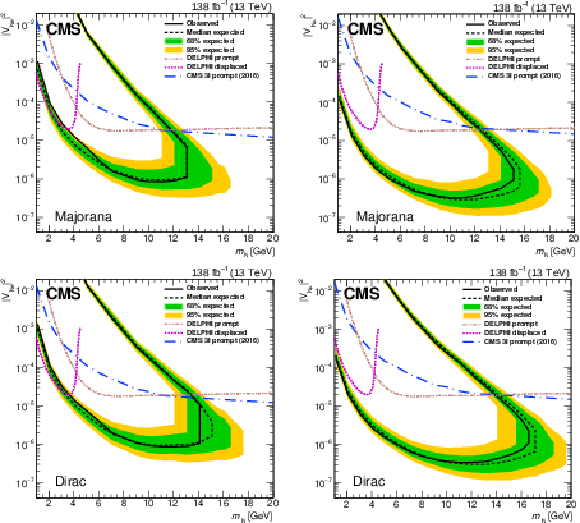
png pdf |
Figure 69:
The limits at 95% CL on $ |V_{\mathrm{eN}}|^{2} $ (left) and $ |V_{\mathrm{\mu N}}|^{2} $ (right) as functions of $ m_{\mathrm{N}} $ for a Majorana (upper) or Dirac (lower) HNL. The area inside the solid (dashed) black curve indicates the observed (expected) exclusion region. Results from the DELPHI [255] and the CMS [259,252] Collaborations are shown as upper limits, i.e.,, the area above the curves indicates the respective observed exclusion region. Figures adapted from Ref. [261]. |
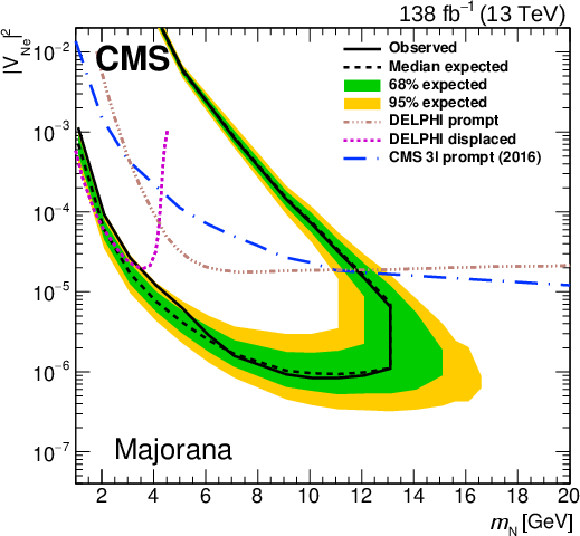
png pdf |
Figure 69-a:
The limits at 95% CL on $ |V_{\mathrm{eN}}|^{2} $ (left) and $ |V_{\mathrm{\mu N}}|^{2} $ (right) as functions of $ m_{\mathrm{N}} $ for a Majorana (upper) or Dirac (lower) HNL. The area inside the solid (dashed) black curve indicates the observed (expected) exclusion region. Results from the DELPHI [255] and the CMS [259,252] Collaborations are shown as upper limits, i.e.,, the area above the curves indicates the respective observed exclusion region. Figures adapted from Ref. [261]. |
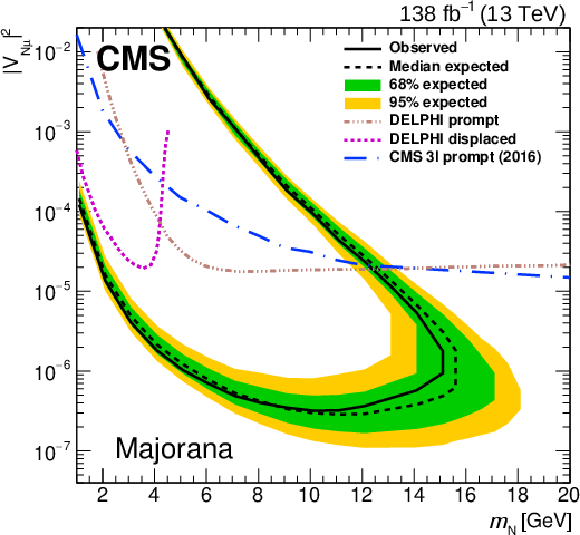
png pdf |
Figure 69-b:
The limits at 95% CL on $ |V_{\mathrm{eN}}|^{2} $ (left) and $ |V_{\mathrm{\mu N}}|^{2} $ (right) as functions of $ m_{\mathrm{N}} $ for a Majorana (upper) or Dirac (lower) HNL. The area inside the solid (dashed) black curve indicates the observed (expected) exclusion region. Results from the DELPHI [255] and the CMS [259,252] Collaborations are shown as upper limits, i.e.,, the area above the curves indicates the respective observed exclusion region. Figures adapted from Ref. [261]. |
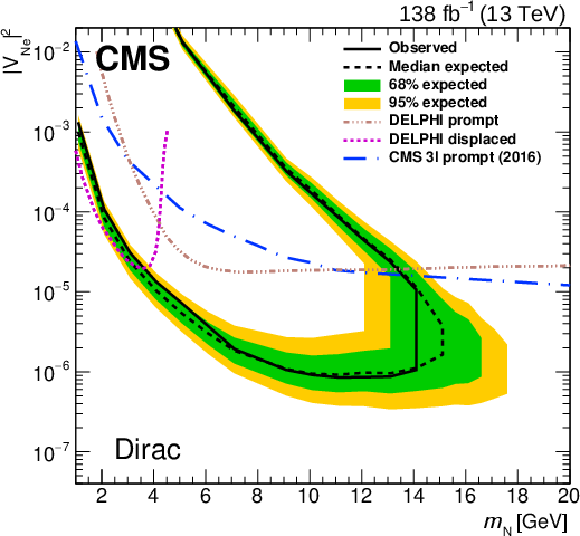
png pdf |
Figure 69-c:
The limits at 95% CL on $ |V_{\mathrm{eN}}|^{2} $ (left) and $ |V_{\mathrm{\mu N}}|^{2} $ (right) as functions of $ m_{\mathrm{N}} $ for a Majorana (upper) or Dirac (lower) HNL. The area inside the solid (dashed) black curve indicates the observed (expected) exclusion region. Results from the DELPHI [255] and the CMS [259,252] Collaborations are shown as upper limits, i.e.,, the area above the curves indicates the respective observed exclusion region. Figures adapted from Ref. [261]. |
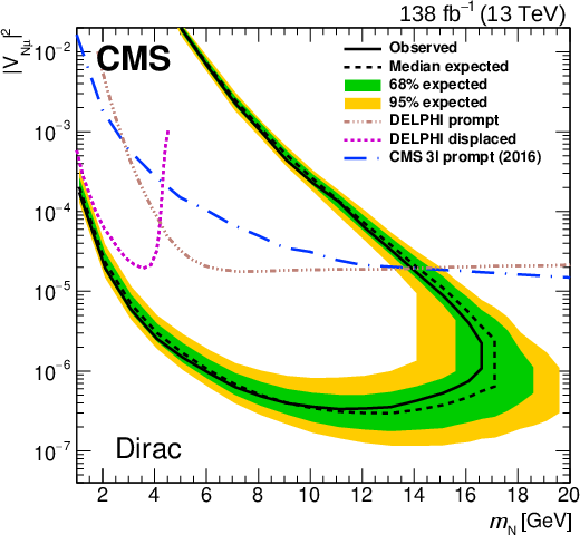
png pdf |
Figure 69-d:
The limits at 95% CL on $ |V_{\mathrm{eN}}|^{2} $ (left) and $ |V_{\mathrm{\mu N}}|^{2} $ (right) as functions of $ m_{\mathrm{N}} $ for a Majorana (upper) or Dirac (lower) HNL. The area inside the solid (dashed) black curve indicates the observed (expected) exclusion region. Results from the DELPHI [255] and the CMS [259,252] Collaborations are shown as upper limits, i.e.,, the area above the curves indicates the respective observed exclusion region. Figures adapted from Ref. [261]. |
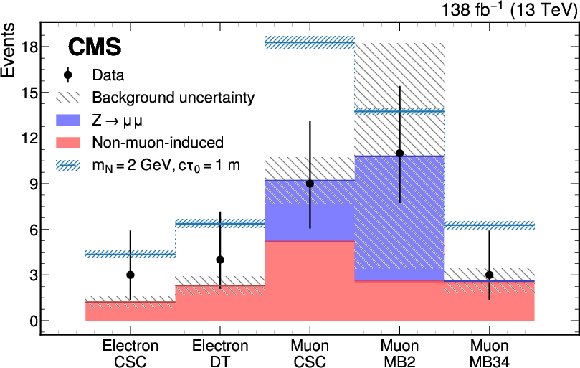
png pdf |
Figure 70:
Expected and observed number of events in the SR of different event categories. Signal yields of a Majorana HNL with a mass of 2 GeV and with a proper decay length of 1 m are overlaid on top of the expected background estimated using the ABCD method. Figure taken from Ref. [270]. |
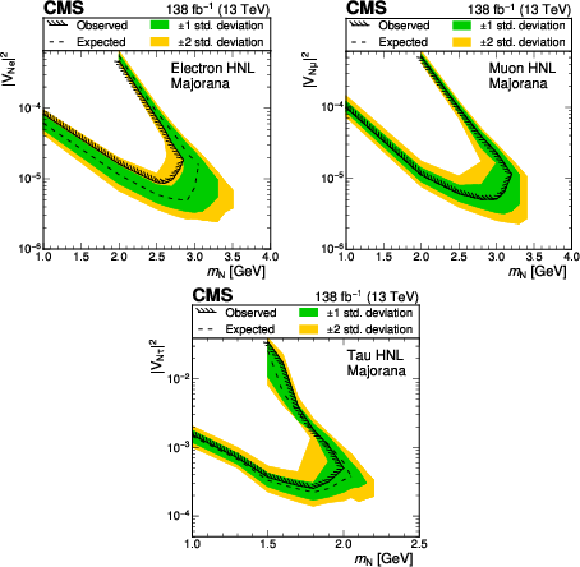
png pdf |
Figure 71:
Expected and observed upper limits at 95% CL on Majorana HNL production as functions of the HNL mass ($ m_{\mathrm{N}} $), and assuming mixing of the HNL with only one generation. The limits are shown for pure electron mixing (upper left), pure muon mixing (upper right), and pure tau neutrino mixing (lower). The limits in the tau neutrino mixing scenario are obtained by combining the results from the electron and muon decay channels of the tau lepton. Figures adapted from Ref. [270]. |
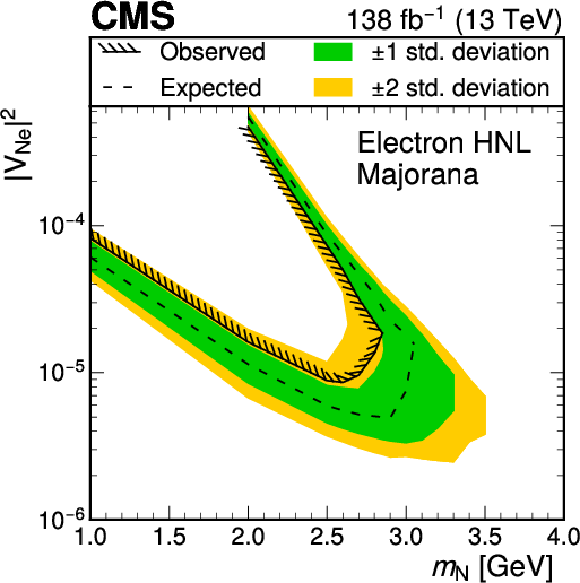
png pdf |
Figure 71-a:
Expected and observed upper limits at 95% CL on Majorana HNL production as functions of the HNL mass ($ m_{\mathrm{N}} $), and assuming mixing of the HNL with only one generation. The limits are shown for pure electron mixing (upper left), pure muon mixing (upper right), and pure tau neutrino mixing (lower). The limits in the tau neutrino mixing scenario are obtained by combining the results from the electron and muon decay channels of the tau lepton. Figures adapted from Ref. [270]. |
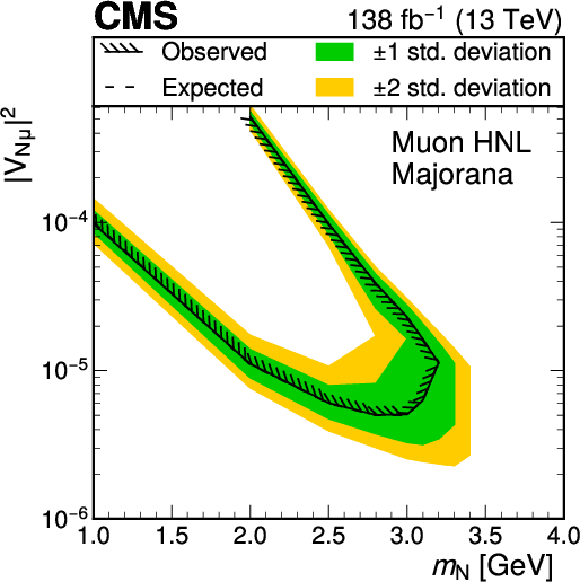
png pdf |
Figure 71-b:
Expected and observed upper limits at 95% CL on Majorana HNL production as functions of the HNL mass ($ m_{\mathrm{N}} $), and assuming mixing of the HNL with only one generation. The limits are shown for pure electron mixing (upper left), pure muon mixing (upper right), and pure tau neutrino mixing (lower). The limits in the tau neutrino mixing scenario are obtained by combining the results from the electron and muon decay channels of the tau lepton. Figures adapted from Ref. [270]. |
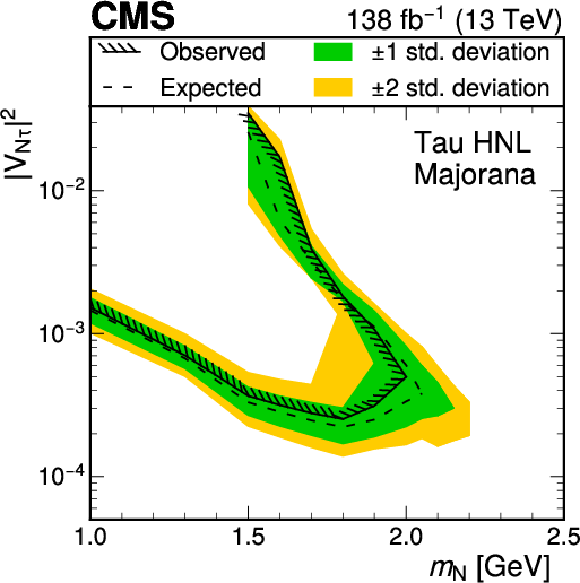
png pdf |
Figure 71-c:
Expected and observed upper limits at 95% CL on Majorana HNL production as functions of the HNL mass ($ m_{\mathrm{N}} $), and assuming mixing of the HNL with only one generation. The limits are shown for pure electron mixing (upper left), pure muon mixing (upper right), and pure tau neutrino mixing (lower). The limits in the tau neutrino mixing scenario are obtained by combining the results from the electron and muon decay channels of the tau lepton. Figures adapted from Ref. [270]. |
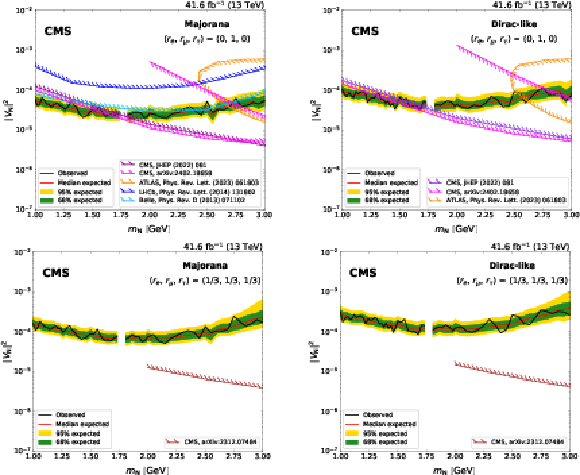
png pdf |
Figure 72:
Expected and observed limits at 95% CL on $ |V_{\mathrm{N}}|^{2} $ as functions of $ m_{\mathrm{N}} $, in the Majorana (left column) and Dirac (right column) scenarios. The limits are shown for the mixing scenarios $ (r_{\mathrm{e}},r_{\mu},r_{\tau})=(0,1,0) $ (upper row) and $ (r_{\mathrm{e}},r_{\mu},r_{\tau})=(1/3,1/3,1/3) $ (lower row). Results from the CMS [261,270,263], ATLAS [265], LHCb [276], and Belle [277] Collaborations are superimposed for comparison. The mass range with no results shown corresponds to a vetoed region around the $ \mathrm{D^0} $ mass. Figures taken from Ref. [220]. |
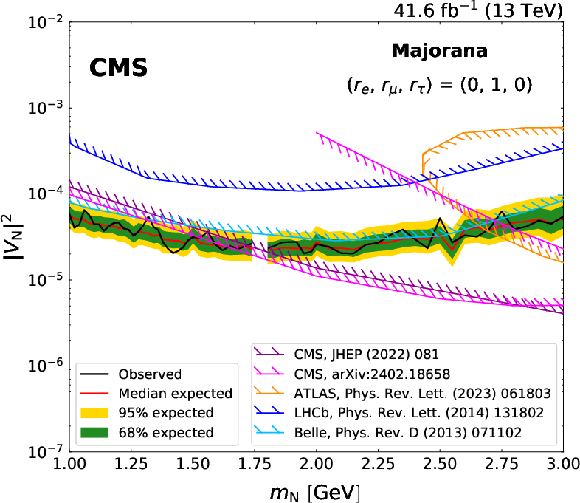
png pdf |
Figure 72-a:
Expected and observed limits at 95% CL on $ |V_{\mathrm{N}}|^{2} $ as functions of $ m_{\mathrm{N}} $, in the Majorana (left column) and Dirac (right column) scenarios. The limits are shown for the mixing scenarios $ (r_{\mathrm{e}},r_{\mu},r_{\tau})=(0,1,0) $ (upper row) and $ (r_{\mathrm{e}},r_{\mu},r_{\tau})=(1/3,1/3,1/3) $ (lower row). Results from the CMS [261,270,263], ATLAS [265], LHCb [276], and Belle [277] Collaborations are superimposed for comparison. The mass range with no results shown corresponds to a vetoed region around the $ \mathrm{D^0} $ mass. Figures taken from Ref. [220]. |
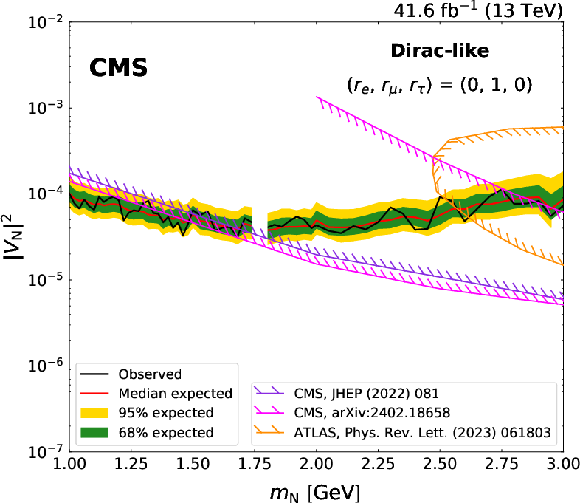
png pdf |
Figure 72-b:
Expected and observed limits at 95% CL on $ |V_{\mathrm{N}}|^{2} $ as functions of $ m_{\mathrm{N}} $, in the Majorana (left column) and Dirac (right column) scenarios. The limits are shown for the mixing scenarios $ (r_{\mathrm{e}},r_{\mu},r_{\tau})=(0,1,0) $ (upper row) and $ (r_{\mathrm{e}},r_{\mu},r_{\tau})=(1/3,1/3,1/3) $ (lower row). Results from the CMS [261,270,263], ATLAS [265], LHCb [276], and Belle [277] Collaborations are superimposed for comparison. The mass range with no results shown corresponds to a vetoed region around the $ \mathrm{D^0} $ mass. Figures taken from Ref. [220]. |
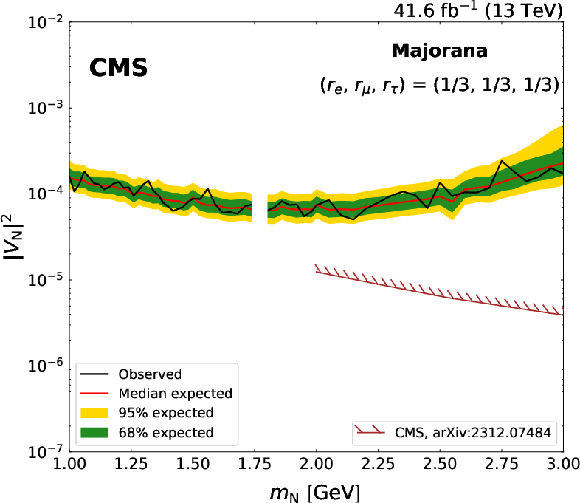
png pdf |
Figure 72-c:
Expected and observed limits at 95% CL on $ |V_{\mathrm{N}}|^{2} $ as functions of $ m_{\mathrm{N}} $, in the Majorana (left column) and Dirac (right column) scenarios. The limits are shown for the mixing scenarios $ (r_{\mathrm{e}},r_{\mu},r_{\tau})=(0,1,0) $ (upper row) and $ (r_{\mathrm{e}},r_{\mu},r_{\tau})=(1/3,1/3,1/3) $ (lower row). Results from the CMS [261,270,263], ATLAS [265], LHCb [276], and Belle [277] Collaborations are superimposed for comparison. The mass range with no results shown corresponds to a vetoed region around the $ \mathrm{D^0} $ mass. Figures taken from Ref. [220]. |
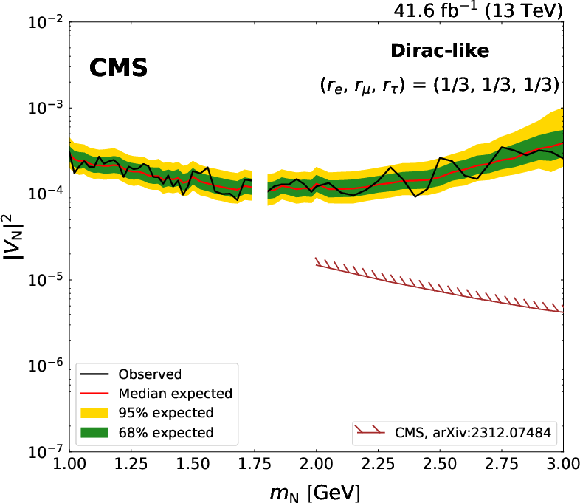
png pdf |
Figure 72-d:
Expected and observed limits at 95% CL on $ |V_{\mathrm{N}}|^{2} $ as functions of $ m_{\mathrm{N}} $, in the Majorana (left column) and Dirac (right column) scenarios. The limits are shown for the mixing scenarios $ (r_{\mathrm{e}},r_{\mu},r_{\tau})=(0,1,0) $ (upper row) and $ (r_{\mathrm{e}},r_{\mu},r_{\tau})=(1/3,1/3,1/3) $ (lower row). Results from the CMS [261,270,263], ATLAS [265], LHCb [276], and Belle [277] Collaborations are superimposed for comparison. The mass range with no results shown corresponds to a vetoed region around the $ \mathrm{D^0} $ mass. Figures taken from Ref. [220]. |
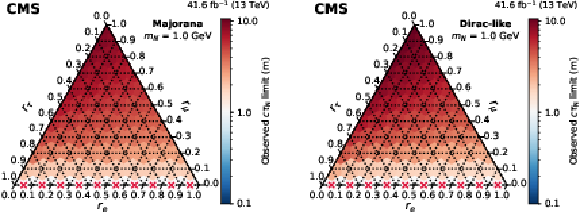
png pdf |
Figure 73:
Observed limits at 95% CL on $ c\tau_{\mathrm{N}} $ as a function of the mixing ratios $ (r_{\mathrm{e}},r_{\mu},r_{\tau}) $ for $ m_{\mathrm{N}}= $ 1 GeV in the Majorana (left) and Dirac (right) scenarios. The red crosses indicate that there is no exclusion found for that point. The orientation of the value markers on each axis identifies the associated internal lines on the plot. Figures taken from Ref. [220]. |
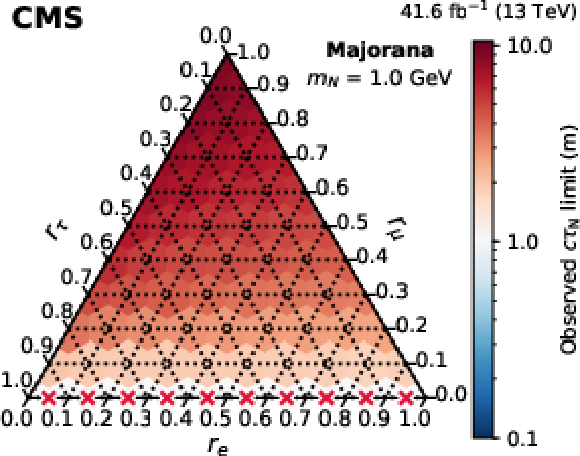
png pdf |
Figure 73-a:
Observed limits at 95% CL on $ c\tau_{\mathrm{N}} $ as a function of the mixing ratios $ (r_{\mathrm{e}},r_{\mu},r_{\tau}) $ for $ m_{\mathrm{N}}= $ 1 GeV in the Majorana (left) and Dirac (right) scenarios. The red crosses indicate that there is no exclusion found for that point. The orientation of the value markers on each axis identifies the associated internal lines on the plot. Figures taken from Ref. [220]. |
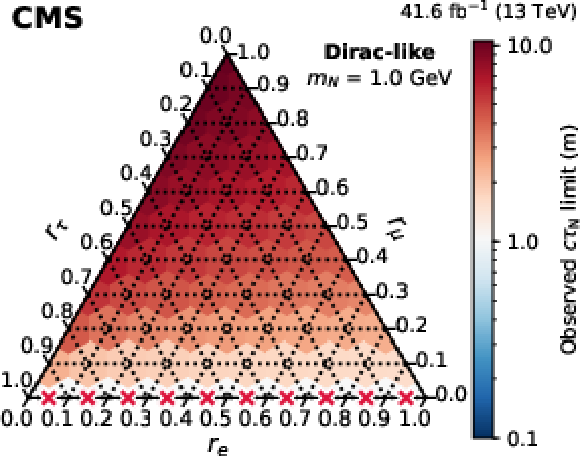
png pdf |
Figure 73-b:
Observed limits at 95% CL on $ c\tau_{\mathrm{N}} $ as a function of the mixing ratios $ (r_{\mathrm{e}},r_{\mu},r_{\tau}) $ for $ m_{\mathrm{N}}= $ 1 GeV in the Majorana (left) and Dirac (right) scenarios. The red crosses indicate that there is no exclusion found for that point. The orientation of the value markers on each axis identifies the associated internal lines on the plot. Figures taken from Ref. [220]. |
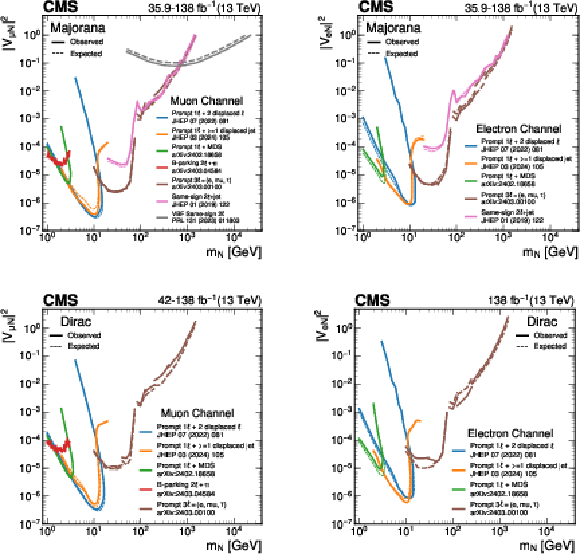
png pdf |
Figure 74:
Summary of searches at the CMS experiment for long-lived HNLs in the $Type I$ seesaw model. The observed limits at 95% CL on the mixing parameter \mixparsq\ell$ \mathrm{N} $ as a function of the HNL mass $ m_{\mathrm{N}} $ are shown, for Majorana and Dirac HNLs (upper and lower row, respectively), and in the muon and electron channel (left and right column, respectively). |
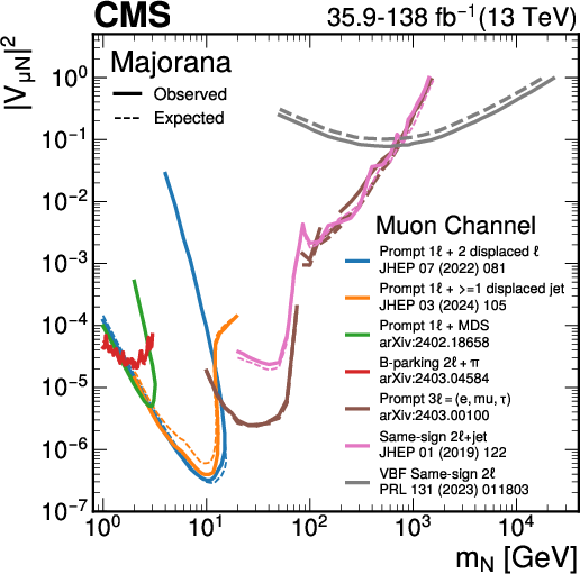
png pdf |
Figure 74-a:
Summary of searches at the CMS experiment for long-lived HNLs in the $Type I$ seesaw model. The observed limits at 95% CL on the mixing parameter \mixparsq\ell$ \mathrm{N} $ as a function of the HNL mass $ m_{\mathrm{N}} $ are shown, for Majorana and Dirac HNLs (upper and lower row, respectively), and in the muon and electron channel (left and right column, respectively). |
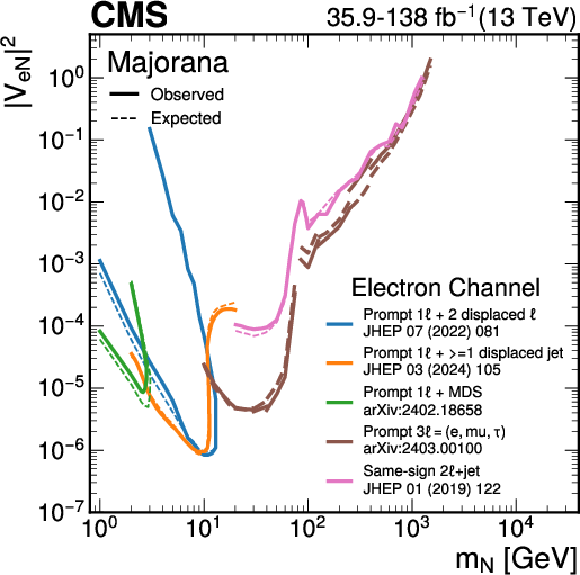
png pdf |
Figure 74-b:
Summary of searches at the CMS experiment for long-lived HNLs in the $Type I$ seesaw model. The observed limits at 95% CL on the mixing parameter \mixparsq\ell$ \mathrm{N} $ as a function of the HNL mass $ m_{\mathrm{N}} $ are shown, for Majorana and Dirac HNLs (upper and lower row, respectively), and in the muon and electron channel (left and right column, respectively). |
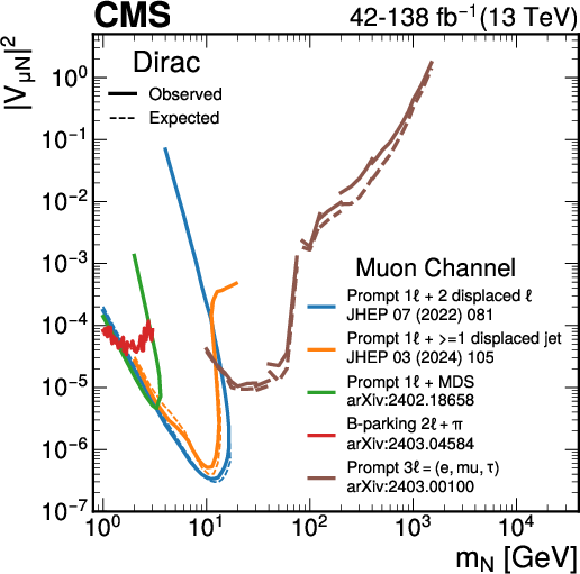
png pdf |
Figure 74-c:
Summary of searches at the CMS experiment for long-lived HNLs in the $Type I$ seesaw model. The observed limits at 95% CL on the mixing parameter \mixparsq\ell$ \mathrm{N} $ as a function of the HNL mass $ m_{\mathrm{N}} $ are shown, for Majorana and Dirac HNLs (upper and lower row, respectively), and in the muon and electron channel (left and right column, respectively). |
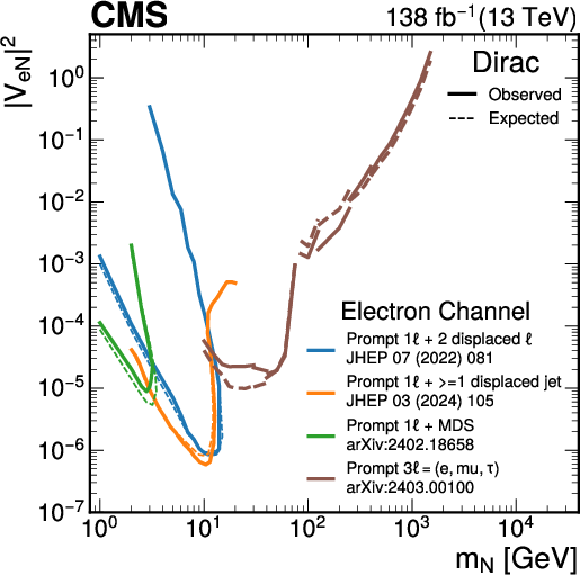
png pdf |
Figure 74-d:
Summary of searches at the CMS experiment for long-lived HNLs in the $Type I$ seesaw model. The observed limits at 95% CL on the mixing parameter \mixparsq\ell$ \mathrm{N} $ as a function of the HNL mass $ m_{\mathrm{N}} $ are shown, for Majorana and Dirac HNLs (upper and lower row, respectively), and in the muon and electron channel (left and right column, respectively). |
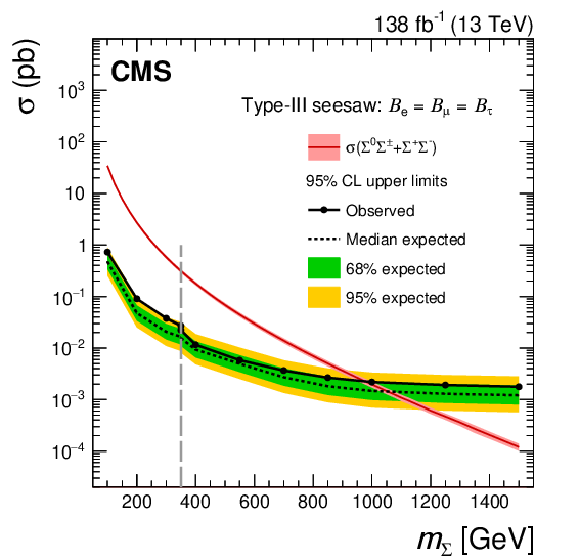
png pdf |
Figure 75:
Observed and expected upper limits at 95% CL on the production cross section for $Type III$ seesaw HNLs in the flavor-democratic scenario using the model-independent schemes and the BDT regions. To the left of the vertical dashed gray line, the limits are shown from the model-independent SR, and to the right the limits are shown obtained using the BDT regions. Figure adapted from Ref. [204]. Production cross sections for the signal model are calculated at NLO plus next-to-leading logarithmic precision, assuming that the heavy leptons are SU(2) triplet fermions [60,61]. |
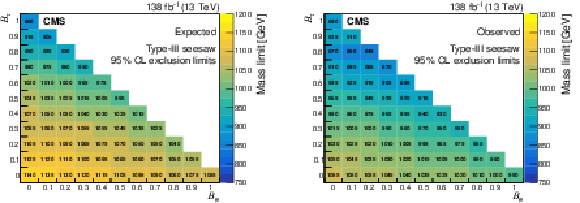
png pdf |
Figure 76:
Expected (left) and observed (right) lower limits at 95% CL on the mass of $Type III$ seesaw HNLs in the plane defined by $ \mathcal{B}_{\mathrm{e}} $ and $ \mathcal{B}_{\tau} $, with the constraint that $ \mathcal{B}_{\mathrm{e}}+\mathcal{B}_{\mu}+\mathcal{B}_{\tau}= $ 1. For $ \mathcal{B}_{\tau}\geq $ 0.9, these limits are obtained using the high mass BDT trained assuming $ \mathcal{B}_{\tau}= $ 1, and for the other decay branching fraction combinations, the limits use the $ \mathcal{B}_{\mathrm{e}}=\mathcal{B}_{\mu}=\mathcal{B}_{\tau} $ BDT. Figures adapted from Ref. [204]. |
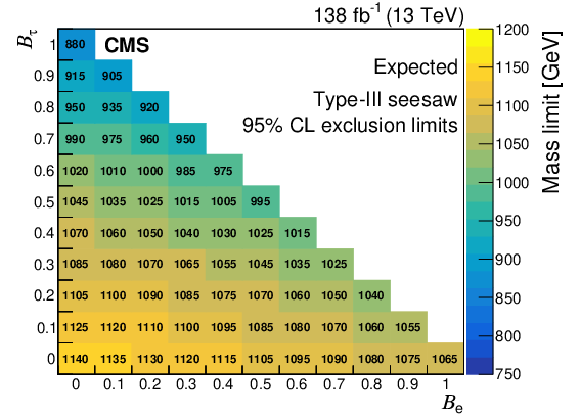
png pdf |
Figure 76-a:
Expected (left) and observed (right) lower limits at 95% CL on the mass of $Type III$ seesaw HNLs in the plane defined by $ \mathcal{B}_{\mathrm{e}} $ and $ \mathcal{B}_{\tau} $, with the constraint that $ \mathcal{B}_{\mathrm{e}}+\mathcal{B}_{\mu}+\mathcal{B}_{\tau}= $ 1. For $ \mathcal{B}_{\tau}\geq $ 0.9, these limits are obtained using the high mass BDT trained assuming $ \mathcal{B}_{\tau}= $ 1, and for the other decay branching fraction combinations, the limits use the $ \mathcal{B}_{\mathrm{e}}=\mathcal{B}_{\mu}=\mathcal{B}_{\tau} $ BDT. Figures adapted from Ref. [204]. |
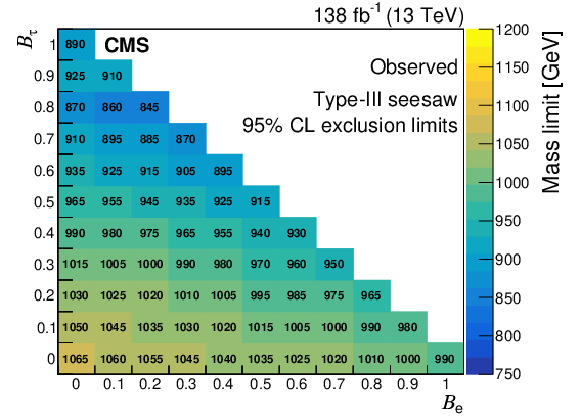
png pdf |
Figure 76-b:
Expected (left) and observed (right) lower limits at 95% CL on the mass of $Type III$ seesaw HNLs in the plane defined by $ \mathcal{B}_{\mathrm{e}} $ and $ \mathcal{B}_{\tau} $, with the constraint that $ \mathcal{B}_{\mathrm{e}}+\mathcal{B}_{\mu}+\mathcal{B}_{\tau}= $ 1. For $ \mathcal{B}_{\tau}\geq $ 0.9, these limits are obtained using the high mass BDT trained assuming $ \mathcal{B}_{\tau}= $ 1, and for the other decay branching fraction combinations, the limits use the $ \mathcal{B}_{\mathrm{e}}=\mathcal{B}_{\mu}=\mathcal{B}_{\tau} $ BDT. Figures adapted from Ref. [204]. |
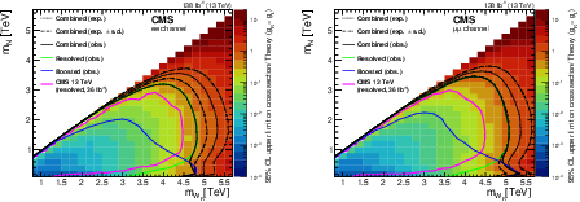
png pdf |
Figure 77:
The observed upper limits at 95% CL on the product of the production cross section and the branching fraction of a right-handed $ \mathrm{W_R} $ boson divided by the theory expectation for a coupling constant $ g_{\text{R}} $ equal to the SM coupling of the $ \mathrm{W_R} $ boson ($ g_{\text{L}} $), for the electron channel (left) and muon channel (right). The observed exclusion regions are shown for the resolved (solid green), boosted (solid blue), and combined (solid black) channels, together with the expected exclusion region for the combined result (dotted black). The dash-dotted lines represent the 68% coverage of the boundaries of the expected exclusion regions. The observed exclusion regions obtained in the previous search performed by the CMS Collaboration [284] are bounded by the magenta lines. The biggest improvement may be seen in the $ m_{\mathrm{N}} < $ 0.5 TeV region, where the new boosted category greatly improves the sensitivity with respect to the previous result. Figures adapted from Ref. [281]. |
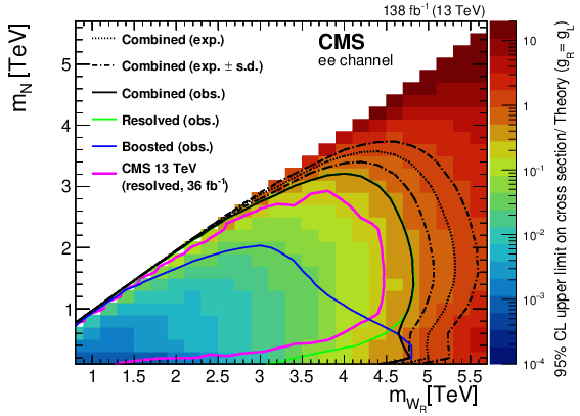
png pdf |
Figure 77-a:
The observed upper limits at 95% CL on the product of the production cross section and the branching fraction of a right-handed $ \mathrm{W_R} $ boson divided by the theory expectation for a coupling constant $ g_{\text{R}} $ equal to the SM coupling of the $ \mathrm{W_R} $ boson ($ g_{\text{L}} $), for the electron channel (left) and muon channel (right). The observed exclusion regions are shown for the resolved (solid green), boosted (solid blue), and combined (solid black) channels, together with the expected exclusion region for the combined result (dotted black). The dash-dotted lines represent the 68% coverage of the boundaries of the expected exclusion regions. The observed exclusion regions obtained in the previous search performed by the CMS Collaboration [284] are bounded by the magenta lines. The biggest improvement may be seen in the $ m_{\mathrm{N}} < $ 0.5 TeV region, where the new boosted category greatly improves the sensitivity with respect to the previous result. Figures adapted from Ref. [281]. |
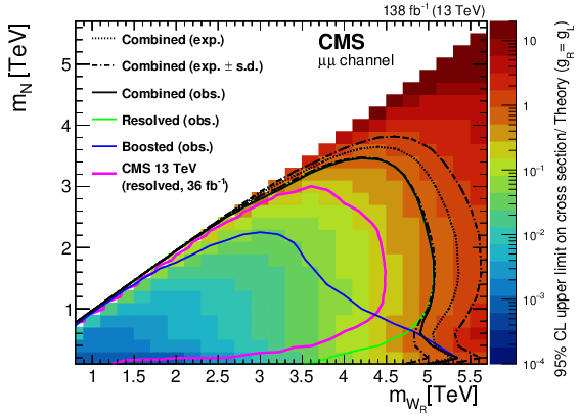
png pdf |
Figure 77-b:
The observed upper limits at 95% CL on the product of the production cross section and the branching fraction of a right-handed $ \mathrm{W_R} $ boson divided by the theory expectation for a coupling constant $ g_{\text{R}} $ equal to the SM coupling of the $ \mathrm{W_R} $ boson ($ g_{\text{L}} $), for the electron channel (left) and muon channel (right). The observed exclusion regions are shown for the resolved (solid green), boosted (solid blue), and combined (solid black) channels, together with the expected exclusion region for the combined result (dotted black). The dash-dotted lines represent the 68% coverage of the boundaries of the expected exclusion regions. The observed exclusion regions obtained in the previous search performed by the CMS Collaboration [284] are bounded by the magenta lines. The biggest improvement may be seen in the $ m_{\mathrm{N}} < $ 0.5 TeV region, where the new boosted category greatly improves the sensitivity with respect to the previous result. Figures adapted from Ref. [281]. |
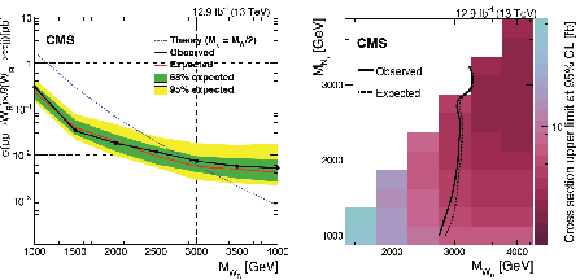
png pdf |
Figure 78:
Observed and expected limits at 95% CL on the product of cross section and branching fraction, obtained from the combination of the $ \mathrm{e}\tau_\mathrm{h} $ and $ \mu\tau_\mathrm{h} $ channels (left), and the observed and expected upper limits at 95% CL on the production cross section as functions of the mass $ m_{\mathrm{W_R}} $ of the $ \mathrm{W_R} $ boson and the mass $ m_{{{\mathrm{N}}{\tau}} } $ of the HNL (right). The inner (green) band and the outer (yellow) band in the left figure indicate the regions containing 68 and 95%, respectively, of the distribution of limits expected under the background-only hypothesis. The dashed dark blue curve in the left figure represents the theoretical prediction for the product of the $ \mathrm{W_R} $ boson production cross section and the branching fraction for decay to a $ \tau $ lepton and RH neutrino, assuming the mass of the RH neutrino to be half the mass of the $ \mathrm{W_R} $ boson. Figures taken from Ref. [285]. |
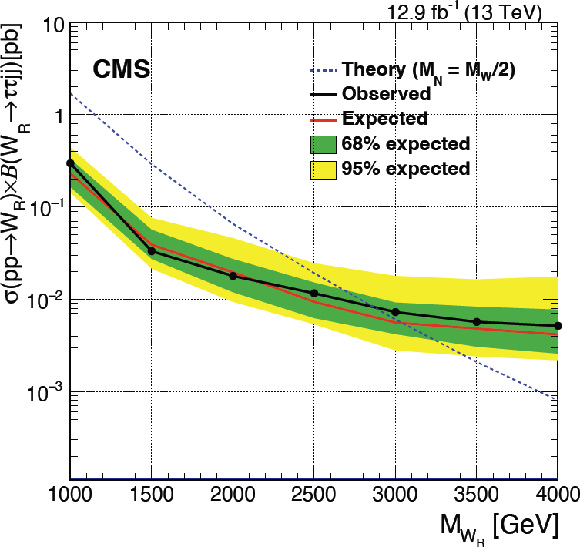
png |
Figure 78-a:
Observed and expected limits at 95% CL on the product of cross section and branching fraction, obtained from the combination of the $ \mathrm{e}\tau_\mathrm{h} $ and $ \mu\tau_\mathrm{h} $ channels (left), and the observed and expected upper limits at 95% CL on the production cross section as functions of the mass $ m_{\mathrm{W_R}} $ of the $ \mathrm{W_R} $ boson and the mass $ m_{{{\mathrm{N}}{\tau}} } $ of the HNL (right). The inner (green) band and the outer (yellow) band in the left figure indicate the regions containing 68 and 95%, respectively, of the distribution of limits expected under the background-only hypothesis. The dashed dark blue curve in the left figure represents the theoretical prediction for the product of the $ \mathrm{W_R} $ boson production cross section and the branching fraction for decay to a $ \tau $ lepton and RH neutrino, assuming the mass of the RH neutrino to be half the mass of the $ \mathrm{W_R} $ boson. Figures taken from Ref. [285]. |
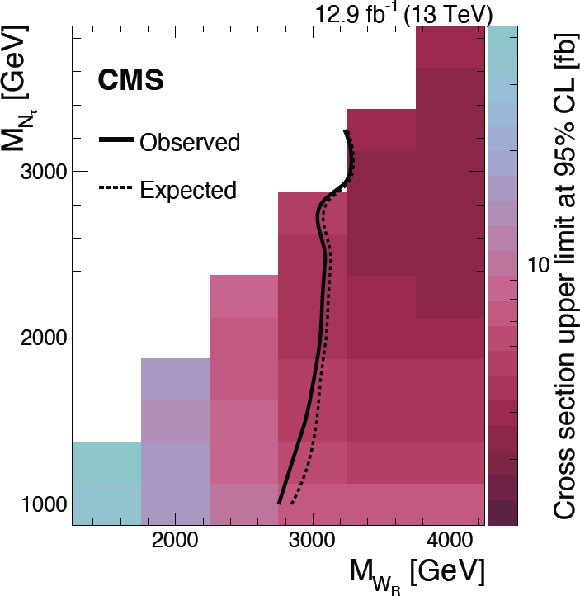
png |
Figure 78-b:
Observed and expected limits at 95% CL on the product of cross section and branching fraction, obtained from the combination of the $ \mathrm{e}\tau_\mathrm{h} $ and $ \mu\tau_\mathrm{h} $ channels (left), and the observed and expected upper limits at 95% CL on the production cross section as functions of the mass $ m_{\mathrm{W_R}} $ of the $ \mathrm{W_R} $ boson and the mass $ m_{{{\mathrm{N}}{\tau}} } $ of the HNL (right). The inner (green) band and the outer (yellow) band in the left figure indicate the regions containing 68 and 95%, respectively, of the distribution of limits expected under the background-only hypothesis. The dashed dark blue curve in the left figure represents the theoretical prediction for the product of the $ \mathrm{W_R} $ boson production cross section and the branching fraction for decay to a $ \tau $ lepton and RH neutrino, assuming the mass of the RH neutrino to be half the mass of the $ \mathrm{W_R} $ boson. Figures taken from Ref. [285]. |
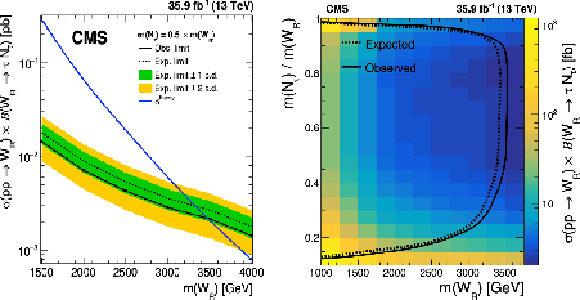
png pdf |
Figure 79:
Upper limits at 95% CL on the product of the cross section and the branching fraction for the production of $ \mathrm{W_R} $ bosons decaying to {$ \mathrm{N} \tau $ as function of the $ \mathrm{W_R} $ boson mass (left). The observed (expected) limit is shown as solid (dashed) black lines, and the inner (green) band and the outer (yellow) band indicate the regions containing 68 and 95%, respectively, of the distribution of limits expected under the background-only hypothesis. The theoretical cross section is indicated by the solid blue line. Expected and observed limits at 95% CL on the product of the cross section and the branching fraction for $ \mathrm{W_R}\to{{\mathrm{N}}{\tau}} \tau $ as a function of $ m_{\mathrm{W_R}} $ and $ m_{{{\mathrm{N}}{\tau}} }/m_{\mathrm{W_R}} $ (right). Figures taken from Ref. [286]. |
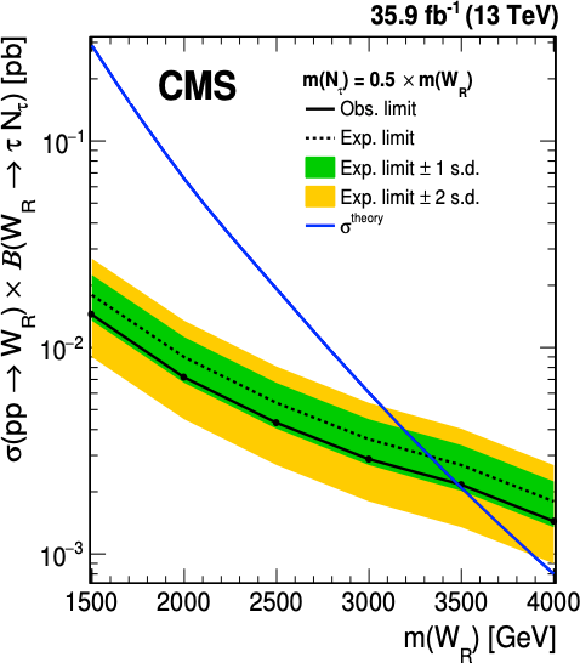
png |
Figure 79-a:
Upper limits at 95% CL on the product of the cross section and the branching fraction for the production of $ \mathrm{W_R} $ bosons decaying to {$ \mathrm{N} \tau $ as function of the $ \mathrm{W_R} $ boson mass (left). The observed (expected) limit is shown as solid (dashed) black lines, and the inner (green) band and the outer (yellow) band indicate the regions containing 68 and 95%, respectively, of the distribution of limits expected under the background-only hypothesis. The theoretical cross section is indicated by the solid blue line. Expected and observed limits at 95% CL on the product of the cross section and the branching fraction for $ \mathrm{W_R}\to{{\mathrm{N}}{\tau}} \tau $ as a function of $ m_{\mathrm{W_R}} $ and $ m_{{{\mathrm{N}}{\tau}} }/m_{\mathrm{W_R}} $ (right). Figures taken from Ref. [286]. |
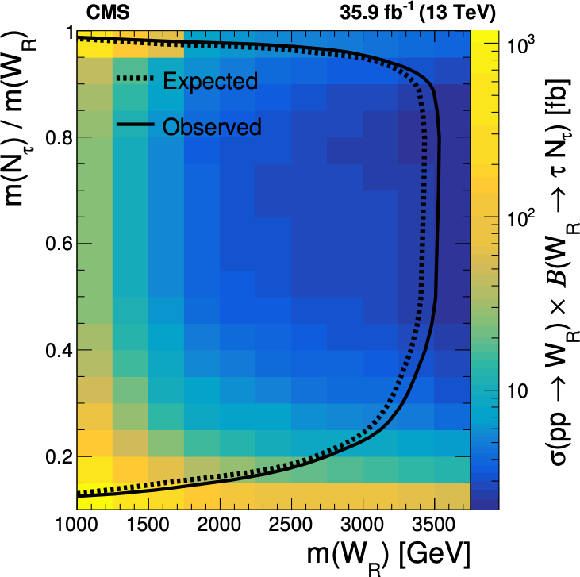
png |
Figure 79-b:
Upper limits at 95% CL on the product of the cross section and the branching fraction for the production of $ \mathrm{W_R} $ bosons decaying to {$ \mathrm{N} \tau $ as function of the $ \mathrm{W_R} $ boson mass (left). The observed (expected) limit is shown as solid (dashed) black lines, and the inner (green) band and the outer (yellow) band indicate the regions containing 68 and 95%, respectively, of the distribution of limits expected under the background-only hypothesis. The theoretical cross section is indicated by the solid blue line. Expected and observed limits at 95% CL on the product of the cross section and the branching fraction for $ \mathrm{W_R}\to{{\mathrm{N}}{\tau}} \tau $ as a function of $ m_{\mathrm{W_R}} $ and $ m_{{{\mathrm{N}}{\tau}} }/m_{\mathrm{W_R}} $ (right). Figures taken from Ref. [286]. |
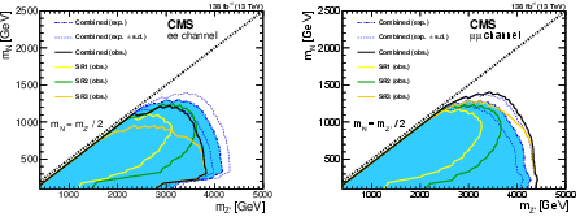
png pdf |
Figure 80:
The observed and expected exclusion limits in the $ m_{\mathrm{N}} $--$ m_{\mathrm{Z}^{'}} $ parameter space, in the dielectron channel (left) and the dimuon channel (right). Figures adapted from Ref. [289]. |
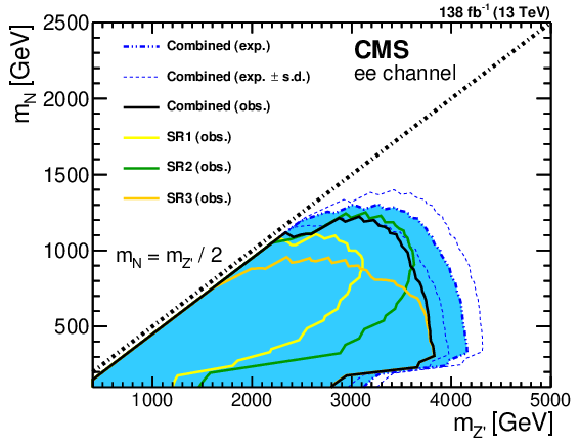
png pdf |
Figure 80-a:
The observed and expected exclusion limits in the $ m_{\mathrm{N}} $--$ m_{\mathrm{Z}^{'}} $ parameter space, in the dielectron channel (left) and the dimuon channel (right). Figures adapted from Ref. [289]. |
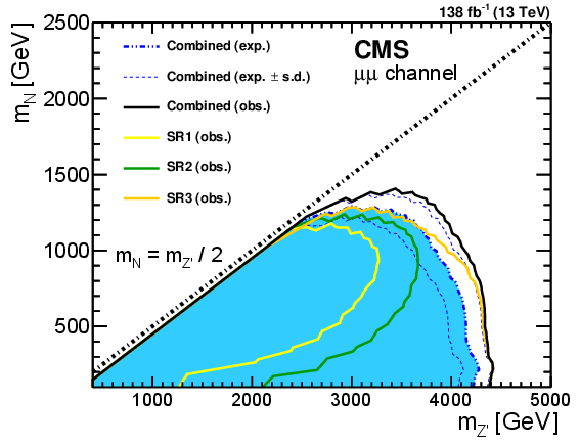
png pdf |
Figure 80-b:
The observed and expected exclusion limits in the $ m_{\mathrm{N}} $--$ m_{\mathrm{Z}^{'}} $ parameter space, in the dielectron channel (left) and the dimuon channel (right). Figures adapted from Ref. [289]. |
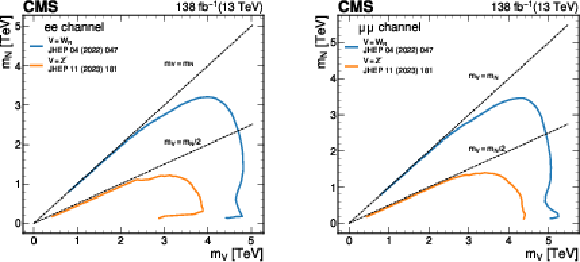
png pdf |
Figure 81:
Summary of searches at the CMS experiment for Majorana HNLs in the context of the LRSM model. The observed limits at 95% CL in the two-dimensional $ m_{\mathrm{N}} $--$ m_{\mathrm{V}} $ plane are shown in the electron and muon channel (left and right, respectively). |
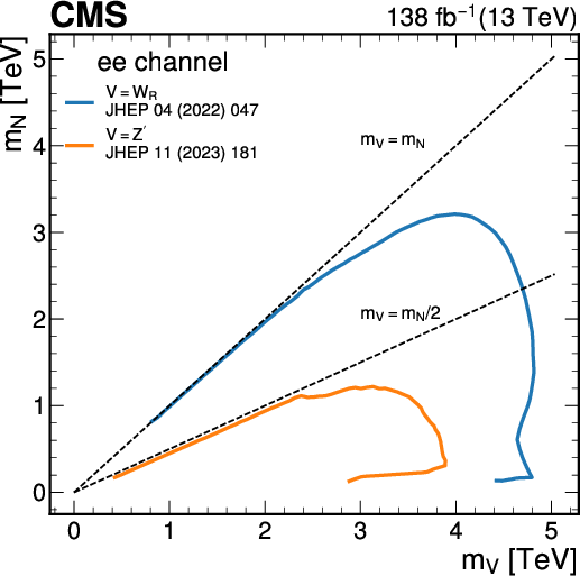
png pdf |
Figure 81-a:
Summary of searches at the CMS experiment for Majorana HNLs in the context of the LRSM model. The observed limits at 95% CL in the two-dimensional $ m_{\mathrm{N}} $--$ m_{\mathrm{V}} $ plane are shown in the electron and muon channel (left and right, respectively). |

png pdf |
Figure 81-b:
Summary of searches at the CMS experiment for Majorana HNLs in the context of the LRSM model. The observed limits at 95% CL in the two-dimensional $ m_{\mathrm{N}} $--$ m_{\mathrm{V}} $ plane are shown in the electron and muon channel (left and right, respectively). |
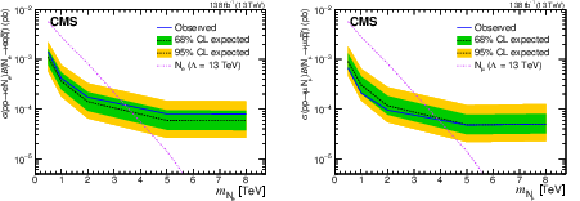
png pdf |
Figure 82:
Expected (dashed black) and observed (blue solid) exclusion limits for the $ \mathrm{e}\mathrm{e}\mathrm{q}{\overline{\mathrm{q}}{\prime}} $ (left) and $ \mu\mu\mathrm{q}{\overline{\mathrm{q}}{\prime}} $ (right) channels in the search for heavy composite Majorana neutrinos. The inner (green) band and the outer (yellow) band indicate the regions containing 68 and 95%, respectively, of the distribution of limits expected under the background-only hypothesis. Figures taken from Ref. [290]. |
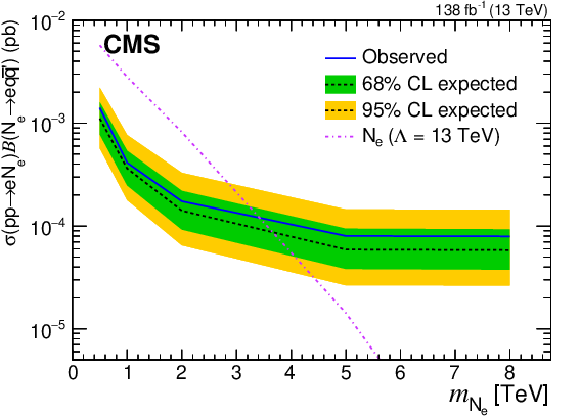
png pdf |
Figure 82-a:
Expected (dashed black) and observed (blue solid) exclusion limits for the $ \mathrm{e}\mathrm{e}\mathrm{q}{\overline{\mathrm{q}}{\prime}} $ (left) and $ \mu\mu\mathrm{q}{\overline{\mathrm{q}}{\prime}} $ (right) channels in the search for heavy composite Majorana neutrinos. The inner (green) band and the outer (yellow) band indicate the regions containing 68 and 95%, respectively, of the distribution of limits expected under the background-only hypothesis. Figures taken from Ref. [290]. |
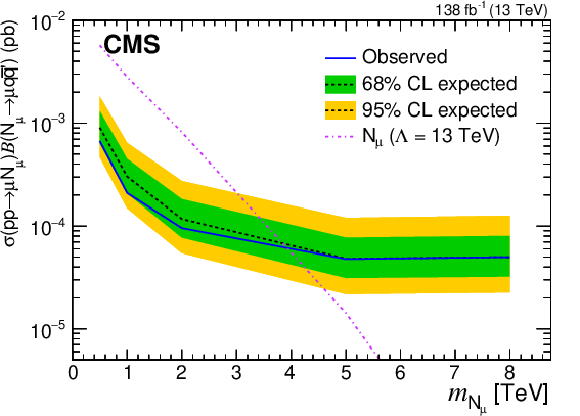
png pdf |
Figure 82-b:
Expected (dashed black) and observed (blue solid) exclusion limits for the $ \mathrm{e}\mathrm{e}\mathrm{q}{\overline{\mathrm{q}}{\prime}} $ (left) and $ \mu\mu\mathrm{q}{\overline{\mathrm{q}}{\prime}} $ (right) channels in the search for heavy composite Majorana neutrinos. The inner (green) band and the outer (yellow) band indicate the regions containing 68 and 95%, respectively, of the distribution of limits expected under the background-only hypothesis. Figures taken from Ref. [290]. |
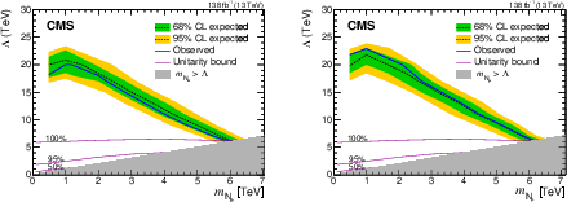
png pdf |
Figure 83:
Expected (dashed black) and observed (blue solid) exclusion limits for the $ \mathrm{e}\mathrm{e}\mathrm{q}{\overline{\mathrm{q}}{\prime}} $ (left) and $ \mu\mu\mathrm{q}{\overline{\mathrm{q}}{\prime}} $ (right) channel in the two-dimensional plane $ m_{{{\mathrm{N}}{\ell}} } $--$ \Lambda $. The solid violet lines represent the fraction of simulated events that satisfy the unitarity condition in the EFT approximation [292] with the various percentages considered. The inner (green) band and the outer (yellow) band indicate the regions containing 68 and 95%, respectively, of the distribution of limits expected under the background-only hypothesis. Figures taken from Ref. [290]. |
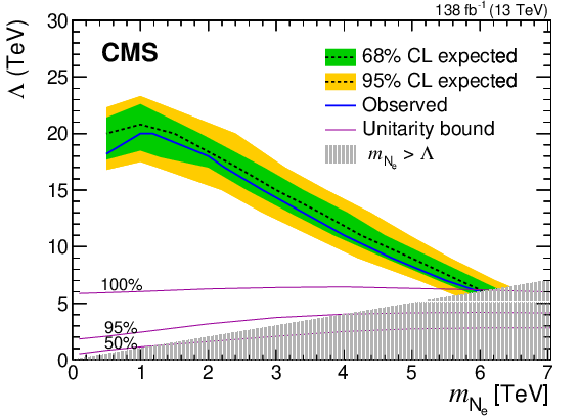
png pdf |
Figure 83-a:
Expected (dashed black) and observed (blue solid) exclusion limits for the $ \mathrm{e}\mathrm{e}\mathrm{q}{\overline{\mathrm{q}}{\prime}} $ (left) and $ \mu\mu\mathrm{q}{\overline{\mathrm{q}}{\prime}} $ (right) channel in the two-dimensional plane $ m_{{{\mathrm{N}}{\ell}} } $--$ \Lambda $. The solid violet lines represent the fraction of simulated events that satisfy the unitarity condition in the EFT approximation [292] with the various percentages considered. The inner (green) band and the outer (yellow) band indicate the regions containing 68 and 95%, respectively, of the distribution of limits expected under the background-only hypothesis. Figures taken from Ref. [290]. |
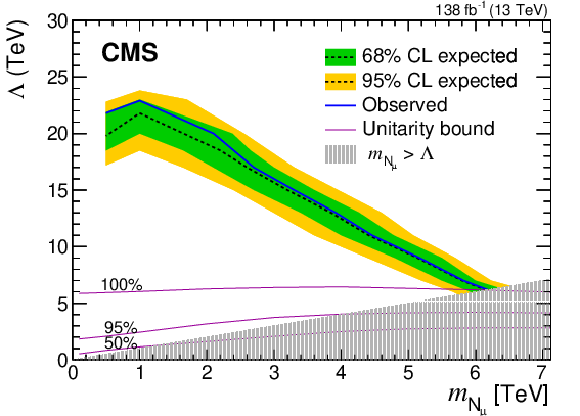
png pdf |
Figure 83-b:
Expected (dashed black) and observed (blue solid) exclusion limits for the $ \mathrm{e}\mathrm{e}\mathrm{q}{\overline{\mathrm{q}}{\prime}} $ (left) and $ \mu\mu\mathrm{q}{\overline{\mathrm{q}}{\prime}} $ (right) channel in the two-dimensional plane $ m_{{{\mathrm{N}}{\ell}} } $--$ \Lambda $. The solid violet lines represent the fraction of simulated events that satisfy the unitarity condition in the EFT approximation [292] with the various percentages considered. The inner (green) band and the outer (yellow) band indicate the regions containing 68 and 95%, respectively, of the distribution of limits expected under the background-only hypothesis. Figures taken from Ref. [290]. |
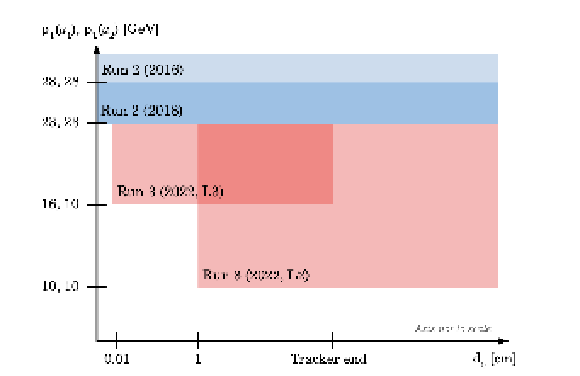
png pdf |
Figure 84:
Coverage in the ($ p_{\mathrm{T}} $, $ d_0 $) plane for displaced leptons with the 2016 and 2018 triggers, and the new Run-3 triggers, indicated in light blue, dark blue, and red, respectively [293]. Here, $ d_0 $ is the impact parameter of the charged lepton track with respect to the PV in the transverse plane. |
| Tables | |
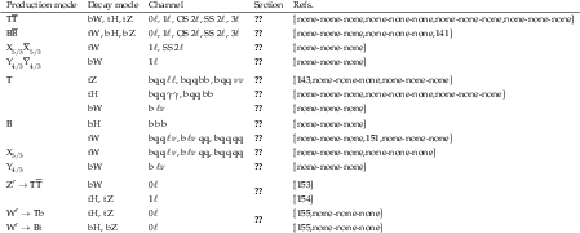
png pdf |
Table 1:
List of VLQ searches performed by the CMS experiment grouped by production mode. In this table, \ell denotes an electron or a muon. Additional jets in the final state are not explicitly listed in the table. The 0\ell channels correspond to the all-hadronic final state. For the 2\ell channels, it is indicated whether the leptons have opposite-sign (OS) or same-sign (SS) charges. For single VLQ searches, the channels are indicated through the decay products of the W, Z, and Higgs bosons, and t quarks. |
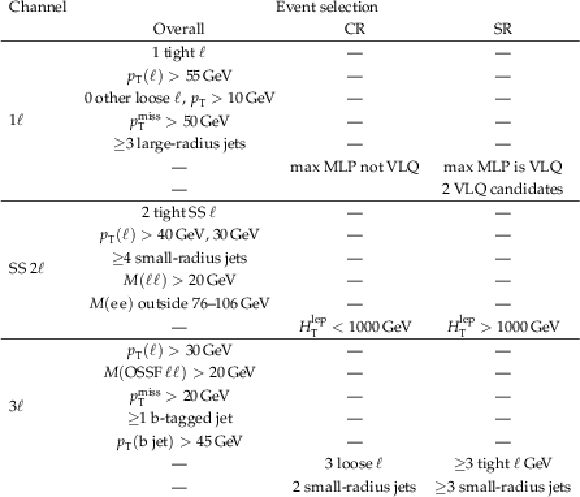
png pdf |
Table 2:
Summary of event selection criteria for the primary CRs and SRs in the three leptonic search channels. The phrase ``max MLP'' refers to the largest score from the single-lepton multilayer perceptron network. Table taken from Ref. [none-none-none]. |

png pdf |
Table 3:
Summary of channels considered for each category and jet multiplicity in the search for $ {\mathrm{B}} \overline{\mathrm{B}} $ production that specifically targets $ {\mathrm{B}} \to\mathrm{b}\mathrm{Z} $ and $ {\mathrm{B}} \to\mathrm{b}\mathrm{H} $ decays. Table adapted from Ref. [142]. |
| Summary |
| In this report, the physics program of the CMS experiment has been summarized for searches for physics beyond the standard model (SM) in the context of models that introduce vector-like quarks (VLQs), vector-like leptons (VLLs), and heavy neutral leptons (HNLs). Each of these three model classes provides a complementary perspective on the origin of mass of fundamental particles. The VLQs extend the SM with nonchiral partners of SM quarks, and the searches focus on VLQs that couple to the third-generation quarks. The VLLs, introduced in a class of models that can be particularly sensitive to leptonic anomalies, correspond to an analogous extension of the leptonic sector of the SM. These searches target charged-lepton partners. The HNLs provide yet another perspective on the interplay between chirality and neutrino mass-generating mechanisms, and produce distinct prompt and displaced signatures in the detector. These searches probe unexplored areas of parameter space in several models beyond the SM, using Run 2 proton-proton collision data sets collected by the CMS detector during the years 2015 to 2018 corresponding to an integrated luminosity of up to 138 fb$ ^{-1} $. Two new statistical combinations of searches for VLQs have been performed. Pair production of B quarks with mass below 1.49 TeV is excluded at 95% confidence level for any third-generation decay of the B quark. Single production of T quarks in the narrow-width approximation is excluded at 95% confidence level for T quark masses below 1.20 TeV. No evidence for physics beyond the SM has been observed, and stringent exclusion limits on new fermion masses and couplings have been placed. One search for VLLs, detailed in Section 8.3, shows a modest excess of the observed data over the background-only prediction that requires further investigation using more data. No VLQ and HNL searches report excesses. Using projections in the context of the future High-Luminosity LHC (HL-LHC) and the corresponding upgrades to the CMS detector, an increased discovery reach of new fermions well into the TeVns energy domain is expected. Although the environment of the HL-LHC with many simultaneous collisions will present new challenges for particle reconstruction and identification, searches for new fermions will benefit from the increased collision energy, unprecedented integrated luminosity, and the planned detector upgrades. Many of the searches presented in this report rely on identifying jets from the decays of massive SM particles, or feature high-pseudorapidity jets from $ t $-channel or vector boson fusion production modes. The expansion of the tracker volume and significant upgrades of the endcap calorimeter and muon detectors will provide improved jet reconstruction and identification at high pseudorapidity in the HL-LHC era. There are still unexplored regions of parameter space in various models beyond the SM involving VLQs, VLLs, and HNLs within reach of the LHC, that can yield a first glimpse of new physics in the near or longer term. This includes considering nonminimal VLQ extensions such as decays of VLQs to scalar or pseudoscalar bosons, exploring VLQ production modes such as electroweak pair production, and expanding the searches for VLQs assuming a finite decay width. Manifestations of VLLs in other models and final states than currently probed may also be considered, involving final states with muon detector shower signatures, final states with highly Lorentz-boosted decay products, or vector boson fusion modes of VLL pair production. Future runs of the LHC will bring great opportunities to explore new model phase spaces, detector upgrades will provide improved particle reconstruction, and continued efforts in innovating analysis techniques will further enhance the potential to discover new physics. |
| References | ||||
| 1 | A. Hebecker | The standard model and its hierarchy problem(s) | in Naturalness, string landscape and multiverse: A modern introduction with exercises, Springer International Publishing, Cham, 2021 link |
|
| 2 | Super-Kamiokande Collaboration | Evidence for oscillation of atmospheric neutrinos | PRL 81 (1998) 1562 | hep-ex/9807003 |
| 3 | SNO Collaboration | Measurement of the rate of $ {\nu_{\!\mathrm{e}}+\mathrm{d}\to\mathrm{p}+\mathrm{p}+\mathrm{e}^-} $ interactions produced by $^8$B solar neutrinos at the Sudbury Neutrino Observatory | PRL 87 (2001) 071301 | nucl-ex/0106015 |
| 4 | L. Randall and R. Sundrum | A large mass hierarchy from a small extra dimension | PRL 83 (1999) 3370 | hep-ph/9905221 |
| 5 | G.-Y. Huang, K. Kong, and S. C. Park | Bounds on the fermion-bulk masses in models with universal extra dimensions | JHEP 06 (2012) 099 | 1204.0522 |
| 6 | R. Contino, D. Pappadopulo, D. Marzocca, and R. Rattazzi | On the effect of resonances in composite Higgs phenomenology | JHEP 10 (2011) 081 | 1109.1570 |
| 7 | D. Greco and D. Liu | Hunting composite vector resonances at the LHC: naturalness facing data | JHEP 12 (2014) 126 | 1410.2883 |
| 8 | A. Falkowski, D. M. Straub, and A. Vicente | Vector-like leptons: Higgs decays and collider phenomenology | JHEP 05 (2014) 092 | 1312.5329 |
| 9 | J. A. Aguilar-Saavedra, R. Benbrik, S. Heinemeyer, and M. Pérez-Victoria | Handbook of vectorlike quarks: Mixing and single production | PRD 88 (2013) 094010 | 1306.0572 |
| 10 | R. Mohapatra and G. Senjanović | Neutrino mass and spontaneous parity nonconservation | PRL 44 (1980) 912 | |
| 11 | J. Schechter and J. Valle | Neutrino masses in $ \mathrm{SU}(2)\otimes\mathrm{U}(1) $ theories | PRD 22 (1980) 2227 | |
| 12 | R. Foot, H. Lew, X.-G. He, and G. C. Joshi | See-saw neutrino masses induced by a triplet of leptons | Z. Phys. C 44 (1989) 441 | |
| 13 | CMS Collaboration | The CMS experiment at the CERN LHC | JINST 3 (2008) S08004 | |
| 14 | CMS Collaboration | Performance of the CMS Level-1 trigger in proton-proton collisions at $ \sqrt{s}= $ 13 TeV | JINST 15 (2020) P10017 | CMS-TRG-17-001 2006.10165 |
| 15 | CMS Collaboration | The CMS trigger system | JINST 12 (2017) P01020 | CMS-TRG-12-001 1609.02366 |
| 16 | CMS Collaboration | Particle-flow reconstruction and global event description with the CMS detector | JINST 12 (2017) P10003 | CMS-PRF-14-001 1706.04965 |
| 17 | CMS Collaboration | Technical proposal for the Phase-II upgrade of the Compact Muon Solenoid | CMS Technical Proposal CERN-LHCC-2015-010, CMS-TDR-15-02, 2015 CDS |
|
| 18 | CMS Collaboration | Performance of photon reconstruction and identification with the CMS detector in proton-proton collisions at $ \sqrt{s}= $ 8 TeV | JINST 10 (2015) P08010 | CMS-EGM-14-001 1502.02702 |
| 19 | CMS Collaboration | Electron and photon reconstruction and identification with the CMS experiment at the CERN LHC | JINST 16 (2021) P05014 | CMS-EGM-17-001 2012.06888 |
| 20 | CMS Collaboration | ECAL 2016 refined calibration and Run2 summary plots | CMS Detector Performance Note CMS-DP-2020-021, 2020 CDS |
|
| 21 | CMS Collaboration | Performance of the CMS muon detector and muon reconstruction with proton-proton collisions at $ \sqrt{s}= $ 13 TeV | JINST 13 (2018) P06015 | CMS-MUO-16-001 1804.04528 |
| 22 | M. Cacciari, G. P. Salam, and G. Soyez | The anti-$ k_{\mathrm{T}} $ jet clustering algorithm | JHEP 04 (2008) 063 | 0802.1189 |
| 23 | M. Cacciari, G. P. Salam, and G. Soyez | FASTJET user manual | EPJC 72 (2012) 1896 | 1111.6097 |
| 24 | CMS Collaboration | Jet energy scale and resolution in the CMS experiment in $ {\mathrm{p}\mathrm{p}} $ collisions at 8 TeV | JINST 12 (2017) P02014 | CMS-JME-13-004 1607.03663 |
| 25 | D. Bertolini, P. Harris, M. Low, and N. Tran | Pileup per particle identification | JHEP 10 (2014) 059 | 1407.6013 |
| 26 | CMS Collaboration | Pileup mitigation at CMS in 13 TeV data | JINST 15 (2020) P09018 | CMS-JME-18-001 2003.00503 |
| 27 | CMS Collaboration | Identification of heavy-flavour jets with the CMS detector in $ {\mathrm{p}\mathrm{p}} $ collisions at 13 TeV | JINST 13 (2018) P05011 | CMS-BTV-16-002 1712.07158 |
| 28 | E. Bols et al. | Jet flavour classification using DeepJet | JINST 15 (2020) P12012 | 2008.10519 |
| 29 | CMS Collaboration | Performance of the DeepJet b tagging algorithm using 41.9 fb$ ^{-1} $ of data from proton-proton collisions at 13 TeV with Phase 1 CMS detector | CMS Detector Performance Note CMS-DP-2018-058, 2018 CDS |
|
| 30 | CMS Collaboration | Performance of reconstruction and identification of $ \tau $ leptons decaying to hadrons and $ \nu_{\!\tau} $ in $ {\mathrm{p}\mathrm{p}} $ collisions at $ \sqrt{s}= $ 13 TeV | JINST 13 (2018) P10005 | CMS-TAU-16-003 1809.02816 |
| 31 | CMS Collaboration | Identification of hadronic tau lepton decays using a deep neural network | JINST 17 (2022) P07023 | CMS-TAU-20-001 2201.08458 |
| 32 | CMS Collaboration | Performance of missing transverse momentum reconstruction in proton-proton collisions at $ \sqrt{s}= $ 13 TeV using the CMS detector | JINST 14 (2019) P07004 | CMS-JME-17-001 1903.06078 |
| 33 | CMS Tracker Group Collaboration | The CMS Phase-1 pixel detector upgrade | JINST 16 (2021) P02027 | 2012.14304 |
| 34 | CMS Collaboration | The Phase-2 upgrade of the CMS barrel calorimeters | CMS Technical Proposal CERN-LHCC-2017-011, CMS-TDR-015, 2017 CDS |
|
| 35 | CMS Collaboration | The Phase-2 upgrade of the CMS muon detectors | CMS Technical Proposal CERN-LHCC-2017-012, CMS-TDR-016, 2017 CDS |
|
| 36 | CMS Collaboration | The Phase-2 upgrade of the CMS endcap calorimeter | CMS Technical Proposal CERN-LHCC-2017-023, CMS-TDR-019, 2017 CDS |
|
| 37 | CMS Collaboration | A MIP timing detector for the CMS Phase-2 upgrade | CMS Technical Proposal CERN-LHCC-2019-003, CMS-TDR-020, 2019 CDS |
|
| 38 | CMS Collaboration | The Phase-2 upgrade of the CMS Level-1 trigger | CMS Technical Proposal CERN-LHCC-2020-004, CMS-TDR-021, 2020 CDS |
|
| 39 | CMS Collaboration | The Phase-2 upgrade of the CMS data acquisition and high level trigger | CMS Technical Proposal CERN-LHCC-2021-007, CMS-TDR-022, 2021 CDS |
|
| 40 | CMS Collaboration | Expected performance of the physics objects with the upgraded CMS detector at the HL-LHC | CMS Note CMS-NOTE-2018-006, 2018 CDS |
|
| 41 | CMS Collaboration | Precision luminosity measurement in proton-proton collisions at $ \sqrt{s}= $ 13 TeV in 2015 and 2016 at CMS | EPJC 81 (2021) 800 | CMS-LUM-17-003 2104.01927 |
| 42 | CMS Collaboration | CMS luminosity measurement for the 2017 data-taking period at $ \sqrt{s}= $ 13 TeV | CMS Physics Analysis Summary, 2018 CMS-PAS-LUM-17-004 |
CMS-PAS-LUM-17-004 |
| 43 | CMS Collaboration | CMS luminosity measurement for the 2018 data-taking period at $ \sqrt{s}= $ 13 TeV | CMS Physics Analysis Summary, 2019 CMS-PAS-LUM-18-002 |
CMS-PAS-LUM-18-002 |
| 44 | J. Alwall et al. | The automated computation of tree-level and next-to-leading order differential cross sections, and their matching to parton shower simulations | JHEP 07 (2014) 079 | 1405.0301 |
| 45 | T. Sjöstrand, S. Mrenna, and P. Z. Skands | A brief introduction to PYTHIA8.1 | Comput. Phys. Commun. 178 (2008) 852 | 0710.3820 |
| 46 | P. Artoisenet, R. Frederix, O. Mattelaer, and R. Rietkerk | Automatic spin-entangled decays of heavy resonances in Monte Carlo simulations | JHEP 03 (2013) 015 | 1212.3460 |
| 47 | F. del Aguila and M. J. Bowick | The possibility of new fermions with $ {\Delta i=0} $ mass | NPB 224 (1983) 107 | |
| 48 | P. M. Fishbane, R. E. Norton, and M. J. Rivard | Experimental implications of heavy, isosinglet quarks and leptons | PRD 33 (1986) 2632 | |
| 49 | P. M. Fishbane and P. Q. Hung | Lepton masses in a dynamical model of family symmetry | Z. Phys. C 38 (1988) 649 | |
| 50 | I. Montvay | Three mirror pairs of fermion families | PLB 205 (1988) 315 | |
| 51 | K. Fujikawa | A vector-like extension of the standard model | Prog. Theor. Phys. 92 (1994) 1149 | hep-ph/9411258 |
| 52 | N. Kumar and S. P. Martin | Vectorlike leptons at the Large Hadron Collider | PRD 92 (2015) 115018 | 1510.03456 |
| 53 | P. N. Bhattiprolu and S. P. Martin | Prospects for vectorlike leptons at future proton-proton colliders | PRD 100 (2019) 015033 | 1905.00498 |
| 54 | L. Di Luzio, A. Greljo, and M. Nardecchia | Gauge leptoquark as the origin of $ {\mathrm{B}} $-physics anomalies | PRD 96 (2017) 115011 | 1708.08450 |
| 55 | L. Di Luzio et al. | Maximal flavour violation: a Cabibbo mechanism for leptoquarks | JHEP 11 (2018) 081 | 1808.00942 |
| 56 | M. Bordone, C. Cornella, J. Fuentes-Martín, and G. Isidori | A three-site gauge model for flavor hierarchies and flavor anomalies | PLB 779 (2018) 317 | 1712.01368 |
| 57 | A. Greljo and B. A. Stefanek | Third family quark-lepton unification at the TeV scale | PLB 782 (2018) 131 | 1802.04274 |
| 58 | C. Cornella et al. | Reading the footprints of the $ {\mathrm{B}} $-meson flavor anomalies | JHEP 08 (2021) 050 | 2103.16558 |
| 59 | V. Brdar, A. J. Helmboldt, S. Iwamoto, and K. Schmitz | Type-I seesaw mechanism as the common origin of neutrino mass, baryon asymmetry, and the electroweak scale | PRD 100 (2019) 075029 | 1905.12634 |
| 60 | B. Fuks, M. Klasen, D. R. Lamprea, and M. Rothering | Gaugino production in proton-proton collisions at a center-of-mass energy of 8 TeV | JHEP 10 (2012) 081 | 1207.2159 |
| 61 | B. Fuks, M. Klasen, D. R. Lamprea, and M. Rothering | Precision predictions for electroweak superpartner production at hadron colliders with resummino | EPJC 73 (2013) 2480 | 1304.0790 |
| 62 | P. Nason | A new method for combining NLO QCD with shower Monte Carlo algorithms | JHEP 11 (2004) 040 | hep-ph/0409146 |
| 63 | S. Frixione, P. Nason, and C. Oleari | Matching NLO QCD computations with parton shower simulations: the POWHEG method | JHEP 11 (2007) 070 | 0709.2092 |
| 64 | S. Alioli, P. Nason, C. Oleari, and E. Re | A general framework for implementing NLO calculations in shower Monte Carlo programs: the POWHEG box | JHEP 06 (2010) 043 | 1002.2581 |
| 65 | T. Melia, P. Nason, R. Röntsch, and G. Zanderighi | $ {\mathrm{W^+}\mathrm{W^-}} $, $ {\mathrm{W}\mathrm{Z}} $ and $ {\mathrm{Z}\mathrm{Z}} $ production in the POWHEG box | JHEP 11 (2011) 078 | 1107.5051 |
| 66 | P. Nason and G. Zanderighi | $ {\mathrm{W^+}\mathrm{W^-}} $, $ {\mathrm{W}\mathrm{Z}} $ and $ {\mathrm{Z}\mathrm{Z}} $ production in the POWHEG -box-v2 | EPJC 74 (2014) 2702 | 1311.1365 |
| 67 | J. M. Campbell and R. K. Ellis | MCFM for the Tevatron and the LHC | in Proc. 10th DESY Workshop on Elementary Particle Theory: Loops and Legs in Quantum Field Theory (LL): Wörlitz, Germany, 2010 link |
1007.3492 |
| 68 | S. Frixione, G. Ridolfi, and P. Nason | A positive-weight next-to-leading-order Monte Carlo for heavy flavour hadroproduction | JHEP 09 (2007) 126 | 0707.3088 |
| 69 | S. Alioli, P. Nason, C. Oleari, and E. Re | NLO single-top production matched with shower in POWHEG: $ s $- and $ t $-channel contributions | JHEP 09 (2009) 111 | 0907.4076 |
| 70 | E. Re | Single-top $ {\mathrm{W}\mathrm{t}} $-channel production matched with parton showers using the POWHEG method | EPJC 71 (2011) 1547 | 1009.2450 |
| 71 | Y. Gao et al. | Spin determination of single-produced resonances at hadron colliders | PRD 81 (2010) 075022 | 1001.3396 |
| 72 | S. Bolognesi et al. | On the spin and parity of a single-produced resonance at the LHC | PRD 86 (2012) 095031 | 1208.4018 |
| 73 | I. Anderson et al. | Constraining anomalous $ {\mathrm{H}\mathrm{V}\mathrm{V}} $ interactions at proton and lepton colliders | PRD 89 (2014) 035007 | 1309.4819 |
| 74 | A. V. Gritsan, R. Röntsch, M. Schulze, and M. Xiao | Constraining anomalous Higgs boson couplings to the heavy-flavor fermions using matrix element techniques | PRD 94 (2016) 055023 | 1606.03107 |
| 75 | NNPDF Collaboration | Parton distributions for the LHC run II | JHEP 04 (2015) 040 | 1410.8849 |
| 76 | NNPDF Collaboration | Parton distributions from high-precision collider data | EPJC 77 (2017) 663 | 1706.00428 |
| 77 | CMS Collaboration | Event generator tunes obtained from underlying event and multiparton scattering measurements | EPJC 76 (2016) 155 | CMS-GEN-14-001 1512.00815 |
| 78 | CMS Collaboration | Investigations of the impact of the parton shower tuning in PYTHIA8 in the modelling of $ \mathrm{t} \overline{\mathrm{t}} $ at $ \sqrt{s}= $ 8 and 13 TeV | CMS Physics Analysis Summary, 2016 CMS-PAS-TOP-16-021 |
CMS-PAS-TOP-16-021 |
| 79 | CMS Collaboration | Extraction and validation of a new set of CMS PYTHIA8 tunes from underlying-event measurements | EPJC 80 (2020) 4 | CMS-GEN-17-001 1903.12179 |
| 80 | S. Höche et al. | Matching parton showers and matrix elements | in Proc. HERA and the LHC: A Workshop on the Implications of HERA for LHC Physics: Geneva and Hamburg, 2004 link |
hep-ph/0602031 |
| 81 | R. Frederix and S. Frixione | Merging meets matching in MC@NLO | JHEP 12 (2012) 061 | 1209.6215 |
| 82 | GEANT4 Collaboration | GEANT 4---a simulation toolkit | NIM A 506 (2003) 250 | |
| 83 | S. D. Ellis, C. K. Vermilion, and J. R. Walsh | Recombination algorithms and jet substructure: Pruning as a tool for heavy particle searches | PRD 81 (2010) 094023 | 0912.0033 |
| 84 | A. J. Larkoski, S. Marzani, G. Soyez, and J. Thaler | Soft drop | JHEP 05 (2014) 146 | 1402.2657 |
| 85 | Y. L. Dokshitzer, G. D. Leder, S. Moretti, and B. R. Webber | Better jet clustering algorithms | JHEP 08 (1997) 001 | hep-ph/9707323 |
| 86 | M. Wobisch and T. Wengler | Hadronization corrections to jet cross-sections in deep inelastic scattering | in Proc. Workshop on Monte Carlo Generators for HERA Physics: Hamburg, 1998 link |
hep-ph/9907280 |
| 87 | J. Thaler and K. Van Tilburg | Identifying boosted objects with $ {N} $-subjettiness | JHEP 03 (2011) 015 | 1011.2268 |
| 88 | J. Dolen et al. | Thinking outside the ROCs: Designing decorrelated taggers (DDT) for jet substructure | JHEP 05 (2016) 156 | 1603.00027 |
| 89 | CMS Collaboration | Identification of heavy, energetic, hadronically decaying particles using machine-learning techniques | JINST 15 (2020) P06005 | CMS-JME-18-002 2004.08262 |
| 90 | CMS Collaboration | Measurement of differential cross sections for top quark pair production using the lepton+jets final state in proton-proton collisions at 13 TeV | PRD 95 (2017) 092001 | CMS-TOP-16-008 1610.04191 |
| 91 | CMS Collaboration | Measurements of $ \mathrm{t} \overline{\mathrm{t}} $ differential cross sections in proton-proton collisions at $ \sqrt{s}= $ 13 TeV using events containing two leptons | JHEP 02 (2019) 149 | CMS-TOP-17-014 1811.06625 |
| 92 | J. Wong | Search for pair production of vector-like quarks in leptonic final states in proton-proton collisions at 13 TeV at the CMS detector in the LHC | PhD thesis, Brown University, 2022 CERN-THESIS-2022-038 |
|
| 93 | R. A. Fisher | On the interpretation of $ \chi^2 $ from contingency tables, and the calculation of $ {P} $ | J. R. Stat. Soc 85 (1922) 87 | |
| 94 | R. Barlow and C. Beeston | Fitting using finite Monte Carlo samples | Comput. Phys. Commun. 77 (1993) 219 | |
| 95 | J. S. Conway | Incorporating nuisance parameters in likelihoods for multisource spectra | in Proc. 2011 Workshop on Statistical Issues Related to Discovery Claims in Search Experiments and Unfolding (PHYSTAT ): Geneva, 2011 link |
1103.0354 |
| 96 | T. Junk | Confidence level computation for combining searches with small statistics | NIM A 434 (1999) 435 | hep-ex/9902006 |
| 97 | A. L. Read | Presentation of search results: The $ \text{CL}_\text{s} $ technique | JPG 28 (2002) 2693 | |
| 98 | G. Cowan, K. Cranmer, E. Gross, and O. Vitells | Asymptotic formulae for likelihood-based tests of new physics | EPJC 71 (2011) 1554 | 1007.1727 |
| 99 | CMS Collaboration | The CMS statistical analysis and combination tool: combine | Submitted to Comput. Softw. Big Sci, 2024 | CMS-CAT-23-001 2404.06614 |
| 100 | W. Verkerke and D. Kirkby | The RooFit toolkit for data modeling | in Proc. 13th International Conference on Computing in High Energy and Nuclear Physics (CHEP ): La Jolla CA, 2003 eConf C0303241 MOLT007 |
physics/0306116 |
| 101 | ATLAS and CMS Collaborations, and LHC Higgs Combination Group | Procedure for the LHC Higgs boson search combination in Summer 2011 | Technical Report CMS-NOTE-2011-005, ATL-PHYS-PUB-2011-11, 2011 | |
| 102 | K. Agashe, R. Contino, and A. Pomarol | The minimal composite Higgs model | NPB 719 (2005) 165 | hep-ph/0412089 |
| 103 | M. Perelstein | Little Higgs models and their phenomenology | Prog. Part. Nucl. Phys. 58 (2007) 247 | hep-ph/0512128 |
| 104 | S. P. Martin | Extra vectorlike matter and the lightest Higgs scalar boson mass in low-energy supersymmetry | PRD 81 (2010) 035004 | 0910.2732 |
| 105 | J. A. Aguilar-Saavedra, D. E. López-Fogliani, and C. Muñoz | Novel signatures for vector-like quarks | JHEP 06 (2017) 095 | 1705.02526 |
| 106 | S. Zheng | Minimal vectorlike model in supersymmetric unification | EPJC 80 (2020) 273 | 1904.10145 |
| 107 | O. Eberhardt et al. | Joint analysis of Higgs boson decays and electroweak precision observables in the standard model with a sequential fourth generation | PRD 86 (2012) 013011 | 1204.3872 |
| 108 | R. Contino, T. Kramer, M. Son, and R. Sundrum | Warped/composite phenomenology simplified | JHEP 05 (2007) 074 | hep-ph/0612180 |
| 109 | C. Bini, R. Contino, and N. Vignaroli | Heavy-light decay topologies as a new strategy to discover a heavy gluon | JHEP 01 (2012) 157 | 1110.6058 |
| 110 | M. Chala, J. Juknevich, G. Perez, and J. Santiago | The elusive gluon | JHEP 01 (2015) 092 | 1411.1771 |
| 111 | G. F. Giudice, C. Grojean, A. Pomarol, and R. Rattazzi | The strongly-interacting light Higgs | JHEP 06 (2007) 045 | hep-ph/0703164 |
| 112 | A. De Simone, O. Matsedonskyi, R. Rattazzi, and A. Wulzer | A first top partner hunter's guide | JHEP 04 (2013) 004 | 1211.5663 |
| 113 | O. Matsedonskyi, G. Panico, and A. Wulzer | Top partners searches and composite Higgs models | JHEP 04 (2016) 003 | 1512.04356 |
| 114 | D. Marzocca, M. Serone, and J. Shu | General composite Higgs models | JHEP 08 (2012) 013 | 1205.0770 |
| 115 | A. Pomarol and F. Riva | The composite Higgs and light resonance connection | JHEP 08 (2012) 135 | 1205.6434 |
| 116 | J. A. Aguilar-Saavedra | Identifying top partners at LHC | JHEP 11 (2009) 030 | 0907.3155 |
| 117 | A. Deandrea et al. | Single production of vector-like quarks: the effects of large width, interference and NLO corrections | JHEP 08 (2021) 107 | 2105.08745 |
| 118 | B. Fuks and H.-S. Shao | QCD next-to-leading-order predictions matched to parton showers for vector-like quark models | EPJC 77 (2017) 135 | 1610.04622 |
| 119 | G. Cacciapaglia et al. | Next-to-leading-order predictions for single vector-like quark production at the LHC | PLB 793 (2019) 206 | 1811.05055 |
| 120 | J. A. Aguilar-Saavedra | Mixing with vector-like quarks: constraints and expectations | in Proc. 1st Large Hadron Collider Physics Conference (LHCP ): Barcelona, 2013 EPJ Web Conf. 60 (2013) 16012 |
1306.4432 |
| 121 | A. Banerjee et al. | Phenomenological aspects of composite Higgs scenarios: exotic scalars and vector-like quarks | in Proc. 2021 US Community Study on the Future of Particle Physics (Snowmass ): Seattle WA, 2021 link |
2203.07270 |
| 122 | A. Banerjee, D. B. Franzosi, and G. Ferretti | Modelling vector-like quarks in partial compositeness framework | JHEP 03 (2022) 200 | 2202.00037 |
| 123 | G. Cacciapaglia, T. Flacke, M. Park, and M. Zhang | Exotic decays of top partners: Mind the search gap | PLB 798 (2019) 135015 | 1908.07524 |
| 124 | R. Benbrik et al. | Signatures of vector-like top partners decaying into new neutral scalar or pseudoscalar bosons | JHEP 05 (2020) 028 | 1907.05929 |
| 125 | J. A. Aguilar-Saavedra, J. Alonso-González, L. Merlo, and J. M. No | Exotic vectorlike quark phenomenology in the minimal linear $ \sigma $ model | PRD 101 (2020) 035015 | 1911.10202 |
| 126 | B. A. Dobrescu and F. Yu | Exotic signals of vectorlike quarks | JPG 45 (2018) 08LT01 | 1612.01909 |
| 127 | M. Czakon, P. Fiedler, and A. Mitov | Total top-quark pair-production cross section at hadron colliders through $ \mathcal{O}({\alpha_\mathrm{S}}^4) $ | PRL 110 (2013) 252004 | 1303.6254 |
| 128 | O. Matsedonskyi, G. Panico, and A. Wulzer | On the interpretation of top partners searches | JHEP 12 (2014) 097 | 1409.0100 |
| 129 | M. Czakon and A. Mitov | TOP++: a program for the calculation of the top-pair cross-section at hadron colliders | Comput. Phys. Commun. 185 (2014) 2930 | 1112.5675 |
| 130 | J. M. Campbell, R. K. Ellis, and F. Tramontano | Single top production and decay at next-to-leading order | PRD 70 (2004) 094012 | hep-ph/0408158 |
| 131 | A. Carvalho et al. | Single production of vectorlike quarks with large width at the Large Hadron Collider | PRD 98 (2018) 015029 | 1805.06402 |
| 132 | C. Degrande et al. | UFO---the universal FeynRules output | Comput. Phys. Commun. 183 (2012) 1201 | 1108.2040 |
| 133 | ATLAS Collaboration | Search for single production of a vectorlike T quark decaying into a Higgs boson and top quark with fully hadronic final states using the ATLAS detector | PRD 105 (2022) 092012 | 2201.07045 |
| 134 | M. Buchkremer, G. Cacciapaglia, A. Deandrea, and L. Panizzi | Model-independent framework for searches of top partners | NPB 876 (2013) 376 | 1305.4172 |
| 135 | CMS Collaboration | Search for vector-like charge 2/3 T quarks in proton-proton collisions at $ \sqrt{s}= $ 8 TeV | PRD 93 (2016) 012003 | 1509.04177 |
| 136 | CMS Collaboration | Search for pair-produced vectorlike B quarks in proton-proton collisions at $ \sqrt{s}= $ 8 TeV | PRD 93 (2016) 112009 | 1507.07129 |
| 137 | CMS Collaboration | Search for vector-like light-flavor quark partners in proton-proton collisions at $ \sqrt{s}= $ 8 TeV | PRD 97 (2018) 072008 | 1708.02510 |
| 138 | CMS Collaboration | Search for pair production of vector-like quarks in the $ {\mathrm{b}\mathrm{W}\overline{\mathrm{b}}\mathrm{W}} $ channel from proton-proton collisions at $ \sqrt{s}= $ 13 TeV | PLB 779 (2018) 82 | 1710.01539 |
| 139 | CMS Collaboration | Search for vector-like quarks in events with two oppositely charged leptons and jets in proton-proton collisions at $ \sqrt{s}= $ 13 TeV | EPJC 79 (2019) 364 | 1812.09768 |
| 140 | CMS Collaboration | Search for pair production of vector-like quarks in the fully hadronic final state | PRD 100 (2019) 072001 | 1906.11903 |
| 141 | CMS Collaboration | Search for pair production of vector-like quarks in leptonic final states in proton-proton collisions at $ \sqrt{s}= $ 13 TeV | JHEP 07 (2023) 020 | 2209.07327 |
| 142 | CMS Collaboration | A search for bottom-type vector-like quark pair production in dileptonic and fully hadronic final states in proton-proton collisions at $ \sqrt{s}= $ 13 TeV | Submitted to Phys. Rev. D, 2024 | 2402.13808 |
| 143 | CMS Collaboration | Search for top quark partners with charge 5/3 in the same-sign dilepton and single-lepton final states in proton-proton collisions at $ \sqrt{s}= $ 13 TeV | JHEP 03 (2019) 082 | 1810.03188 |
| 144 | CMS Collaboration | Search for single production of a vector-like T quark decaying to a Z boson and a top quark in proton-proton collisions at $ \sqrt{s}= $ 13 TeV | PLB 781 (2018) 574 | 1708.01062 |
| 145 | CMS Collaboration | Search for electroweak production of a vector-like T quark using fully hadronic final states | JHEP 01 (2020) 036 | 1909.04721 |
| 146 | CMS Collaboration | Search for single production of a vector-like T quark decaying to a top quark and a Z boson in the final state with jets and missing transverse momentum at $ \sqrt{s}= $ 13 TeV | JHEP 05 (2022) 093 | 2201.02227 |
| 147 | CMS Collaboration | Search for a vector-like quark $ {{\mathrm{T}} ^\prime\to\mathrm{t}\mathrm{H}} $ via the diphoton decay mode of the Higgs boson in proton-proton collisions at $ \sqrt{s}= $ 13 TeV | JHEP 09 (2023) 057 | 2302.12802 |
| 148 | CMS Collaboration | Search for production of single vector-like quarks decaying to $ {\mathrm{t}\mathrm{H}} $ or $ {\mathrm{t}\mathrm{Z}} $ in the all-hadronic final state in $ {\mathrm{p}\mathrm{p}} $ collisions at $ \sqrt{s}= $ 13 TeV | Submitted to Phys. Rev. D, 2024 | 2405.05071 |
| 149 | CMS Collaboration | Search for single production of vector-like quarks decaying into a b quark and a W boson in proton-proton collisions at $ \sqrt{s}= $ 13 TeV | PLB 772 (2017) 634 | 1701.08328 |
| 150 | CMS Collaboration | Search for single production of vector-like quarks decaying to a b quark and a Higgs boson | JHEP 06 (2018) 031 | 1802.01486 |
| 151 | CMS Collaboration | Search for single production of vector-like quarks decaying to a top quark and a W boson in proton-proton collisions at $ \sqrt{s}= $ 13 TeV | EPJC 79 (2019) 90 | 1809.08597 |
| 152 | CMS Collaboration | Search for a heavy resonance decaying to a top quark and a W boson at $ \sqrt{s}= $ 13 TeV in the fully hadronic final state | JHEP 12 (2021) 106 | 2104.12853 |
| 153 | CMS Collaboration | Search for a heavy resonance decaying into a top quark and a W boson in the lepton+jets final state at $ \sqrt{s}= $ 13 TeV | JHEP 04 (2022) 048 | 2111.10216 |
| 154 | CMS Collaboration | Search for a heavy resonance decaying to a top quark and a vector-like top quark at $ \sqrt{s}= $ 13 TeV | JHEP 09 (2017) 053 | 1703.06352 |
| 155 | CMS Collaboration | Search for a heavy resonance decaying to a top quark and a vector-like top quark in the lepton+jets final state in $ {\mathrm{p}\mathrm{p}} $ collisions at $ \sqrt{s}= $ 13 TeV | EPJC 79 (2019) 208 | 1812.06489 |
| 156 | CMS Collaboration | Search for a $ \mathrm{W^{'}} $ boson decaying to a vector-like quark and a top or bottom quark in the all-jets final state | JHEP 03 (2019) 127 | 1811.07010 |
| 157 | CMS Collaboration | Search for a $ \mathrm{W^{'}} $ boson decaying to a vector-like quark and a top or bottom quark in the all-jets final state at $ \sqrt{s}= $ 13 TeV | JHEP 09 (2022) 088 | 2202.12988 |
| 158 | CMS Collaboration | Search for vector-like T and B quark pairs in final states with leptons at $ \sqrt{s}= $ 13 TeV | JHEP 08 (2018) 177 | 1805.04758 |
| 159 | CMS Collaboration | A search for bottom-type, vector-like quark pair production in a fully hadronic final state in proton-proton collisions at $ \sqrt{s}= $ 13 TeV | PRD 102 (2020) 112004 | 2008.09835 |
| 160 | S. Banerjee et al. | Phenomenological analysis of multi-pseudoscalar mediated dark matter models | JHEP 07 (2022) 111 | 2110.15391 |
| 161 | A. Carvalho | Gravity particles from warped extra dimensions, predictions for LHC | 1404.0102 | |
| 162 | CMS Collaboration | Measurements of Higgs boson production cross sections and couplings in the diphoton decay channel at $ \sqrt{s}= $ 13 TeV | JHEP 07 (2021) 027 | CMS-HIG-19-015 2103.06956 |
| 163 | H. Voss, A. Höcker, J. Stelzer, and F. Tegenfeldt | TMVA, the toolkit for multivariate data analysis with ROOT | in Proc. 11th International Workshop on Advanced Computing and Analysis Techniques in Physics Research (ACAT ): Amsterdam, 2017 PoS (ACAT2017) 040 |
physics/0703039 |
| 164 | P. D. Dauncey, M. Kenzie, N. Wardle, and G. J. Davies | Handling uncertainties in background shapes: the discrete profiling method | JINST 10 (2015) P04015 | 1408.6865 |
| 165 | T. Lapsien, R. Kogler, and J. Haller | A new tagger for hadronically decaying heavy particles at the LHC | EPJC 76 (2016) 600 | 1606.04961 |
| 166 | J. P. Araque, N. F. Castro, and J. Santiago | Interpretation of vector-like quark searches: heavy gluons in composite Higgs models | JHEP 11 (2015) 120 | 1507.05628 |
| 167 | D. Liu, L.-T. Wang, and K.-P. Xie | Prospects of searching for composite resonances at the LHC and beyond | JHEP 01 (2019) 157 | 1810.08954 |
| 168 | A. Deandrea and A. M. Iyer | Vectorlike quarks and heavy colored bosons at the LHC | PRD 97 (2018) 055002 | 1710.01515 |
| 169 | N. Vignaroli | New $ \mathrm{W^{'}} $ signals at the LHC | PRD 89 (2014) 095027 | 1404.5558 |
| 170 | CMS Collaboration | Search for a vector-like quark T decaying to $ {\mathrm{b}\mathrm{W}} $, $ {\mathrm{t}\mathrm{Z}} $, $ {\mathrm{t}\mathrm{H}} $ in the single lepton final state at the HL-LHC | CMS Physics Analysis Summary, 2022 CMS-PAS-FTR-22-002 |
CMS-PAS-FTR-22-002 |
| 171 | DELPHES 3 Collaboration | delphes 3: a modular framework for fast simulation of a generic collider experiment | JHEP 02 (2014) 057 | 1307.6346 |
| 172 | X. Cid Vidal et al. | Report from working group 3: Beyond the standard model physics at the HL-LHC and HE-LHC | CERN Report CERN-LPCC-2018-05, 2019 link |
1812.07831 |
| 173 | P. W. Graham, A. Ismail, S. Rajendran, and P. Saraswat | A little solution to the little hierarchy problem: A vectorlike generation | PRD 81 (2010) 055016 | 0910.3020 |
| 174 | M. Endo, K. Hamaguchi, S. Iwamoto, and N. Yokozaki | Higgs mass and muon anomalous magnetic moment in supersymmetric models with vectorlike matters | PRD 84 (2011) 075017 | 1108.3071 |
| 175 | J. A. Aguilar-Saavedra | Heavy lepton pair production at LHC: Model discrimination with multi-lepton signals | NPB 828 (2010) 289 | 0905.2221 |
| 176 | K. Kong, S. C. Park, and T. G. Rizzo | A vector-like fourth generation with a discrete symmetry from Split-UED | JHEP 07 (2010) 059 | 1004.4635 |
| 177 | R. Nevzorov | E$_{6}$ inspired supersymmetric models with exact custodial symmetry | PRD 87 (2013) 015029 | 1205.5967 |
| 178 | I. Doršner, S. Fajfer, and I. Mustać | Light vector-like fermions in a minimal $ {SU(5)} $ setup | PRD 89 (2014) 115004 | 1401.6870 |
| 179 | A. Joglekar and J. L. Rosner | Searching for signatures of E$_{6}$ | PRD 96 (2017) 015026 | 1607.06900 |
| 180 | P. Schwaller, T. M. P. Tait, and R. Vega-Morales | Dark matter and vectorlike leptons from gauged lepton number | PRD 88 (2013) 035001 | 1305.1108 |
| 181 | J. Halverson, N. Orlofsky, and A. Pierce | Vectorlike leptons as the tip of the dark matter iceberg | PRD 90 (2014) 015002 | 1403.1592 |
| 182 | S. Bahrami et al. | Dark matter and collider studies in the left-right symmetric model with vectorlike leptons | PRD 95 (2017) 095024 | 1612.06334 |
| 183 | S. Bhattacharya, P. Ghosh, N. Sahoo, and N. Sahu | Mini review on vector-like leptonic dark matter, neutrino mass, and collider signatures | Front. Phys. 7 (2019) 80 | 1812.06505 |
| 184 | K. Agashe, T. Okui, and R. Sundrum | Common origin for neutrino anarchy and charged hierarchies | PRL 102 (2009) 101801 | 0810.1277 |
| 185 | M. Redi | Leptons in composite MFV | JHEP 09 (2013) 060 | 1306.1525 |
| 186 | R. Dermíšek and A. Raval | Explanation of the muon $ g{-} $ 2 anomaly with vectorlike leptons and its implications for Higgs decays | PRD 88 (2013) 013017 | 1305.3522 |
| 187 | E. Megí as, M. Quirós, and L. Salas | $ {g_{\mu}-2} $ from vector-like leptons in warped space | JHEP 05 (2017) 016 | 1701.05072 |
| 188 | J. Kawamura, S. Raby, and A. Trautner | Complete vectorlike fourth family and new $ {U(1)^\prime} $ for muon anomalies | PRD 100 (2019) 055030 | 1906.11297 |
| 189 | G. Hiller, C. Hormigos-Feliu, D. F. Litim, and T. Steudtner | Model building from asymptotic safety with Higgs and flavor portals | PRD 102 (2020) 095023 | 2008.08606 |
| 190 | Muon $g {-} 2$ Collaboration | Final report of the E821 muon anomalous magnetic moment measurement at BNL | PRD 73 (2006) 072003 | hep-ex/0602035 |
| 191 | Muon $g {-} 2$ Collaboration | Measurement of the positive muon anomalous magnetic moment to 0.46\unitppm | PRL 126 (2021) 141801 | 2104.03281 |
| 192 | L3 Collaboration | Search for heavy neutral and charged leptons in $ \mathrm{e}^+ \mathrm{e}^- $ annihilation at LEP | PLB 517 (2001) 75 | hep-ex/0107015 |
| 193 | R. Dermíšek, A. Raval, and S. Shin | Effects of vectorlike leptons on $ {\mathrm{h}\to4\ell} $ and the connection to the muon $ g{-} $ 2 anomaly | PRD 90 (2014) 034023 | 1406.7018 |
| 194 | R. Dermíšek, J. P. Hall, E. Lunghi, and S. Shin | Limits on vectorlike leptons from searches for anomalous production of multi-lepton events | JHEP 12 (2014) 013 | 1408.3123 |
| 195 | CDF Collaboration | Measurement of the ratio $ \mathcal{B}(\mathrm{W}\to\tau\nu)/\mathcal{B}(\mathrm{W}\to\mathrm{e}\nu) $ in $ {\mathrm{p}\overline{\mathrm{p}}} $ collisions at $ \sqrt{s}= $ 1.8 TeV | PRL 68 (1992) 3398 | |
| 196 | \DZERO Collaboration | A measurement of the $ {\mathrm{W}\to\tau\nu} $ production cross section in $ {\mathrm{p}\overline{\mathrm{p}}} $ collisions at $ \sqrt{s}= $ 1.8 TeV | PRL 84 (2000) 5710 | hep-ex/9912065 |
| 197 | LHCb Collaboration | Measurement of forward $ {\mathrm{W}\to\mathrm{e}\nu} $ production in $ {\mathrm{p}\mathrm{p}} $ collisions at $ \sqrt{s}= $ 8 TeV | JHEP 10 (2016) 030 | 1608.01484 |
| 198 | ATLAS Collaboration | Test of the universality of $ \tau $ and $ \mu $ lepton couplings in W-boson decays with the ATLAS detector | Nature Phys. 17 (2021) 813 | 2007.14040 |
| 199 | LHCb Collaboration | Test of lepton flavor universality by the measurement of the $ {{\mathrm{B}^0}\to \mathrm{D}_{s}^{*-}\tau^{+}\nu_{\!\tau}} $ branching fraction using three-prong $ \tau $ decays | PRD 97 (2018) 072013 | 1711.02505 |
| 200 | Belle Collaboration | Measurement of the $ \tau $ lepton polarization and $ {R(\mathrm{D}^{*})} $ in the decay $ {\overline{\mathrm{B}}\to\mathrm{D}^{*}\tau^{-}\overline{\nu}_{\!\tau}} $ with one-prong hadronic $ \tau $ decays at Belle | PRD 97 (2018) 012004 | 1709.00129 |
| 201 | LHCb Collaboration | Measurement of the ratio of the $ {\mathrm{B}^0}\to\mathrm{D}^{*-}\tau^{+}\nu_{\!\tau} $ and $ {\mathrm{B}^0}\to\mathrm{D}^{*-}\mu^{+}\nu_{\!\mu} $ branching fractions using three-prong $ \tau $-lepton decays | PRL 120 (2018) 171802 | 1708.08856 |
| 202 | Belle Collaboration | Measurement of $ \mathcal{R}(\mathrm{D}) $ and $ \mathcal{R}(\mathrm{D}^{*}) $ with a semileptonic tagging method | PRL 124 (2020) 161803 | 1910.05864 |
| 203 | CMS Collaboration | Search for vector-like leptons in multilepton final states in proton-proton collisions at $ \sqrt{s}= $ 13 TeV | PRD 100 (2019) 052003 | CMS-EXO-18-005 1905.10853 |
| 204 | CMS Collaboration | Inclusive nonresonant multilepton probes of new phenomena at $ \sqrt{s}= $ 13 TeV | PRD 105 (2022) 112007 | CMS-EXO-21-002 2202.08676 |
| 205 | CMS Collaboration | Search for pair-produced vector-like leptons in final states with third-generation leptons and at least three b quark jets in proton-proton collisions at $ \sqrt{s}= $ 13 TeV | PLB 846 (2023) 137713 | 2208.09700 |
| 206 | CMS Collaboration | Performance of b tagging algorithms in proton-proton collisions at 13 TeV with Phase 1 CMS detector | CMS Detector Performance Note CMS-DP-2018-033, 2018 CDS |
|
| 207 | V. Mikuni and F. Canelli | ABCNet: an attention-based method for particle tagging | Eur. Phys. J. Plus 135 (2020) 463 | 2001.05311 |
| 208 | M. Fukugita and T. Yanagida | Baryogenesis without grand unification | PLB 174 (1986) 45 | |
| 209 | S. Davidson, E. Nardi, and Y. Nir | Leptogenesis | Phys. Rept. 466 (2008) 105 | 0802.2962 |
| 210 | P. Minkowski | $ {\mu\to\mathrm{e}\gamma} $ at a rate of one out of $ 10^9 $ muon decays? | PLB 67 (1977) 421 | |
| 211 | M. Magg and C. Wetterich | Neutrino mass problem and gauge hierarchy | PLB 94 (1980) 61 | |
| 212 | R. N. Mohapatra and G. Senjanović | Neutrino masses and mixings in gauge models with spontaneous parity violation | PRD 23 (1981) 165 | |
| 213 | J. Schechter and J. W. F. Valle | Neutrino decay and spontaneous violation of lepton number | PRD 25 (1982) 774 | |
| 214 | T. Asaka, S. Blanchet, and M. Shaposhnikov | The \PGnMSM, dark matter and neutrino masses | PLB 631 (2005) 151 | hep-ph/0503065 |
| 215 | A. Datta, M. Guchait, and A. Pilaftsis | Probing lepton number violation via Majorana neutrinos at hadron supercolliders | PRD 50 (1994) 3195 | hep-ph/9311257 |
| 216 | T. Han and B. Zhang | Signatures for Majorana neutrinos at hadron colliders | PRL 97 (2006) 171804 | hep-ph/0604064 |
| 217 | F. del Aguila, J. A. Aguilar-Saavedra, and R. Pittau | Heavy neutrino signals at large hadron colliders | JHEP 10 (2007) 047 | hep-ph/0703261 |
| 218 | P. Bhupal Dev, A. Pilaftsis, and U.-k. Yang | New production mechanism for heavy neutrinos at the LHC | PRL 112 (2014) 081801 | 1308.2209 |
| 219 | D. Alva, T. Han, and R. Ruiz | Heavy Majorana neutrinos from $ {\mathrm{W}\gamma} $ fusion at hadron colliders | JHEP 02 (2015) 072 | 1411.7305 |
| 220 | CMS Collaboration | Search for long-lived heavy neutrinos in the decays of $ {\mathrm{B}} $ mesons produced in proton-proton collisions at $ \sqrt{s}= $ 13 TeV | JHEP 06 (2024) 183 | CMS-EXO-22-019 2403.04584 |
| 221 | B. Fuks et al. | Majorana neutrinos in same-sign $ {\mathrm{W}^{\pm}\mathrm{W}^{\pm}} $ scattering at the LHC: Breaking the TeVns barrier | PRD 103 (2021) 055005 | 2011.02547 |
| 222 | B. Fuks et al. | Probing the Weinberg operator at colliders | PRD 103 (2021) 115014 | 2012.09882 |
| 223 | S. Weinberg | Baryon- and lepton-nonconserving processes | PRL 43 (1979) 1566 | |
| 224 | C. Biggio et al. | Global bounds on the Type-III seesaw | JHEP 05 (2020) 022 | 1911.11790 |
| 225 | A. Das and S. Mandal | Bounds on the triplet fermions in type-III seesaw and implications for collider searches | NPB 966 (2021) 115374 | 2006.04123 |
| 226 | A. Abada et al. | Low energy effects of neutrino masses | JHEP 12 (2007) 061 | 0707.4058 |
| 227 | A. Abada et al. | $ {\mu\to\mathrm{e}\gamma} $ and $ {\tau\to\ell\gamma} $ decays in the fermion triplet seesaw model | PRD 78 (2008) 033007 | 0803.0481 |
| 228 | R. Franceschini, T. Hambye, and A. Strumia | Type-III seesaw mechanism at CERN LHC | PRD 78 (2008) 033002 | 0805.1613 |
| 229 | Y. Cai, T. Han, T. Li, and R. Ruiz | Lepton number violation: Seesaw models and their collider tests | Front. Phys. 6 (2018) 40 | 1711.02180 |
| 230 | S. Ashanujjaman and K. Ghosh | Type-III see-saw: Phenomenological implications of the information lost in decoupling from high-energy to low-energy | PLB 819 (2021) 136403 | 2102.09536 |
| 231 | S. Ashanujjaman and K. Ghosh | Type-III see-saw: Search for triplet fermions in final states with multiple leptons and fat-jets at 13 TeV LHC | PLB 825 (2022) 136889 | 2111.07949 |
| 232 | J. C. Pati and A. Salam | Lepton number as the fourth `color' | PRD 10 (1974) 275 | |
| 233 | R. N. Mohapatra and J. C. Pati | `Natural' left-right symmetry | PRD 11 (1975) 2558 | |
| 234 | W.-Y. Keung and G. Senjanovic | Majorana neutrinos and the production of the right-handed charged gauge boson | PRL 50 (1983) 1427 | |
| 235 | A. Maiezza, M. Nemevšek, F. Nesti, and G. Senjanović | Left-right symmetry at LHC | PRD 82 (2010) 055022 | 1005.5160 |
| 236 | O. Mattelaer, M. Mitra, and R. Ruiz | Automated neutrino jet and top jet predictions at next-to-leading-order with parton shower matching in effective left-right symmetric models | 1610.08985 | |
| 237 | J. C. Pati, A. Salam, and J. A. Strathdee | Are quarks composite? | PLB 59 (1975) 265 | |
| 238 | O. W. Greenberg and C. A. Nelson | Composite models of leptons | PRD 10 (1974) 2567 | |
| 239 | E. Eichten and K. Lane | Dynamical breaking of weak interaction symmetries | PLB 90 (1980) 125 | |
| 240 | E. Eichten, K. D. Lane, and M. E. Peskin | New tests for quark and lepton substructure | PRL 50 (1983) 811 | |
| 241 | H. Harari | Composite models for quarks and leptons | Phys. Rept. 104 (1984) 159 | |
| 242 | H. Terazawa, K. Akama, and Y. Chikashige | Unified model of the Nambu--Jona--Lasinio type for all elementary-particle forces | PRD 15 (1977) 480 | |
| 243 | N. Cabibbo, L. Maiani, and Y. Srivastava | Anomalous Z decays: excited leptons? | PLB 139 (1984) 459 | |
| 244 | U. Baur, M. Spira, and P. M. Zerwas | Excited quark and lepton production at hadron colliders | PRD 42 (1990) 815 | |
| 245 | U. Baur, I. Hinchliffe, and D. Zeppenfeld | Excited quark production at hadron colliders | in Proc. Workshop From Colliders to Super Colliders: Madison WI, 1987 Int. J. Mod. Phys. A 2 (1987) 1285 |
|
| 246 | O. Panella and Y. N. Srivastava | Bounds on compositeness from neutrinoless double $ \beta $ decay | PRD 52 (1995) 5308 | hep-ph/9411224 |
| 247 | O. Panella, C. Carimalo, Y. N. Srivastava, and A. Widom | Neutrinoless double $ \beta $ decay with composite neutrinos | PRD 56 (1997) 5766 | hep-ph/9701251 |
| 248 | O. Panella, C. Carimalo, and Y. N. Srivastava | Production of like sign dileptons in $ {\mathrm{p}\mathrm{p}} $ collisions through composite Majorana neutrinos | PRD 62 (2000) 015013 | hep-ph/9903253 |
| 249 | S. Biondini et al. | Complementarity between neutrinoless double beta decay and collider searches for heavy neutrinos in composite-fermion models | 2111.01053 | |
| 250 | R. Leonardi et al. | Hunting for heavy composite Majorana neutrinos at the LHC | EPJC 76 (2016) 593 | 1510.07988 |
| 251 | F. del Aguila and J. A. Aguilar-Saavedra | Electroweak scale seesaw and heavy Dirac neutrino signals at LHC | PLB 672 (2009) 158 | 0809.2096 |
| 252 | CMS Collaboration | Search for heavy Majorana neutrinos in same-sign dilepton channels in proton-proton collisions at $ \sqrt{s}= $ 13 TeV | JHEP 01 (2019) 122 | CMS-EXO-17-028 1806.10905 |
| 253 | CMS Collaboration | Search for heavy Majorana neutrinos in $ {\mu^\pm\mu^\pm}+ $jets events in proton-proton collisions at $ \sqrt{s}= $ 8 TeV | PLB 748 (2015) 144 | CMS-EXO-12-057 1501.05566 |
| 254 | J. de Blas | Electroweak limits on physics beyond the standard model | in Proc. 1st Large Hadron Collider Physics Conference (LHCP ): Barcelona, 2013 EPJ Web Conf. 60 (2013) 19008 |
1307.6173 |
| 255 | DELPHI Collaboration | Search for neutral heavy leptons produced in Z decays | Z. Phys. C 74 (1997) 57 | |
| 256 | L3 Collaboration | Search for isosinglet neutral heavy leptons in $ \mathrm{Z^0} $ decays | PLB 295 (1992) 371 | |
| 257 | L3 Collaboration | Search for heavy isosinglet neutrino in $ \mathrm{e}^+ \mathrm{e}^- $ annihilation at LEP | PLB 517 (2001) 67 | hep-ex/0107014 |
| 258 | ATLAS Collaboration | Search for heavy Majorana neutrinos with the ATLAS detector in $ {\mathrm{p}\mathrm{p}} $ collisions at $ \sqrt{s}= $ 8 TeV | JHEP 07 (2015) 162 | 1506.06020 |
| 259 | CMS Collaboration | Search for heavy neutral leptons in events with three charged leptons in proton-proton collisions at $ \sqrt{s}= $ 13 TeV | PRL 120 (2018) 221801 | CMS-EXO-17-012 1802.02965 |
| 260 | CMS Collaboration | Search for heavy neutral leptons in final states with electrons, muons, and hadronically decaying tau leptons in proton-proton collisions at $ \sqrt{s}= $ 13 TeV | Submitted to JHEP, 2024 | CMS-EXO-22-011 2403.00100 |
| 261 | CMS Collaboration | Search for long-lived heavy neutral leptons with displaced vertices in proton-proton collisions at $ \sqrt{s}= $ 13 TeV | JHEP 07 (2022) 081 | CMS-EXO-20-009 2201.05578 |
| 262 | CMS Collaboration | Probing heavy Majorana neutrinos and the Weinberg operator through vector boson fusion processes in proton-proton collisions at $ \sqrt{s}= $ 13 TeV | PRL 131 (2023) 011803 | CMS-EXO-21-003 2206.08956 |
| 263 | CMS Collaboration | Search for long-lived heavy neutral leptons with lepton flavour conserving or violating decays to a jet and a charged lepton | JHEP 03 (2024) 105 | CMS-EXO-21-013 2312.07484 |
| 264 | ATLAS Collaboration | Search for heavy neutral leptons in decays of W bosons produced in 13 TeV $ {\mathrm{p}\mathrm{p}} $ collisions using prompt and displaced signatures with the ATLAS detector | JHEP 10 (2019) 265 | 1905.09787 |
| 265 | ATLAS Collaboration | Search for heavy neutral leptons in decays of W bosons using a dilepton displaced vertex in $ \sqrt{s}= $ 13 TeV $ {\mathrm{p}\mathrm{p}} $ collisions with the ATLAS detector | PRL 131 (2023) 061803 | 2204.11988 |
| 266 | NA62 Collaboration | Searches for lepton number violating $ \mathrm{K^+} $ decays | PLB 797 (2019) 134794 | 1905.07770 |
| 267 | CMS Collaboration | A deep neural network to search for new long-lived particles decaying to jets | Mach. Learn. Sci. Tech. 1 (2020) 035012 | CMS-EXO-19-011 1912.12238 |
| 268 | R. Frühwirth | Application of Kalman filtering to track and vertex fitting | NIM A 262 (1987) 444 | |
| 269 | CMS Collaboration | Search for long-lived particles decaying in the CMS endcap muon detectors in proton-proton collisions at $ \sqrt{s}= $ 13 TeV | PRL 127 (2021) 261804 | CMS-EXO-20-015 2107.04838 |
| 270 | CMS Collaboration | Search for long-lived heavy neutral leptons decaying in the CMS muon detectors in proton-proton collisions at $ \sqrt{s}= $ 13 TeV | Accepted by Phys. Rev. D, 2024 | CMS-EXO-22-017 2402.18658 |
| 271 | CMS Collaboration | Recording and reconstructing 10 billion unbiased b hadron decays in CMS | CMS Detector Performance Note CMS-DP-2019-043, 2019 CDS |
|
| 272 | CMS Collaboration | Enriching the physics program of the CMS experiment via data scouting and data parking | Submitted to Phys. Rept, 2024 | CMS-EXO-23-007 2403.16134 |
| 273 | CMS Collaboration | Test of lepton flavor universality in $ {{\mathrm{B}^{\pm}}\to\mathrm{K^{\pm}}\mu^{+}\mu^{-}} $ and $ {{\mathrm{B}^{\pm}}\to\mathrm{K^{\pm}}\mathrm{e}^+\mathrm{e}^-} $ decays in proton-proton collisions at $ \sqrt{s}= $ 13 TeV | Accepted by Rept. Prog. Phys, 2024 | CMS-BPH-22-005 2401.07090 |
| 274 | K. Prokofiev and T. Speer | A kinematic and a decay chain reconstruction library | in Proc. 14th International Conference on Computing in High-Energy and Nuclear Physics (CHEP ): Interlaken, Switzerland, 2004 link |
|
| 275 | P. Baldi et al. | Parameterized neural networks for high-energy physics | EPJC 76 (2016) 235 | 1601.07913 |
| 276 | LHCb Collaboration | Search for Majorana neutrinos in $ {{\mathrm{B}^{-}}\to\pi^{+}\mu^{-}\mu^{-}} $ decays | PRL 112 (2014) 131802 | 1401.5361 |
| 277 | Belle Collaboration | Search for heavy neutrinos at Belle | PRD 87 (2013) 071102 | 1301.1105 |
| 278 | CMS Collaboration | Search for heavy lepton partners of neutrinos in proton-proton collisions in the context of the type III seesaw mechanism | PLB 718 (2012) 348 | CMS-EXO-11-073 1210.1797 |
| 279 | CMS Collaboration | Search for evidence of the type-III seesaw mechanism in multilepton final states in proton-proton collisions at $ \sqrt{s}= $ 13 TeV | PRL 119 (2017) 221802 | CMS-EXO-17-006 1708.07962 |
| 280 | CMS Collaboration | Search for physics beyond the standard model in multilepton final states in proton-proton collisions at $ \sqrt{s}= $ 13 TeV | JHEP 03 (2020) 051 | CMS-EXO-19-002 1911.04968 |
| 281 | CMS Collaboration | Search for a right-handed W boson and a heavy neutrino in proton-proton collisions at $ \sqrt{s}= $ 13 TeV | JHEP 04 (2022) 047 | CMS-EXO-20-002 2112.03949 |
| 282 | C. Brust et al. | Identifying boosted new physics with non-isolated leptons | JHEP 04 (2015) 079 | 1410.0362 |
| 283 | E. Gross and O. Vitells | Trial factors for the look elsewhere effect in high energy physics | EPJC 70 (2010) 525 | 1005.1891 |
| 284 | CMS Collaboration | Search for a heavy right-handed W boson and a heavy neutrino in events with two same-flavor leptons and two jets at $ \sqrt{s}= $ 13 TeV | JHEP 05 (2018) 148 | CMS-EXO-17-011 1803.11116 |
| 285 | CMS Collaboration | Search for third-generation scalar leptoquarks and heavy right-handed neutrinos in final states with two tau leptons and two jets in proton-proton collisions at $ \sqrt{s}= $ 13 TeV | JHEP 07 (2017) 121 | CMS-EXO-16-023 1703.03995 |
| 286 | CMS Collaboration | Search for heavy neutrinos and third-generation leptoquarks in hadronic states of two $ \tau $ leptons and two jets in proton-proton collisions at $ \sqrt{s}= $ 13 TeV | JHEP 03 (2019) 170 | CMS-EXO-17-016 1811.00806 |
| 287 | K. Huitu, J. Maalampi, A. Pietil ä , and M. Raidal | Doubly charged Higgs at LHC | NPB 487 (1997) 27 | hep-ph/9606311 |
| 288 | G. Barenboim, K. Huitu, J. Maalampi, and M. Raidal | Constraints on doubly charged Higgs interactions at linear collider | PLB 394 (1997) 132 | hep-ph/9611362 |
| 289 | CMS Collaboration | Search for $ \mathrm{Z}^{'} $ bosons decaying to pairs of heavy Majorana neutrinos in proton-proton collisions at $ \sqrt{s}= $ 13 TeV | JHEP 11 (2023) 181 | CMS-EXO-20-006 2307.06959 |
| 290 | CMS Collaboration | Search for a heavy composite Majorana neutrino in events with dilepton signatures from proton-proton collisions at $ \sqrt{s}= $ 13 TeV | PLB 843 (2023) 137803 | CMS-EXO-20-011 2210.03082 |
| 291 | CMS Collaboration | Search for a heavy composite Majorana neutrino in the final state with two leptons and two quarks at $ \sqrt{s}= $ 13 TeV | PLB 775 (2017) 315 | CMS-EXO-16-026 1706.08578 |
| 292 | S. Biondini, R. Leonardi, O. Panella, and M. Presilla | Perturbative unitarity bounds for effective composite models | PLB 795 (2019) 644 | 1903.12285 |
| 293 | CMS Collaboration | Search for long-lived particles decaying to final states with a pair of muons in proton-proton collisions at $ \sqrt{s}= $ 13.6 TeV | JHEP 05 (2024) 047 | CMS-EXO-23-014 2402.14491 |
| 294 | A. Das, Y. Gao, and T. Kamon | Heavy neutrino search via semileptonic Higgs decay at the LHC | EPJC 79 (2019) 424 | 1704.00881 |

|
Compact Muon Solenoid LHC, CERN |

|

|

|

|

|

|